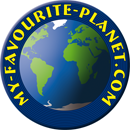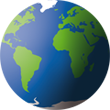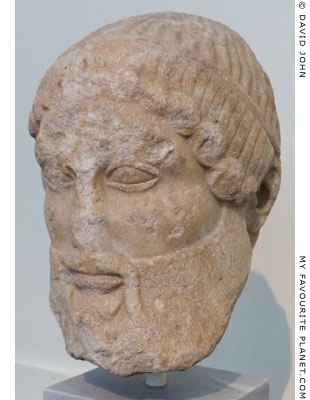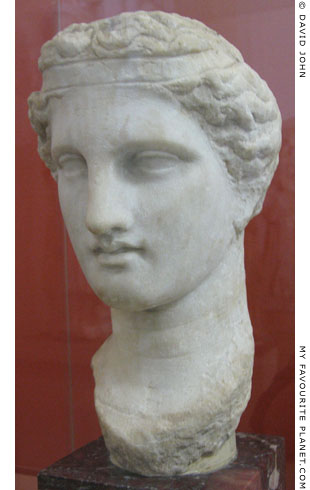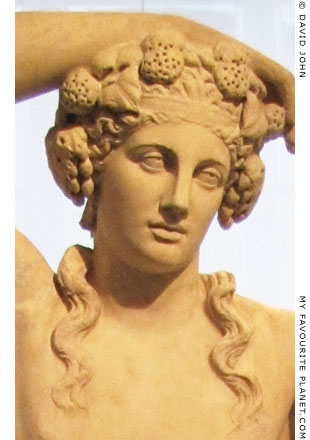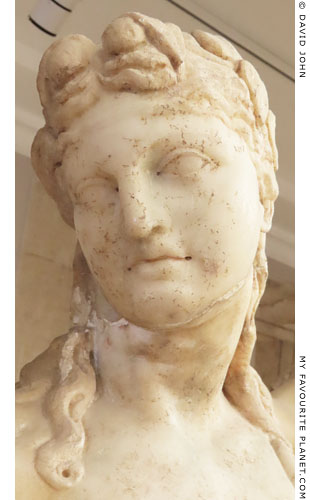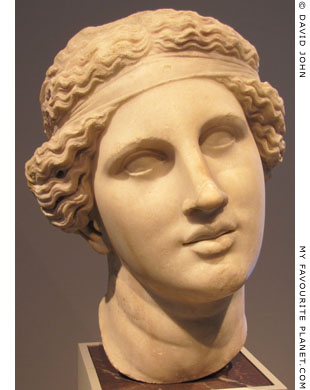| |
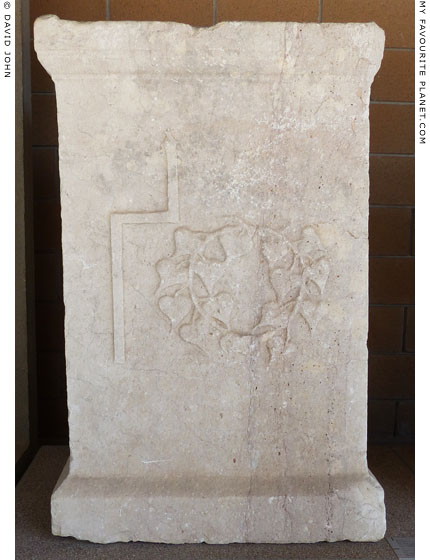
A limestone grave stele of a priestess of Dionysus, with a crowning
of regula and cymatium. In the centre are reliefs depicting the key
of a temple and and a wreath of ivy leaves. Below the epistyle is
the inscription, now barely visible, ΘΕΟΜΝΑΣΤΑ (Theomnasta).
From Thebes. Hellenistic period.
Thebes Archaeological Museum. |
| |

A marble block inscribed with a votive dedication to Dionysus by the city of Thessaloniki.
Dionysus was very popular in ancient Macedonia, and especially in Thessaloniki,
which had active Dionysiac cult associations (see below). One of the city's three
tribes was named Dionysias, and a residential quarter was known as Phallos,
an allusion to the phallophoriai ceremonies, in which an image of a phallus, as
a symbolic representation of the god (see below), was carried in procession.
2nd century BC. From the sanctuary of Serapis and Isis, Thessaloniki.
Thessaloniki Archaeological Museum.
ἡ πόλις
Διονύσωι
πολιταρχούντων
Ἀριστάνδρου τοῦ Ἀριστόνου
Ἀντιμάχου τοῦ Ἀριστοξένου
Inscription IG X,2 1 28
|
The city
to Dionysus
[when] politarchs [where]
Aristandros of Aristonous
[and] Antimachos of Aristoxenos |
See: Charles Edson (editor), Inscriptiones Graecae, X: Inscriptiones Epiri, Macedoniae, Thraciae, Scythiae. Pars II, fasc. 1: Inscriptiones Thessalonicae et viciniae (= IG X/2,1), No. 28. De Gruyter, Berlin, 1972.
A politarch (πολιτάρχης, politarches, ruler of the citizens; plural, πολιτάρχαι, politarchai) was an elected governor (archon) of a city (polis) in Macedonia during the Hellenistic and Roman periods. |
|
| |
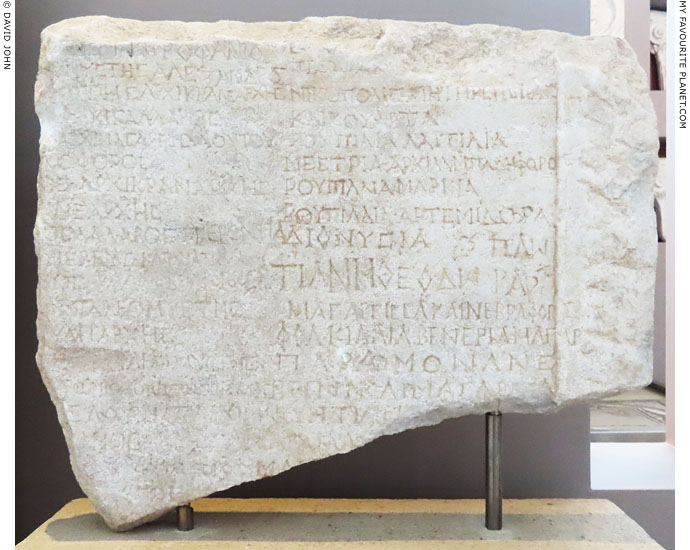
Part of a marble stele with an inscription concerning one of the most important
Dionysiac cult associations in Thessaloniki. The preserved text lists members of the
association - men and women - and their titles, which indicate their repective duties.
Second half of the 2nd - 3rd century AD.
Thessaloniki Archaeological Museum. |
| |
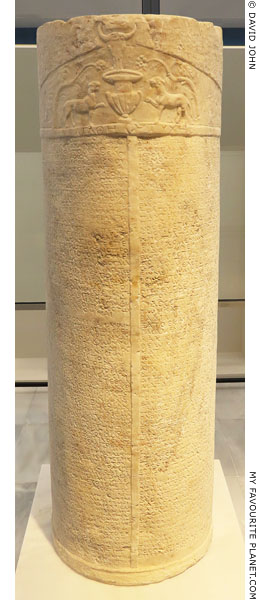 |
|
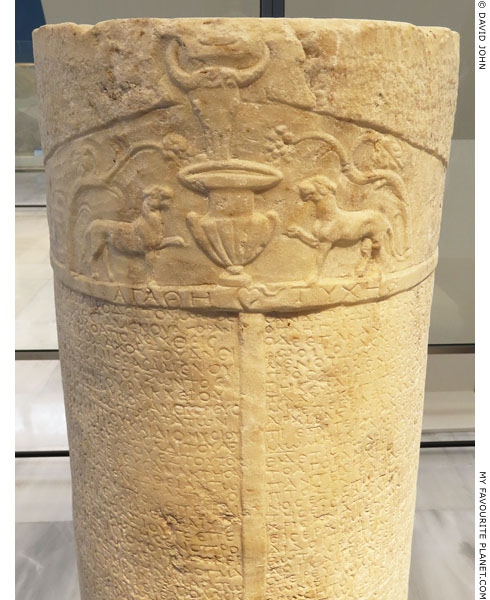 |
A cylindrical marble column inscribed with the regulations of the Iobacchoi
(Ιόβακχοι; a variant on Bacchoi, Βάκχοι, devotees of Bacchos), an association
of worshippers of Dionysus in Athens, for which the wealthy and powerful
Athenian aristocrat Herodes Atticus was the priest.
164/165 AD, Roman Imperial period, during the reign of co-emperors Marcus
Aurelius and Lucius Verus. Found to the west of the Athenian Acropolis, in
the apse of a Roman building between the Pnyx and the Areopagus.
Athens Epigraphical Museum. Inv. No. EM 8187.
Inscription IG II² 1368 at The Packard Humanities Institute (PHI).
The long inscription is divided into two columns, taking up most of the height of the front half of the cylindrical stone. The top sixth is taken up by a relief of a triangular space resembling the pediment (gable) of a building, crowned by a bull's head over a large wine vessel. At either side of this stands a panther, facing centre, with one forepaw raised. The two cats are mirrored in heraldic symmetry. From behind each animal a vine rises and bends over towards the centre.
The text is formulated rather like an official decree, announcing a summary of an assembly: the date, principal persons present, one or more proposals for the laws or regulations to be passed and published in the form of an inscription. We learn that this publication in stone is the result of an assembly of the Iobacchoi on the eighth day of the month of Elaphebolion, in the year in which Arrius Epaphroditos (Ἀρρίος Ἐπαφροδείτοs) was eponymous archon in Athens (i.e. 164/165 AD).
For some reason not explained, Aurelius Nikomachos (Αὐρηλίοs Νεικομάχοs), "who had served as vice-priest for seventeen years and as priest for twenty three years", decided to resign in favour of Claudius Herodes ("τῷ κρατίστῳ Κλα(υδίῳ) Ἡρώδῃ"), presumed to be a reference to Herodes Atticus. Thus, around five years after his wife's death, Herodes gained yet another position of honour and cultural influence to add to those held by himself and members of his family. Aurelius was to continue to serve the association as vice-priest.
The assembly then voted unanimously by the raising of hands to ratify and publish the association's regulations, as proposed by its president (πρόεδρος, proedros), Rufus son of Aphrodisios (Ῥοῦφος Ἀφροδεισίου). These rules governed admission of new members, conduct at meetings, costs for membership fees and fines for bad conduct, the appointment of officers such as the treasurer, as well as the frequency of meetings, which are also referred to as banquets. The priests were to appoint bouncers, known as "horses" (ἵπποι), to eject drunken troublemakers from the banqueting hall.
The Iobacchoi appear to have at least played a part in organizing the funerals of deceased members, since those who attended them were to be provided with "a wreath worth up to five denarii and a single jar of wine". It was made clear, however, that any member who did not turn up to such a funeral would receive no wine.
You can read the complete inscription in Greek with an English translation in:
[7] Regulations of the Iobacchoi (164/165 CE) at philipharland.com. |
|
| |
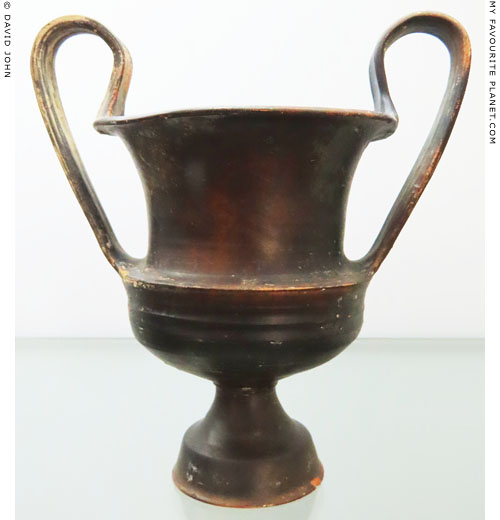
A ceramic kantharos (Greek, κάνθαρος), a double-handled drinking cup
(also sometimes referred to as a kotylos (κότῦλος, masculine) or kotyle
(κοτύλη, feminine), and in English as a tankard), used for wine. From at
least the Archaic period Dionysus was often depicted carrying such a cup.
These ceramic vessels are believed to have been made in imitation of
more expensive metal types (see photo below).
Hellenistic period, 3rd - 2nd century BC. From Chalkis
(today Chalkida), Euboea, central Greece.
Chalkis "Old" Archaeological Museum. From the Oikonomou Collection. |
| |
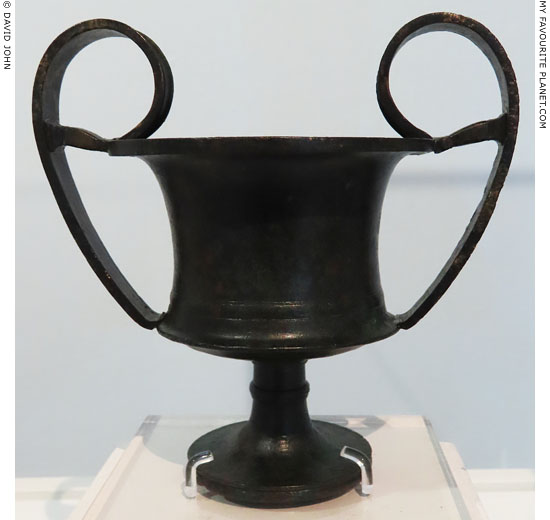
A metal kantharos from Europos Kilkis, Macedonia, northern Greece.
Classical period, 475-450 BC. Found in 1995 in an ancient cemetery for wealthier
citizens, 400 metres southwest of the city of Europos, along the road to Pella.
Height of body 9.5 cm, height of body with handles 12.5 cm, diameter of base 5.3 cm,
height of foot 3.7 cm, diameter of rim 8.8 cm, weight 308.4 grams.
Kilkis Archaeological Museum. Inv. No. AEMK 4475. |
| |
| Dionysus |
Bearded Dionysus
Dionysus was depicted as a mature, bearded god
in Archaic art and later works imitating the Archaic. |
|
 |
|
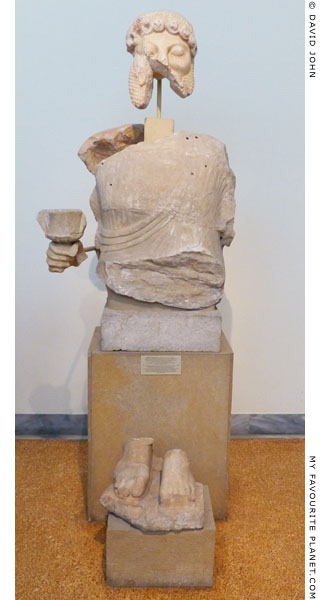
Fragments of a colossal marble statue
of Dionysus, from the Attic deme of Ikaria
(today Dionysos). Around 520-510 BC.
The fragments were found during excavations
at Ikaria in 1888-1889, directed by Carl Darling
Buck. The head was recently associated with
the body. It is uncertain whether the right
hand with the kantharos (wine cup) belongs
to the statue. [5]
This may have been a cult statue of the god
in the Archaic Dionysion of Ikaria. According
to myth, viniculture was introduced to Attica
at Ikaria after Dionysus taught Ikarios the
art of winemaking there (see below).
National Archaeological Museum, Athens.
Inv. No. 3072-3074, 3897. |
|
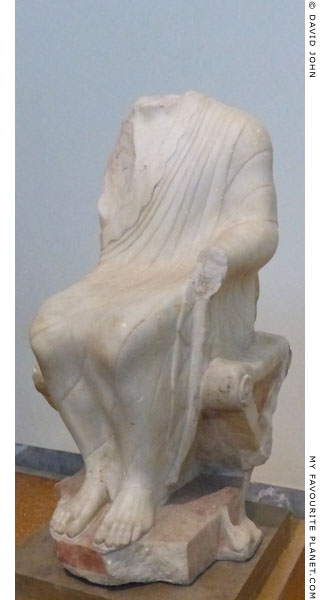
Marble statue of a seated Dionysus.
About 500 BC. Known as the "Plateia
Eleutherias Dionysos" after the place
in Athens where it was found in 1931,
at the site of an Archaic cemetery [6].
Pentelic marble. Height 107 cm,
depth 61 cm. Height of base 13 cm.
The figure's body is covered by a himation
(mantle) which leaves his right shoulder
bare. He and sits on a folding diphros
(stool) with lion paws at the end of the
legs, and covered by a panther skin. The
stool was covered with painted motifs
(meander, chequered pattern). Traces of
red paint can also be seen on the base.
National Archaeological Museum, Athens.
Inv. No. 3711. |
|
| |
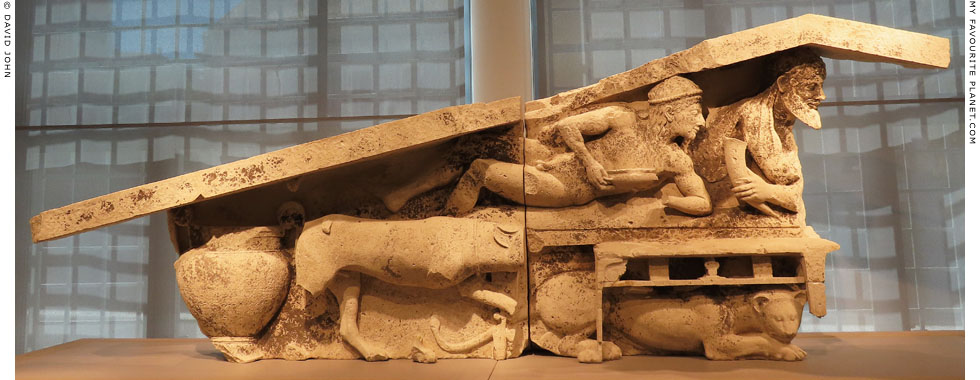
Two slabs from the left side of a poros (limestone) pediment of an Archaic temple with a high relief
of two male figures reclining on a kline (κλίνη, couch, chaise longue). The bearded man on the right
has been identified as Dionysus, while the naked youth may be his son Oinopion (Οἰνοπίων, wine
drinker, wine-rich or wine face), or Hyllos (Ὕλλος), a son of Herakles.
From Korkyra (Κόρκυρα, today Corfu). Around 500 BC.
Total length 360 cm; length of relief 273 cm. Height 130 cm.
Corfu Archaeological Museum.
|
The remains of the pediment were discovered among a number of other ancient artefacts in 1973 during construction works on private land owned by T. Giovanis in the Figareto (Φιγαρέτο) area, near the southwest end of the Kanoni peninsula, the location of the ancient city Korkyra (Κόρκυρα), just south of modern Corfu town (see Medusa part 3). The excavations were led by Angelos Choremis (Άγγελος Χωρέμης, 1936-2002), at that time Ephor of Antiquities for Corfu. [7]
Sculpted in great detail typical of the High Archaic style, the two male figures in the relief have been described as symposiasts (from συμποσιαστής, symposiastes, fellow-drinker), that is participants at a symposium (συμπόσιον, symposion, dinner or drinking party). Such symposia are depicted on numerous vase paintings and reliefs (see some reliefs in Demeter and Persephone part 2) This is one of the largest surviving ancient sculptural depictions of symposiasts, and one of the few from an architectural context. Most others are on the lids of sarcophagi and cinerary urns (see, for example, Homer part 2).
They recline on a dining couch in the conventional manner, with their heads to the right, each leaning on his left elbow. Both wear crowns and have curly hair around their foreheads, as well as long tresses hanging from behind each ear to below their shoulders. Their heads are turned to the right as if they are paying attention to or communicating with someone or something on the pediment's now missing centre or right side. Perhaps on the right side was a similar reclining pair, arranged symmetrically. It has been suggested that Hephaistos may have been depicted drunk, in a scene from the mythological tale of the god's return to Mount Olympus.
The bearded man on the right, thought to represent Dionysus, appears to be wearing an animal skin over his back and shoulders. In his left hand he holds a rhyton (ῥυτόν, drinking horn), and his right forearm (now missing) was originally extended to the right as if he was gesturing, or offering/accepting something to/from another figure. Lying in front of him, his young nude companion holds an Ionian kylix (or a Siana cup) in his right hand. His left hand is now missing.
In front of the couch a panther crouches below a low table, its head turned to face the spectator. Its presence stengthens the identification of the bearded figure as Dionysus (see more about Dionysus and panthers below). To the left of this is a walking dog (head and right legs now missing), probably a mastiff, thought to be of the kind known as "table dogs" (τραπεζήες κύνες, trapesés kynes) that cleared the floor of food remains. Behind it, to the left, is a large krater, a vessel used for mixing water with wine.
It is thought that this pediment may have belonged to a nearby temple of Dionysus, perhaps that mentioned by Thucydides, in which during the Korkyran civil war in 427 BC asylum-seeking members of the aristocratic party were slaughtered by Athenian-backed democrats (History of the Peloponnesian War, Book 3, chapter 81). Unfortunately, Thucydides did not describe the temple or divulge its location.
No trace of such a temple has yet been found at Figareto, and most of this suburb has not been excavated, since it is built over with modern houses and businesses. Remains of a pottery workshop and a sanctuary of Artemis found here now form the small archaeological site known as "Kerameikos at Figareto" (Κεραμεικός Φιγαρέτο, see note in Medusa part 3).
Judging from the remains of this pediment, the building to which it belonged was around 10 metres wide, smaller, for example, than the Corfu "Temple of Artemis" or the Hephaisteion in the Athens Agora. Temples of Dionysus were often associated with open spaces in which the god was honoured with festivals of singing and dancing, which developed into theatres (for example in Athens and Pergamon). However, nothing is known of a theatre in ancient Korkyra. If the theory that the pediment relief featured Hephaistos is correct, this may have to do with the Figareto area having been occupied by industrial workshops. Perhaps, as in the Athens Agora, Hephaistos was worshipped here as the patron god of artisans.
Now battered and discoloured, the remains of this sculptural group are still vivid and the figures have a remarkable physical presence. When they were new and freshly painted they must have been impressively powerful, and for their viewers very lively and realistic. They belong among the best surviving sculptures of the late Archaic period, and although there remains a hint of the "Archaic smile" on the lips of the two figures, their attentive gazes and relaxed, almost lithe poses are a long way from the stiffly standing kouros statues of the previous century.
Surprisingly, though it was discovered half a century ago, there appears to be very little published discussion concerning this relief. This is generally true of several other artefacts from ancient Korkyra. Perhaps few art historians have made it to Corfu, or it may be at least partly due to the fact that the archaeological museum there was closed for many years.
Although the Gorgon pediment in Corfu, dated around 585 BC, has been described as "arguably the finest example of Archaic temple sculpture extant" (Frommer's review of Corfu Archaeological Museum, quoted in The New York Times, January 30, 2013), this relief, made almost a century later, must also be added to those which compete for the honour. Other contenders include surviving Archaic pedimental sculptures from the Temple of Aphaia, Aegina (see note on the Niobe page) and the Athens Acropolis (see Athens Acropolis page 13). |

The two symposiasts on the Corfu pediment
relief, viewed from the right side. |
| |
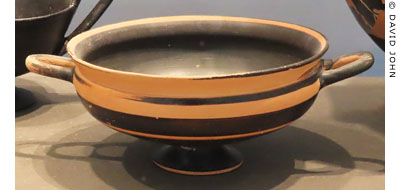
An Ionian kylix (deep drinking bowl)
from Corfu. 6th century BC.
Corfu Archaeological Museum. |
| |
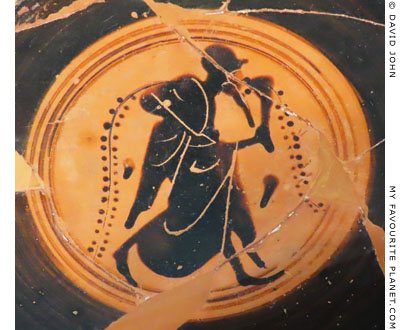
Dionysus in the tondo inside a fragmentary black-figure
kylix (drinking cup). The bearded god, striding to the
right, wears a himation (cloak) and carries a rhyton
(drinking horn) in his left hand. Long ivy branches
hang to either side of the figure. Archaic period. Found in Figareto, Corfu.
Corfu Archaeological Museum. |
| |

An amphora on a silver triobol coin
of ancient Korkyra. 500-450 BC.
Other coins of the island were engraved with
the head of Dionysus (see below), a rhyton
(drinking horn), a kantharos (wine cup) or
bunches of grapes with vine leaves.
Corfu Archaeological Museum. |
| |
| |
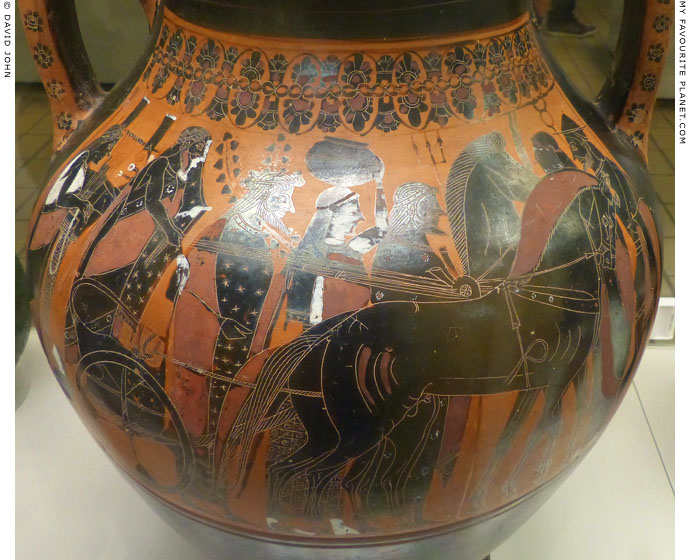
Detail of an Attic black-figure amphora with a depiction of deities accompanying a bride and groom
in their chariot: Apollo (with a kithara), Dionysus, Artemis, Poseidon, Aphrodite (?) and Hermes.
Made in Athens around 550-530 BC. Attributed to the Painter of Berlin 1686. From Kamiros, Rhodes.
On the other side of the amphora Herakles fighting Kyknos in the presence of Zeus, Athena and Ares.
British Museum. Inv. No. GR 1861.4-25.50 (Vase B 197). |
| |
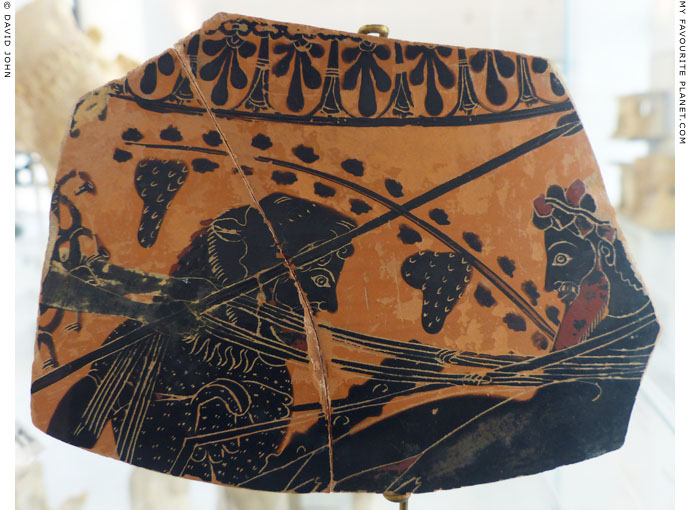
Fragment of an Attic black-figure amphora showing Herakles (centre) and Dionysus (right),
with part of Athena (left), wearing the aegis and holding a spear, driving a chariot.
525-500 BC. From Selinous (today Selinunte), Sicily.
Antonino Salinas Regional Archaeological Museum, Palermo, Sicily. |
| |
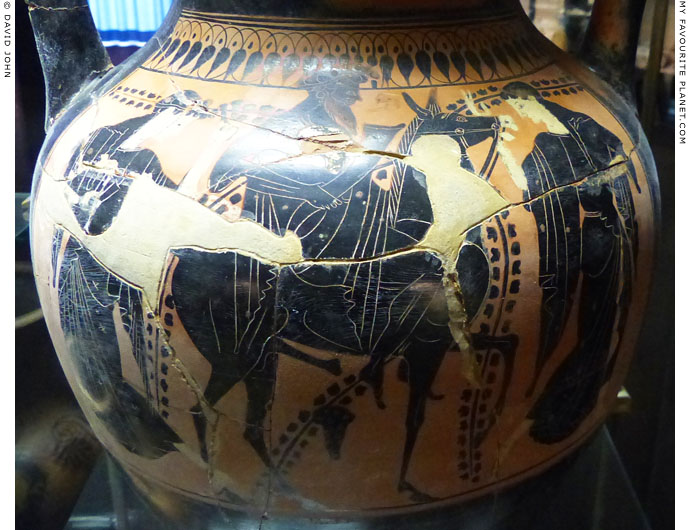
A bearded god on an ithyphallic mule, holding up a large rhyton (drinking horn), with a dancing
Maenad on either side. Described by the museum labelling as a "dionysiac scene with the god
[i.e. Dionysus] on a mule", the deity may be Dionysus or Hephaistos returning to Olympus.
Detail of an Attic black-figure amphora, made in Athens, end of the 6th century BC.
Found in a small ceramic sarcophagus, Tomb 13, Cemetery Lombartolo, the
Necropolis at Capo Soprano, Gela, Sicily.
Paolo Orsi Regional Archaeological Museum, Syracuse. Inv. No. 21948. |
| |
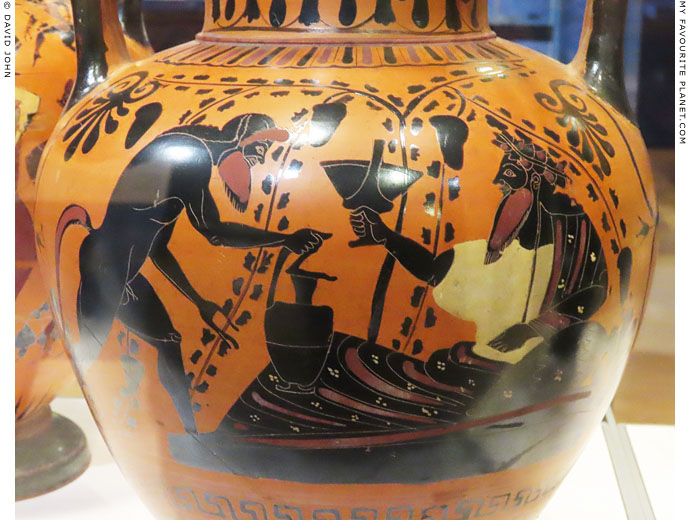
Dionysus reclining on a couch, holding a large kantharos (drinking cup),
being served by a bearded Satyr who carries an oinochoe (wine jug).
The god, with a long red beard, wears an ivy wreath, a white chiton, and a himation
(cloak) with broad red and black stripes, decorated with rosettes of dots. The red
and white are added paint. In the backgpund is a vine with bunches of grapes.
Detail of an Attic black-figure neck amphora, made in Athens, around 520 BC.
Attributed to the Group of Würzburg 199 by Sir John Beazley. From Vulci,
Etruria, Italy. Height 39.8 - 40.2 cm. Diameter of mouth, including rim, 18.2 cm.
Side B shows three Satyrs walking to the right, the first (left) carrying an
oinochoe, the second playing double pipes and the third with a full wineskin.
Rijksmuseum van Oudheden, Leiden, Netherlands. Inv. No. PC 11a.
From the Canino Collection, No. 2058. Acquired in 1839 from Lucien Bonaparte (1775-1840). |
| |
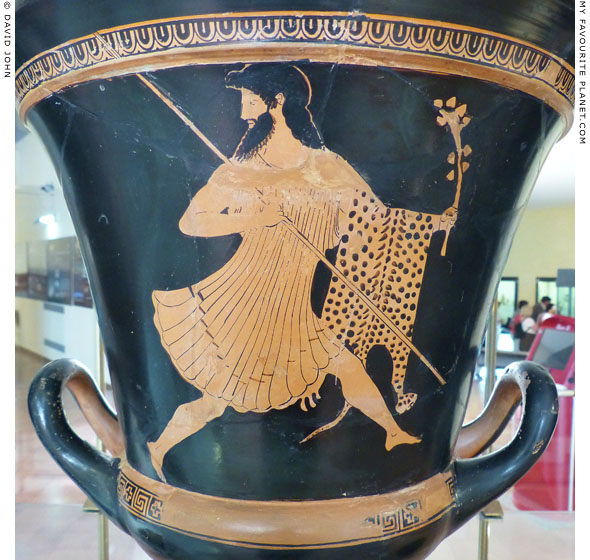
Dionysus running to the right, looking behind him.
Detail of a red-figure calyx-krater, around 510 BC. Formerly attributed to
the Pan Painter, now to the Orizia Painter. From Akragas (Agrigento), Sicily.
Dionysus, with a heavy crop of hair and long beard, wears a chiton with wide,
flowing folds. He carries a panther skin on his left arm, holds an ivy branch in his
left hand and a spear or staff in the right. On the other side of the krater (Side B)
a Satyr stands facing right, holding an animal-skin sack in his extended left hand.
Agrigento Regional Archaeological Museum. Inv. No. C. 1538. |
| |
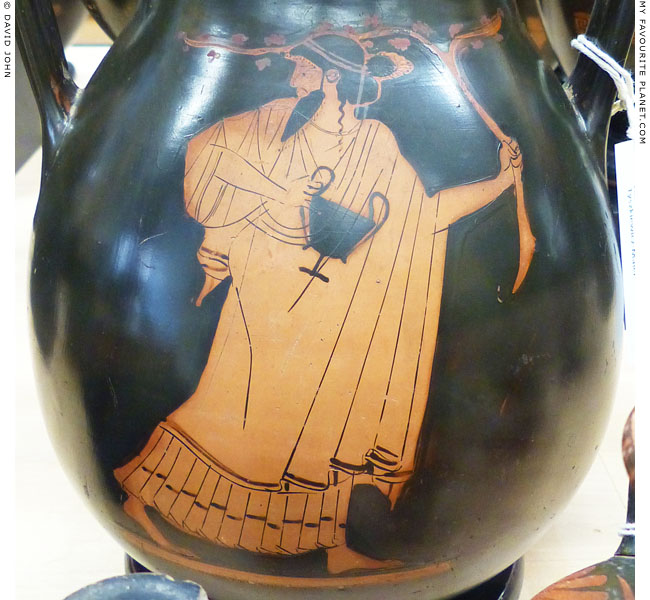
Dionysus walking to the right, looking behind him.
Detail of a red-figure pelike (storage jar). Around 470 BC. Attributed to
the Tyszkiewicz Painter (working around 490-480 BC) by John Beazley.
From Nola, Campania, Italy.
Dionysus, with a long beard and long hair bound by a tainia and tied up in a knot
at the back, and with a lock hanging down. He wears a himation (cloak) over a
long chiton (tunic). He carries an ivy branch in his left hand and a kantharos
(drinking cup) in the right. Side B shows a running Maenad with an oinochoe.
Studiendepot Antike, Skulpturensammlung, Albertinum, Dresden. Inv. No. Dr. 293. |
| |
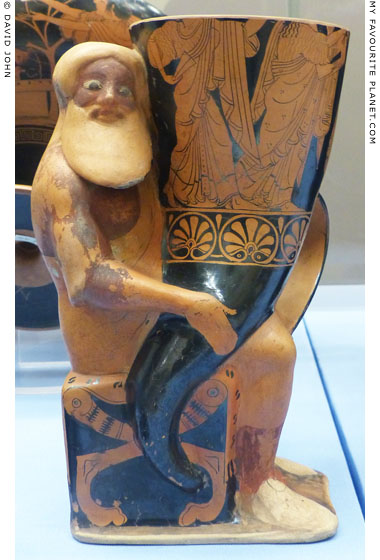
A special drinking vessel in the form of Dionysus, seated
on a diphros (δίφρος, stool) covered with a panther skin
and holding a rhyton (drinking horn).
Made in Athens around 500-490 BC.
From Capua, Campania, Italy. Height 24.13 cm.
British Museum. Inv. No. GR 1873.8-20.267 (Vase E 785).
Purchased in 1873 from the art dealer Alessandro Castellani.
|
The red-figure rhyton has part of a painted scene of Hermes facing Apollo and Artemis and their mother Leto, above a band of palmettes. All the figures are now headless, but the inscribed names of the first three have survived. The vessel was damaged and filed down for continued use in antiquity, reformed as a one-handled cup, a keras. The broad, semicircular handle, which is joined at the bottom to the right knee of the Dionysus figure, can be seen at the rear.
Bearded Dionysus supports the rhyton on his knees and with his right hand. It rests against the left side of his head and torso. He wears a long sleeved chiton, a himation and shoes. His skin was vermilion, but most of the colours on the figure have faded. The deep yellow and black of the panther skin and diphros are still vivid. |
|
| |

Small ceramic head of Dionysus from Taranto, southern Italy.
5th century BC.
Barracco Museum, Rome. Inv. No. MB 221.
Formerly in the Tyskiewicz Collection. |
| |

Fragment of a terracotta plaque with Dionysus bringing an offering of wine.
Made in Medma, southern Italy, about 460 BC.
British Museum. Inv. No. GR 1865.7-12.30 (Terracotta 1224). |
| |
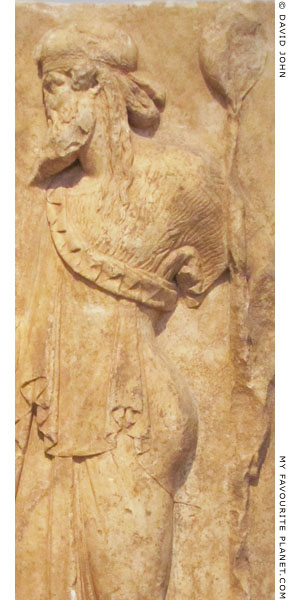 |
|
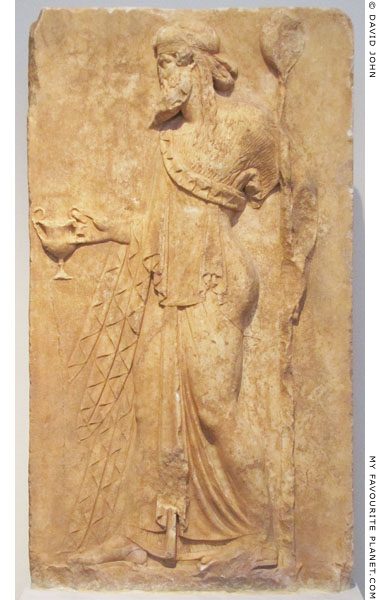 |
Marble stele with a Neo-Attic Archaistic relief of Dionysus.
1st century BC. Found at Loutses, between the
districts of Chalandri and Agia Paraskevi, Attica.
Dionysus, in profile, walks to the left, holding a kantharos (wine
cup) in his right hand and his thyrsos staff in his left hand.
National Archaeological Museum, Athens. Inv. No. 3727. |
|
| |
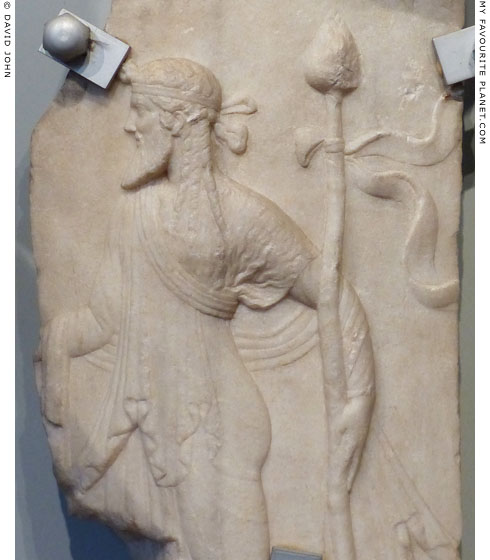
Detail of a fragment of a marble krater (wine bowl) with an Archaistic relief
showing Dionysus carrying his thyrsos staff, topped by a pine cone.
Pentelic marble. Roman period, 1st century BC.
Barracco Museum, Rome. Inv. No. MB 169. |
| |
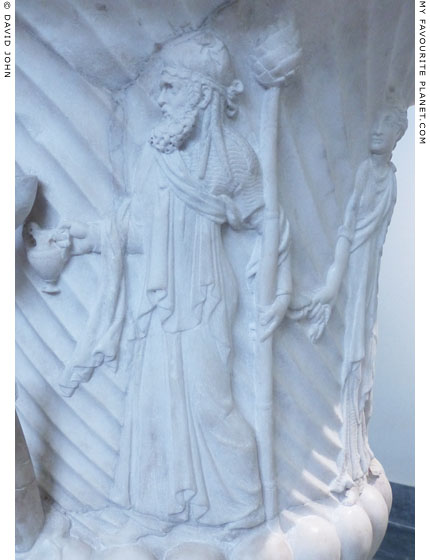 |
|
 |
A large marble krater (wine bowl) with a Neo-Attic reliefs on both sides, each depicting
Dionysus leading two Maenads in a procession. On the relief above the bearded god
holds a kantharos and his thyrsos. The relief on the other side (see photo below)
shows him dressed differently and holding the thyrsos in his left arm.
Mid 1st century AD. Pentelic marble.
National Archaeological Museum, Naples. Inv. No. 6778. Farnese Collection. |
|
| |

Detail of the relief on the other side of the marble krater in Naples. |
| |
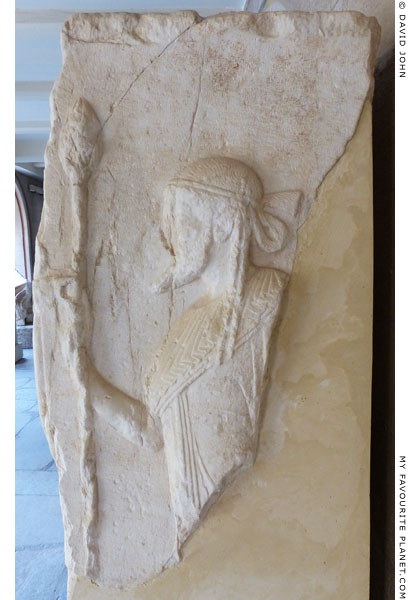
The side of a fragmentary marble base or pier with an Archaistic relief of
Dionysus in profile, walking left and holding a thyrsos in his right hand.
From the Forum of ancient Corinth. Roman period, 1st century AD.
On the front of the base, as it is displayed in the museum,
is an Archaistic relief of Hera, and on the left side is Athena.
Corinth Archaeological Museum. Inv. No. S-79-6.
A similar base in the museum has reliefs of
Persephone, Zeus Chthonios and Demeter. |
| |
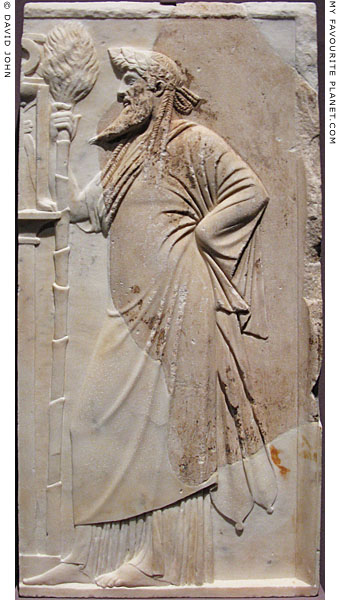 |
|
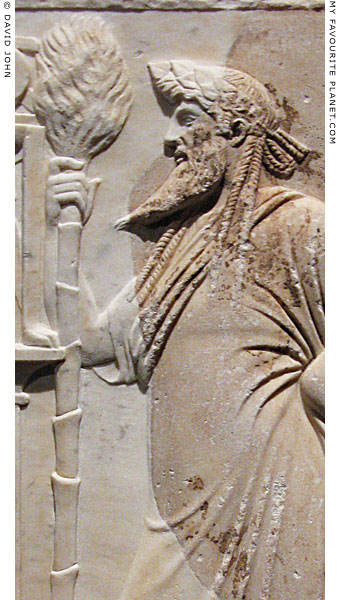 |
Restored fragment of an Archaistic marble relief of Dionysus.
Beginning of the 1st century AD.
Antikensammlung, State Museums Berlin (SMB).
Inv. No. Sk 940 (Skulpturen I, S. 270).
Acquired in 1869 in Rome by Wolfgang Helbig (1839-1915).
|
|
The left and lower sides and the top right corner of the relief are modern, speculatively restored with fine, crystalline marble to resemble similar extant reliefs of Dionysus, including a marble base of a candelabrum or thymiaterion (incense burner) in Dresden (Skulpturensammlung, Albertinum, Inv. No. Hm 027), a plaster cast of which was acquired by the Berlin museum around 1842 (known to have been exhibited in the Neues Museum in the 1850s, Inv. No. I.G. 1545 FW 423). The relief was cleaned in 1993.
Dionysus is shown in the Archaic style as a mature, dignified, bearded figure (comparable to Archaic depictions of Hermes). His head is shown in profile, while his body is presented in a three-quarter view. His hair is brushed forward to a point at the front, beneath a crown of ivy leaves, and is tied at the back with a knot (krobylos). Two corkscrew locks fall from behind the ear and rest on his chest. His long beard is also brushed forward to a point.
He wears a long chiton (tunic) covered by a himation (cloak) which clings tightly to his body. His left arm, completely covered by the himation, is bent behind him so that the back of the hand rests on the top of his hip; the pressure of the hand causes deep creases on the side of the himation. His slightly bent right leg is in front of the left leg which carries his weight, and he appears to be resting some of his weight on the long thyrsos held in his right hand. The restoration shows the god barefooted.
In the restoration, the thyrsos rests on the low base of a tall pedestal on which stands a tripod with animal-paw feet. Such tripods were awarded as trophies to winners of theatrical competitions during the annual Great Dionysia festival in Athens, and set up as votive offerings to Dionysus in public spaces (see, for example, the Choragic Monument of Thrasyllos and the Choragic Monument of Nikias).
The left side of the relief has not survived, however, other extant reliefs show a woman (perhaps a priestess) decorating a tripod with a victor's headband (tainia).
Height 72 cm, width 34.5 cm, depth 8.5 cm. |
|
| |
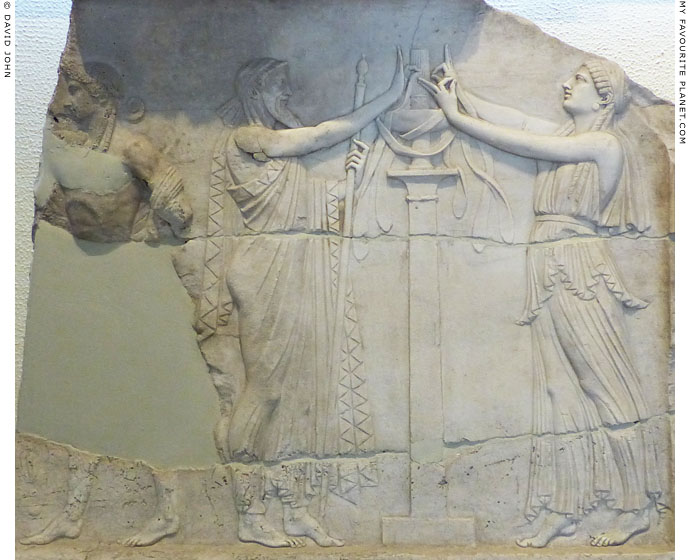
Detail a fragmentary marble Neo-Attic Archaistic relief panel with a depiction
of a bearded male, holding a thyrsos, and a female placing a tainia on a
ritual object on a tall pedestal. The scene, similar to that mentioned above, is
described by the museum label as "a priest and a priestess in ritual attitude".
However, the male is depicted in the same way as on the figure in the reliefs
above as Dionysus, and the female may be Ariadne or a goddess.
Made in an Attic workshop, mid 2nd century AD. One of two similar reliefs
(see the other below) found in winter 1930-1931 in Piraeus harbour,
among other ancient Greek artworks made in the same workshop, in
a wrecked ship thought to have been bound for customers in Italy.
To the left of the pair is the surviving part of a scene depicting Apollo
in his dispute with Herakles over the possession of the Delphic tripod.
The other almost intact relief in the museum, with identical depictions
of the same two scenes was also found in the shipwreck.
Piraeus Archaeological Museum. Inv. No. 2042.
See also a relief of the infant Dionysus on Mount Nysa,
below, which was also found in the shipwreck. |
| |
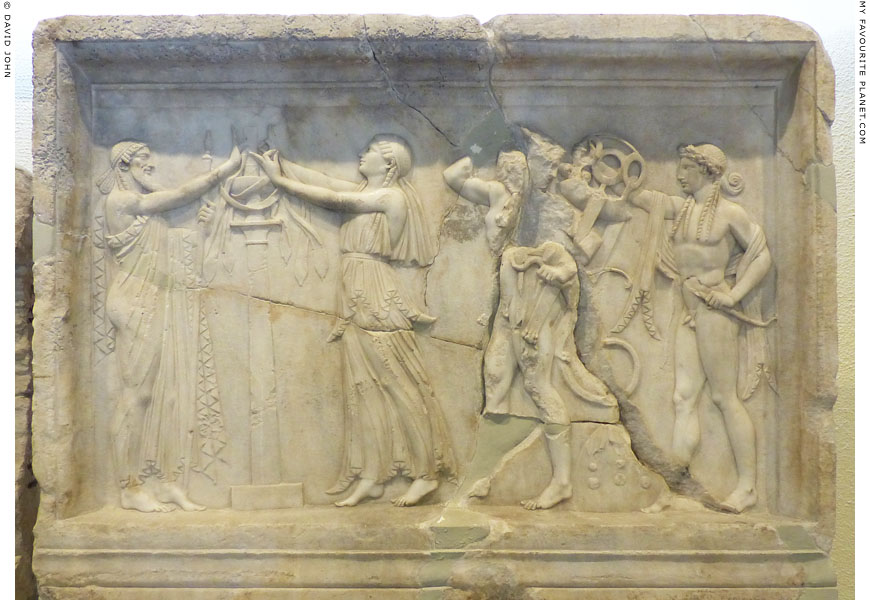
A marble Neo-Attic Archaistic relief depicting two religious/mythological scenes.
On the left Dionysus and a female (a priestess, Ariadne or a goddess) decorate
a ritual object on a tall pedestal with a tainia. On the right the dispute between
Herakles and Apollo over the possession of the Delphic tripod.
Made in an Attic workshop, mid 2nd century AD. One of two similar reliefs
(see the other above) found in winter 1930-1931 in Piraeus harbour,
among other ancient Greek artworks made in the same workshop, in
a wrecked ship thought to have been bound for customers in Italy.
Piraeus Archaeological Museum. Inv. No. 2118. |
| |

A thyrsos with vines, from the sketchbook of the British
traveller and archaeologist Charles Fellows (1799-1860).
|
Charles Fellows travelled through southwestern Anatolia in 1838, 1840, 1842 and 1843, discovering and exploring several ancient Lycian cities. During his first journey he discovered the ancient Lycian capital Xanthos (Greek, Ξάνθος; Lycian, Arnna), which he described as "my favourite city", and from where he later took artefacts, including the surviving parts of the famous Nereid Monument, for the British Museum (see Museum boom part 1 at The Cheshire Cat Blog).
He noted the survival among the Greeks in Anatolia of the ancient custom of adding pine resin (turpentine) to wine to make what is today known as retsina, and related it to the pine cone on Dionysus' thyrsos, although he referred to it as a "fir-apple". An entry from his journal, written 19th April 1838 while he was in Xanthos, Lycia (at the village of Kınık, Antalya Province, southwest Turkey):
"In the houses of the Greeks only is wine to be met with, and by them it is taken far too freely. In their mode of manufacturing it another trace of antiquity is recognised. They add a flavour of turpentine, obtained from the fir-apple; this was also the custom with the ancient Greeks, and the fir-apple is found in all bacchanalian emblems surmounting the vine-wreathed thyrsus or staff of the god."
Charles Fellows, A journal written during an excursion in Asia Minor, 1838, pages 234-235. John Murray, London, 1839. At the Internet Archive.
It is thought that the pine resin was originally used by the ancient Greeks to seal containers such as amphorae to keep wine from turning sour, and that the resulting taste became popular, leading to the resin being added during firmentation. Until recently retsina (ρετσίνα, from ρετσίνι, retsini, resin; from Ancient Greek ῥητίνη, rhetine, pine resin) was one of the most popular alcoholic beverages in Greece, mostly because it was cheap: in the 1980s a litre could be purchased for less than a dollar. However, it has a pretty harsh flavour, and is definitely an acquired taste not suited to delicate palates. To make it more palatable, many Greeks mix it with cola, the resulting "long drink" being popularly known as diesel. Since at least the 1980s many Greek wine growers have been attempting to improve the quality and value of their produce, and non-resinated wines have become increasingly popular, if more expensive. This and the availability of other drinks, particularly beer, have resulted in a significant reduction in retsina production.
See also a relief of a Dionysus mask from the theatre at Letoon, Lycia, below. |
|
| |
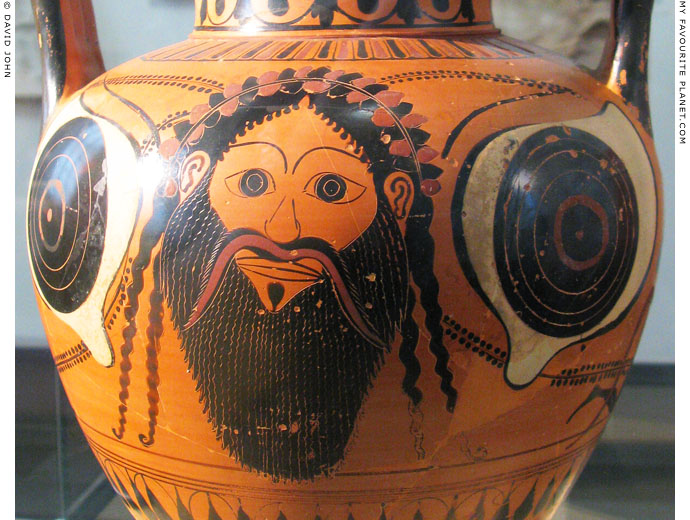
Dionysus mask between two large eyes on an Attic black-figure neck amphora.
Made in Athens around 520 BC, Archaic period. Attributed to the Antimenes Painter.
The other side (Side B) shows a similar mask of a Satyr between two large eyes.
Pergamon Museum, Berlin. Inv. No. F3997.
Acquired in 1884 from the Castellani Collection. |
| |
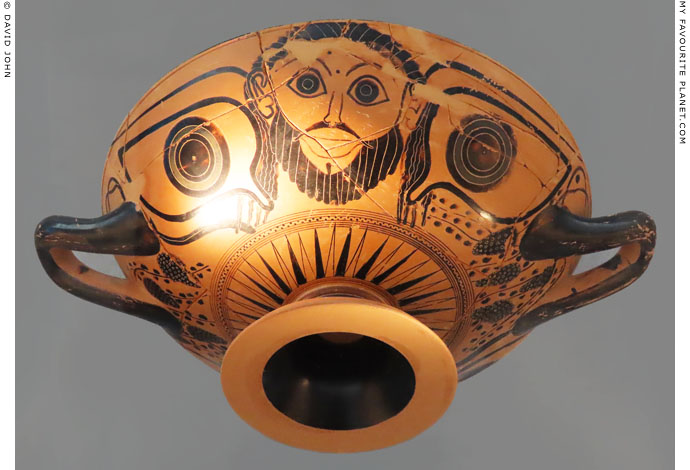
The side of an Attic black-figure kylix, of the type known as an eye-cup, with a painting
of two large eyes either side of a mask of Dionysus. On the others side is a bust of Apollo
with a kithara. Beneath each handle are painted bunches of grapes and vine branches.
Around 525-500 BC. Provenance unknown, but probably from Halkidiki, Macedonia, Greece.
Polygyros Archaeological Museum. From the Lambropoulos Collection. |
| |
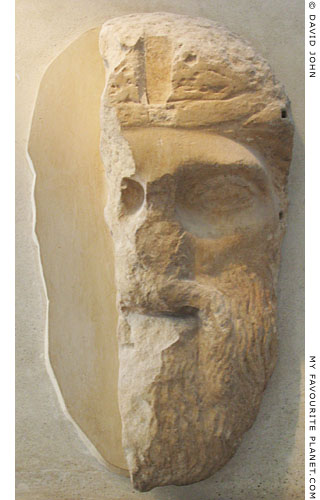
Colossal marble mask of Dionysus.
Pentelic Marble. Roman period, 1st century BC.
From the Athens Acropolis.
The mask was probably set high up. On vase
paintings (particularly Lenaia vases) such
masks, made of various materials, are shown
set up on trees, wooden poles or stone columns,
sometimes draped with clothing, at sanctuaries
of Dionysus, with rituals being performed
around them (see photo below right). Acropolis Museum, Athens. Inv. No. 6461. |
|
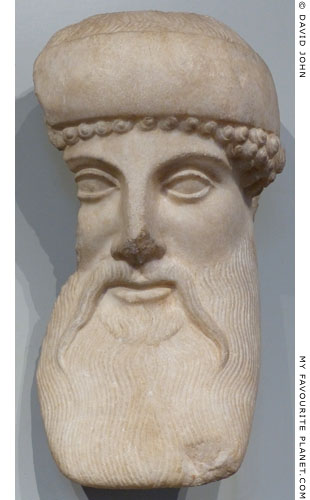
Head of Dionysus.
Archaistic sculpture of the Augustan period
(27 BC - 14 AD). Pentelic marble.
Barracco Museum, Rome. Inv. No. MB 86. |
|
| |

Colossal limestone mask
of Dionysus from Cyprus.
100 BC - 100 AD. Found at Lefka,
probably from Soloi, Cyprus.
The Dionysus cult was introduced to Cyprus
after 300 BC, during the Hellenistic period,
perhaps because the Ptolemies of Egypt, who
ruled the island, claimed descent from the god.
British Museum. GR 1910,10-14.1. |
|
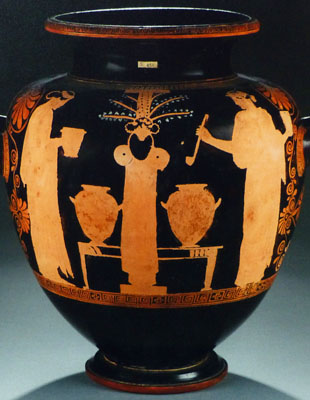
Worshippers sacrificing in front
of an image of Dionysus.
Detail of an Attic red-figure vase, 470-450 BC.
British Museum.
Photo © Trustees of the British Museum |
|
| |
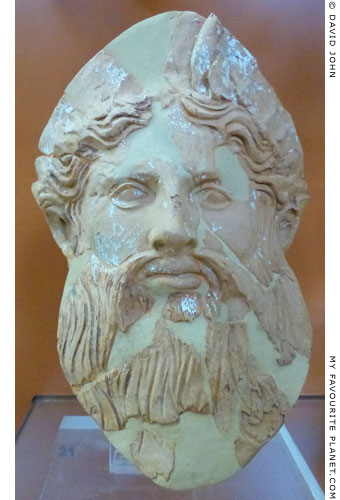
Terracotta mask of bearded Dionysus,
perhaps Dionysus-Hades.
4th century BC. Found to east of the theatre
in the Sanctuary of Demeter and Kore
at Corinth. Height 18 cm.
The god wears a stephane (crown) or polos
decorated with a wreath of ivy leaves. Unusually,
he also appears to have two curving horns (one
now broken off) in the center of his head. The facial
type has been identified as that of Dionysus-Hades.
Another, smaller, fragmented mask and a ceramic
plaque inscribed with the name Dionysus
(see below) were also found at the site.
Corinth Archaeological Museum. Inv. No. MF 73-3.
See: Nancy Bookidis and Joan E. Fisher,
Sanctuary of Demeter and Kore on Acrocorinth:
Preliminary Report V: 1971-1973, Hesperia,
Vol. 43, No. 3, July - September 1974, pages 267-307
(discussion of the mask on pages 290-291, plate 59).
The American School of Classical Studies
at Athens (ASCSA). At jstor.org. |
|

Ceramic mask of Dionysus.
4th - early 3rd century BC. From Maroneia
(Μαρώνεια), Thrace, northeastern Greece.
Komotini Archaeological Museum. |
|
| |
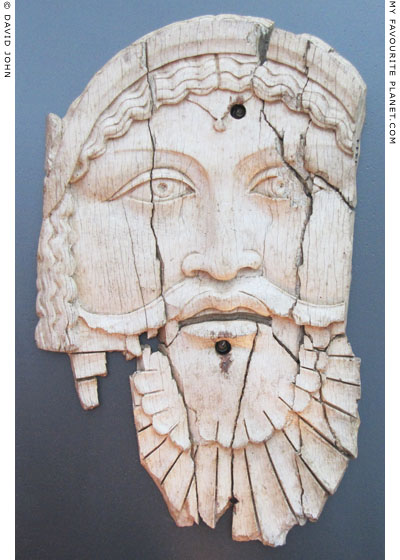
Ivory plaque with a mask of Dionysus, an applique
probably as decoration for a chest or bed.
100 BC - 100 AD. Found at Sepino, location of
the Samnite city Saepinum, south-central Italy.
Museo Provinciale Sannitico, Campobasso. Inv. No. 1311. [8]
The Samnites, ancient Italic people who lived in Samnium in south-central Italy, adopted the cult of Dionysus from the Greeks in Magna Gracia (southern Italy). Images of the god and members of his thiasos spread through Samnium from around the 4th century BC.
See other Dionysian artefacts from Samnium below:
a gilded silver relief of Dionysus from Pietrabbondante
a terracotta antefix depicting a Maenad from Pietrabbondante |
|
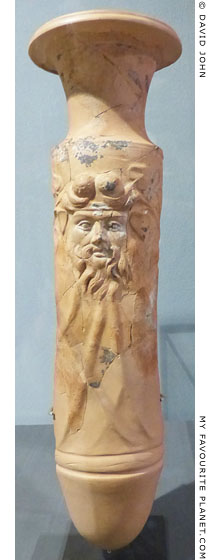
Ceramic alabastron with
a mask of Dionysus.
Late 2nd - early 1st century BC.
Found in a late Helenistic fill in the
area of the Thessaloniki agora.
Dionysus was particularly popular
in Thessaloniki. The vessel is in the
form a phallus, a symbol of fertility,
well-being and avoidance of bad luck.
Agora Museum, Thessaloniki. |
|
| |
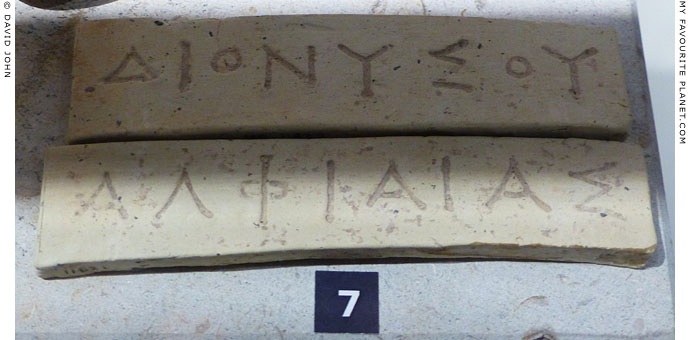
Two inscribed ceramic pinakes (plaques), the upper plaque
inscribed ΔΙΟΝΥΣΟΥ (Donysou), the lower ΑΛΦΙΑΙΑΣ (Alphiaias).
400-250 BC. Among four similar pinakes found in 1964 during excations in the area of the theatre
of the Sanctuary of Demeter and Kore at Corinth. They were all inscribed, with names in the
genitive case, by the same hand before firing. The other two are inscribed ΟΛΟΛΥΝΓΟΥΣ (Ololyngous)
and ΙΩΓΡ[ΑΦΟΥ] (Iographou). They are not thought to be personal names, and their purpose is not
known. It has been suggested that they may have been related to cries uttered by worshippers
during rituals. The name Alphiaias is usually associated with Artemis.
Corinth Archaeological Museum.
See: Henry S. Robinson, Excavations in Corinth, 1964, in: Αρχαιολογικόν Δελτίον
(Archaiologikon Deltion), Volume 20, Part 1, 1965 (1967), pages 144-145. |
| |
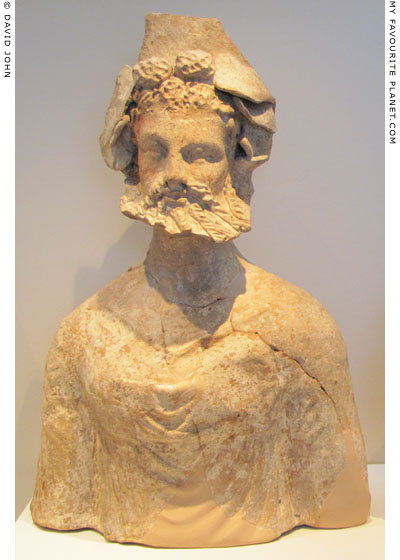
Terracotta bust of Dionysus from a household shrine in Pella, Macedonia.
Hellenistic period.
The figure wears a high headdress, now broken, the sides of which resemble large overlapping
leaves. Above his forehead are what appear to be clusters of ivy berries. His moustache sits
quite high on the face, starting from level of the sides of his nostrils. The beard has been made
of a thin crescent of clay, projecting forwards from the jaw onto which it has been adhered.
He wears a sleeved chiton (tunic), and the bulges on his chest appear like breasts.
Pella Archaeological Museum. |
| |
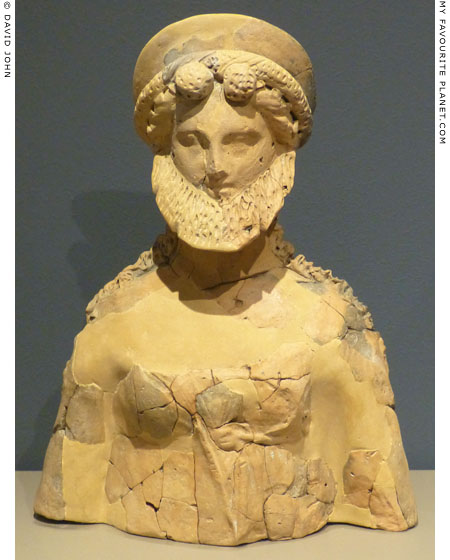
Terracotta bust of Dionysus.
From Mikri Santa, Imathia, Macedonia. 150-100 BC.
This bust has been made in a similar way to the one above. The face looks quite feminine, and
the figure also has steeply sloping shoulders and what appear to be breasts, below which is a
girdle, tied at the front with a Herakles knot in the manner of female deities. The projecting beard,
covered with roughly incised indents, looks false, like an item of ceremonial or ritual costume.
Thessaloniki Archaeological Museum. |
| |
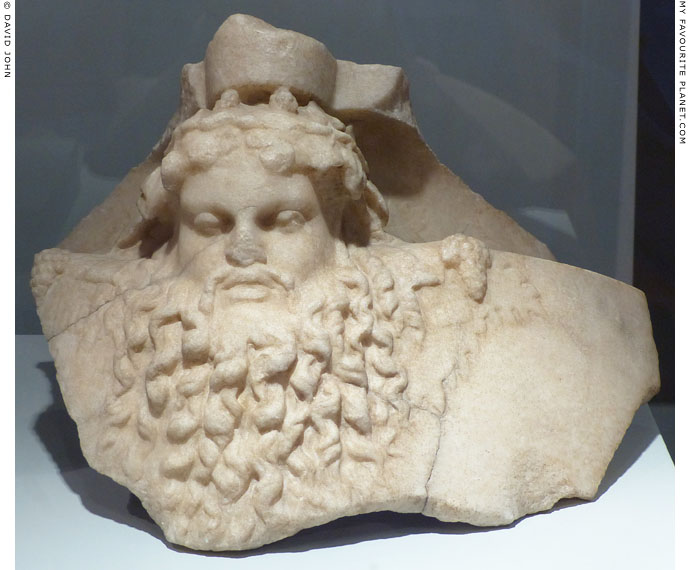
Fragment of a marble vase with a mask of Dionysus.
1st century BC - 1st century AD. Parian marble.
Barracco Museum, Rome. Inv. No. MB 168. |
| |
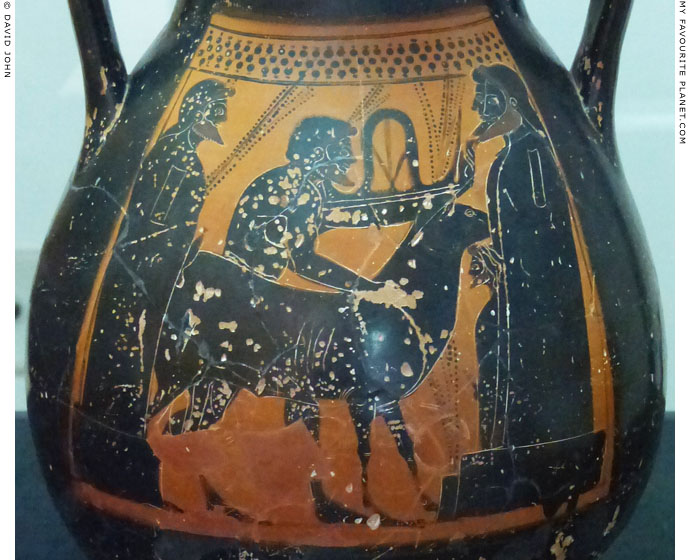
Detail of an Attic black-figure pelike with a worshipper sacrificing before four herms of Dionysus.
Last decade of the 6th century BC.
National Archaeological Museum of Paestum, Campania, Italy.
See: Beazley Archive Database, Vase No. 14643 |
| |
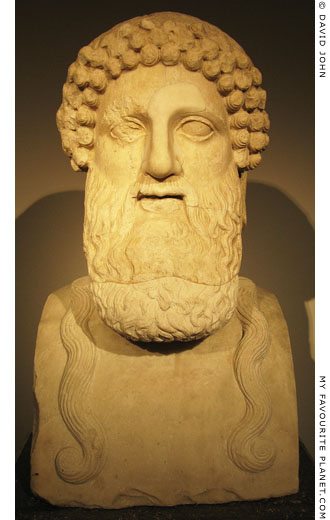 |
|
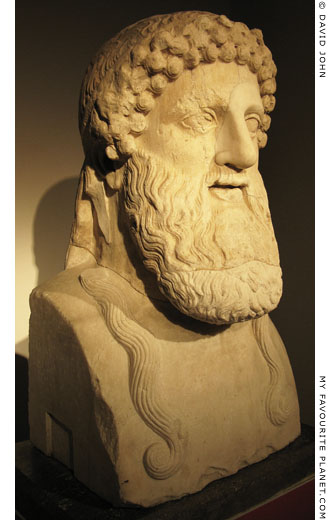 |
"Bärtiger Dionysos" (Bearded Dionysos), marble Archaistic herm of Dionysus.
Roman, 1st - 2nd century AD. Height 69 cm.
Pergamon Museum, Berlin. Inv. No. K. 207.
|
|
Acquired in 1766 from the Natali Collection in Rome by the art dealer Giovanni Ludovico Bianconi for King Friedrich II of Prussia (Frederick the Great, 1712-1786) who placed it in the Neue Palais, Sanssouci, Potsdam.
Restoration included the repair and addition of part of the left eyebrow, the nose, most of the top lip, the back of the head, the bust with most of the back and shoulders, side-locks and the end of the beard.
As the museum labelling mentions, such representations of Dionysus and his brother Hermes became so similar that they are often impossible to distinguish.
See: Alexander Conze, Beschreibung der antiken Skulpturen mit Ausschluss der pergamenischen Fundstücke (Description of the ancient sculptures with the exception of the Pergamon finds), page 53. Generalverwaltung, Königliche Museen zu Berlin. Verlag von W. Spemann, Berlin, 1891. At the Heidelberg University Digital Library.
If you can understand German, it well worth reading this illustrated catalogue of many of the ancient sculptures acquired by Berlin museums up to the end of the 19th century. Naturally, since 1891 there have been many new acquisitions, as well as reappraisals of several objects. Many of Berlin's antiquities went missing during World War II, including the famous Mycenaean jewellery discovered by Heinrich Schliemann, and a painted head of Athena (pages 39-49; see a photo of it on Athens Acropolis gallery, page 13).
See more about herms on Pergamon gallery 2, page 15. |
|
| |
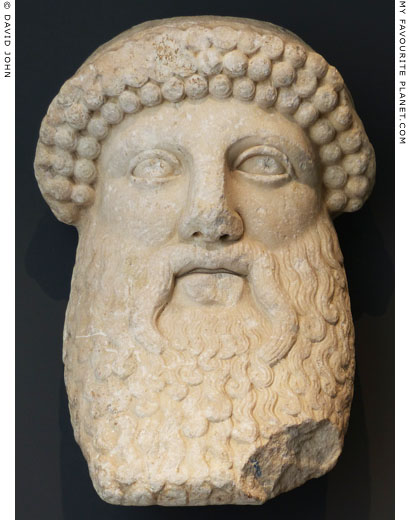
A large marble protome (head) of Dionysus or Hermes,
in the style of Archaistic herm heads.
Hadrianic period, 117-138 AD. Provenance unknown. Pentelic marble.
The back of the mask-like head is flat, and it probably decorated a building.
Despite the fact that the origin and history of the sculpture are unknown, it
is thought to represent Dionysus, and to be from a theatre, as a dedication
to the ludi scaenici (theatrical performances). In the museum it is exhibited
high up on a wall, presumably to emphasize its original architectural setting.
Palazzo Massimo alle Terme, National Museum of Rome. Inv. No. 238248. |
| |
 |
|
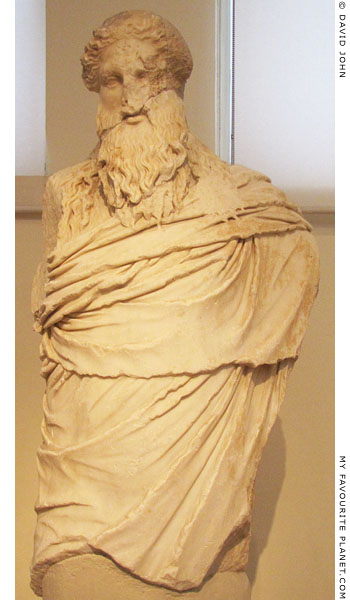 |
Marble statue of the "Dionysos-Sardanapalos" (Διόνυσος Σαρδανάπαλος)
type, depicting the god with a long wavy beard and tresses, and wrapped
in a chiton (tunic) and a himation (cloak).
1st century AD. Restored 1918-1920 from several fragments found
separately between 1865 and after 1891 at the Theatre of Dionysos,
Athens. Pentelic marble. Height 123 cm.
National Archaeological Museum, Athens. Inv. No. 1656.
|
|
Statues of the "Dionysos-Sardanapalos" (or "Dionysus-Sardanapalus") type are believed to be Roman period copies of a Greek original of around 350-325 BC, attributed to the school of Praxiteles. The type is named after the late Roman period inscription (or perhaps added by modern restorers) "ϹΑΡΔΑΝΑΠΑΛΛΟϹ" (Sardanapallos) on the example now in the Museo Pio-Clementino of the Vatican Museums (see image right). It was found in 1761 in a vineyard near Frascati, at a village named Monte Porzio Catone after the so-called Villa di Catone Uticense, believed to have been the villa of Cato the Younger (Marcus Porcius Cato Uticensis, 95-46 BC). The statue was restored with a modern thyrsos of wood and iron.
The inscription led 18th century scholars such as Johann Joachim Winckelmann to believe the statue depicted the legendary king of Assyria (perhaps Ashurbanipal or Ashur-uballit II) mentioned in Persica, a lost work by the Greek writer Ctesias, later summarized by Diodorus Siculus. The statue was identified as a depiction of Dionysus by the antiquarian and art historian Ennio Quirino Visconti in the early 19th century. [9]
Other "Dionysos-Sardanapalos" type sculptures:
Statue, Palazzo Massimo alle Terme, Rome (see below).
Fragment of the head of the Terme statue. Ashmolean Museum, Oxford (see below).
Bust, National Archaeological Museum, Naples (see below).
Statue, British Museum. Inv. No. GR 1878,1106.1 (Sculpture 1606). See below.
"Dioniso barbato", statue, Centrale Montemartini, Capitoline Museums, Rome. Inv. No. 3035. Purchased on the art market, Rome, 1957. Height 195 cm. Head and right arm restored.
Bust, Antonino Salinas Regional Archaeological Museum, Palermo, Sicily. Inv. No. 713.
Bust, Uffizi Gallery, Florence. (Inv. No. 376 ?)
Very little information and apparently no photos of this bust have been published. It may not be on display.
Statuette, Heraklion Archaeological Museum, Crete.
Inv. No. 315. 2nd - 3rd century AD. The figure wears a wreath of ivy and pine nuts. Traces of red colour. Found in the vineyard of the Villa Ariadne, Knossos. Height 61 cm. |
|

An engraving of the Sardanapalos
statue in the Vatican, published
by Winckelmann in 1767. [10]
Thought to be a 1st century AD
copy of a 4th century BC orginal.
Pentelic marble. Height 202 cm.
Sala della Biga, Museo Pio-Clementino,
Vatican Museums, Rome. Inv. No. 2363. |
|
| |
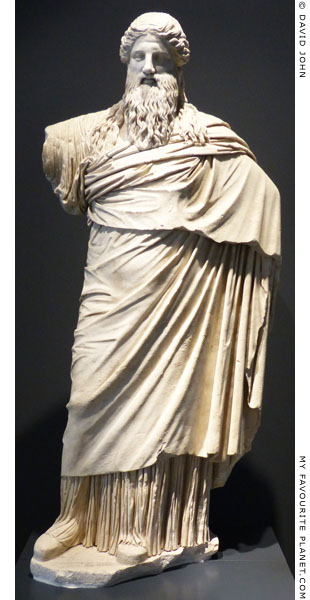 |
|
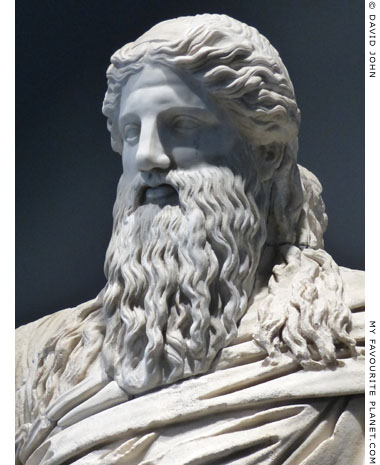 |
Marble statue of the "Dionysos-Sardanapalos" type.
1st century AD. Pentelic marble. Height 206 cm. Found in 1926 in the area
of Due Sante (probably a villa), Via Appia, Castel Gandolfo, Rome.
Palazzo Massimo alle Terme, National Museum of Rome. Inv. No. 108605. |
|
| |
Athough it is often stated that the statue was discovered in 1928, the British archaeologist and art historian Bernard Ashmole (1894-1988) reported seeing it in 1926, just after its discovery. The missing face was restored in 1942, based on the statue in the Museo Pio-Clementino (see above).
Presented by Mussolini in 1944 as a gift to Germany, it was exhibited in the Nietzsche Archiv, Weimar, as a symbol of the cult of "Dionysos-Nietzsche". After the Second World War it was moved to the Pergamon Museum, East Berlin, and in 1991, following the reunification of Germany and claims for its repatriation by the Italian government, it was returned to Italy.
Ashmole also reported that the missing part of the head turned up on the London art market in summer 1929, and it was purchased for the Ashmolean Museum, Oxford (see photo right).
See: Bernard Ashmole, Sardanapalus again, The Journal of Hellenic Studies, Volume 50, Issue 1, November 1930, page 142. At the Internet Archive.
The "again" in the title of the short report refers back to Ashmole's 1919 article on the Dionysos-Sardanapalos type, which followed Katharine A. McDowall's 1904 article.
Bernard Ashmole, The so-called 'Sardanapalus'. The Annual of the British School at Athens, Volume 24, Supplement (1919/1920 - 1920/1921), pages 78-87. At jstor.
Katharine A. McDowall, The so-called 'Sardanapalus'. The Journal of Hellenic Studies, Volume 24, 1904, pages 255-259. At the Internet Archive. |
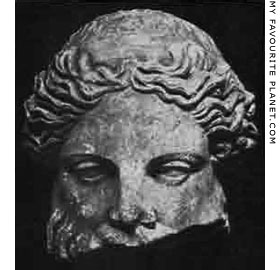
The fragment of the head of the
Terme Dionysos-Sardanapalos statue,
now in the Ashmolean Museum, Oxford.
Inv. No. 1966.663. Height 26 cm.
Source: Bernard Ashmole,
Sardanapalus again, 1930. |
| |
| |
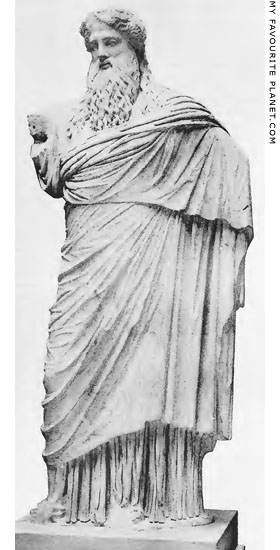
The Dionysos-Sardanapalos statue in the
British Museum. Sculpted from a single
block of Pentelic marble, apart from the
missing right arm, which was made
separately. The larger than lifesize figure
wears an ivy wreath and probably held
a thyrsos in the raised right hand.
40-60 AD, Roman Imperial period, based
on a lost Greek original of around
350-325 BC. Said to be from Posillipo,
Bay of Naples, Campania. Purchased in
Rome in 1878 from the art dealer
Alessandro Castellani (1823-1883).
Height 201.25 cm.
Inv. No. GR 1878,1106.1
(Sculpture 1606).
Not on display.
Source: Katharine A. McDowall,
The so-called 'Sardanapalus', 1904. |
|
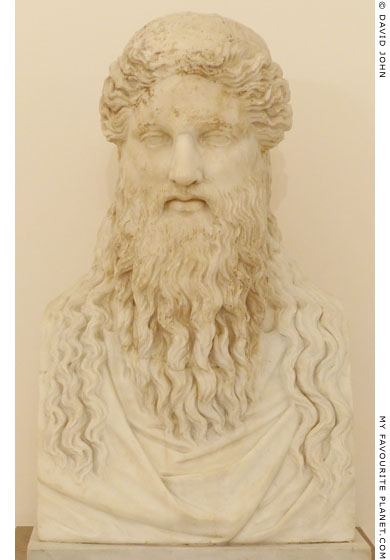
Marble head of the "Dionysos-Sardanapalos" type
on a modern herm.
Mid 2nd century AD, based on a 4th century BC
Greek original. Nose restored.
National Archaeological Museum, Naples.
Inv. No. 6306. Farnese Collection. |
|
| |
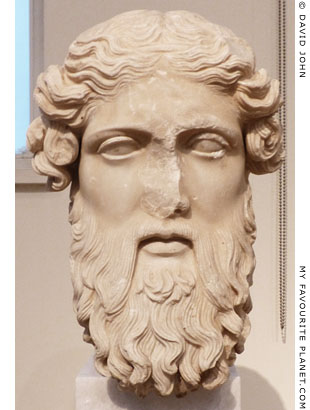
Marble head of bearded Dionysus
of the Athens/Kos type, related to
the "Dionysos-Sardanapalos" type.
1st century AD Classicistic work inspired
by 4th BC century originals. Found in
the theatre near Zea Harbour, Piraeus.
National Archaeological Museum, Athens.
Inv. No. 3478. |
|
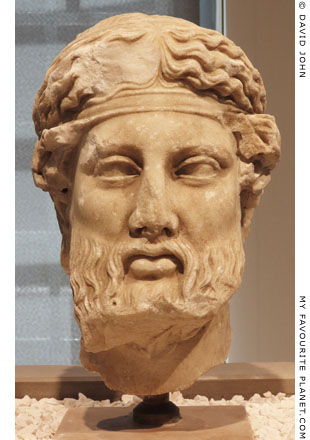
Archaistic marble head of Dionysus
from Korkyra (Κόρκυρα, today Corfu).
Roman Imperial period, 2nd century AD.
Corfu Archaeological Museum. |
|
| |

Marble double herm bust of bearded Dionysus.
Roman Imperial period.
Sala del Fauno, Palazzo Nuovo,
Capitoline Museums, Rome.
Inv. No. MC 257. From the Albani Collection. |
|
|
|
| |
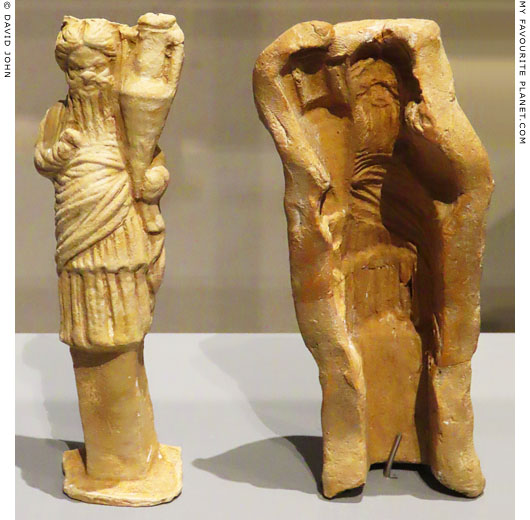
An Archaistic ceramic figurine of a herm of Dionysus, bearded, wearing
a himation wrapped around a long chiton, holding an amphora with his
left hand. On the right is the ancient mould in which it was cast.
3rd - 2nd century BC. From Chalkis, Euboea, central Greece.
New Archaeological Museum "Arethousa", Chalkis. |
| |
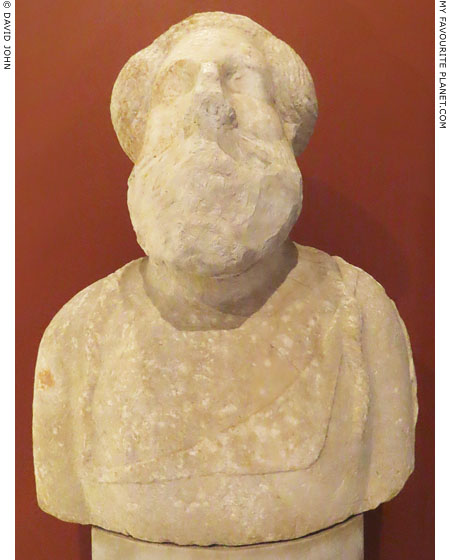
A colossal marble bust of bearded Dionysus, unusually with
the head tilted back, so that the god is shown looking up.
It is thought to have been used for worship at a sanctuary
of Dionysus in the ancient Thracian settlement on which the
modern city Drama (Δράμα) now stands. Its ancient name
is unknown, but it may have been Drabiskos (Δραβησκός),
an inland city of the Thracian Hedones tribe mentioned by
ancient sources. Another theory links it to the ancient Greek
settlement named either Dyrama (Δύραμα) or Hydrama
(Ύδραμα), both meaning rich in water. The location of the
local Dionysus sanctuary has also not yet been located.
This unusual, perhaps unique, bust has been cited as one
of the earliest artifacts attesting the worship of Dionysus
in this part of Thrace (later part of Macedenia).
Another local sanctuary of Dionysus at Kali Vrysi (Καλή
Βρύση, Beautiful Springs), on a plateau 23 km northwest
of Drama, is thought to have been an important rural
centre of worship location for the Dionysus cult.
Found in Drama, East Macedonia, Greece.
First half of the 5th century BC, early Classical period.
Drama Archaeological Museum. Inv. No. Λ 90. |
|
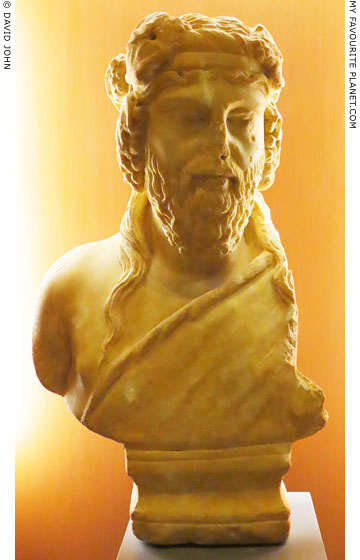
Marble bust of bearded Dionysus, crowned with
a mitre and a wreath of ivy leaves and berries.
He wears a garment, perhaps a nebris, which
crosses his chest diagonally from his left shoulder
(now missing). Long tresses of hair fall from the
back of his head and over his chest.
Found in Drama, East Macedonia, Greece.
2nd century AD, Roman Imperial period.
Drama Archaeological Museum. Inv. No. Λ 187.
The vertical white streak above the right eye
is a feature of the sculpture, not an optical
abberation. It is an impressive and evocative
sculpture, and the designers of the museum's
exhibition have given it a prime position in a
dramtically illuminated alcove. Evidently it is
considered a star attraction of the museum.
On the other hand, the more ancient and
enigmatic bust of Dionysus (photo, left),
arguably much more important historically,
is exhibited in a dimly lit corner. |
|
| |
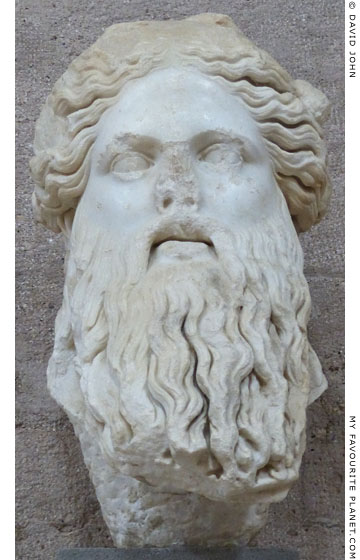
Marble head of bearded Dionysus.
2nd century AD. From the Peribolos
of Apollo, ancient Corinth.
Corinth Archaeological Museum. Inv. No. S-987. |
|
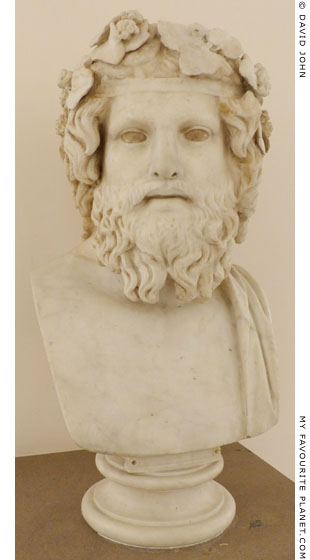
Marble bust of bearded Dionysus.
2nd century AD.
National Archaeological Museum, Naples.
Inv. No. 6350. |
|
| |
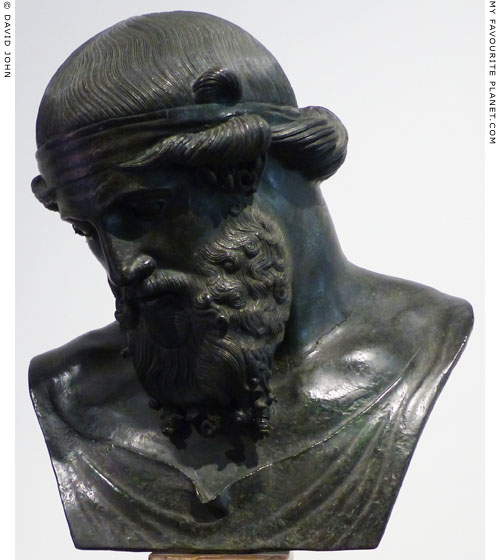
Bronze bust known as "Dionysus-Plato", from Herculaneum.
49-25 BC. Found in the Villa of the Papyri (Villa dei Papiri), Herculaneum,
18 April 1759. Height 50 cm, width 28.8 - 44.5 cm, depth 22,5 cm.
National Archaeological Museum, Naples. Inv. No. 5618.
|
Little has been written about this bust which appears to have baffled many scholars. It depicts a mature bearded male with long hair held by a fillet (headband), wearing a chiton (tunic). He has been identified as either Dionysus or Priapus (Πρίαπος, Priapos), the son of Dionysus and Aphrodite. Following its discovery the work was attributed by some scholars to Skopas or Praxiteles.
More obscure is the identification as "Dionysus-Plato" (Διόνυσοπλάτων, Dionysoplaton), a figure mentioned as depicted on a seal of a will on papyrus from Oxyrhynchos, Egypt, written during the reign of Emperor Hadrian (117-138 AD), and thought to represent the Athenian philosopher Plato deified as Dionysus. Several Roman period busts which appear to depict a bearded god bear the inscription "Πλάτων" (Plato), assumed to have been added later for collectors who wanted to own a likeness of the philosopher, but which according to other theories may belong to the type "Dionysus-Plato". |
|
| |
| Dionysus |
Beardless Dionysus
Dionysus was depicted as youthful and clean-shaven
from the Classical period (5th centuy BC). |
|
 |
|
| |
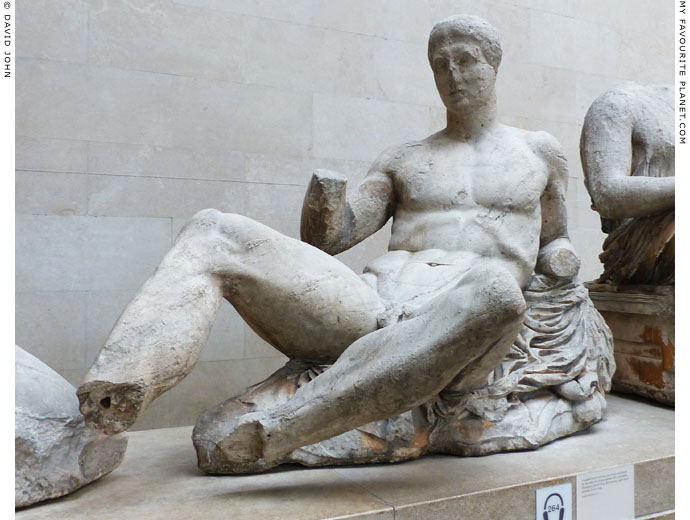
A marble statue of a naked young man, thought to represent
Dionysus, reclining on a rock covered by the skin of a female animal.
From the east pediment of the Parthenon. Width 1.3 metres.
British Museum. Inv. No. 1816,0610.93 (East pediment D). Part of the "Elgin Marbles".
|
The pedimental sculptures of the Parthenon were made of Pentelic marble by Pheidias and his pupils 438-432 BC. According to Pausanias (Description of Greece, Book 1, chapter 24, section 5), the theme of the east pediment was the birth of Athena, and that of the west pediment the contest between Athena and Poseidon for the patronage of Athens.
Each of the sculptures is actually a free-standing statue, executed in the round, rather than the type of reliefs known from the pediments of other temples (see for example the high relief of Dionysus from the Temple of Apollo in Delphi below). They are remarkably detailed and finished, particularly considering that they stood so high on the Parthenon that many parts would not be visible to the viewer on the ground. An entire pediment can be seen only when standing some distance from the building; the view of the figures from the angle shown in the photo above was not possible when they were in place.
"Figure D", the only sculpture of the pediments still with an intact head, has been identified as Dionysus, although Herakles and Theseus have also been suggested. The youthful, athletic god is shown lounging on a rock covered with a panther skin, between the horses of the chariot of the sun god Helios (left) and two seated female figures, thought to be Demeter and Persephone (right). If this is Dionysus, he may have held a wine cup in his missing right hand. |
|
| |

A cast of the marble statue of Dionysus from the east pediment of the
Parthenon, on permanent exhibition in the Acropolis metro station, Athens. |
| |

Fragmentary ceramic vase in the form of Dionysus' head.
Circa 410 BC. Found on 15 April 1954 in a well to
the north of the Nymphaeum, on the southeast
side of the Athenian Agora. Height 14.8 cm.
Agora Museum, Athens. Inv. No. P 23822. |
| |
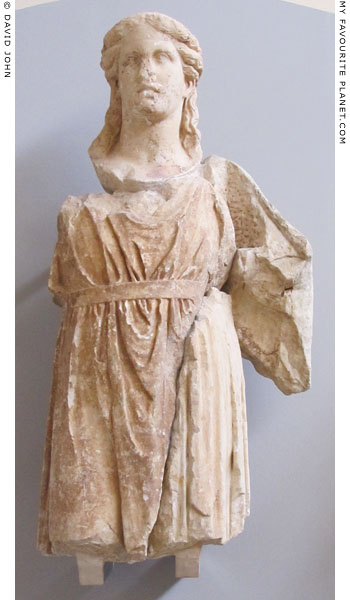 |
|
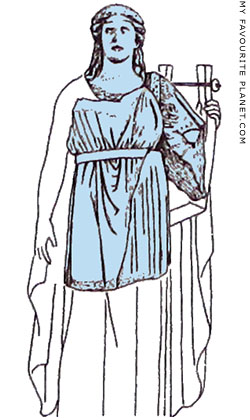
Reconstruction drawing of the
Dionysos relief from Delphi
(surviving parts in blue), showing
the god holding a kithara and
wearing a long chiton and himation. |
Marble high relief of youthful Dionysus from the west pediment of the Late Classical
Temple of Apollo in Delphi. Circa 330 BC. Present height of figure 150 cm.
Delphi Archaeological Museum, Greece.
Head, Inv. No. 2380. Height circa 50 cm.
|
|
According to Pausanias, the pediments of the Temple of Apollo, the most important temple in Delphi which contained the oracle, were made by the Athenian sculptors Praxias and Androsthenes. The reliefs on the east pediment (above the entrance) depicted Artemis, Leto, Apollo, Muses and a setting Sun (Helios); the west pediment reliefs depicted Dionysus with the Thyiads. Praxias died during the lengthy construction of the temple, thought to have taken around twenty years, and his work was completed by Androsthenes.
"The carvings in the pediments are: Artemis, Leto, Apollo, Muses, a setting Sun, and Dionysus together with the Thyiad women. The first of them are the work of Praxias, an Athenian and a pupil of Calamis, but the temple took some time to build, during which Praxias died. So the rest of the ornament in the pediments was carved by Androsthenes, like Praxias an Athenian by birth, but a pupil of Eucadmus."
Pausanias, Description of Greece, Book 10, chapter 19, section 4.
The sculptures of the east pediment have not been discovered, and may have been taken to Rome. Only a few fragments have survived of the west pediment's frieze, which show Dionysus standing in the centre of a group of dancing female figures, believed to be Thyiads (Θυιάδες, Thiades; singular, Θυία, Thyia), women in his thiasos who held dances on Mount Parnassos. [11]
Dionysus resided at Delphi in the winter when the oracle was closed and Apollo stayed among the Hyperboreans (Ὑπερβόρεοι), the mythical people who lived beyond the North Wind. The grave of Dionysus was said to be within the temple. Athens sent a delegation of women known as Thyiads to the orgia (ὄργια), ecstatic sacred rites on Mount Parnassos that took place in winter.
"The Thyiads are Attic women, who with the Delphian women go to Parnassus every other year and celebrate orgies in honour of Dionysus. It is the custom for these Thyiads to hold dances at places, including Panopeus, along the road from Athens."
Pausanias, Description of Greece, Book 10, chapter 4, section 3.
"Others maintain that Castalius, an aboriginal, had a daughter Thyia, who was the first to be priestess of Dionysus and celebrate orgies in honor of the god. It is said that later on men called after her Thyiads all women who rave in honour of Dionysus. At any rate they hold that Delphus was a son of Apollo and Thyia. Others say that his mother was Melaena, daughter of Cephisus."
Pausanias, Description of Greece, Book 10, chapter 6, section 4.
The figure of Dionysus wears the mitra (headband) of cult initiates, a long chiton belted at the waist, and a himation (cloak) which hangs from his shoulders. Unusually, he is thought to have originally held in his left hand a kithara [12], normally an attribute of Apollo (as "Apollo Kitharodos"). At either end of the frieze was a seated panther. |
|
| |
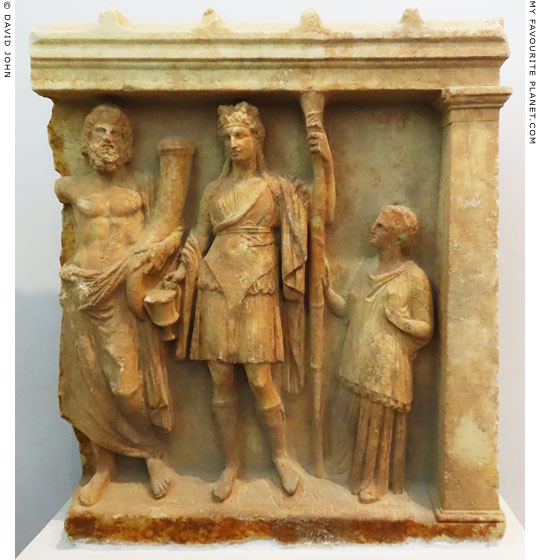
A votive relief in the form of a naiskos with a depiction of Plouton (Hades) holding
a cornucopia, and Dionysus holding a kantharos and thyrsos. On the right stands
a young supplicant shown at a smaller scale to the gods.
On the epistyle is the greek inscription:
[...ΙΕΡΑΤΕΥ]ΣΑΣΑ ΤΟΙΝ ΘΕΟΙΝ
Offering of a priestess to the gods.
Dionysus is known to have been associated with Plouton, particularly in Orphic
literature and the Eleusinian Mysteries (see Demeter and Persephone; see also
the statue of Dionysus from Eleusis below). It has been suggested that on the
missing left third of the relief may have been a depiction of Hermes Psychopompos
(Ἑρμῆς Ψυχοπομπός, Guide of Souls) who led the souls of deceased mortals to
Hades, Plouton's underwold kingdom.
Mid 4th century BC, late Classical period. From Karystos, southeastern Euboea.
Chalkis "Old" Archaeological Museum, Evia. Inv. No. MX 337. |
| |
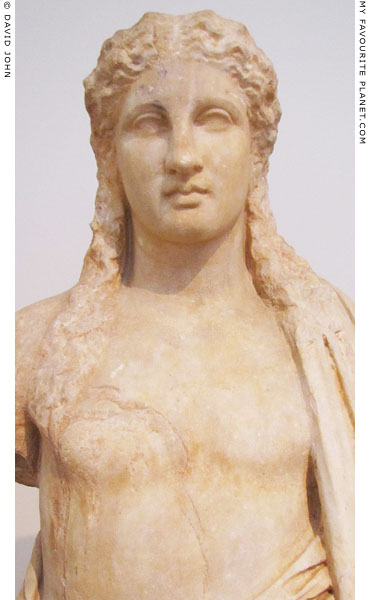 |
|
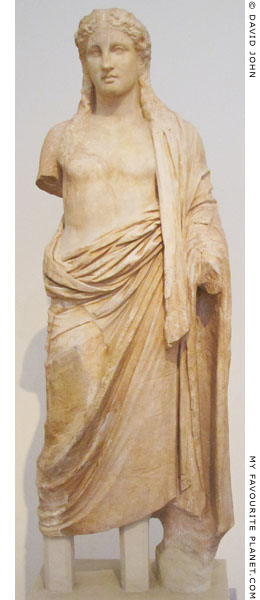 |
Marble statue of a youthful, unbearded Dionysus.
Pentelic marble. Mid 4th century BC. Found in the "Ploutonion"
in the Sanctuary of Demeter and Persephone, Eleusis, Greece.
The god's hair, parted in the middle, hangs in long wavy tresses from behind his ears, down
the side of his head and on to his shoulders and chest. He wears a himation which covers
his left shoulder and arm, and is wound around the lower part of his otherwise naked
body. Some scholars believe the statue may depict Dionysus as Iakchos or Eubouleus,
gods associated with the Eleusinian Mysteries (see Demeter and Persephone).
National Archaeological Museum, Athens. Inv. No. 255. |
|
| |
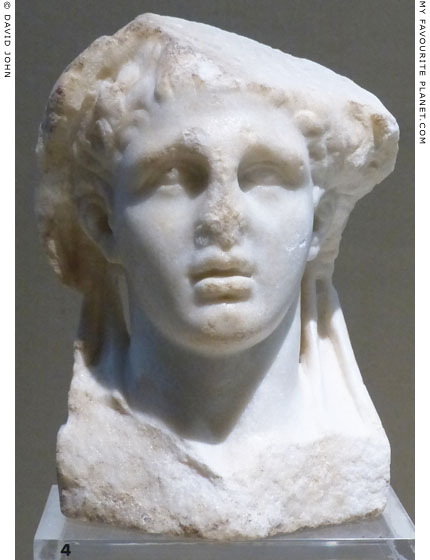
Marble head of a herm of drunken Dionysus.
3rd - 2nd century BC. Found in 1914 at
Borgata Santa Lucia, Achradine, Syracuse, Sicily.
Paolo Orsi Regional Archaeological Museum, Syracuse. Inv. No.34783. |
| |
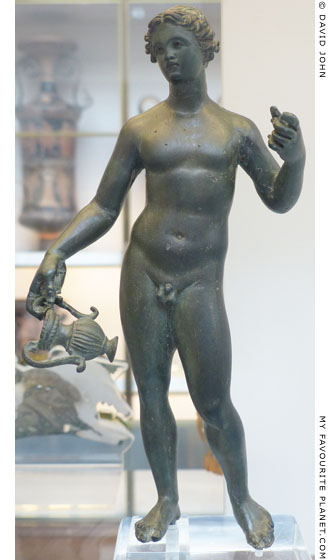
Bronze statuette of Dionysos holding
a kantharos (wine cup). Perhaps made
in Taranto, Italy, around 200 BC.
British Museum. GR 1851.8-13.1 (Bronze 808).
Comarmond Collection. From Chessy, France. |
|
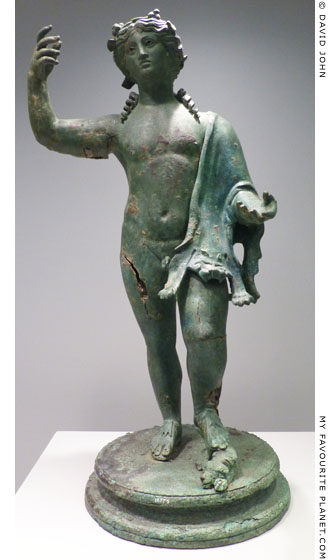
Bronze statuette of Dionysus on a
round base. Roman period, modelled
on works of the late 2nd century BC.
The figure wears a nebris (νεβρίς, panther skin)
[13] over his left shoulder and sandals. He may
have held a thyrsos in his right hand and a bowl
in the left. His left foot rests on a lying animal
which looks like a dog, but is probably a panther.
Part of the "Ambelokipoi Hoard" of Roman
period statuettes discovered in the
Ambelokipoi district of Athens in 1964.
National Archaeological Museum,
Athens. Inv. No. 16773. |
|
| |

Bronze statuette of Dionysos wearing
an ivy wreath with bunches of grapes,
a nebris (fawnskin) over a chiton, and
high traveller's boots (endromides). He
probably held a thyrsos in his left hand
and a drinking cup in the right.
Mid 2nd century BC. Said to have been
found in Chochlia (Χόχλια), Aitolia
(Eurytania, Central Greece). Hollow cast:
the head, arms and body were cast
separately. The left arm was repaired
in antiquity. Height 47 cm.
National Archaeological Museum,
Athens. Inv. No. X 15209.
Handed into the museum in 1936. |
|
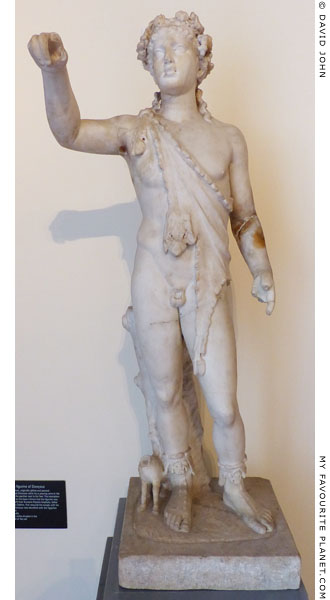
Marble statuette of Dionysus wearing a vine
wreath and a nebris. His raised right hand is
thought to have held a kantharos (wine cup)
with which he poured wine into the mouth of
the small panther (now headless) at his feet.
From the Temple of Isis, Pompeii.
Reign of Emperor Claudius (41-54 AD).
The statuette was originally gilded and painted.
The inscription on the base states that it was
a votive gift from Numerio Popidio Ampliato,
father of Popidio Celsino, who restored the
temple with his money. The Romans identified
Dionysus with the Egyptian god Osiris.
National Archaeological Museum, Naples.
Inv. No. 3.7. |
|
| |
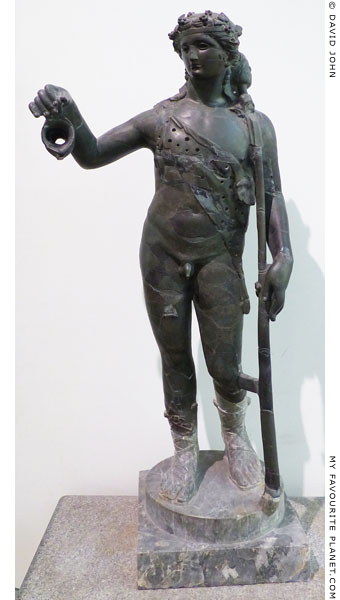 |
|
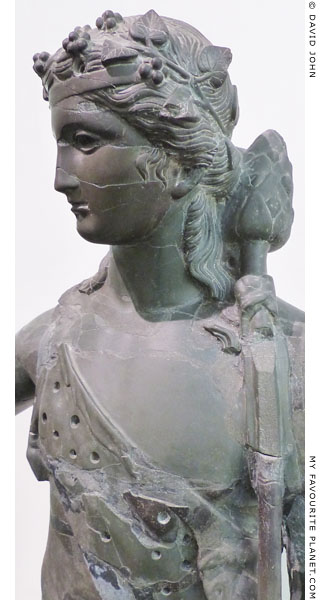 |
Black marble statue of Dionysus, wearing a diadem, ivy wreath, a nebris
and high sandals. He holds a wine jug in his raise right hand, and with his
left hand he holds his thyrsos, the top of which rests on his left shoulder.
Baths of Diocletian, National Museum of Rome.
See also statues of Emperor Hadrian's deified favourite Antinous
depicted as Dionysus, wearing an ivy wreath and panther skin. |
|
| |
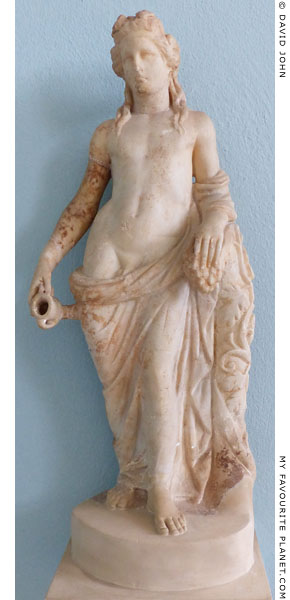
Marble statuette of Dionysus wearing
an ivy wreath and a himation (cloak),
which hangs loosely from his left arm
and hips, covering his legs but leaving
his torso and genitals exposed. He
leans against a tree stump on which
his left elbow rests. In his left hand
he holds a bunch of grapes, and in
his lowered right hand an apparently
empty kantharos (wine cup).
From Eleusis, Greece. Roman period.
Eleusis Archaeological Museum. |
|
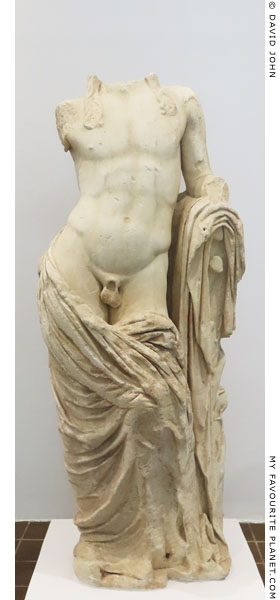
An over-lifesize marble statue of a god,
either Dionysus or Apollo. There were
sanctuaries dedicated to both gods in
ancient Chalkis, and both divine half-
brothers were depicted in this pose.
However, the missing head, right arm
and left hand, as well as the lack of
specific attributes, make identification
impossible. As in the statuette from
Eleusis (photo, left), one end of the
standing figure's himation is draped
over his left arm, it covers his lower
back and legs, while leaving the front
of his torso and genitals exposed
(see also a silver relief of Dionysus
in this pose below). Long tresses of
hair rest on each shoulder, and the
back of his right hand rests on is hip.
2nd century AD, Roman Imperial period,
after an unknown Hellenistic prototype.
Found in the Agios Ioannis district of
Chalkis (today Chalkida), Euboea,
central Greece.
Chalkis "Old" Archaeological Museum.
Inv. No. MX 12. |
|
| |
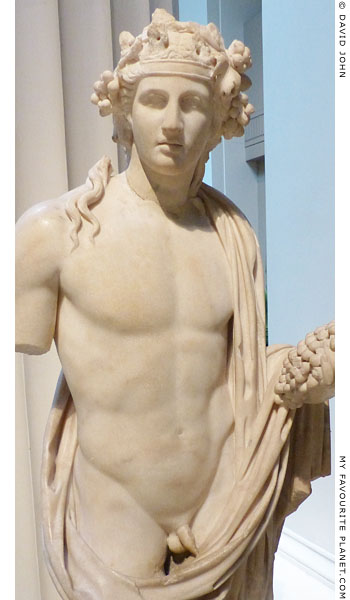 |
|
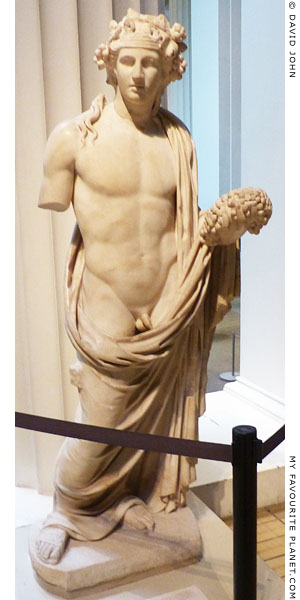 |
Marble statue of Dionysus from the Temple of Dionysus in Cyrene (Κυρήνη), Libya.
The god, depicted as young and clean-shaven, wears an ivy wreath and holds a bunch
of grapes in his left hand. Most of the right arm below the biceps is missing. The broad
swathe of the lower part of his himation (cloak) is revealing and overtly erotic.
Roman Imperial period, 2nd century AD. Perhaps the cult statue of the temple. Thought
to be a Roman adaption of an existing type of statue rather than a copy of a Greek original.
British Museum. Inv. No. 1861,0725.2 (Sculpture 1476). |
|
| |
 |
|
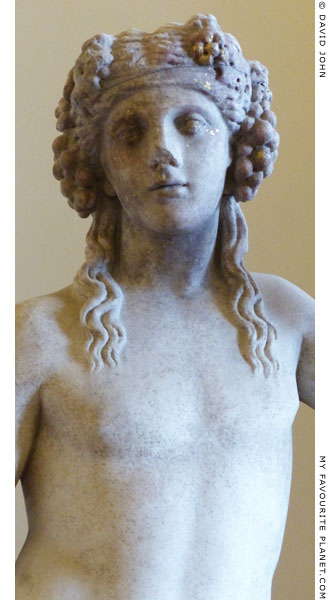 |
Marble statue of Dionysus from the Janciculum "sanctuary", Rome.
Luni Marble. Roman Imperial period, second half of the 2nd century AD. Discovered 1908.
The pretty young god stands naked in a sensual pose, with an expression which could
be interpreted as dreamlike or drunken. An emptied kantharos (drinking cup) hangs from
his right hand, and he may have originally held a thyrsos in his left hand. Bunches of
grapes hang from his headband. Traces of gold leaf on the head and hands suggest
that the statue was gilded in the way usual for the sun god Dionysus-Helios.
Palazzo Altemps, National Museum of Rome. Inv. No. 60920. |
|
| |
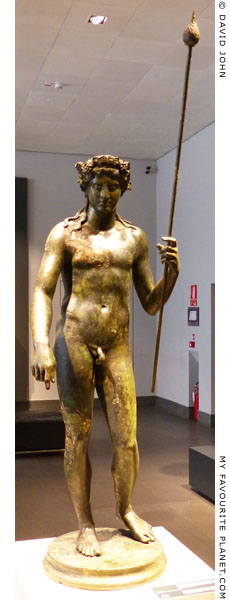 |
|
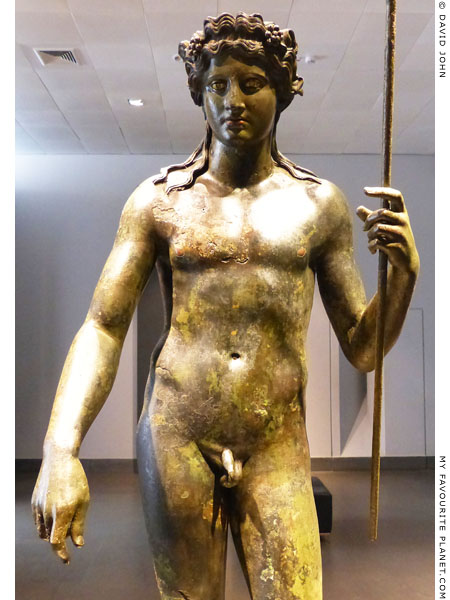 |
"Dioniso da ponte Garibaldi", a bronze statue of Dionysus as a beardless adolescent.
Reign of Emperor Hadrian, 117-138 AD. Found in 1885 on the bed of the Tiber
river, during excavation for the foundations of a pier for the Ponte Garibaldi,
west of the Isola Tiberina (Tiber Island, see Asklepios), Rome. Height 158 cm.
Palazzo Massimo alle Terme, National Museum of Rome. Inv. No. 1060.
|
|
The nude god stands with his weight on his right leg, holding a thyrsos in his left hand, his head turned slighty to the right. His long, wavy hair, parted in the middle, is held in place by a ribbon with red, white and blue vertical stripes, tied around the head and adorned with ivy twigs, leaves and clusters of berries. Two locks of hair fall from each side of the back of the head and rest on each shoulder. The inlaid eyes have brown pupils, and his full lips are coloured red (see photo below). The figure was made using the lost wax method.
Following its discovery the statue was restored, with missing parts, particularly on the legs, replaced by plaster. The additions were removed during conservation work in 1984-1985. The figure has been compared to works attributed to Polykleitos the Younger and Praxiteles, as well as the "Woburn Abbey type" statues of Dionysus, of which there are over twenty examples, thought to be Roman period copies of a mid 4th century BC Greek original. |
|
| |
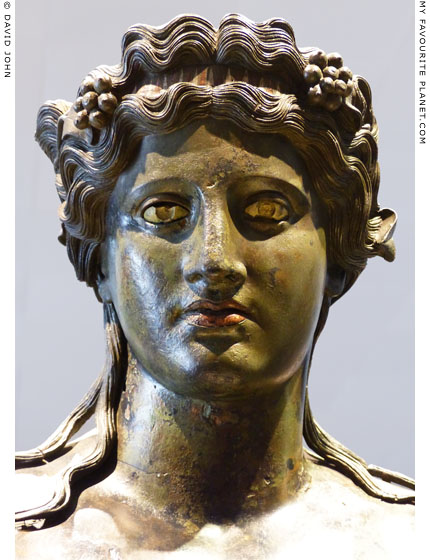
The head of "Dioniso da ponte Garibaldi" statue. |
| |
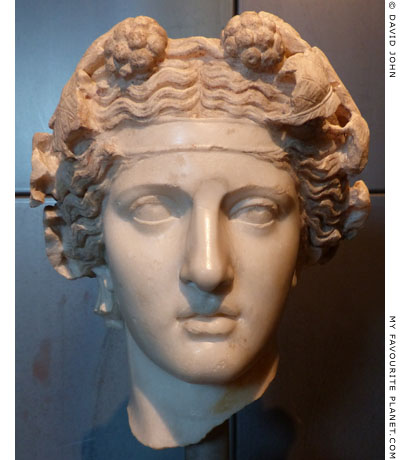
Marble head of Dionysus, wearing a ribbon low across the
forehead, and vine leaves and ivy berries around the top.
Antonine period, mid 2nd century AD. Roman eclectic work
inspired by Hellenistic models. From the Horti Lamiani,
Rome; found November 1882 near the Piazza Vittorio
Emanuele. Pentelic marble. Height 35 cm. Nose restored
with in marble) nose; lower neck restored with plaster.
Palazzo dei Conservatori, Capitoline Museums, Rome. Inv. No. MC 1129. |
| |
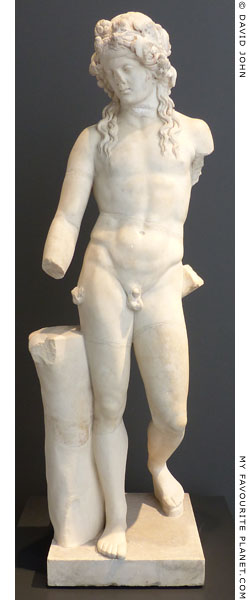 |
|
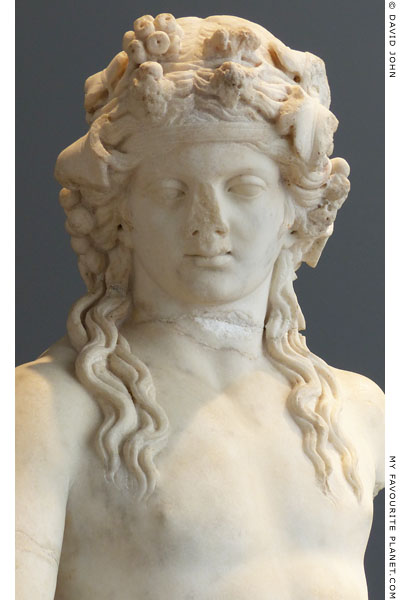 |
A marble statue of Dionysus from Rome.
Antonine period, circa 150 AD. Thought to be a Roman copy of a Late Hellenistic
(2nd century BC) reworking of a statue attributed to Praxiteles (mid 4th century BC).
Found on the Piazza del Viminale, Rome, during the construction of the foundations
for the Ministry of the Interior building, 1913-1916.
The nude wine god steps forward, his weight resting on his straight right leg, his torso
leaning back and to the right. He wears a crown of vine leaves, shoots and clusters of
ivy berries. His head is lowered forwards, and he looks down with an apparently pensive
expression which is described by the museum labelling as "absorbed and detached".
The left arm and the lower right arm are missing. He may have held a thyrsos in the
left hand, and a kantharos (wine cup) in the lowered right hand.
Palazzo Massimo alle Terme, National Museum of Rome. Inv. No. 77428. |
|
| |
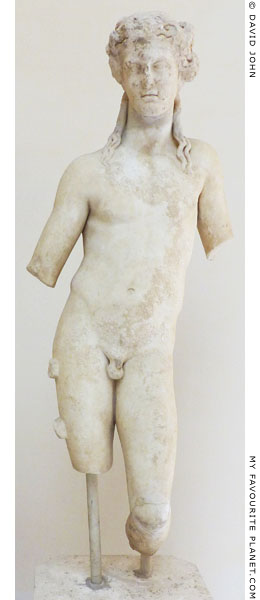 |
|
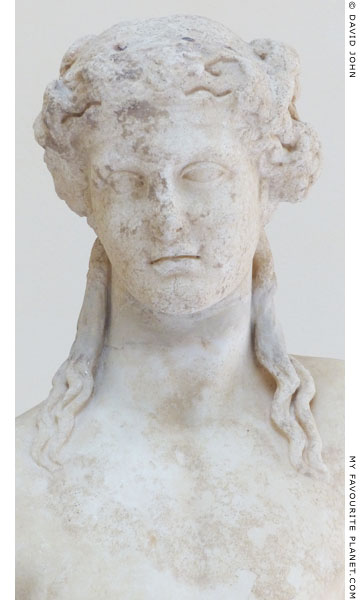 |
Marble statue of Dionysus from Ostia, near Rome.
2nd century AD. Discovered in 1938 near the Temple of Hercules (Tempio
di Ercole, I,XV,5), in the Republican sacred area, Ostia. Parian marble.
Ostia Archaeological Museum. Inv. No. 112. |
|
| |
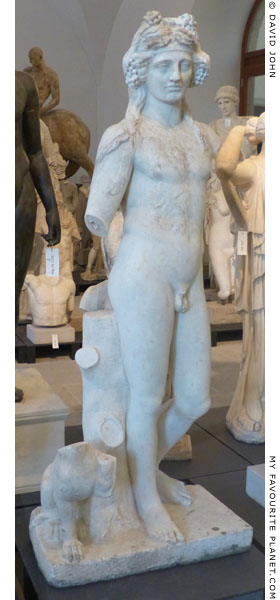
Fragmentary marble statue of
naked Dionysus with a panther.
2nd half of the 2nd century - 1st half
of the 3rd century AD. Height 165 cm,
width 68 cm, depth 40 cm.
Skulpturensammlung, Albertinum,
Dresden. Inv. No. Hm 292. |
|
|
| |
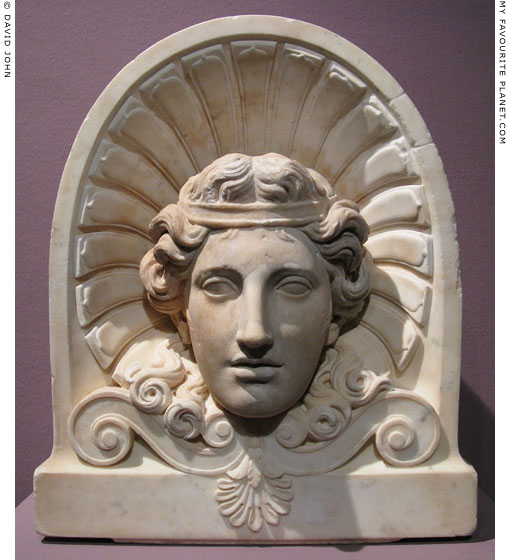
Marble head of Dionysus, originally part of a statue. Mid 2nd century AD.
Mounted on a Classicistic marble tile, probably in the 19th century.
Height 56 cm, width 47 cm, depth 28 cm.
Pergamon Museum, Berlin. Inv. No. Sk 121. |
| |
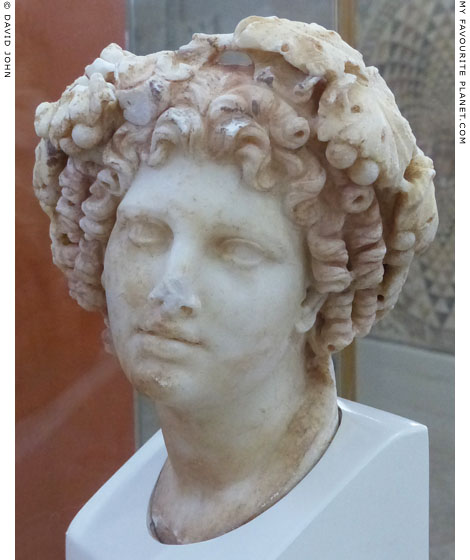
Marble head of Dionysus. The top of the head, tilted to the left, is
covered with vine leaves, and his hair falls in ringlets at both sides.
From the peribolos of Temple E ("Temple of Octavia"),
Ancient Corinth. Roman period, 2nd century AD.
Corinth Archaeological Museum. Inv. No. S 1669. |
| |
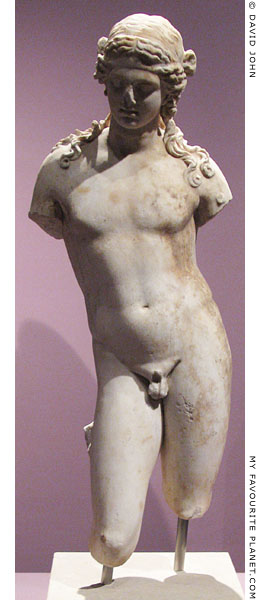
Marble statue of a youthful Dionysus.
50 - 1 BC. Found near
Stazione Termini, Rome.
Pergamon Museum, Berlin. |
|
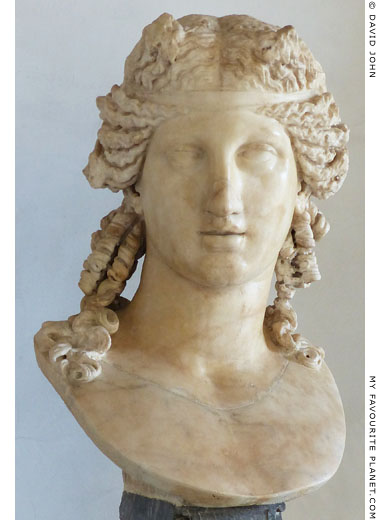
Marble bust of a youthful Dionysus.
2nd century AD, after a Hellenistic original.
Perhaps from the Vatican.
Palazzo Nuovo, Capitoline Museums, Rome.
Inv. No. MC 734. |
|
| |
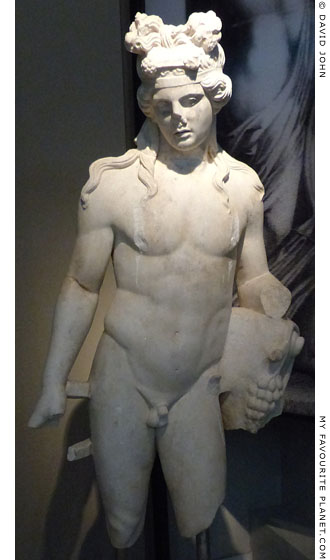
Marble statue of Dionysus, naked, leaning
on a tree trunk covered with a vine. He wears
a crown of ivy and a fillet (headband). The
elaborate arrangement of the hair on the top
of the head is more usual for statues of Apollo.
In his right hand he probably held a kantharos.
2nd century AD, Roman Imperial period.
From Thessaloniki.
Thessaloniki Archaeological Museum. |
|
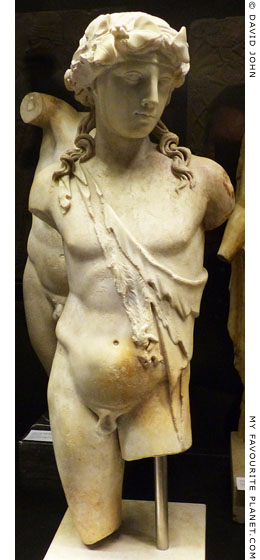
Part of a marble statuette of
Dionysus wearing a nebris.
160-190 AD. Height 76.3 cm,
width 29.5 cm, depth 19.9 cm.
Skulpturensammlung, Albertinum,
Dresden. Inv. No. Hm 098. |
|
| |
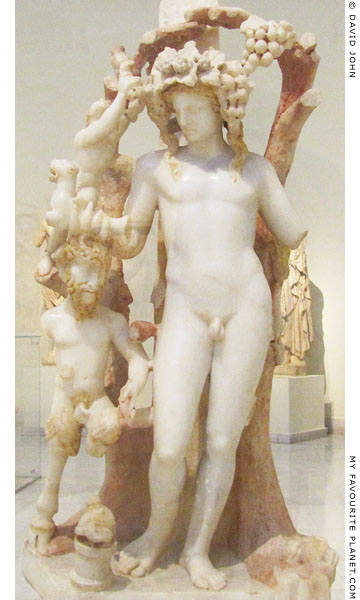
Detail of a marble table support (trapezophoron)
with a Dionysian group: Dionysus, Pan and a Satyr.
170-180 AD. From Dokimeion, Anatolia (Asia Minor). Unknown provenance.
The nude Dionysus holds a rhyton (ritual drinking
horn), one end of which is shaped like the front
of a panther. On the left goat-footed Pan holds
a lagobolon (a stick for throwing at hares). He
rests his left foot (the lower left leg is missing)
on the lid of a small cylindrical basket fron which
a snake emerges. A Satyr climbs the vine behind
Pan and cuts grapes with a sickle in his left hand.
A lagobolon hangs from the vine.
National Archaeological Museum, Athens.
Inv. No. 5706. |
|

Marble table support with
Dionysus and a panther.
Turn of the 2nd - 3rd century AD.
From Argos, Peloponnese, Greece.
Height 91 cm, width 26,5cm, depth 24 cm.
Dionysus stands naked, resting his left
arm on a tree trunk support around
which grows a grapevine. A small panther
sits below the trunk, next to a discarded,
empty kantharos (wine cup). His right
forearm (now missing) rests on top of his
head, a gesture also seen in depictions
of Apollo, and thought to represent a
state of rest or inner vision.
Pergamon Museum, Berlin.
Inv. No. Sk 91. |
|
| |
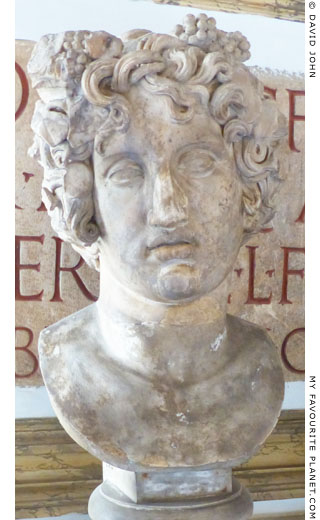
Marble bust of Dionysus.
Roman period copy of a late
4th century BC Greek original.
Palazzo Nuovo, Capitoline Museums, Rome.
Inv. No. MC 722. From the Albani Collection. |
|
|
|
| |

A silver coin of Korkyra (Corfu, see above), northwest Greece,
with the head of Dionysus, in profile facing right, wearing a
headband, and a wreath of ivy leaves and berries. 229-48 BC.
Corfu Archaeological Museum. |
|
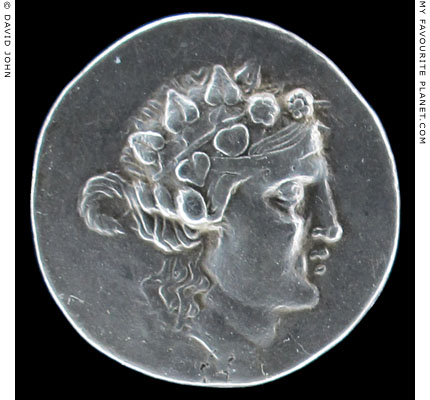
A silver tetradrachm of Thasos (Θασος), northeast Greece, with
the head of Dionysus, in profile facing right, wearing a headband,
and a wreath of ivy leaves and berries. Circa 180-170 BC.
The reverse side shows Herakles standing with his club and
lion skin, and is inscribed "ΗΡAΚΛΕΥΣ ΣΩΤΗΡΟΣ" (Herakles
Soteros, Herakles Saviour) and "ΘAΣIΩN" (Thasion).
Alpha Bank Numsimatic Collection, Athens, Greece. |
|
| |
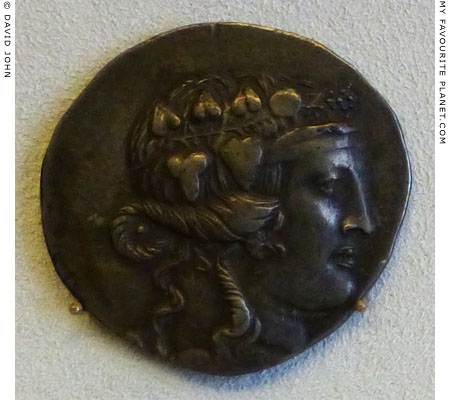
The obverse side of a silver tetradrachm of Maroneia (Μαρώνεια),
on the Aegean coast of Thrace, west of modern Alexandroupoli,
with the head of Dionysus, in profile facing right, wearing
a headband, and a wreath of ivy leaves and berries.
Circa 146-80 BC. Diameter 33 mm, weight 15.64 grams.
Münzkabinett (Numismatic Collection), State Museums Berlin (SMB).
Bode Museum, Berlin. Inv. No. 18200359. Acquired "1791 Ansbach". |
|
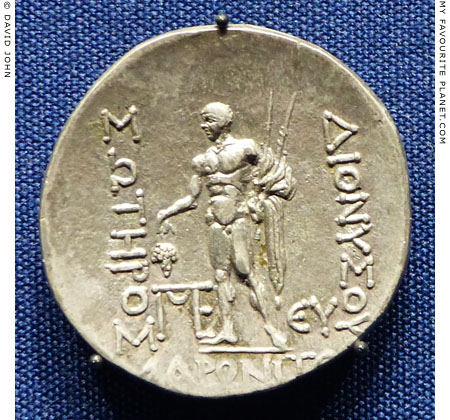
The reverse side of a silver tetradrachm of Maroneia, Thrace,
with a depiction of a nude male figure, believed to be Dionysus,
holding a bunch of grapes. The obverse shows the head of
Dionysus similar to that on the coin in the photo, left.
Circa 189-45 BC. Diameter 31.85 mm, weight 15.63 grams.
Münzkabinett, Residenzschloss, Dresden. Inv. No. AAB668. |
|
| |
The legendary or mythological founder of Maroneia was Maron (Μάρων), a son of Dionysus, Oinopion or Silenos [14]. He may have been the Maron, son of Euanthes and priest of Apollo at Ismaros (Ἴσμαρος) in Thrace, who gave Odysseus the strong, sweet wine with which he later made the Cyclops Polyphemos drunk (Homer, The Odyssey, Book 9, lines 196-212; see Homer part 3).
Archaeological excavations at the site of ancient Maroneia have revealed the remains of a Hellenistic theatre and a large sanctuary, believed to have been dedicated to Dionysus.
These coins, issued 189/188 - 49/45 BC, replaced a previous series which showed a standing horse or horse's head on the obverse side, and a bunch of grapes or vine on the reverse.
This side of this particular coin (photo, right) is among the best surviving examples (there are several in the Berllin museums collection) in terms of the quality of the engraving and the detailing of the figure. The clean-shaven, muscular nude male stands frontally, his weight resting on his straight right leg, his head turned to the left. He appears to be wearing a tainia (headband) or wreath. In his extended right hand he holds a bunch of grapes. A himation (cloak) is draped over his left arm, and with his left hand, which rests on his left hip, he holds two staves or spears, which have also been described as narthex stalks or a double thyrsos. Written vertically, either side of the figure is the inscription "ΔΙΟΝΙΣΟΥ ΣΩΤΗΡΟΣ" (Dionysou Soteros, Dionysus Saviour), and to each side of his legs is a monogram. The coin has been struck too low, so that only part of the inscription "MAPΩNITΩN", the name of the issuing authority at the bottom, can be seen.
Although I have so far not found this suggestion in modern literature, is it possible that the figure is meant to depict Maron rather than Dionysus?
The composition of these reverse sides, including the pose of the naked heroic figure and the arrangement of the surrounding inscription, is similar to coins of this period from other Thracian cities on the Northern Aegean, particularly silver tetradrachms of Thasos, which featured Herakles Soteros rather than Dionysus Soteros (see above). The minting of autonomous coins by these cities had ceased following conquest by Philip II of Macedonia and his successors from the mid fourth century BC onwards, and only resumed after the victories of the Roman Republic over the last Macedonian kings from the early second century BC. It has been suggested that the Thasians minted the original coins of this type which nearby cities on the mainland imitated. |
|
| |
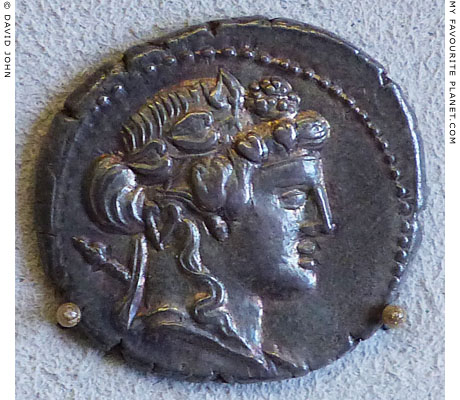
The head of Dionysus/Bacchus/Liber on a silver denarius of
the Roman Republic, issued by Lucius Cassius Longinus, 78 BC.
Diameter 19 mm, weight 3.94 grams.
Münzkabinett (Numismatic Collection), State Museums Berlin (SMB).
Bode Museum, Berlin. Inv. No. 18200360.
Acquired from Count Ivan Ivanovich Tolstoy (1858-1916).
|
| The depiction of the god is similar to that on Greek coins, such as those above, and several statues of the Roman period found around the Graeco-Roman world (see examples above). A thyrsos rests on his left shoulder. Around the head is a circular border of dots. On the reverse side is the head of Libera (Persephone/Proserpine, see Demeter and Persephone part 1), in profile facing left, wearing a wreath of vine leaves and grapes, and the inscription of the moneyer L. CASSI Q F. |
|
| |
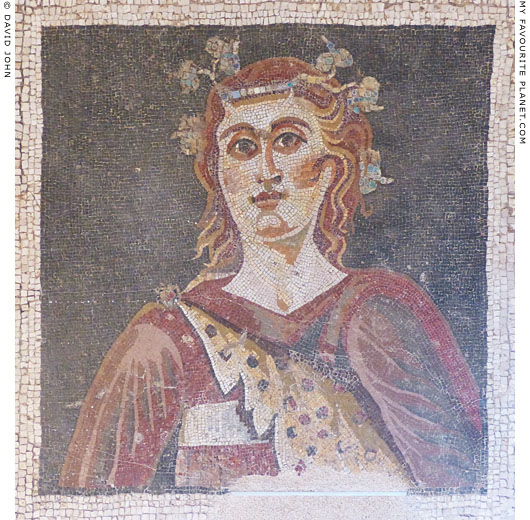
A small mosaic emblema (panel) with a bust of Dionysus wearing
a diadem with ivy leaves, a nebris (leopard skin) and a red cloak
over a red chiton with a white band across the chest.
1st - 2nd century AD. Part of a large floor mosaic found in
the Via Ardeatina, near the church of Sant' Palombo, Rome.
The large central panel of the mosaic depicts the head of Medusa.
Baths of Diocletian, National Museum of Rome. |
| |
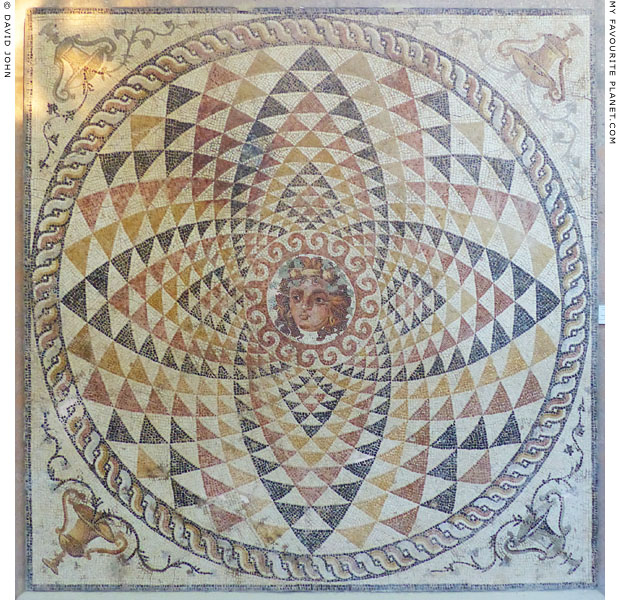
The central panel of a tessellated mosaic floor with the head
of Dionysus wearing fruit and ivy leaves in his hair. In each
corner of the panel is a kantharos (wine cup) with ivy branches.
From a Roman villa in ancient Corinth. 2nd - 3rd century AD. 210 x 210 cm;
diameter of central circle containing the head of Dionysus 33 cm.
Corinth Archaeological Museum. Inv. No. A609 / Mos 25-3. |
| |
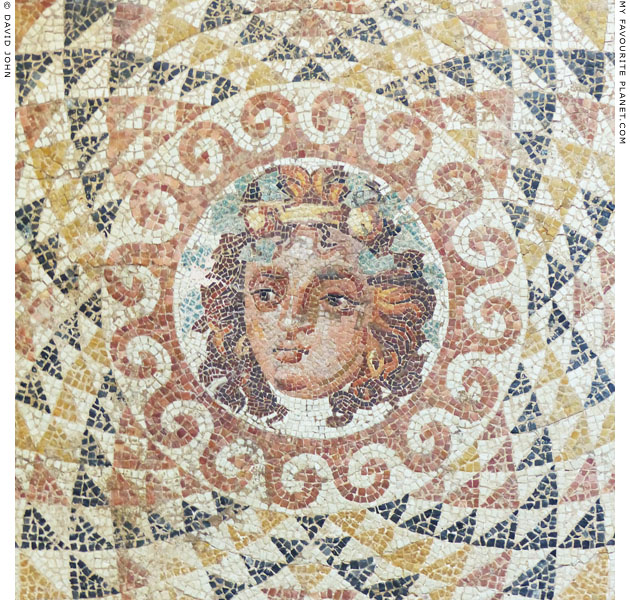
The head of Dionysus in the centre of the mosaic in Corinth. |
| |
| Dionysus |
Infant Dionysus |
|
 |
|
See also:
A mosaic of the infant Dionysus riding a tiger below
Hermes with the infant Dionysus on the Hermes page |
| |
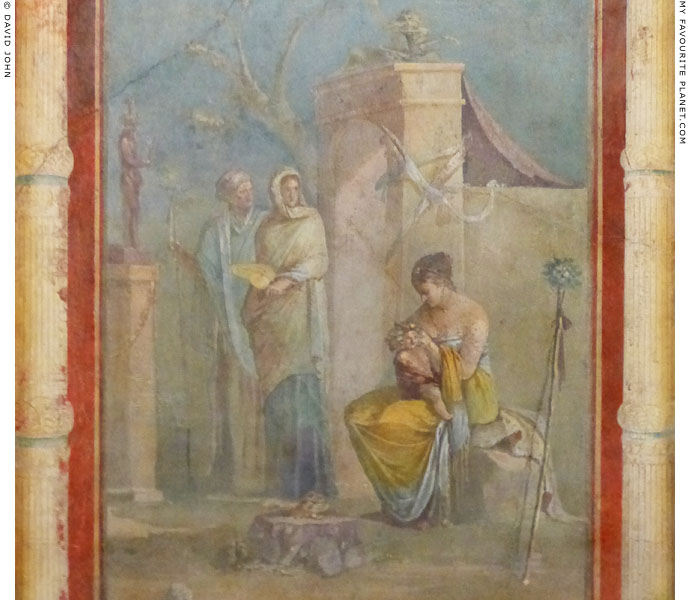
Fresco of the infant Dionysus with the Nymphs of Mount Nysa.
A panel from a large wall painting in Bedroom B (Cubiculum B) of an ancient private
house discovered in 1879 in the grounds of the Villa Farnesina, Trastevere, Rome.
Painted around 30-20 BC, during the reign of Emperor Augustus.
Palazzo Massimo alle Terme, National Museum of Rome. |
| |
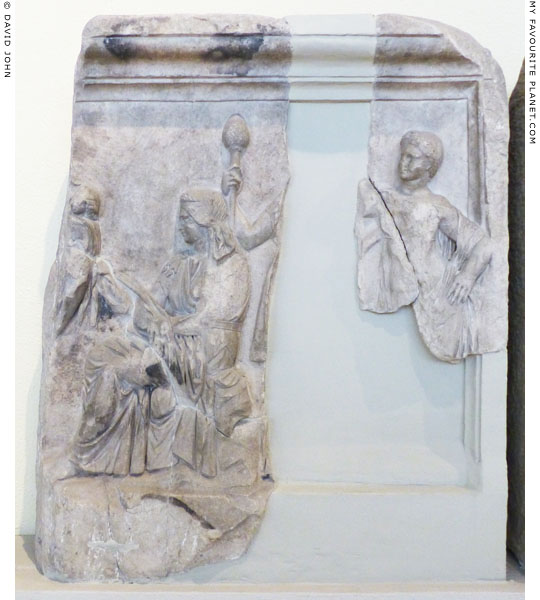
Two fragments of a marble Neo-Attic relief depicting
the infant Dionysus with the Nymphs of Mount Nysa.
The seated figure on the left, holding the infant (see detail below), is thought to
be the personification of Nysa, a mythical place variously located in somewhere
in Greece, Thrace, Phoenicia, Arabia, Ethiopia, Libya or India, where Dionysus
was said to have been raised by the Hyades, the rain Nymphs who lived on the
mountain. To the right, behind her stand two Nymphs, one holding a thyrsos.
Made in an Attic workshop, mid 2nd century AD. Found in a wrecked ship
in Piraeus harbour with the relief of Dionysus and a priestess above.
Piraeus Archaeological Museum. Inv. Nos. 2039 and 2040. |
| |

Detail of the relief of the infant Dionysus on Mount Nysa above. The figure of
the infant is badly damaged, but appears stiff and more like an idol or herm
than a child, especially when compared with the realistic depiction of Nysa. |
| |
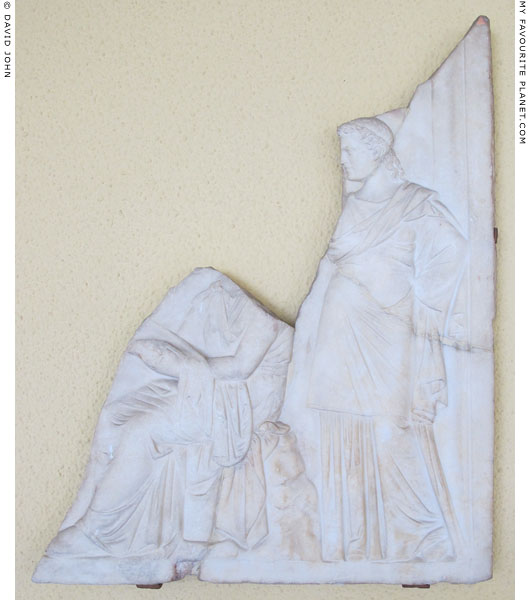
Restored fragments of a marble relief depicting the
infant Dionysus with the Nymphs of Mount Nysa.
Roman period. From Ephesus.
Izmir Archaeological Museum. |
| |
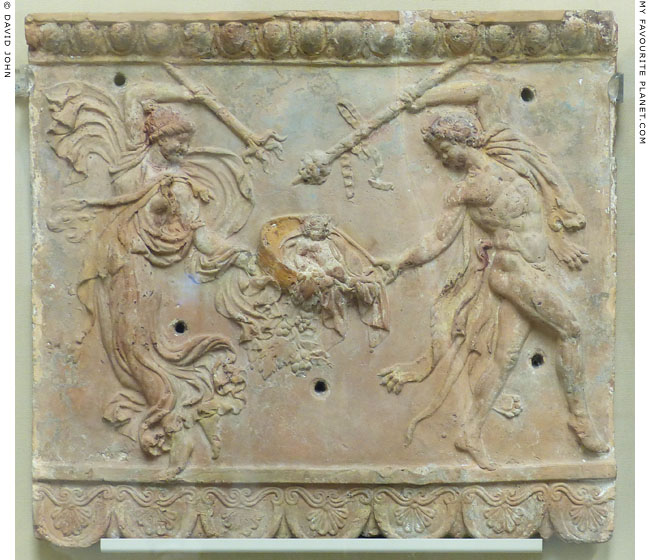
A terracotta relief of a dancing Maenad and Satyr with
the infant Bacchus (Dionysus) in the liknon-cradle.
A Campana plaque. Roman, made in Italy around 20 BC - 50 AD.
Height 45 cm, width 49.5 cm.
The Maenad holds a torch and the Satyr a thyrsos. They carry (or swing) a liknon,
a winnowing basket (see Demeter and Persephone), in which the infant Bacchus lies.
British Museum. GR 1805.7-3.21 (Terracotta D 525).
Purchased in 1805 from the Townley collection.
See other Campana plaques in the British Museum with Dionysian themes below:
Bacchus (Dionysus) and a Satyr an "Ikarios relief" |
| |

Fragmentary marble statue of an actor in the costume
of Papposilenos holding the infant Dionysus.
2nd - 1st century BC. Found in the area of the
Inopos Quarter, east of the theatre of Delos.
Delos Archaeological Museum. Inv. Nos. A 4143 + A 7367. |
| |
Silenos (Σειληνός, Seilenos; Latin, Silenus), was the oldest of the Silens, the tutor of Dionysus, in whose cult Greek theatre developed, and led the thiasos. He is also referred to as Papposilenos (Παπποσειληνός, Father Silenos), particularly in the context of the theatre. Depictions of the old Silen holding the infant Dionysus are variants on those of Hermes with the infant Dionysus. This statue is thought to depict a Papposilenos actor rather than the old Silen himself.
Pausanias noticed a stone near the Propylaia of the Athens Acropolis, on which according to legend, Silenos rested when he came with Dionysus to Attica. As confused as most of us about the origin of Silens and Satyrs [see note 4], the travel writer made some enquiries into the subject:
"There is also a smallish stone, just large enough to serve as a seat to a little man. On it legend says Silenus rested when Dionysus came to the land. The oldest of the Satyrs they call Sileni.
Wishing to know better than most people who the Satyrs are I have inquired from many about this very point. Euphemus the Carian said that on a voyage to Italy he was driven out of his course by winds and was carried into the outer sea, beyond the course of seamen.
He affirmed that there were many uninhabited islands, while in others lived wild men. The sailors did not wish to put in at the latter, because, having put in before, they had some experience of the inhabitants, but on this occasion they had no choice in the matter.
The islands were called Satyrides by the sailors, and the inhabitants were red haired, and had upon their flanks tails not much smaller than those of horses. As soon as they caught sight of their visitors, they ran down to the ship without uttering a cry and assaulted the women in the ship. At last the sailors in fear cast a foreign woman on to the island. Her the Satyrs outraged not only in the usual way, but also in a most shocking manner."
Pausanias, Description of Greece, Book 1, chapter 23, sections 5-6. At Perseus Digital Library.
Other depictions of Silenos holding the infant Dionysus include:
The tondo of a red-figure kylix. Pergamon Museum, Berlin.
A terracotta figurine from Tanagra, around 350-300 BC. Louvre. Inv. No. CA 463. Height 13 cm.
A marble statue found in 1832 in the Theatre of Dionysos, Athens, late 2nd century BC. National Archaeological Museum, Athens. Inv. No. 257. Parian marble. Height 113 cm.
A fresco from Pompeii, circa 1st century AD, showing Silenos, Hermes, the infant Dionysus and Nysiad Nymphs. National Archaeological Museum, Naples.
A marble monopodium from Pompeii, with a relief of Silenos and the infant Dionysus. Antiquarium of Pompeii.
A marble statue from Rome, Roman period. Glyptothek, Munich. Inv. No. GL 238. Height 187 cm.
A marble statuette, 1st - 2nd century AD. Hermitage, Saint Petersburg. Height 61 cm.
A marble statue, 1st - 2nd century AD. Found in the Horti Sallustiani, Rome, 16th century. Louvre. Inv. No. Ma 922 (MR 346). Height 190 cm.
A marble statue, mid 2nd century AD, perhaps a copy of a Greek original by Lysippos, around 300 BC. Braccio Nuovo, Museo Chiaramonti, Vatican Museums. Inv. No. 2292.
The infant Dionysus was also depicted being carried by Pan (see below), a Satyr, and Zeus:
An Attic black-figure kalpis (κάλπις, type of hydria) showing Zeus handing the infant Dionysus to the Nymphs. Attributed to the Syleus Painter, around 480 BC. From Agrigento, Sicily. Cabinet des Médailles, Paris. Inv. No. 440. Height 38.2 cm, width 43 cm.
See more statues of Papposilenos actors below. |
|
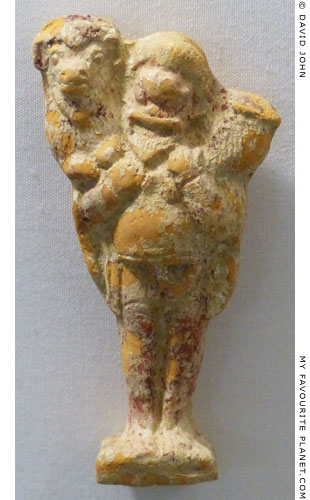
A ceramic figurine of an actor wearing a
mask, identified by the museum labelling
as Papposilenos, carrying a ram on his
shoulders in the manner of
Hermes Kriophoros.
Found in Grave 4 of the necropolis
of Amphipolis, Macedonia.
Amphipolis Archaeological Museum. |
|
| |
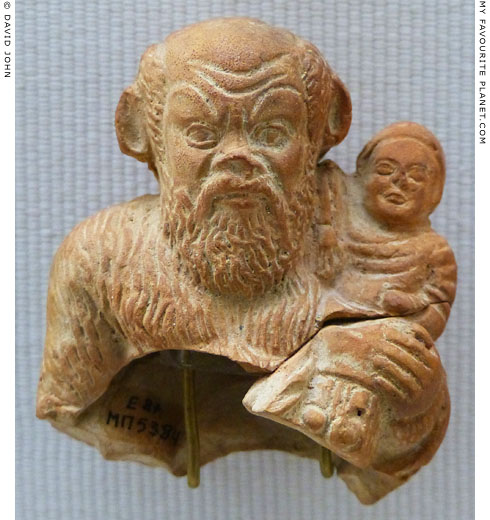
Fragment of a terracotta figurine of Papposilenos
carrying the infant Dionysus on his left shoulder.
4th century BC. From the sanctuary of Artemis
Mounichia (Μουνίχια) in Piraeus, Attica, Greece.
Piraeus Archaeological Museum. |
|
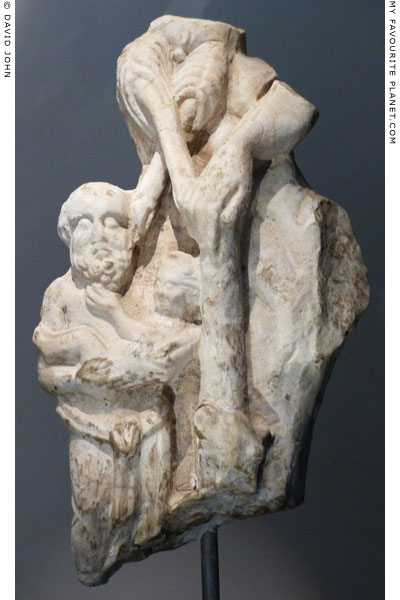
Fragment of a marble statue group with Silenos holding
the infant Dionysus. Above them is the lower part of the
goat-footed god Pan, and to the right the right arm of
a larger figure.
2nd century AD. From Aphytis (Ἀφυτις), Pallene peninsula
(today Cassandra peninsula), Halkidiki, Macedonia (see
map in History of Stageira part 8), where Dionysus was
worshipped as early as the 8th century BC. As well as a
sanctuary of Dionysus there was also a cave dedicated
to Dionysus and the Nymphs.
Thessaloniki Archaeological Museum. |
|
| |
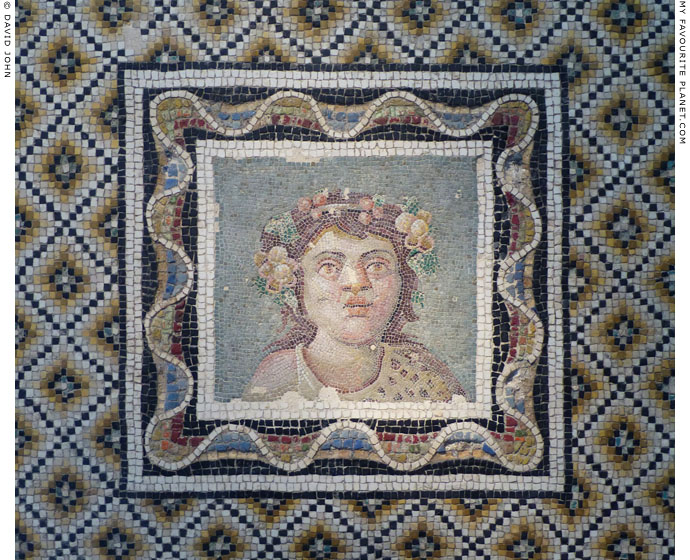
Detail of a mosaic emblema (panel) depicting a bust of Dionysus as a child,
wearing a wreath of grapes, leaves and ivy berries, and a nebris.
3rd century AD. From the Via Flaminia, Rome.
Palazzo Massimo alle Terme, National Museum of Rome. |
| |
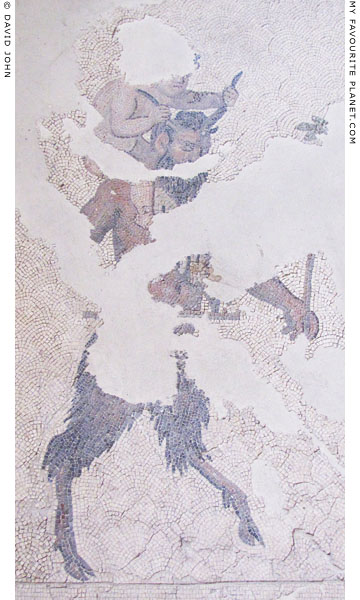
Part of a floor mosaic showing Pan carrying
the infant infant Dionysus on his shoulders.
In situ on the site of a peristyle courtyard of the the Byzantine Great Palace
(Palatium Magnum), of Constantinople. Late 6th or early 7th century AD.
Great Palace Mosaic Museum, Istanbul.
|
| The fragmentary section of the enormous 170-180 square metre floor mosaic is thought to be part of a depiction of Dionysus' triumphal procession from India (see below). Unusually, the infant Dionysus is shown being carried by Pan. He holds on to the horns of the goat-footed god, who carries a lagobolon in his left hand, and perhaps a syrinx in the right. Part of an elephant ridden by a male figure is shown following them. |
|
| |
| Dionysus |
Dionysus with a panther
Dionysus is often depicted with a large cat,
usually referred to as a "panther". |
|
 |
|
| |
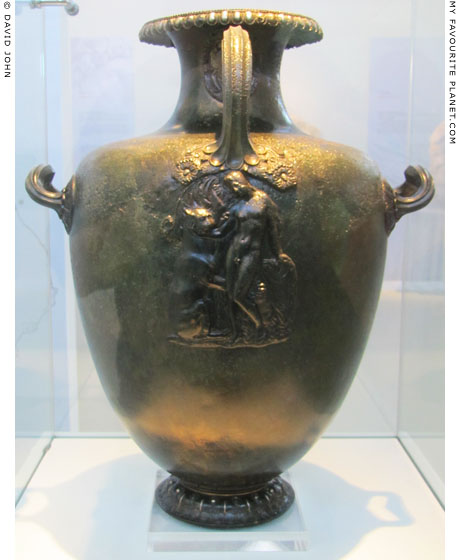
An Attic bronze funerary hydria (ὑδρία, three-handled water-
carrying vessel) with an attached relief of Dionysus and a
panther (see detail below). The vessel had beeen used as a
funerary urn and contained the bones of a 40 year old man.
From Thasos, Greece. Late 5th century BC.
Thasos Archaeological Museum.
See a similar hydria with a relief of Dionysus below. |
| |
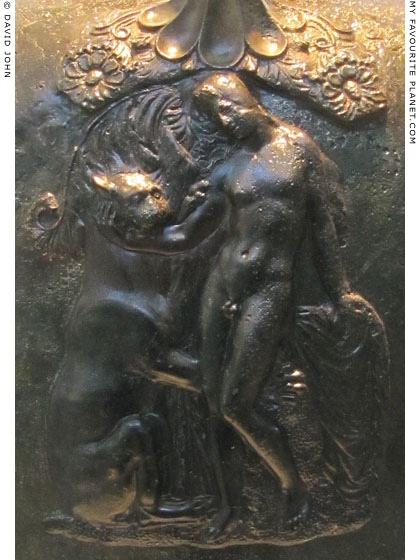
The relief of Dionysus and a panther on the Thasos hydria.
Dionysus tenderly strokes the head of the seated cat which
places its left forepaw on his upper arm. The head of a small
figure (Pan or a Silen?) appears from behind the god's legs. |
| |
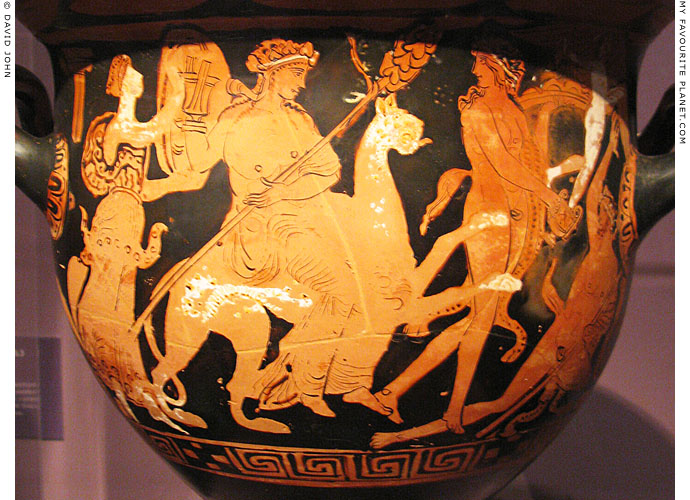
Detail of an Attic red-figure bell krater (wine mixing vessel) depicting Dionysus riding a panther.
Made in Athens, Classical period, 375-350 BC.
In his left hand Dionysus holds his thyrsos staff, and in his right
a kantharos (wine cup). He is accompanied by a dancing Maenad (left)
playing a tympanon, a Silen, a small, white Eros and a Satyr (right).
Pergamon Museum, Berlin. Inv. No. F 2648. |
| |
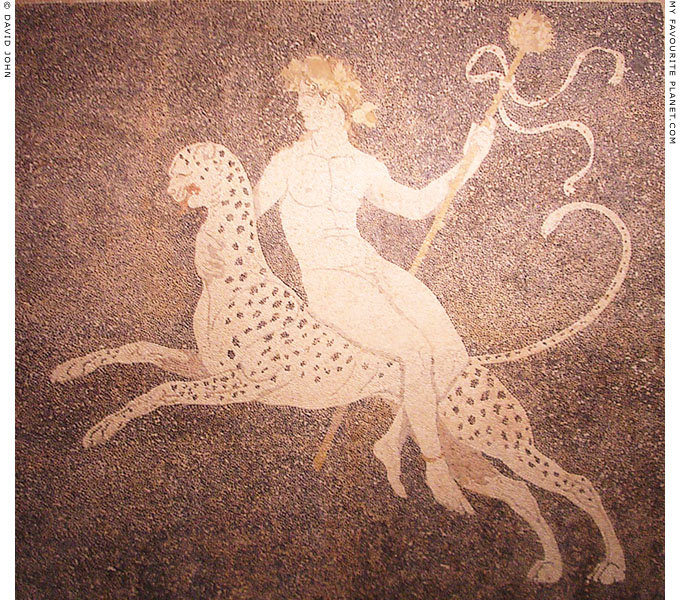
Dionysus riding a panther on a Pebble floor mosaic in Pella, Macedonia.
4th century BC. From the south andron (symposium or banqueting hall
for men) in the "House of Dionysos". 2.72 x 2.69 metres.
The nude young god with an athletic build looks serene as sits side-saddle on a long-limbed leopard
with a small, round head which leaps to the left. On his head, which is turned to the left, the god
wears a wreath of vine leaves. The inset left eye is now missing. He holds onto the cat's throat with
his right hand, and in his left hand he holds a thyrsos decorated by long ribbon.
Pella Archaeological Museum, Macedonia, Greece. |
| |
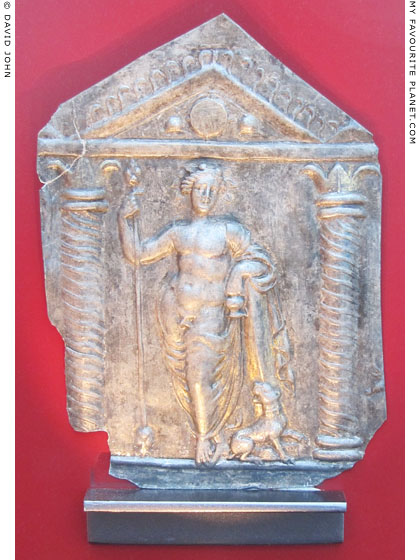
A gilded silver relief made in a Greek workshop,
depicting Dionysus with a panther.
4th century BC. From a Samnite sanctuary in Pietrabbondante,
Isernia province, Molise region, south-central Italy. [see note 8]
|
Pietrabbondante is thought by some historians to be the location of ancient Bovianum, the meeting place of the assemblies of the confederation of the four Samnite tribes, the Caraceni, Caudini, Hirpini and Pentri. The site of the sanctuary, first excavated in the 1840s, includes a theatre and a temple.
Dionysus stands in a naiskos (ναΐσκος, small temple), wearing an ivy wreath and a himation which covers only his left shoulder and legs, leaving his torso naked (see statues of Dionysus in this pose above). He holds his thyrsos in his right hand, and in his left hand he holds a kantharos (wine cup) upside down by its foot. A tympanon flanked by cymbals decorate the pediment of the temple.
See also a gold relief of Dionysus in a naiskos in Athens, below.
See other Dionysian artefacts from Samnium:
above, an ivory plaque with a mask of Dionysus from Sepino (ancient Saepinum)
below, a terracotta antefix depicting a Maenad from Pietrabbondante |
|
| |
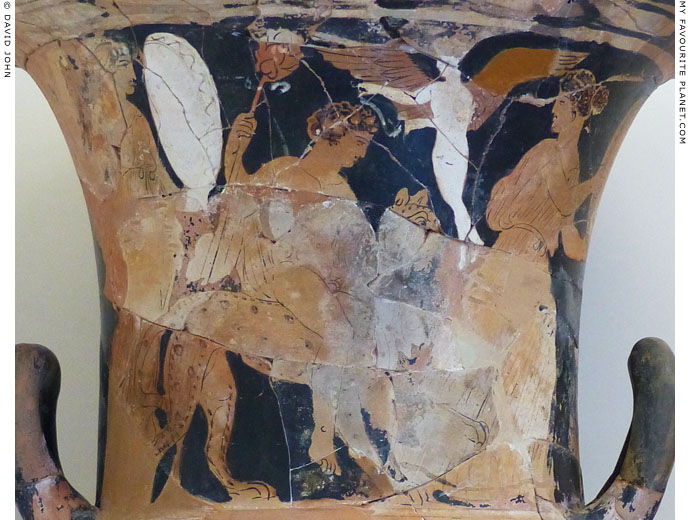
The neck of a red-figure calyx-krater with a depiction of Dionysus, naked
apart from an ivy wreath and a himation (cloak) draped over his arms, holding
a thyrsos and riding a panther. He is flanked by two dancing Maenads, each
playing a tympanon. A winged Eros places a tainia (headband) around his head.
Mid 4th century BC. Found in a cemetery in ancient Phagres, Thrace.
Phagres (Φάγρης) was a hilltop city east of the mouth of the River Strymon, founded
in the mid 7th century BC by the Thracian Pieres tribe, which migrated from the area
of Mount Olympus due to Macedonian expansion. The city was destroyed by Philip II
of Macedon in 346 BC, after which the area became part of Macedonia.
Kavala Archaeological Museum, Macedonia, Greece. |
| |
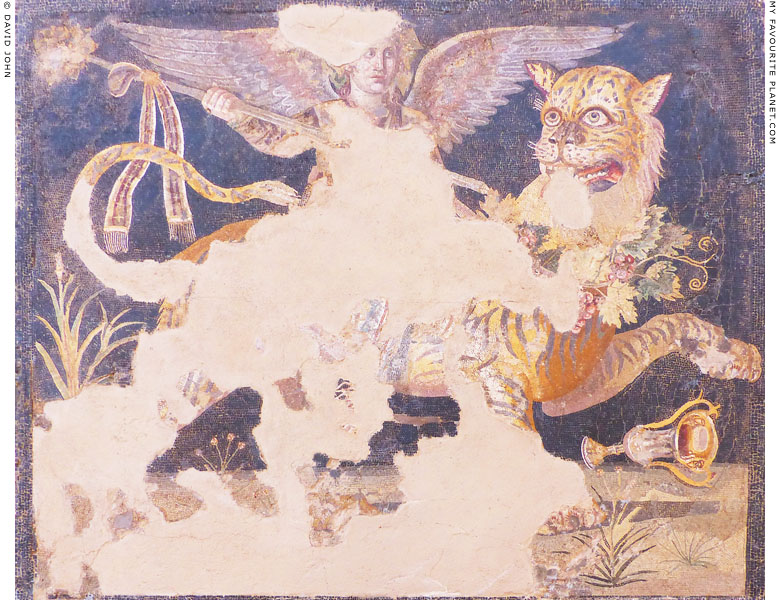
Central emblema (panel) of a floor mosaic depicting Dionysus as a winged daimon riding a tiger.
Around 130-88 BC. From the House of Dionysos, in the
Theatre District, Delos. Height 129 cm, width 157 cm.
Delos Archaeological Museum, Greece.
|
The luxurious private house, near the theatre of Delos, south of the Sanctuary of Apollo, was named "the House of Dionysos" after this mosaic, which was found in the peristyle of the large central courtyard known as "court c". Made using the opus vermiculatum technique (worm-like work), the highly detailed, multi-coloured mosaic emblema was made with tesserae of glass, faience, natural stone and terracotta, most around one millimetre square.
Dionysus is depicted as a young man with a serious expression, gazing to the right (forwards). Unusually, he is shown with outstretched wings, and the depiction has been interpreted as the god as a daimon or spirit. He wears an ivy wreath and holds a ribboned thyrsos in his right hand. The large tiger, wearing a vine with leaves and grapes around its neck, strides towards the right with its head turned back. Below its raised left forepaw a kantharos (wine cup) lies on its side on the sandy-coloured, arid-looking ground, from which a number of small individual plants are growing. The background above the flat ground level is black. |
|

The head of Dionysus of the mosaic
from the House of Dionysos, Delos. |
|
| |
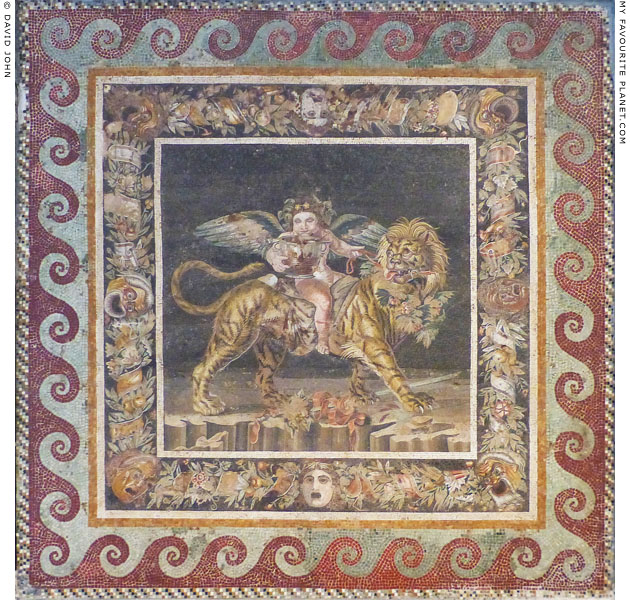
The "Tiger Rider" mosaic, Dionysus as a winged infant riding a tiger (see detail below),
in the central emblema (panel) of a poylchrome floor mosaic from Pompeii.
Late 2nd century BC. Found on 1st December 1830 in Triclinium 34, one of two dining rooms
at the sides of the tablinum of the House of the Faun (Casa del Fauno, Regio VI, Insula 12,
Casa 2), Pompeii. Height 163 cm, width 163 cm. "Tiger Rider" emblema 85 x 85 cm.
National Archaeological Museum, Naples. Inv. No. 9991.
|
The winged boy riding the tiger has also been interpreted as: Eros (or Cupid); a personification or the genius of Autumn; Acratus (Ἄκρατος, also referred to as Acratopotes, Ακρατοποτης, Drinker of Unmixed Wine), a hero or daimon and follower of Dionysus. Naked apart from a wreath of flowers and ivy leaves, he sits on a large cloth (a himation or an animal skin) draped around the tiger's torso. His cheeks are puffed out and he appears drunk. He looks down into a large bowl of wine which he holds in his right hand. With his right hand he steers the tiger with a red rein as it walks to the right, its head turned back to the left. The tiger has a lion-like mane, a protruding tongue and prominent, sharp claws. Its left eye is missing and around its neck is a wreath of vine leaves and grapes. With its left forepaw it treads on a thyrsos lying on the ground at what appears to be the craggy edge of an abyss.
Around this square central emblema is a border with poylchrome representations of eight comic and tragic theatre masks at each corner and the centre of each side, between which run garlands of scrolls, fruits and foliage. Around a further outer frame is a continuous frieze of spiral waves in red and white, with nine waves along each side.
Like the "Alexander Mosaic", also from the House of the Faun, and the mosaics of Dioskourides of Samos from Herculaneum, the central emblema and inner frame are exceptionally well executed, made of small, tightly-fitted tesserae, have dynamic compositions and are finely detailed with painterly qualities. The image of the central emblema may appear odd to modern eyes, and the mane and distorted anatomical proportions of the tiger are perhaps due to the artist's unfamiliarity with the exotic beast. It is not clear if the tiger's missing left eye is the work of the artist, or a result of damage to the mosaic. The eye socket is filled in with shaded tesserae, which may be restoration, but the area below is swollen and wrinkled, and there is what appears to be a horizontal scar along the outer side. The general appearance of the tiger is that of an older animal which has perhaps survived several battles.
The author of a guide to the Naples museum expressed what many of us may feel when seeing such a fine work of art made "merely" to decorate a floor:
"One can hardly believe that this beautiful work of art was made to be walked upon, and formed part of a pavement."
Domeniconi Monaco, A complete handbook to the National Museum in Naples, page 22. English editor Eustace Neville Rolfe. Fifth edition. Naples, 1888. At the internet Archive. |
|
| |
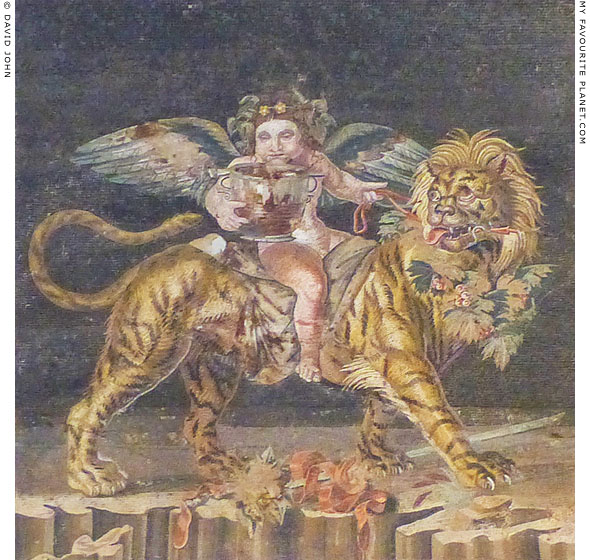
The central emblema (panel) of the floor mosaic from the House of the Faun, Pompeii. |
| |
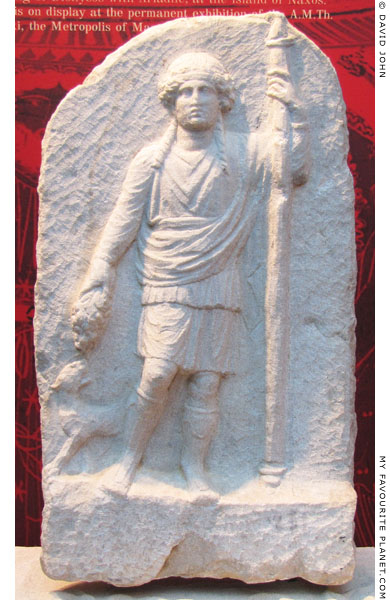
A marble votive relief depicting Dionysus with a panther.
Roman period, late 1st century AD. Provenance unknown.
Dionysus holds a long torch in his left hand, and in his
lowered right hand a bunch of grapes which attracts
the attention of a small panther.
Thessaloniki Archaeological Museum. |
| |

Marble Neo-Attic relief showing Dionysus seated. 1st century AD.
The god is naked apart from a himation (cloak) covering his left shoulder and thighs.
On his head is a wreath of vine leaves, and he wears high-strapped sandals. In his
left arm he holds his thyrsos staff, with his extended right hand he holds a kantharos
(wine cup) into which the hand of a figure (now missing) pours wine from a jug.
A panther lies beneath his chair, the legs of which have the form of panther paws.
National Archaeological Museum, Naples. Inv. No. 6728. Farnese Collection. |
| |
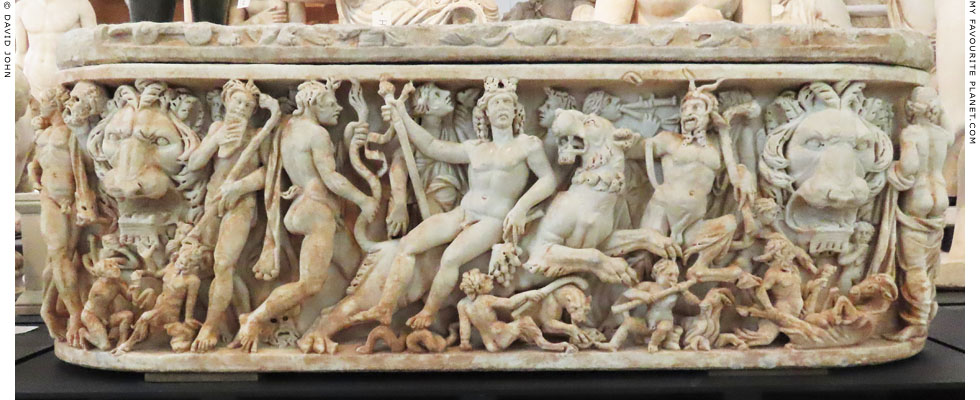
A relief of Dionysus riding a panther on the front of a marble sarcophagus (a stone coffin;
from the Greek, σαρκοφάγος, flesh-eater) depicting a Triumph of Dionysus (see below).
The god, holding a thyrsos in his right hand and a vine branch in the left, is surrounded by
his thiasos, including Pan (right), Satyrs and Silens, dancing and playing musical instruments.
Pan and two other figures each hold a lagobolon (λᾰγωβόλον; Latin, pedum), a short hunting
stick, curved like a walking stick at one end, used for throwing at hares. Among the scenes
enacted by the smaller scale figures cavorting in the foreground, a bearded Silen copulates
with a female goat which is lying on its back (bottom right). This scene is also known from
a marble statue group of Pan copulating with a goat, found in Herculaneum and now in
Naples (see the Pan page). At each end of the relief is a protome (head) of a lion, depicted
facing frontally with its mouth open, and at a much larger scale than the figures.
Circa 210 AD. Anatolian marble. Height 63 cm, width 173 cm, depth 64 cm [15].
Skulpturensammlung, Albertinum, Dresden. Inv. No. Hm 271.
Acquired in 1728 from the Albani Collection.
See another sarcophagus relief of a Dionysian procession in Dresden below. |
| |

An inscribed marble stele with a low relief depicting Herakles (left),
Dionysus with a panther, Pan and a Silen.
Roman period, late 2nd - early 3rd century AD. From Marcianopolis
(Μαρκιανούπολις, today Devnya), Thrace, 25 km west of Varna
(ancient Odessos, Οδησσός), Bulgaria.
The inscription below the relief is an epigram dedicated to Herakles:
τῷ Διὸς Ἡρακλῆι πατρὴ κτίστῃ δὲ Περίνθου
Ἰουλιανὸς Περσηϊάδηι τἄγαλμ’ ἀν-
έθηκα.
Inscription IGBulg V 5128 (also SEG 28 602 and SEG 35 842).
Varna Archaeological Museum, Bulgaria.
On the left Herkales stands, facing frontally, wearing (barely) the skin of the Nemean Lion. A paw and leg of the lion hangs down in front of his left forearm, and the rest of the pelt falls from behind the arm and around his thighs, with the head on the outside of his right thigh. He holds a wine cup in his left hand, and in his right hand his club which rests on the head of a bull. Dionysus stands on the right, wearing a wreath of ivy berries and a nebris, fastened at the left shoulder and covering only part of his torso. In his left hand he holds his thyrsos, and his right arm rests on Herakles' right shoulder. Behind their heads three bunches of grapes with leaves hang from a vine extending across the width of the recessed relief area.
Both Herakles and Dionysus were said to be sons of Zeus, each by a mortal woman, and were thus half-brothers. Here they enjoy together a moment of close fraternal friendship and rest. Their poses and clothing suggest abandonment and intoxication - they both appear quite drunk - and look as though they are having their snapshot taken at a party.
A small panther sits between them, its body facing left, the head turned back to the left. On the right Pan sits on a rock above a Silen (perhaps Silenos) who carries on his head a bowl containing four round fruits. These two figures are depicted at a much smaller scale than Herakles and Dionysus.
Marcianopolis (Μαρκιανούπολις) was founded by Emperor Trajan at the end of the Second Dacian War (105-106 AD), and named after his sister Ulpia Marciana (48-112 AD). The city became the capital of the Roman province Moesia Inferior (Lower Moesia), west of the Black Sea. However, the inscription refers to Herakles, son of Zeus (Διὸς, Dios), as the father and founder (κτίστη, ktisti) of Perinthos (Περίνθος, today Marmara Ereğlisi, northwestern Turkey), a Greek city on the northwestern coast of the Sea of Marmara. The relief was dedicated by "Ioulianos Perseiadei". The second name is usually taken to refer to the Perseiades (Περσηϊάδης), the descendants of the mythical hero Perseus (Περσεύς, see Medusa), although it has been suggested that here it refers to an epithet of Dionysus. |
|
| |
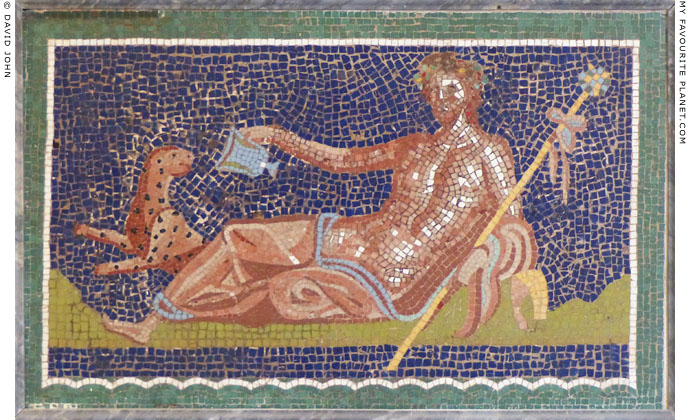
Mosaic panel depicting Dionysus with his panther.
Found on 9th December 1740 in the nymphaeum of the House of the Skeleton
(Casa dello Scheletro, Insula III, Casa 3), Herculaneum (see below).
National Archaeological Museum, Naples. Inv. No. 9989.
|
| This mosaic is not very detailed or particularly well made, and seems like a cheap decorative piece, perhaps a copy of a finer work. The youthful god reclines on what may be a kline (couch), although the indistinct green form on which he lies may be representation of a landscape. He is naked apart from the reddish-brown himation (cloak) with a bright blue border which is draped over his left forearm and legs. His right foot protrudes from the bottom of the garment. The white highlights on his face, torso and left arm, indicate he is sitting in strong sun or moon light, or that he has been well oiled. He faces forward and wears a wreath indicated by a few blue-green tesserae. Resting on his left side and elbow, he holds a thyrsos in his left hand, and with his outsretched right hand he holds a kantharos (wine cup) with its mouth to the side. Either the vessel is empty and he is calling for more wine, or he is pouring wine for the panther behind his right leg, which leaps to the right, its head turned back to the right to inspect the cup. |
|
| |
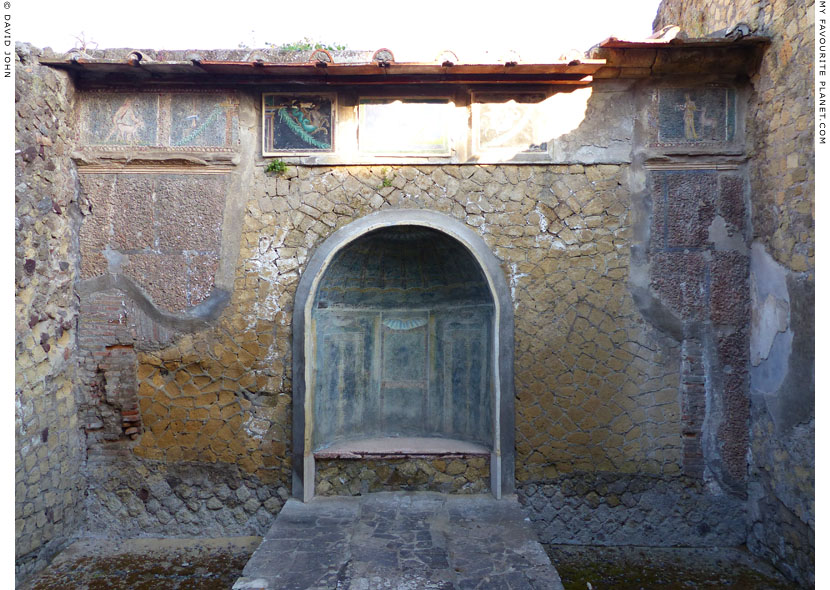
The east wall of the nymphaeum in the House of the Skeleton, Herculaneum,
where the Dionysus mosaic above was discovered.
|
The House of the Skeleton (Casa dello Scheletro) is on the west side of Insula III, a block of buildings at the southwest of the excavated area of Herculaneum which forms the modern archaeological site. It was named after a skeleton found in a room on the upper floor during the excavations of 1830-1831. These were the first human remains found buried beneath several metres of volcanic ash and stone at Herculaneum. Previously it was thought that the all inhabitants of the ancient town had escaped the eruption of Vesuvius in 79 AD, but later further remains of vicitms were discovered.
Part of the house had already been tunelled through in 1740-1741, when the nymphaeum, described by the excavators as a grotto, was discovered. In the centre of the east wall of the room was an arched, semi-circular niche in the form of a nymphaeum (fountain), entirely decorated with a mosaic. A raised stone walkway across the centre of the room is flanked by two lower areas which were presumably filled with water. Above the niche, stretching the entire length of the wall, was a frieze of mosaic panels, framed by rows of seashells set into the stucco of the wall. Originally there were seven panels, but only six have survived.
The Dionysus panel was in the centre of the frieze, flanked by two panels each depicting a Triton carrying a tray of offerings, with his tail resting on a diagonally hanging garland, one end of which appears to be attached to a corner of a building. The Tritons are mirror images, so that each figure faces Dionysus. The nymphaeum mosaic (Inv. No. 10008, see photo below), Dionysus and the two Tritons (Inv. Nos. 10009 and 10011) have been replaced by replicas; the originals are in the National Archaeological Museum, Naples.
Three of the original mosaic panels, all with Dionysian motifs, are still in situ (see photos, right). At the left (north) end of the frieze a wreathed male figure (a Satyr or shepherd) walks to the right (towards the central Dionysus panel) pushing a sacrificial goat. The panel to the right depicts a horn, probably a rhyton (drinking horn) hanging from a ribbon, above a garland hanging from a corner of a building. At the right (south) end a wreathed female figue, probably a Maenad, wearing a long yellow gown, stands holding a fawn with her left hand, and in her right hand an object (a tray with offerings?) from which hang two ribbons. The panel to the left of this is missing. |
| |

The large mosaic from the niche in the nymphaeum
of the House of the Skeleton, Herculaneum.
National Archaeological Museum, Naples. Inv. No. 10008.
The two Triton mosaics from the nymphaeum (Inv. Nos. 10009 and 10011)
are displayed in the museum either side of the niche, and the mosaic of
Dionysus with a panther (above) is on an adjacent wall to the right. |
|
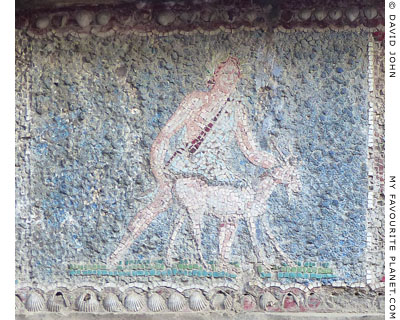
The far left (north) mosaic panel on the frieze in the
nymphaeum of the House of the Skeleton, Herculaneum,
depicting a male figure bringing a goat to sacrifice. |
| |

A mosaic panel depicting a rhyton (drinking horn)
above a garland on the frieze in the nymphaeum
of the House of the Skeleton, Herculaneum. |
| |
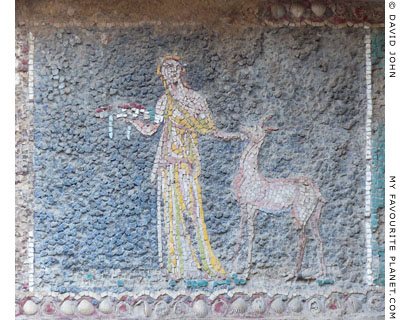
The far right (south) mosaic panel on the frieze in the
nymphaeum of the House of the Skeleton, Herculaneum,
depicting a female figure with a fawn. |
| |
| |
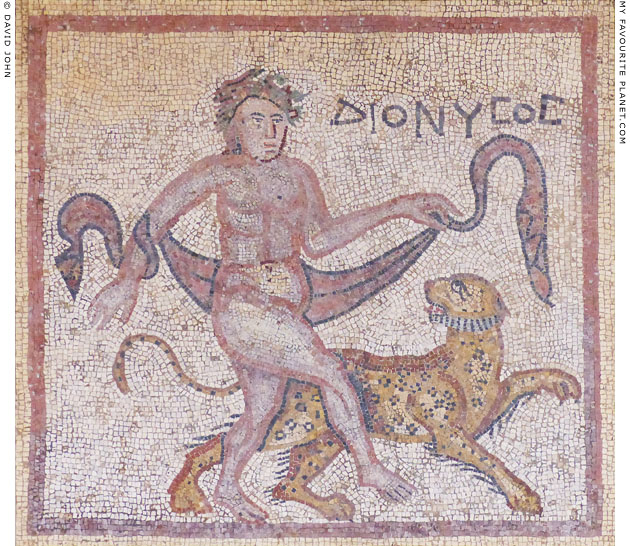
Dionysus dancing with his panther. Inscribed panel from a mosaic floor.
4th century AD. One of a number of mosaic panels excavated in 1856
by Sir Charles Thomas Newton in a villa in Halicarnassus, Caria (Yazıköy,
Muğla Province, Turkey). [16]. Height 140 cm, width 136 cm.
Dionysus, naked apart from a grey-green wreath, carries a long strip
of red cloth with a thick black contour, and dances to the right. The
name ΔΙΟΝΥϹΟϹ (Dionysos) is inscribed in Greek to the right of his
head. The panther runs at his left side, looking back and up at him.
British Museum. GR 1857.12-20.414 (Mosaics 54c). |
| |
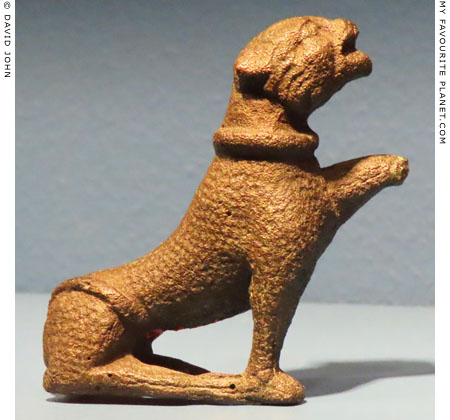
A bronze figure of a seated panther, looking up, with its
head and left foreleg raised. The left forepaw is now missing.
The lower rear legs are disproportionately long.
Hellenistic period.
Allard Pierson Museum, Amsterdam.
Displayed unlabelled in the museum's "Hellenistic Cabinet". |
| |
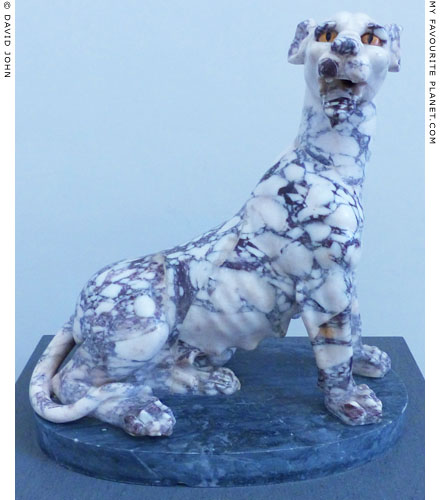 |
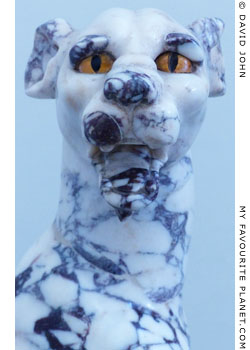 |
Statue of a sitting female panther.
Roman Imperial period. Pavonazetto marble, with inlaid eyes of yellow stone.
National Archaeological Museum, Naples. Inv. No. 6223. Farnese Collection. |
|
| |

Statue of a lying female panther.
Roman Imperial period. Black granite.
National Archaeological Museum, Naples. Inv. No. 6225. Farnese Collection. |
| |
| Dionysus |
Dionysus with women
Dionysus is often depicted with female figures,
such as his mother Semele or his consort Ariadne.
See also Dionysus and Ariadne on Naxos below. |
|
 |
|
| |
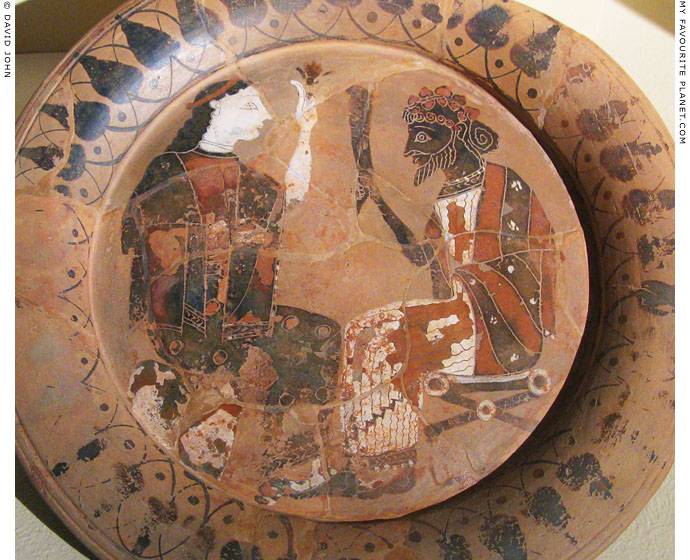
Dionysus and a female figure sitting together.
Detail of an Attic black-figure ceramic plate, made in Athens
around 575-525 BC. Found at Marathon, Attica. Diameter 19 cm.
Dionysus, holding a rhyton (drinking horn), sits on a folding stool opposite
a woman holding a flower, who sits on a block or rocks. She may be his
mother Semele, Ariadne or one of the god's other consorts.
Antikensammlung SMB, Berlin. Inv. No. F 1809. |
| |
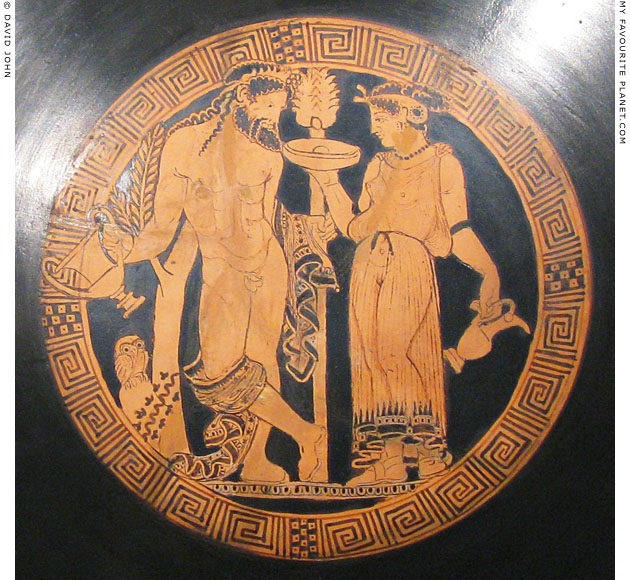
Tondo of an Etruscan red-figure kylix (drinking cup)
showing Dionysus/Fufluns with a female figure.
330-300 BC. From Chuisi (Italy). Height 11 cm, diameter 24 cm.
Antikensammlung, Staatliche Museen zu Berlin (SMB). Inv. No. F 2943.
|
A bearded Fufluns stands naked apart from a cloak carelessly draped around his left forearm and wound around his right knee, holding a kantharos (drinking tankard) in his right hand and his thyrsos in the left hand. He looks downwards to his left, and appears to be gazing into a patera (libation bowl) held by a female figure (who has been referred to as an "attendant" or Maenad) in her right hand; in her left hand she holds a jug. She wears a long, transparent chiton. It has been suggested that they are practising lekanomanteia, the reading of a prophecy in a liquid. [17]
Behind the god is a tree at the foot of which an owl is perched on a stump of a branch or a rock decorated with a schematic ivy branch.
It is thought that the Etruscan city Populonia (its name in Latin), the original name of which was probably pronounced Fufluna, was named after Fufluns. |
|
| |
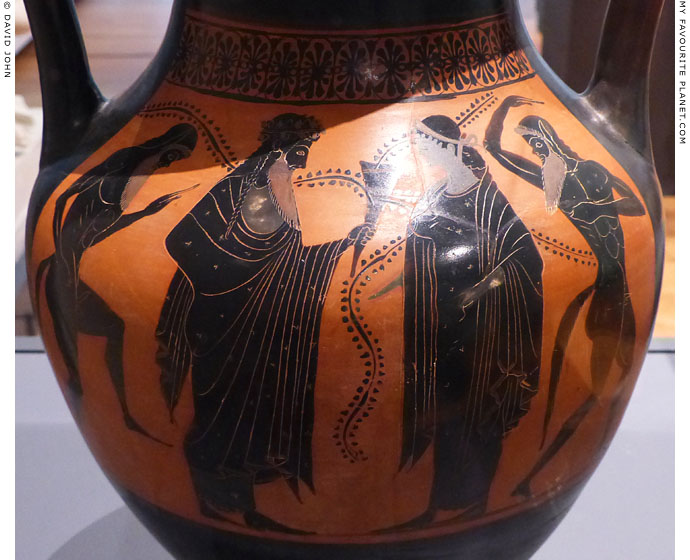
Dionysus and Ariadne flanked by two dancing Satyrs.
Detail of an Archaic Attic black-figure amphora, made in Athens
around 520-510 BC. Attributed to the Rycroft Painter.
The other side of the amphora shows a warrior on a four-horse
chariot (quadriga) bidding farewell to family members.
Ashmolean Museum, Oxford. Inv. No. AN.1911.256.
See also a Roman relief of Dionysus and Ariadne below. |
| |
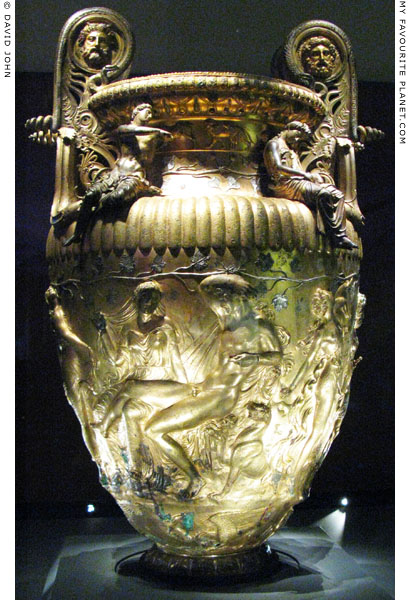
Relief of Dionysus, Ariadne and a panther on the Derveni Krater.
See detail below.
Thessaloniki Archaeological Museum. |
| |
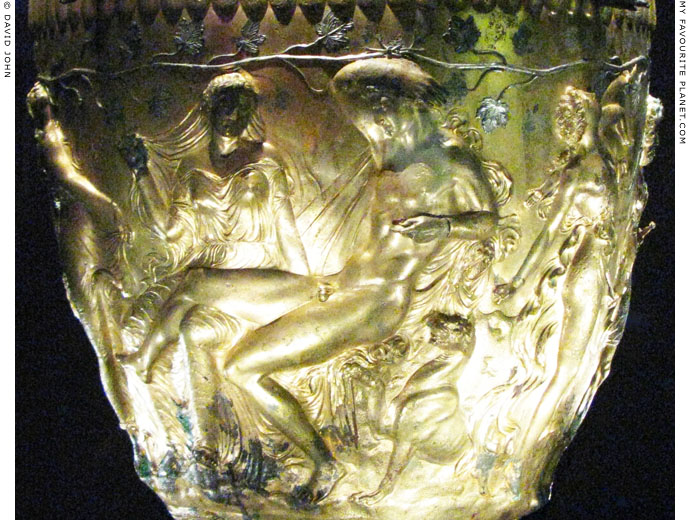
Detail of the relief of Ariadne, Dionysus and a panther
on the Derveni Krater (side A), 4th century BC.
Thessaloniki Archaeological Museum. Inv. No. B1.
|
The scene is thought to represent the marriage of Dionysus and Ariadne on Naxos (see below and Selcuk gallery 2, page 2). Dionysus lounges drunkenly, with his right forearm on top of his head and his right leg resting on the left thigh of Ariadne, who sits to his left. A small panther sits right of him, rather like a domestic pet. Two grapevines stretch horizontally, from left and right, meeting above Dionysus' head. Maenads dance to left and right, and two more sleep on the shoulder of the vessel.
The Derveni Krater is a volute krater (wine mixing bowl), made of an alloy of bronze and tin, elaborately decorated with several figures including Dionysus, Ariadne and Maenads. Dated to the 4th century BC, it was probably made in Athens.
Height 90.5 cm, weight 40 kg.
It was discovered in 1962, carefully buried in a tomb at Derveni, the site of the ancient Mygdonian city of Lete (Λητή), near Thessaloniki, Macedonia, Greece. [18] It had been used as a funerary urn for a Thessalian aristocrat and contained the burnt bones of a man aged 35-50 and a younger woman. An inscription in the Thessalian variant of the Aeolian dialect, engraved on the base of the krater, names the man as Astiouneios, son of Anaxagoras, from Larissa:
Ἀστιούνειος Ἀναξαγοραίοι ἐς Λαρίσας |
|
| |
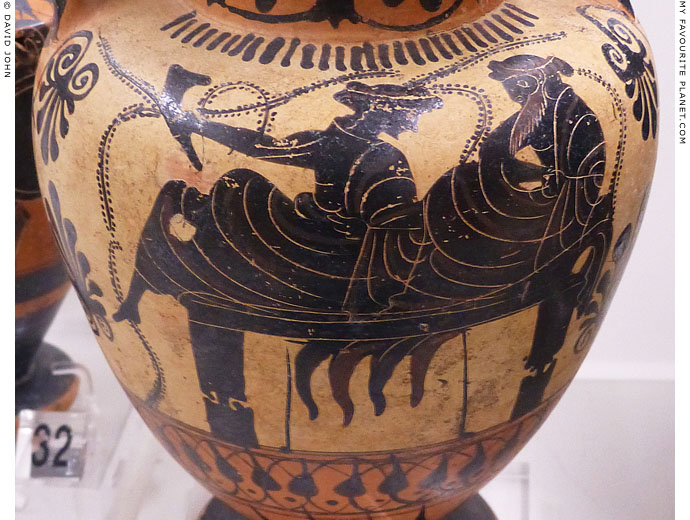
Detail of a small Attic black-figure amphora showing
Dionysus and a female figure on a kline (couch).
Attributed to the Painter of the Red Line, 520-510 BC. Excavated
in 1998 in the Tomb of the Micali Painter, Osteria necropolis, Rome.
National Etruscan Museum, Villa Giulia, Rome. |
| |
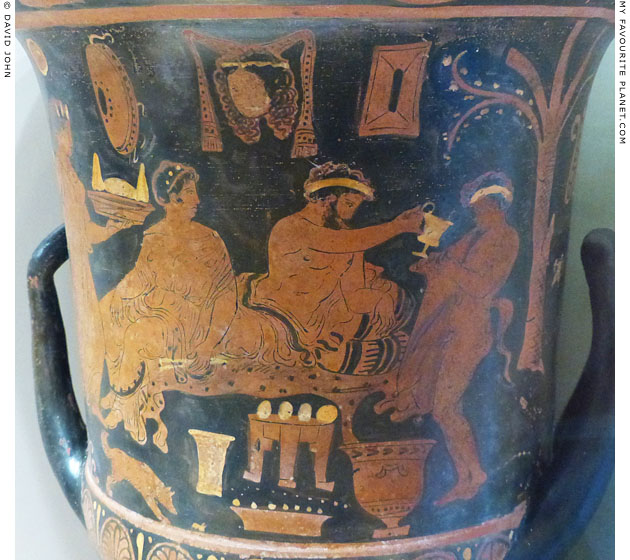
Detail of an Apulian red-figure krater showing Ariadne and Dionysus at a banquet.
370-360 BC.
Greek section, Civic Archaeological Museum, Milan.
Inv. No. A 1997.01.279. From the Lagioia Collection.
|
| Dionysus reclines on a kline (couch) in the form of a panther. He holds out a kantharos (wine cup) to a Satyr, right, who arrives with a wineskin. Ariadne, sitting at the foot of the kline with her head turned towards Dionysus, holds an aulos (double pipes) in her left hand. On the left a handmaiden brings an alabastron (ointment bottle) and a tray with what appear to be white cakes. Above hang a mask flanked by a tympanon (drum) and another object, and in the background, right, ivy grows on a tree. |
|
| |
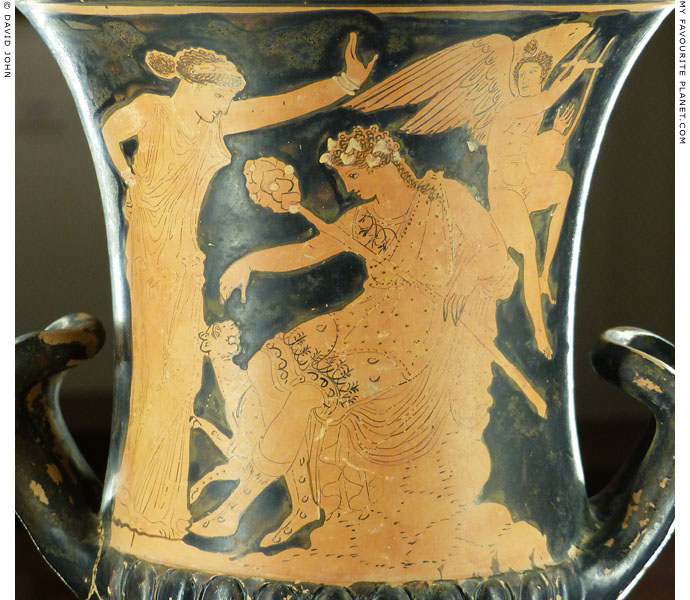
Detail of a red-figure krater showing Dionysus with a panther and Ariadne.
To the right, behind Dionysus, flying Eros plays a lyre.
4th century BC. From Thebes.
The painting on the other side of the krater (Side A) depicts
the apotheosis of Herakles, featuring Athena and Nike.
Thebes Archaeological Museum. |
| |
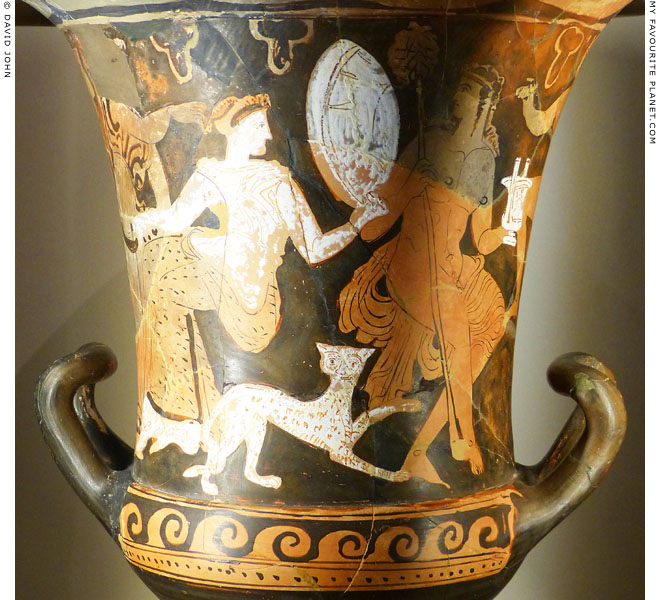
Detail of a red-figure krater showing Ariadne, Dionysus and a panther.
4th century BC. From Thebes.
Thebes Archaeological Museum. |
| |
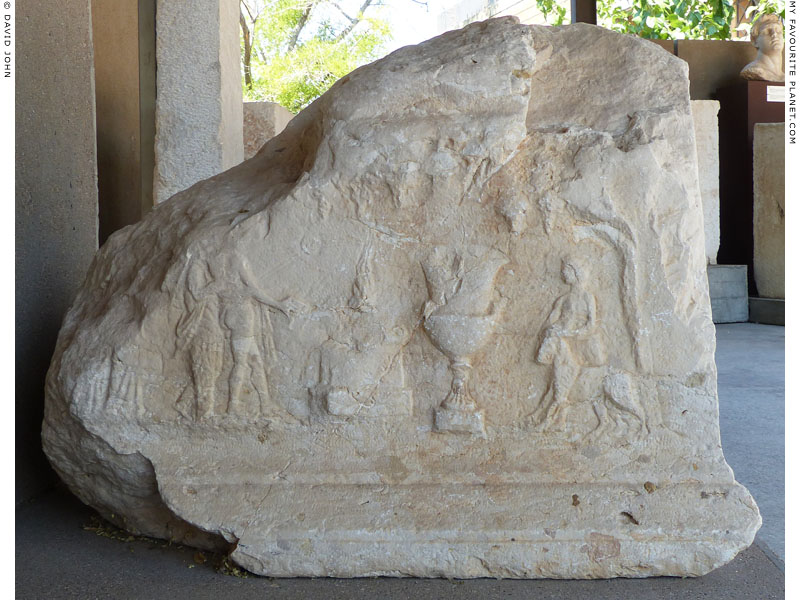
An altar or base with damaged and worn reliefs related to sacrifices on the sides.
On this side Dionysus, holding a kantharos, and Ariadne approach a flaming
altar from the left, followed by two draped female figures. A colossal kantharos
stands to the right of the altar. A youth brings a sacrificial ram from the right.
2nd century BC. From Thespiai (Θεσπιαί), Boeotia, central Greece.
Thebes Archaeological Museum. |
| |
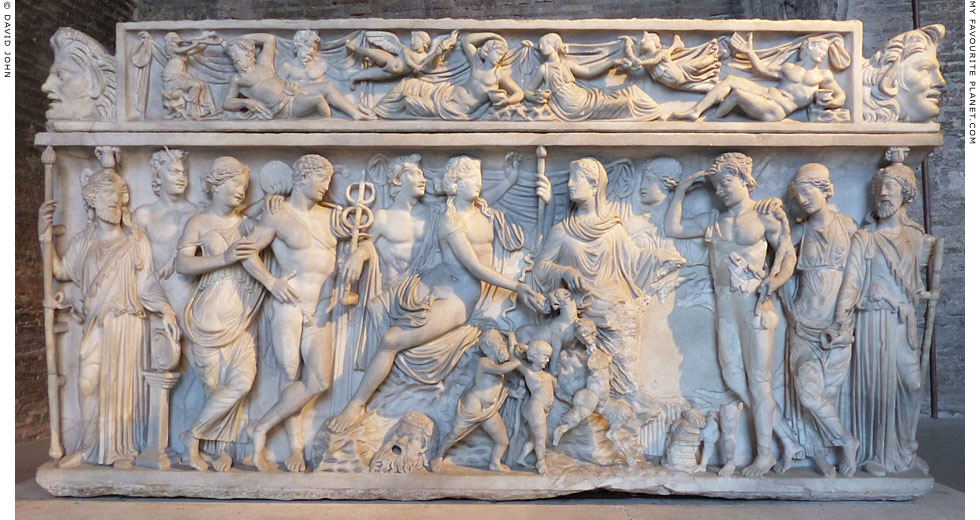
The front of a marble sarcophagus with a relief depicting Dionysus and Ariadne
flanked by the thiasos, including Pan and Hermes. A theatre mask lies on the ground
below Dionysus. The couple are also shown reclining on the lid of the sarcophagus.
1st decade of the 3rd century AD.
Found in the area of the Via Labicana, Rome.
Baths of Diocletian, National Museum of Rome. Inv. No. 124682. |
| |
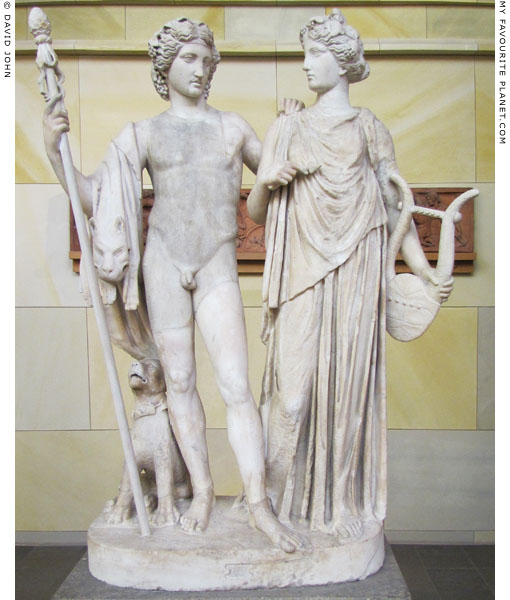
Marble statue of Dionysus and Ariadne with a panther. Roman, 4th century AD.
Restored by German academic sculptor Emil Wolff (1802-1879) [19],
who added new parts and made repairs with plaster. Height 118.2 cm.
Schinkel Museum, Friedrichswerdersche Kirche, Berlin.
Part of the Nationalgalerie of the State Museums Berlin (SMB).
Purchased from Emil Wolff in Rome in 1828. |
| |
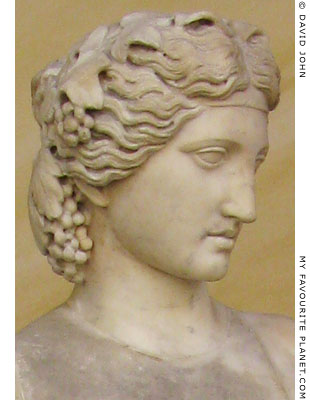 |
|
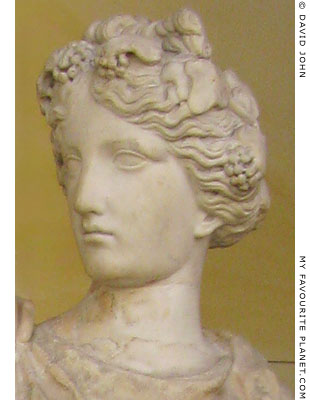 |
| The heads of Dionysus and Ariadne from the statue in the Schinkel Museum, Berlin. |
|
| |
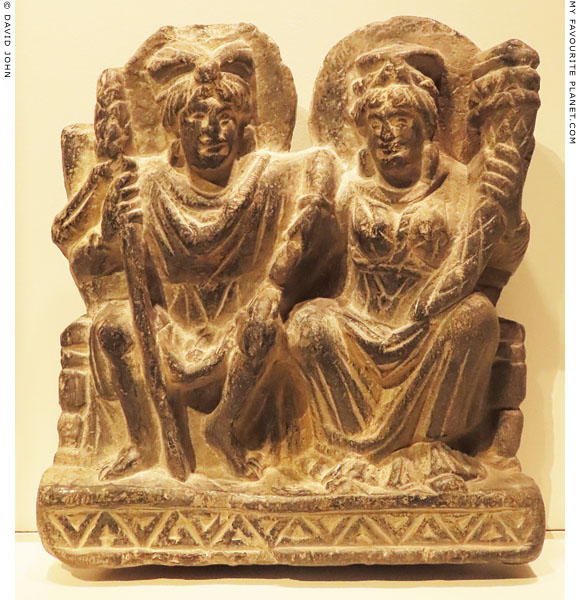
A phyllite (stone) relief of the Buddhist deities Panchika and Hariti,
equivalents of Dionysus and Agathe Tyche.
From Gandhara (Pakistan). Kushana period, 2nd - 3rd century AD.
The enthroned couple, Panchika, the Buddhist god of wealth and his wife Hariti,
a mother goddess, appear to be smiling. Panchika has his left hand on Hariti's
right upper arm, who has her right hand on his left knee. In his right hand
he holds a thyrsos, and she holds a cornucopia in her left hand.
Museum für Asiatische Kunst, Berlin. Inv. No. I.1184.
Currently (2020) in the Allard Pierson Museum, Amsterdam. |
| |
| Dionysus |
Dionysus and Ariadne on Naxos
For further information about Dionysus discovering
Ariadne on Naxos, see Selçuk gallery 2, page 2. |
|
 |
|
| |

Detail of a fresco, in the 3rd Pompeian style, of
Dionysus discovering the sleeping Ariadne on Naxos.
From Venafro (Greek, Οὐέναφρον; Latin, Venafrum),
central Italy, 1st century AD.
Photo from an exhibition dedicated to Dionysus
in Thessaloniki Archaeological Museum, 2012. |
| |

A sarcophagus with a relief depicting Dionysus and sleeping Ariadne on Naxos.
Luni marble. 160-180 AD. From the church of SS. Nero and Achilleo,
Via Appia, Rome. Found before 1900.
Baths of Diocletian, National Museum of Rome. Inv. No. 214. |
| |
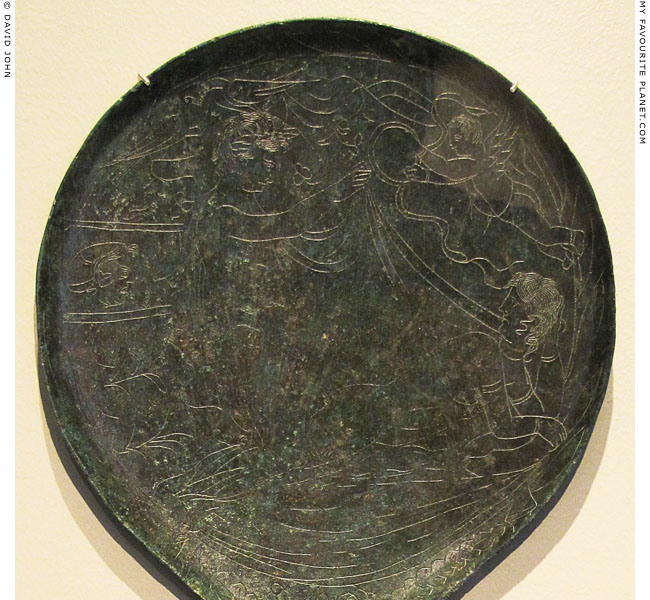
Detail of an Etruscan bronze mirror with an engraving of a wreathed male uncovering a naked
female who is lying on a bed. Perhaps Dionysus discovering Ariadne on Naxos. On the right a
winged Eros holds a fillet (headband), and on the right is a mysterious male head in profile.
4th century BC.
Altes Museum. Berlin. Inv. No. Fr. 159. |
| |
| Dionysus |
Dionysus and his thiasos
Dionysus is often depicted with members of his retinue, known as the thiasos
(θίασος), including Pan, Maenads, Satyrs, Silens and Silenos [see note 4].
In many cases these companions are shown without the god. |
|
 |
|
| |
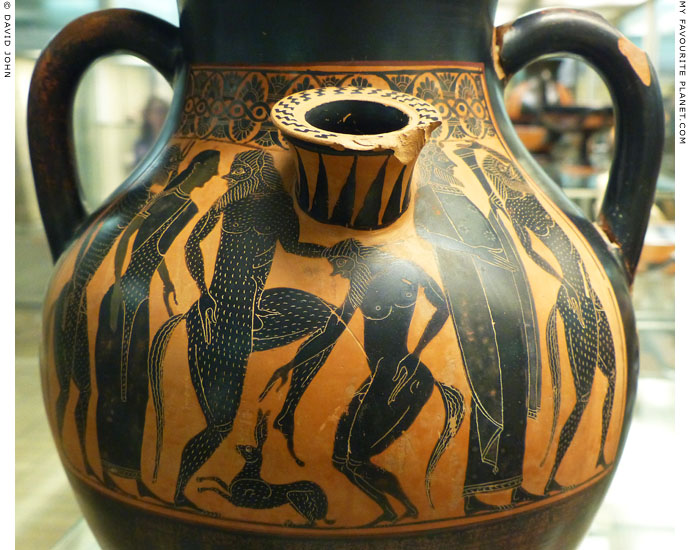
Detail of an Attic black-figure psykter-amphora (wine cooler) depicting Dionysus
(right of the spout, holding a rhyton) with Satyrs, a Maenad and a hare.
Made in Athens about 560-540 BC. Attributed to the painter Lydos.
The vessel has double walls between which cold water was poured to keep
the wine cool. The other side of the psykter shows Theseus killing the Minotaur
(see Lydos). Height 32 cm, width 23 cm, weight 2 kg.
British Museum. Inv. No. GR 1848,0619.5 (Vase B 148). Acquired in 1848. |
| |
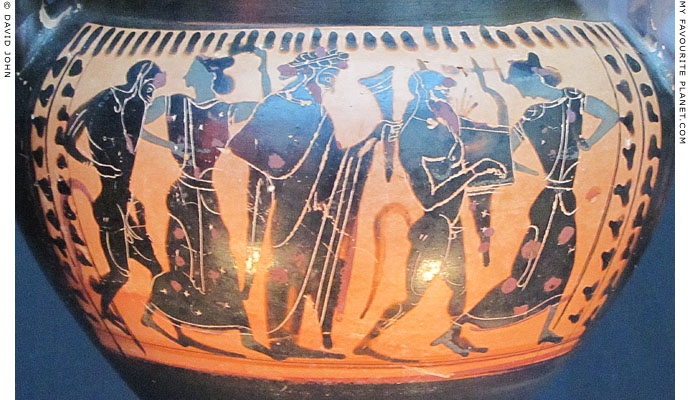
Detail of an Attic black-figure krater with a depiction of Dionysus, holding a rhyton (drinking horn),
standing between two pairs of dancing Satyrs and Maenads. The Satyr on the right plays a kithara.
Made in Athens around 520 BC. From Agia Paraksevi, Thessaloniki.
Thessaloniki Archaeological Museum. |
| |
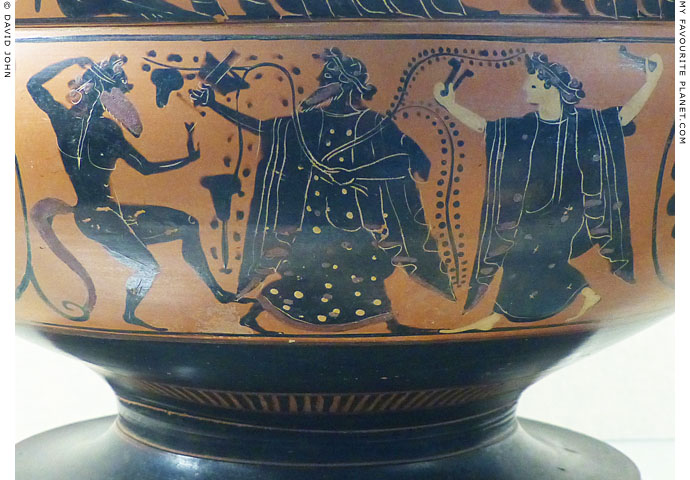
Dionysus stands between a Satyr and a Maenad dancing and playing clappers
(κρόταλα, krotala; singular, κρόταλον, krotalon), similar to castanets.
Detail of the lower part of an Attic black-figure calyx-krater,
made in Athens around 510 BC. Related to the Antimenes Painter.
The main scene above shows Athena and Herakles riding a chariot, surrounded by
other deities. On Side B of the krater, Dionysus standing between Satyrs and Maenads.
Found in Tomb 41 of the necropolis in the area of the Santuario Madonna delle Lacrime,
Syracuse, Sicily (see Demeter and Persephone part 1). It held the cremated ashes of an adult.
Paolo Orsi Regional Archaeological Museum, Syracuse, Sicily. Inv. No. 50960. |
| |
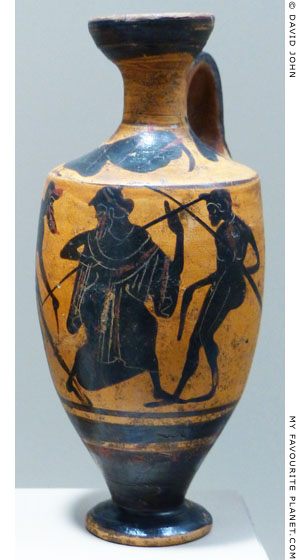
An Attic black-figure lekythos (oinment jar)
with Dionysus dancing with two Satyrs.
On the shoulder is a cockerel between
two heart-shaped leaves.
Late 6th - early 5th century BC. Attributed
to the Cock Group (by Claudia Lambrugo).
Height 13.8 cm.
Civic Archaeological Museum, Milan.
Inv. No. A 0.9.148. Donated by A. Cantoni. |
|
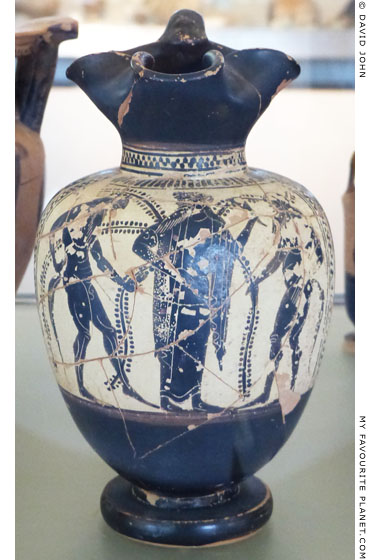
A black-figure trefoil oinochoe (wine jug)
with Dionysus and two Satyrs.
5th century BC. From the extended north
cemetery of Pydna, Macedonia, Greece.
Dion Archaeological Museum. |
|
| |
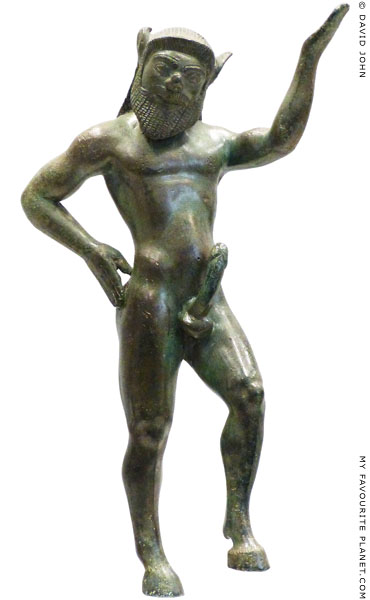
A bronze statuette of a nude ithyphallic Silen
with horse's hooves, dancing ecstatically.
Made in a Corinthian workshop around 540-530 BC.
Found 1875 in the Sanctuary of Zeus at Dodona, near
Ionnina, northwestern Greece, during excavations by
Konstantinos Karapanos (see note in Homer part 3).
National Archaeological Museum, Athens.
Inv. No. καρ. 22.
From the Konstantinos Karapanos Collection. |
|

A coin of Naxos, Sicily, with a depiction of a
nude, drunken Silenos, seated on the ground,
drinking wine from a kantharos. Naxos was
famed for its vines.
Around 460 BC.
Ashmolean Museum, Oxford. Inv. No. HCR5264. |
|
| |
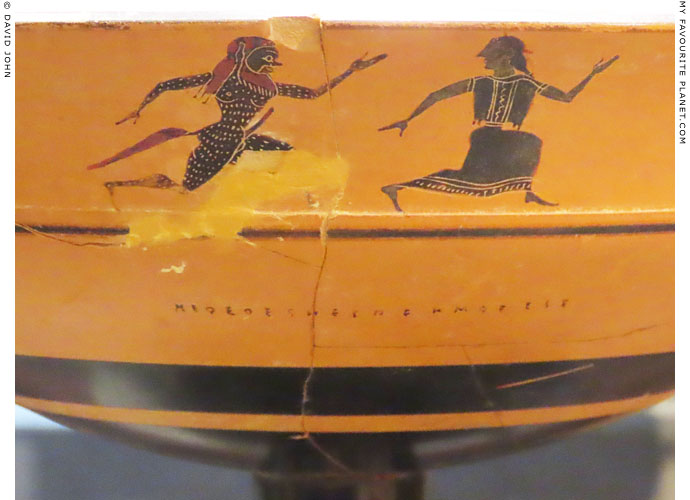
An ithyphallic Satyr chasing a Maenad on the outside of an Attic
black-figure lip cup. Below the scene is a row of nonsense letters.
6th century BC. From a grave on Rhodes.
Rhodes Archaeological Museum
Currently (2022) part of the extended exhibition "Ancient Rhodes - 2400 years"
in the Palace of the Grand Master, Rhodes. |
| |

Detail of an Attic black-figure column krater with a depiction of Dionysus,
holding a rhyton (drinking horn), flanked by dancing Maenads and Satyrs.
End of the 6th century BC. From ancient Galepsos (Γαληψός), a Thasian-Parian
colony on the northern Aegean coast of Thrace (the Thasian Peraia).
Kavala Archaeological Museum, Macedonia, Greece. |
| |

Dionysus, holding a rhyton (drinking horn) and an ivy branch, with two ecstatic dancing Maenads.
An Attic red-figure stamnos by the Syleus Painter, 480-470 BC. From Tarquinia, Etruria, Italy.
Dionysus, with long beard and locks wears a crown of ivy leaves, and a himation over a long
chiton. He walks to the right, looking to the left, carrying an ivy branch in his left hand and
a rhyton in his right. Both dancing Maenads hold krotala in each hand (see above).
The other side (Side A) shows the Judgement of Paris: Paris seated on a rock, Hermes
and Aphrodite with a sceptre and bird; a snake, a deer and a hedgehog on rock.
Pergamon Museum, Berlin. Inv. No. F2182.
See: Beazley Archive Database, Vase No. 202509 |
| |
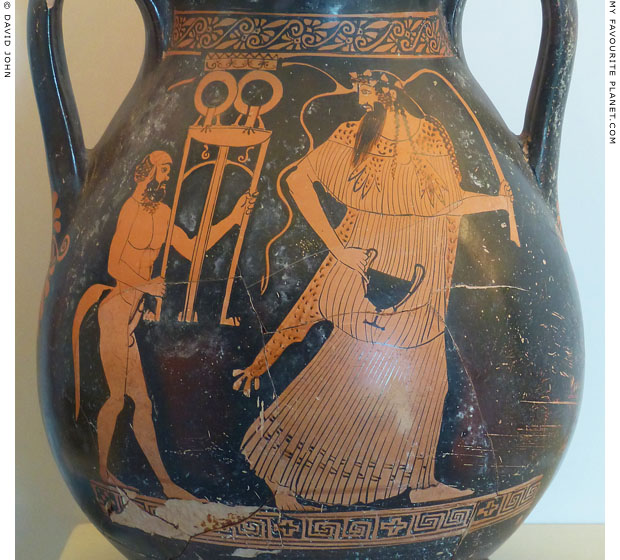
Dionysus, holding a kantharos and a vine branch, followed by a Satyr carrying a tripod.
Detail of an Attic red-figure pelike, attributed to the Berlin Painter, 480-470 BC.
Found in Tomb 175, Santa Venera, Paestum.
National Archaeological Museum, Paestum, Campania, Italy. Inv. No. T175 (4908).
See: Beazley Archive Database, Vase No. 19103 |
| |
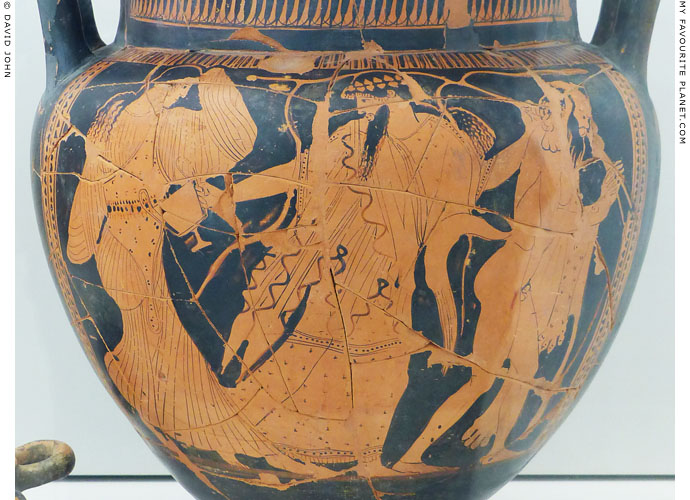
Detail of an Attic red-figure column krater showing with a Maenad, Dionysus
holding a kantharos (wine cup), and a Satyr playing an aulos (double pipes).
Attributed to a painter near the group of the Boreas and Florence Painters, 470-450 BC.
Found in Tomb 201 in the Manicalunga Necropolis, Selinous (today Selinunte), Sicily
(in use from the early 6th century until the Carthaginian invasion in 409 BC).
Antonino Salinas Regional Archaeological Museum, Palermo, Sicily. |
| |
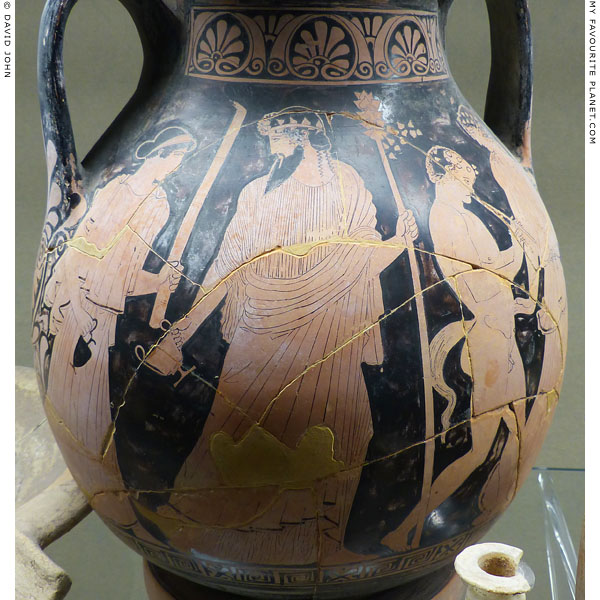
A Dionysiac scene, with Dionysus, holding a kantharos and thyrsos, and a Satyr playing
an aulos (double pipes), between two Maenads. The maened on the left holds a long
torch and a oinochoe (wine jug). The torch suggests that the scene is occurring at night.
Detail of an Attic red-figure pelike, attributed to the Christie Painter, 450-425 BC.
Found in Tomb 597 in the Necropoli del Fusco, Syracuse, Sicily. It contained the
ashes from a cremation. The other side of the pelike shows Maenads conversing.
Paolo Orsi Regional Archaeological Museum, Syracuse. Inv. No. 35188.
A similar painting of the same scene by the Christie Painter can be seen on a red-figure
bell-krater, circa 440 BC, in the Walters Art Museum, Baltimore, Maryland. Inv. No. 48.74.
See: art.thewalters.org/detail/29124/red-figure-bell-krater-2/ |
| |
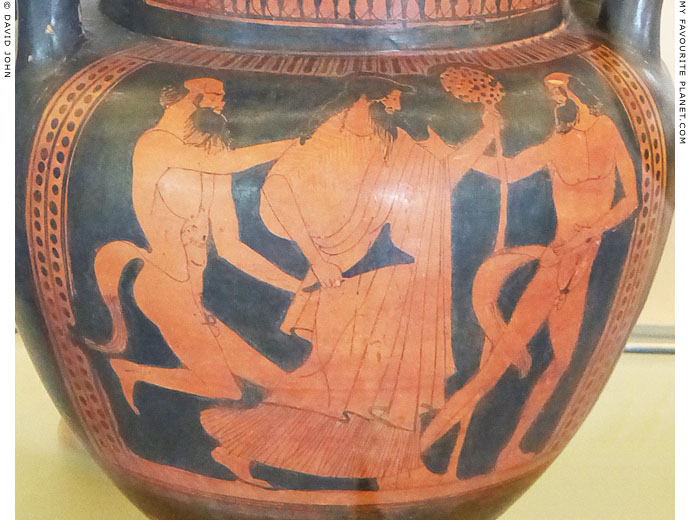
Detail of a red-figure pelike with Dionysus and two Satyrs.
5th century BC. From the cemetery at "Louloudia" of Kitros, Macedonia, Greece.
Dion Archaeological Museum. |
| |
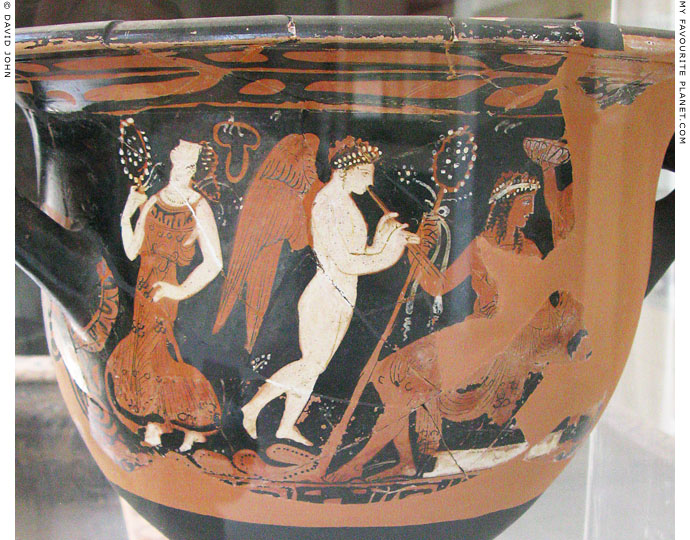
Detail of a red-figure bell krater showing Dionysus seated among his thiasos (retinue).
From ancient Antisara (modern Kalamitsa), Macedonia, Greece.
Dionysus, holding a thyrsos, looks behind at a figure carrying a bowl.
In the centre, a white winged Eros plays an aulos (double pipes),
and on the left is a dancing Maenad holding a thyrsos.
Kavala Archaeological Museum. Inv. No. A 3832. |
| |
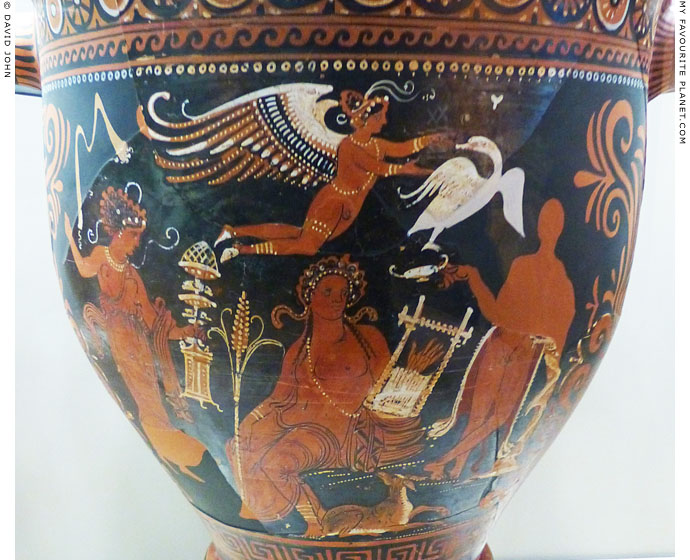
Detail of a large Apulian red-figure skyphos showing Dionysus seated among his thiasos.
2nd half of the 4th century BC.
Dionysus holds a lyre in his left hand and his thyrsos in the right. Below him sits a fawn,
and above Eros flies with a white bird. On the left a Maenad holds a thymiaterion
(thurible, incense burner), and on the right stands a naked Satyr with a wine cup.
Greek section, Civic Archaeological Museum, Milan. Inv. No. A 1988.01.01. |
| |
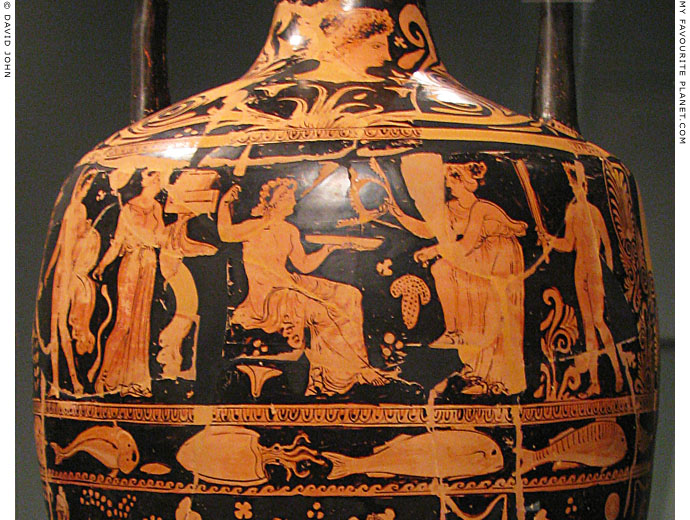
Detail of an Apulian red-figure amphora showing Dionysus seated among his thiasos.
From Ceglie (southern Italy). Attributed to the Dareios Painter, 350-330 BC.
The lower register shows an Amazonomachy (a battle between Greeks and Amazons).
The other side (Side A) shows Europa riding the bull (Zeus) and Nereids; the lower
register shows a Centauromachy (battle between Greeks and Centaurs).
Height 96.5, diameter 45 cm.
Pergamon Museum, Berlin. Inv. No. F 3241. |
| |
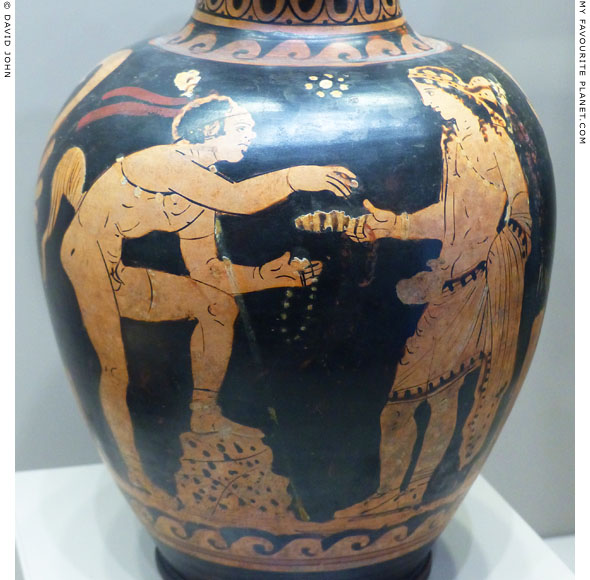
Detail of an Apulian red-figure trefoil oinochoe showing
a Satyr offering a headband and a necklace to Dionysus.
360-330 BC. From Poseidonia (Paestum),
Campania, Magna Graecia (southern Italy).
Greek section, Civic Archaeological Museum, Milan. Inv. No. A 0.9.261. |
| |
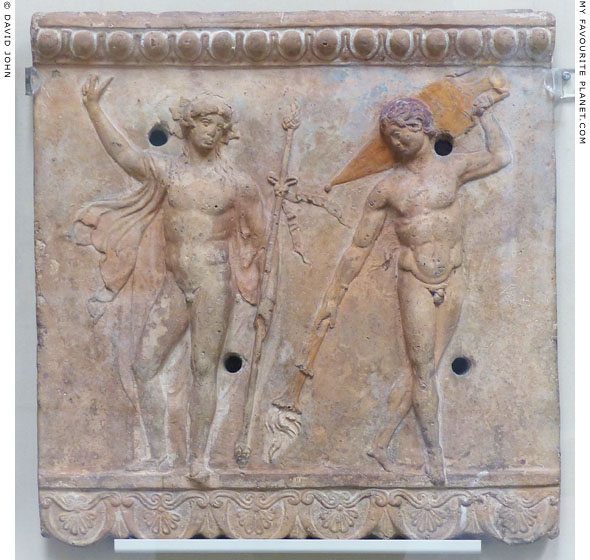
A terracotta relief of Bacchus (Dionysus) and a Satyr.
A Campana plaque. Roman, made in Italy around 20 BC - 50 AD.
Bacchus, naked apart from a cloak and ivy wreath, holds his thyrsos staff.
The naked Satyr holds a torch and carries a wine amphora on his shoulder.
British Museum. GR 1843.5-31.45 (Terracotta D 530). Townley collection.
See other Campana plaques in the British Museum with Dionysian themes:
Maenad and Satyr with the infant Bacchus above;
an "Ikarios relief" below |
| |
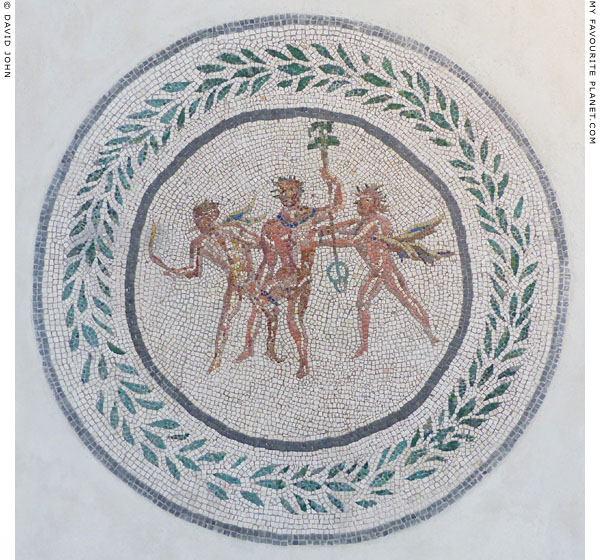
Central panel of a floor mosaic showing Dionysus and two Satyrs.
2nd century AD. Found in the area of the Villa Farnesina,
near the church of S. Giacomo in Settimiana, Rome.
Palazzo Massimo alle Terme, National Museum of Rome. |
| |
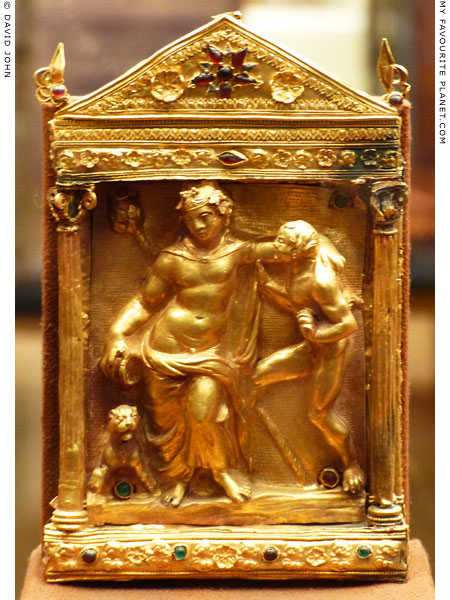
Gold relief of drunken Dionysus, supported by a Satyr, and a
small panther in a naiskos (small temple) with Ionic coulmns.
Gold, with inlaid garnets and emeralds. Hellenistic,
late 3rd or early 2nd century BC. Found in Thessaly,
National Archaeological Museum, Athens. Inv. No. St. 379.
Helen and Antonios Stathatos Collection. |
| |
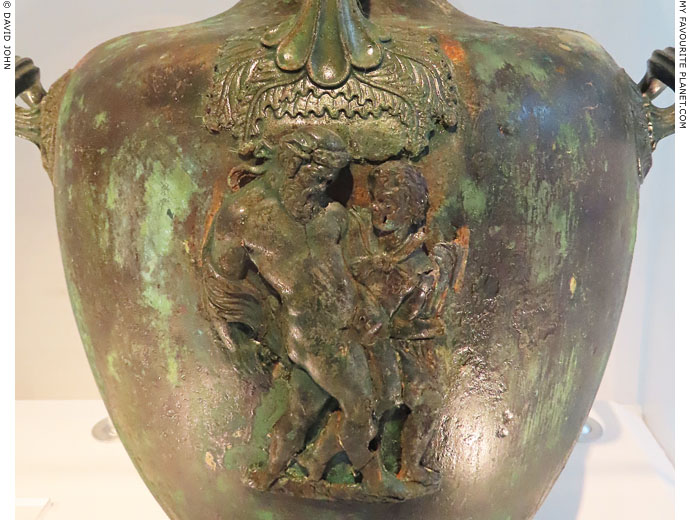
A bronze hydria (ὑδρία, three-handled water-carrying vessel) with an
attached relief of a drunken, bearded Dionysus supported by a Satyr.
350-325 BC. Perhaps made in Chalkis, Euboea. Height 49.4 cm,
diameter 32.5 cm, diameter of rim 27.7 cm, diameter of base 25.9 cm.
Igoumenitsa Archaeological Museum. Inv. No. ΘΕ 5. |
| |
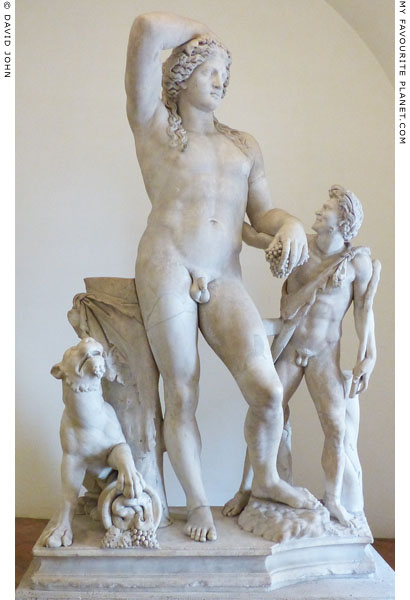
Colossal marble statue group with Dionysus,
a young Satyr and a panther.
160-180 AD, Roman period copy of a 4th century BC
Greek original. Found in the area of the Baths of
Constantine (Thermae Constantinianae) on the
Quirinal Hill, Rome, it probably originally stood in a baths.
Palazzo Altemps, National Museum of Rome.
Inv. No. 8606. Boncompagni Ludovisi Collection. |
|
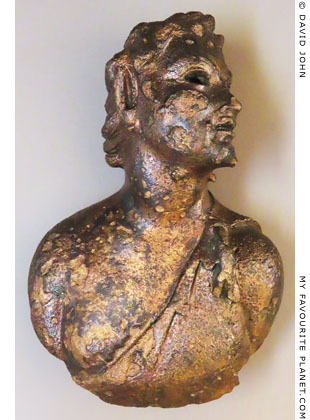
Small bronze bust of a Satyr, made in Kos.
Roman Imperial period, 1st - 3rd century AD.
Found in a storeroom in the ancient agora
of Kos, Dodecanese.
Kos Archaeological Museum. |
|
| |
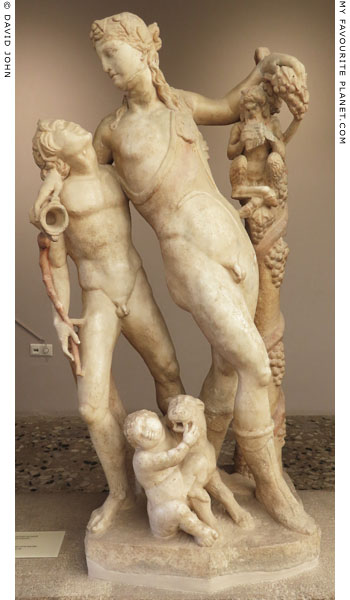 |
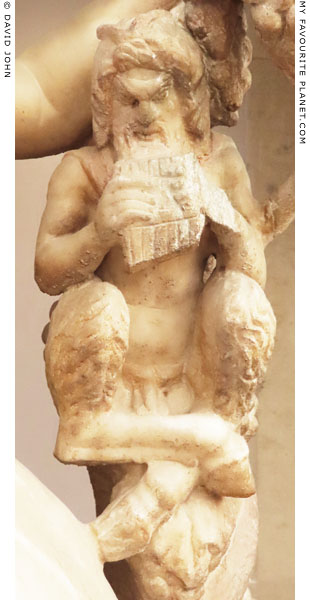 |
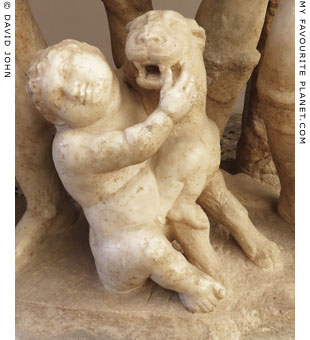 |
Smaller than lifesize marble statue group of drunken Dionysos, a Satyr, Pan, infant Eros and a panther.
150-200 AD. Found in June 1937, along with six other marble statues, in Room VIII of
the "House of the Rape of Europa" (la Casa considdetta del Ratto di Europa), in Kos Town,
during excavations 1936-1940 directed by Italian archaeologist Luigi Morricone (see Hermes).
Kos Archaeological Museum. Inv. No. 94. |
|
| |
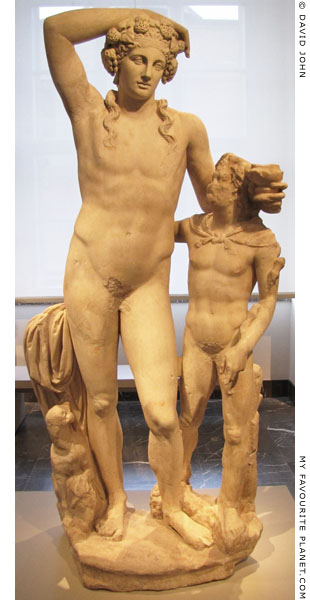
Marble statue of Dionysos and a Satyr.
160-170 AD. Found in the pool of the tepidarium
of the Faustina Baths, Miletus, Turkey.
Height 235 cm, width 98 cm, depth 73 cm.
Altes Museum, Berlin. Inv. No. Sk 1797.
Acquired in 1904.
Dionysus stands naked, his weight resting on his right leg, his left leg bent and placed forward. His right forearm rests on top of his head. His hair is partly held up by a tainia (headband) with an ivy wreath and hung with bunches of grapes. Tresses fall from either side of his head to his chest. He rests his left forearm on the shoulder of the Satyr, and holds a kantharos (wine cup) in his left hand.
The young Satyr, also naked apart from an animal skin around his shoulders, fastened by a knot beneath his throat. In his left hand he holds a lagobolon (hunting stick, see Pan). He looks up to Dionysus and has his right hand behind the god's waist.
A himation lies on the tree trunk supporting Dionysus, and in front of it sits a panther with the head of a billy goat lying between its forepaws. A syrinx (pan pipes) hangs from the Satyr's tree trunk support.
"Presumably under Christian influence, the genitalia of both statues were chiselled off in late antiquity."
From the museum labelling. |
|
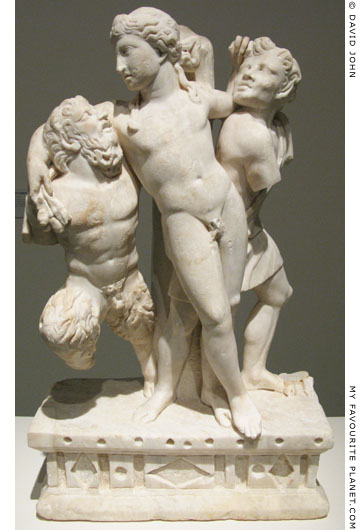
A marble table support (trapezophoron)
depicting a drunken Dionysus supported
by Pan and a young Satyr.
Roman period, mid 2nd century AD.
Acquired 1846 in Rome by Gerhard from the art
dealer Trebi. Until 1859 in Sanssouci, Potsdam.
Height 78 cm, width 47.5 cm, depth 27 cm.
Pergamon Museum, Berlin. Inv. No. Sk 97. |
|
| |
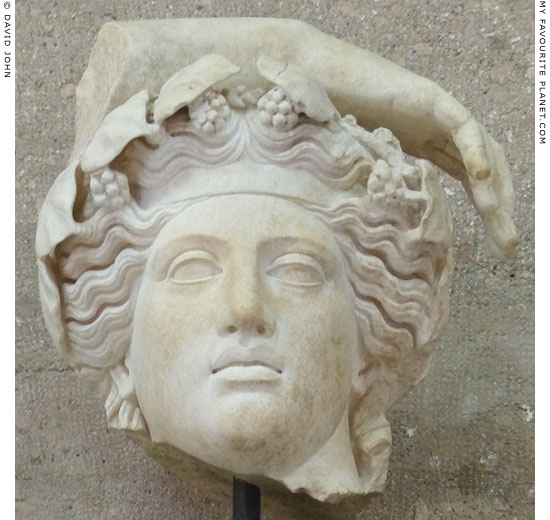
A marble head of Dionysus with his right arm resting on top of it.
From the area of the Propylaia, ancient Corinth. 2nd century AD
copy of a Greek prototype attributed to Praxiteles (4th century BC).
Corinth Archaeological Museum. Inv. No. S-194. |
| |

A marble head of Dionysus with his right arm resting on top of it.
140-150 AD. Heigh 31.5 cm, width 28.0 cm, depth 23.0 cm.
Skulpturensammlung, Albertinum, Dresden. Inv. No. Hm 228. |
| |
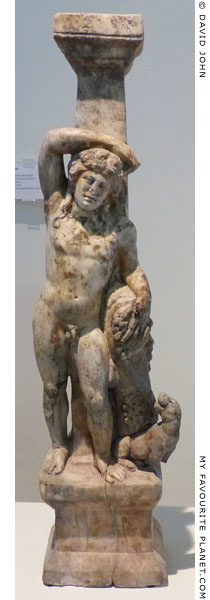
Marble trapezophoron (table support)
depicting Dionysus and a panther.
From the "House of Leda", Dion,
Macedonia. 2nd century AD.
Dion Archaeological Museum. |
|
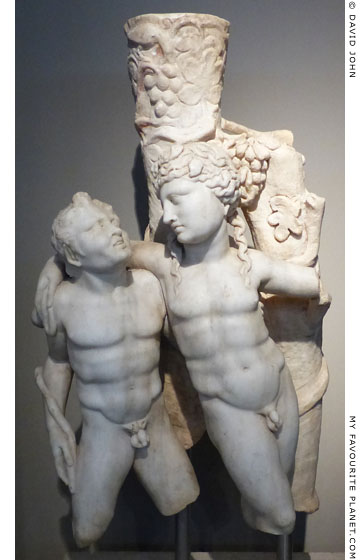
A marble table support depicting a drunken
Dionysus supported by a young Satyr holding
a lagobolon (see Pan).
3rd century AD.
From Thessaloniki, Macedonia, Greece.
Thessaloniki Archaeological Museum. |
|
| |
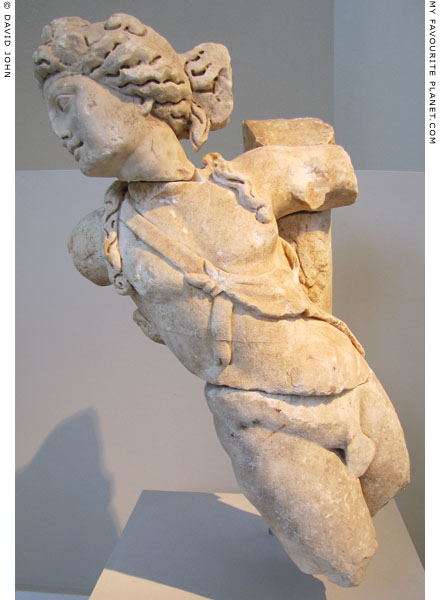
Fragment of a marble trapezophoron depicting
drunken Dionysus supported by a Satyr.
From Thasos. 2nd century AD.
Thasos Archaeological Museum. |
| |
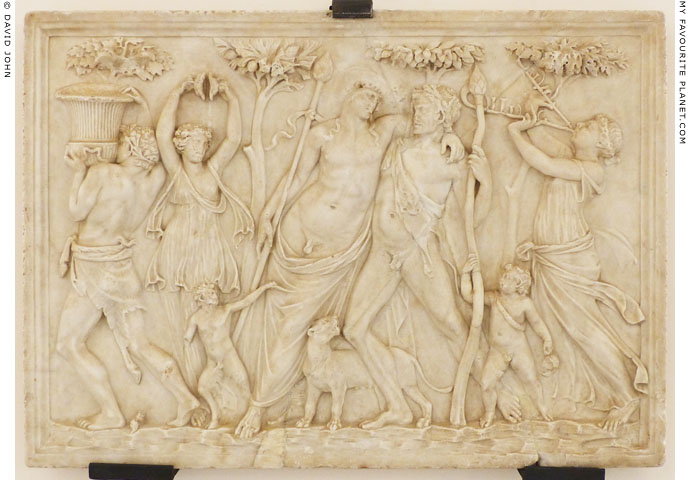
Marble relief with drunken Dionysus supported by a Satyr between two Maenads. Late 2nd century AD.
Dionysus and the Satyr both hold thyrsos staves. Below them are an oddly diminutive Pan,
a panther and Eros. The Maenad on the left plays cymbals and the other a double flute.
Another Satyr, on the far left, carries a wine krater on his left shoulder.
National Archaeological Museum, Naples. Inv. No. 6684. Farnese Collection. |
| |
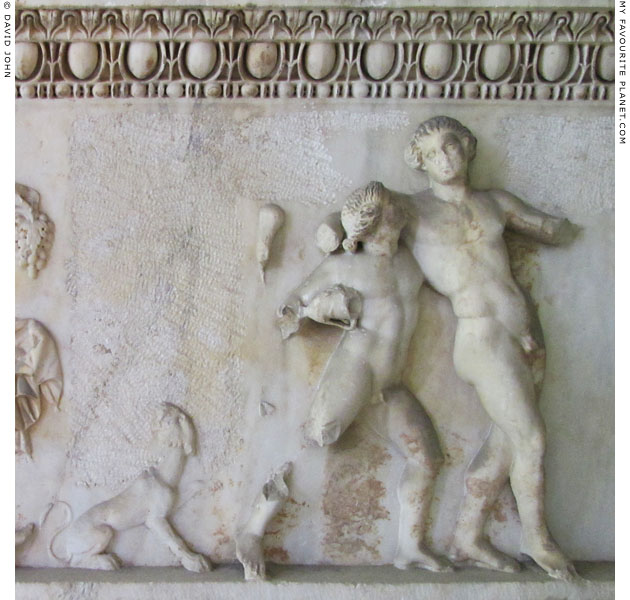
Detail of a relief on the side of a marble Attic sarcophagus with drunken Dionysus supported
by a Satyr, and a panther sitting to the left. They are flanked by drunken infant Erotes (not
shown in photo), depicted at a larger scale, holding the symbols of the four seasons.
The relief on the other long side of the sarcophagus depicts a small Eros, garlands, bukrania
(bulls' skulls) and lions' heads. On one of the short sides is a sphinx and at the other two Erotes
holding kantharoi (wine cups) and dancing around a censer. The large sarcophagus is displayed
in a narrow pasage of the museum's garden, so that it is difficult to view the long sides.
Roman Imperial period, 150-175 AD. Found in 1951 in the Vyronas district of Athens,
southeast of the city centre. Height 152 cm, length 264 cm, width 108 cm.
National Archaeological Museum, Athens. Inv. No. 4008. |
| |

Dionysus, supported by a young Satyr in a leopard skin, discovers the sleeping Ariadne on Naxos,
in the Sleeping Ariadne mosaic in Thessaloniki. 200-250 AD. Ariadne's feet can be seen, right.
Right of Dionysus and the Satyr is Pan or Silenos with a wine cup and a lagobolos (hunting stick).
Thessaloniki Archaeological Museum. |
| |
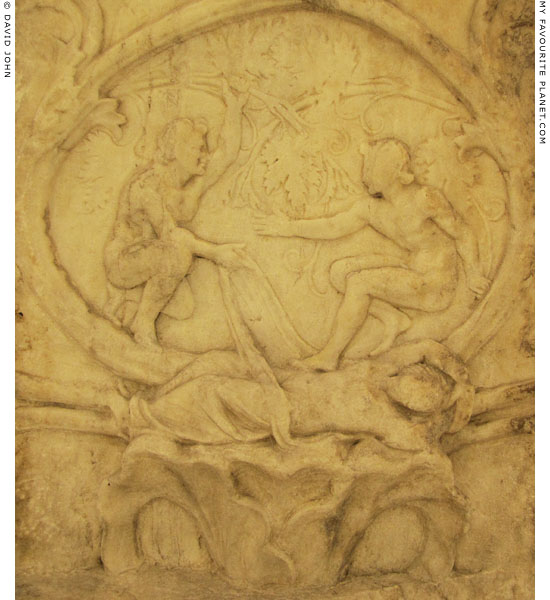
Detail of a relief on a marble table support: two Satyrs expose a sleeping female (Ariadne?).
From Pergamon (perhaps from the Asclepieion). Late Hellenistic, 1st century BC.
Antikensammlung SMB, Berlin. Inv. No. AvP VII, 407.
|
The marble slab is decorated on both sides with Dionysiac motifs (the other side has a relief of two male goats with an amphora). The museum labelling describes this scene simply as "Satyr and Maenad". The Satyrs crouch opposite each other on the symmetrically intertwining stems of two enormous flowering vines which take up most of the height of the slab. The figure on the left uncovers a naked female who lies asleep on an acanthus leaf. She may be a Maenad, but the scene is reminiscant of the uncovering of Ariadne as Dionysus discovers her on Naxos.
Height of marble slab 71 cm, width at bottom 34.5 cm,
width at top 32 cm, maximum depth at top 12 cm.
See also a Gorgon relief from Ephesus with a similar giant plant motif. |
|
| |
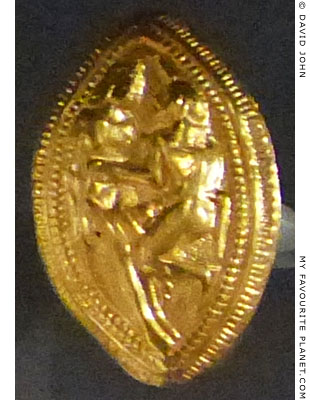
Etruscan gold finger ring with a relief
of a Satyr assaulting a Maenad.
5th century BC.
Ashmolean Museum, Oxford. Inv. No. An. Fortnum R.702.
From the Fortnum Group, donated by the collector C. D. E. Fortnum. |
| |
 |
|
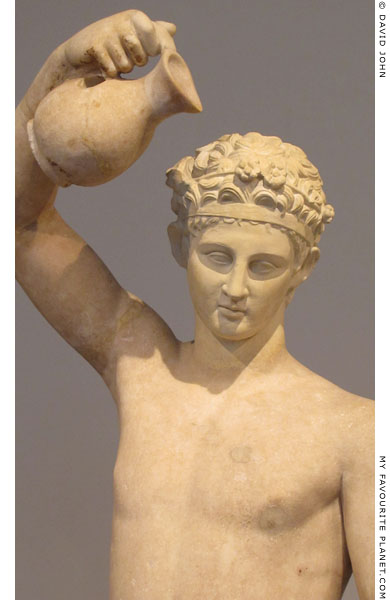 |
Restored marble statue of a young Satyr pouring wine from a jug into a rhyton (drinking horn).
Around 150 AD. From a villa at Monte Calvo, Sabina (Italy), where it was
part of a fountain. One of a number of Roman period statues thought to
be copies of a lost Greek original made by Praxiteles circa 370-350 BC.
Altes Museum, Berlin. Inv. No. Sk 257. Acquired in 1826. |
|
| |
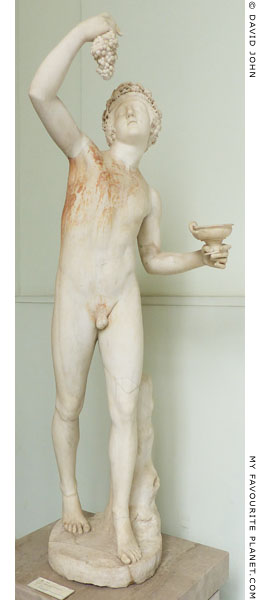 |
|
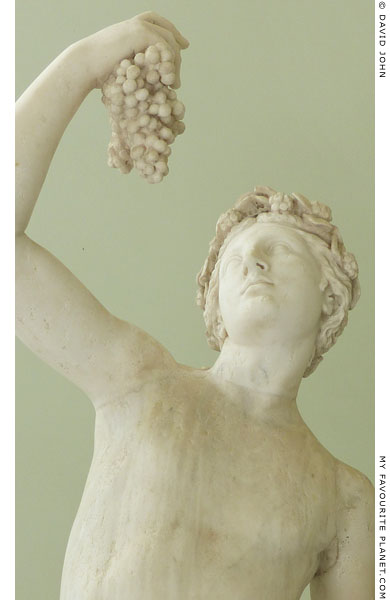 |
Marble statue of a "faun" holding up a bunch of grapes with his right hand and a wine cup in
the left. He balances delicately on his toes, although the statue is supported by a tree trunk.
2nd century AD copy of a late 2nd - 1st century BC Greek original.
National Archaeological Museum, Naples. Inv. No. 6332. Farnese Collection. |
|
| |
 |
|
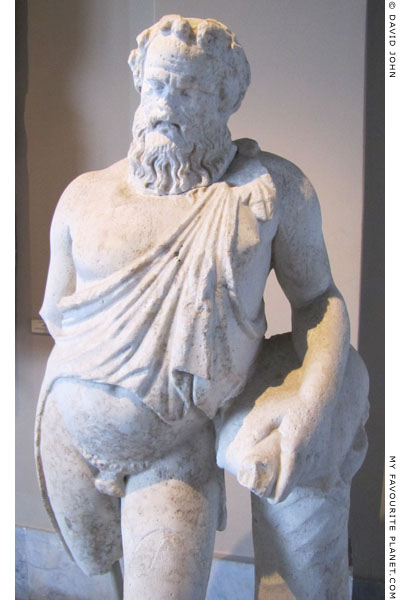 |
A marble statue of drunken Silenos leaning against the stump of a tree trunk. The aged
Silen wears only a nebris (animal skin), fastened at his left shoulder and covering part
of his upper torso. He rests his left arm on a wineskin that lies on top of the stump.
1st centuy AD, Roman period. From Neapolis (Nablus, Jordan).
Istanbul Archaeological Museum. Inv. No. 1221 T. Cat. Mendel 617. |
|
| |
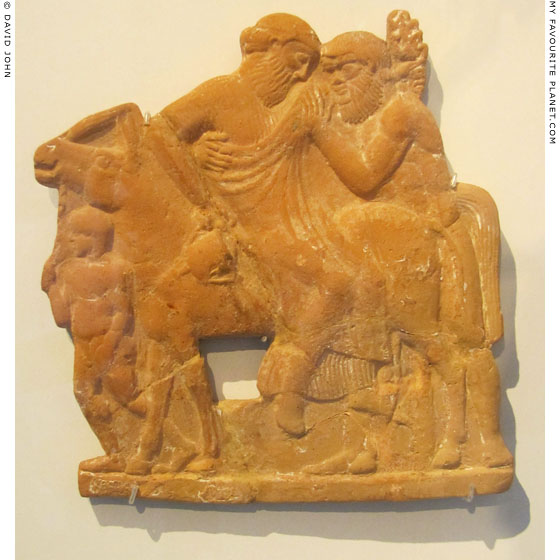
Ceramic relief of drunken Dionysus riding a mule, supported by a Silen.
Dionysus holds a kantharos in his right hand and his thyrsos in the left.
A small male figure leads the mule.
Clay with traces of white ground as well as red and yellow.
A "Melian" relief, allegedly found on the island of Melos. Probably
made in Athens around 480 BC. Height 16 cm, width 14.5 cm.
Altes Museum, Berlin. Inv. No. TC 6297. Acquired in 1873. |
| |

Three-lobed oinochoe (wine jug) in the form of
the head of Silenos or Dionysus. 5th century BC.
Museo Civico, Castello Ursino, Catania, Sicily.
Inv. No. 4172. From the Biscari Collection. |
|
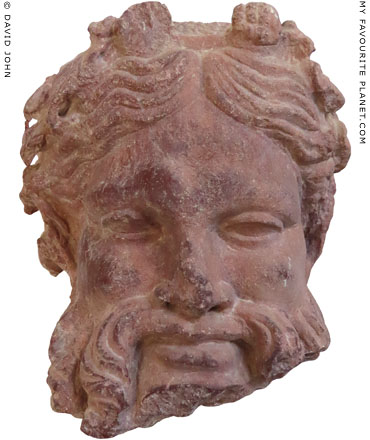
Porphyry head of Silenos or Dionysus appearing
intoxicated, wearing an ivy crown.
Middle Hellenistic period. From Rhodes.
Rhodes Archaeological Museum.
Inv. No. 13641. |
|
| |
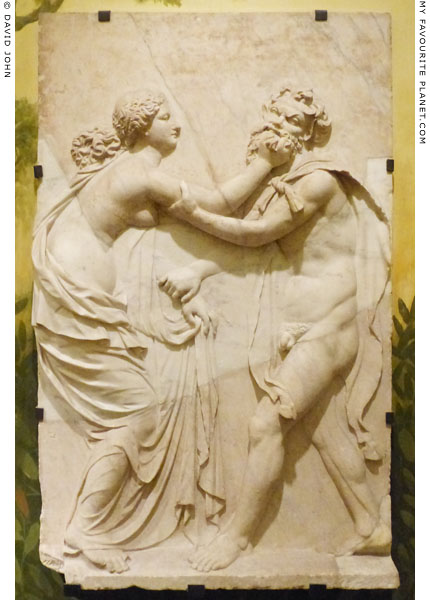
Marble relief of a Nymph and an aged Satyr (Silenos).
From Herculaneum. 1st century AD.
Gabinetto segreto (Secret Cabinet), National
Archaeological Museum, Naples. Inv. No. 6724. |
| |
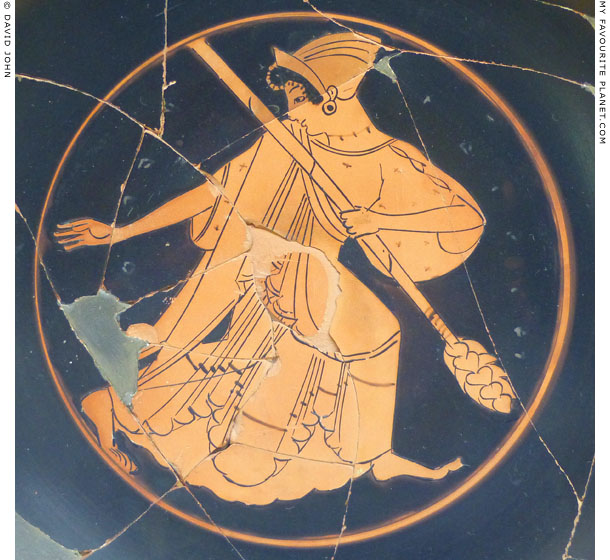
The tondo of an Attic red-figure kylix (wine cup) by the Chairias Painter (also known as the
Painter of the Agora Chairias cups), depicting a Maenad holding a thyrsos staff. 510-500 BC.
Agora Museum, Athens. Inv. No. P 24116.
|
The kylix is one of of three similar cups found in a well beneath the south end of the Stoa of Attalus in the Athenian Agora in June 1954. It was complete apart from the foot, and has been restored from several fragments. The tondo (the round painted panel in the centre of the inside of the cup) has a painting of a Maenad running to the right, with the upper part of her body twisted so that she looks behind her. She wears as sakkos (σάκκος, a soft woven cap or a piece of material wrapped around the head), a himation (cloak) over a long chiton (tunic), earrings and a necklace. Her right arm is outstretched, and in her left hand she carries a thyrsos, pointed downwards and to the right.
The inscription: to the right of her, Χαιρίας (Chairias); and left of her, καλο[ς] (kalos, good, beautiful). Diameter of tondo 10.8 cm. |
|
| |
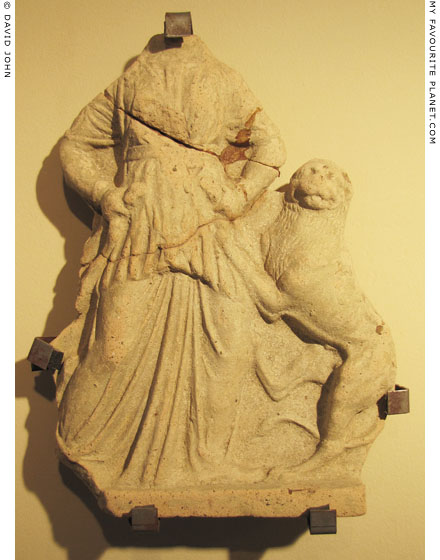
A fragment of a terracotta antefix (end of a roof tile) thought
to depict a Maenad between two "panthers", only one of which
has survived. The now headless figure grasps a forepaw of each
of the cats in the manner of the Mistress of Animals.
4th - 3rd century BC. From a Samnite sanctuary at Pietrabbondante,
Isernia province, Molise region, south-central Italy. [see note 8]
|
|
| |
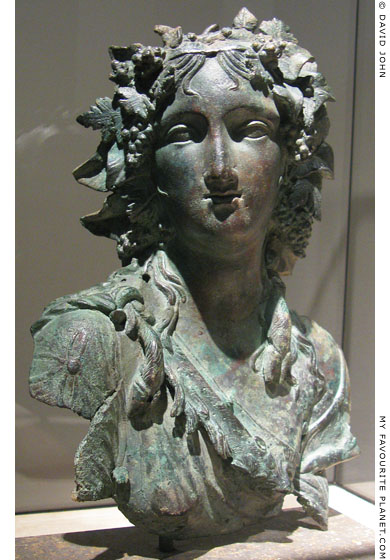
Large bronze bust of a Maenad. Around 50 BC.
She wears grapes, vine leaves and ivy leaves in her hair,
and a doe skin is tied at the right shoulder. Height 29.2 cm.
The bust may have been part of an attachment of a large
monument, such as a building or statue base.
Pergamon Museum, Berlin. Inv. No. 1967.5. |
| |

Detail of a Neo-Attic relief with three Maenads (μαινάδες, also known as Bacchantes),
female followers of Dionysus, in a wild orgiastic dance. Each Maenad holds a dagger
in her right hand and carries a sacrificial animal in the left.
Based on models by Kallimachos (late 5th century BC). Pentelic marble.
Barracco Museum, Rome. Inv. No. MB 124. Purchased in Rome. |
| |
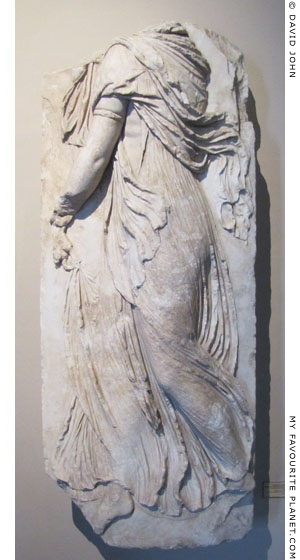
Marble relief of a dancing Maenad
from Pergamon.
Hellenistic, late 3rd century BC. Found in
September 1896 reused in a wall, southwest
of the Upper Agora of the Pergamon Acropolis.
Istanbul Archaeological Museum.
Inv. No. 764 T. Cat. Mendel 575. |
|
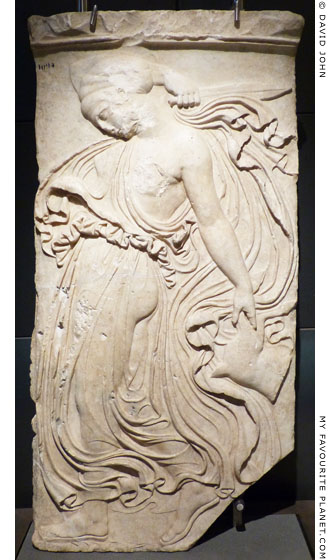
A Neo-Attic marble relief of a dancing Maenad.
Pentelic marble. Part of a circular monument.
A copy of a choragic votive offering for
Euripides' play The Bacchantes, made by
Kallimachos in 406-405 BC. Found 1875
in the Piazza Vittorio Emanuele, Rome.
Palazzo dei Conservatori, Capitoline Museums,
Rome. Inv. No. MC 1094. |
|
| |
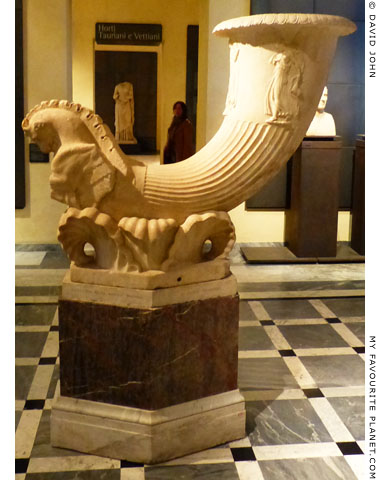 |
|
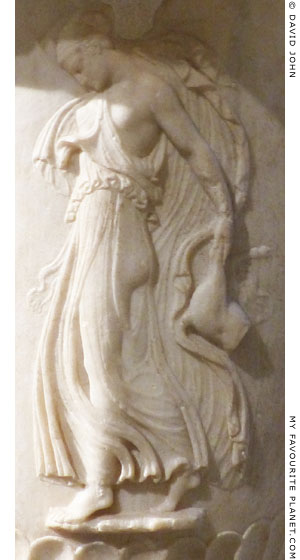 |
A marble Neo-Attic fountain in the shape of a rhyton (drinking horn),
with a protome (front part) of a horse at the lower narrower end,
and reliefs of dancing Maenads around the open end. The Maenad
from the fountain (photo, right) is almost identical to the one
above, right and another on a sarcophagus below.
Signed by the Greek artist Pontios of Athens. 1st century AD. Probably
derived from a metal prototype. Excavated in 1874 in the area of the
Auditorium, in the Horti Maecenatis (Gardens of Maecenas), Rome.
(See also the fragments of reliefs below, here and here.)
Height 112 cm, length 145.5 cm.
Palazzo dei Conservatori, Capitoline Museums, Rome. Inv. No. MC 1101.
Part of a smaller replica of this sculpture, made of Pentelic marble and dated to
the end of the 1st century AD, was found in the Via Tiburtina, Rome, and is now
in the Palazzo Massimo alle Terme, National Museum of Rome. Inv. No. 124132. |
|
| |
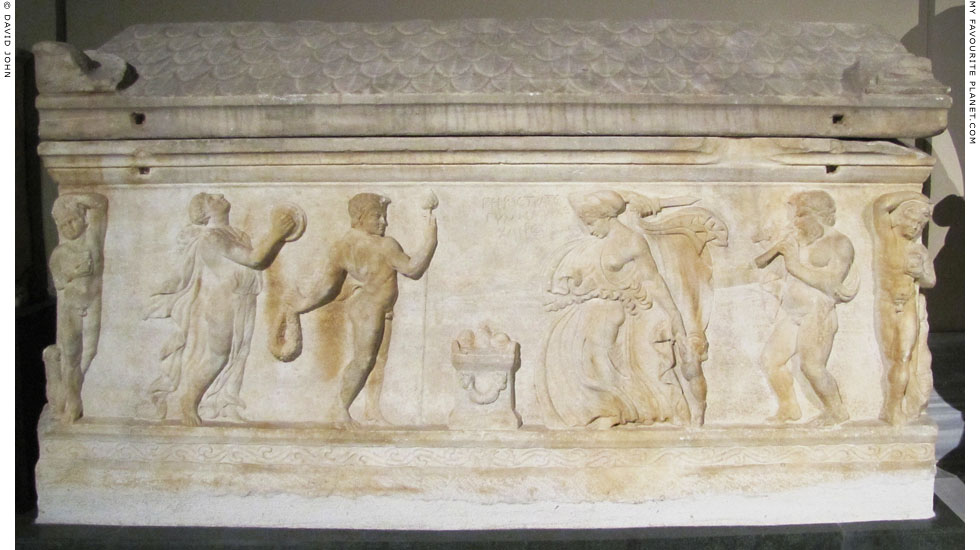
A Dionysiac scene on the front of the sarcophagus of the Gymnasiarch Gerostratos.
From Beirut, Lebanon. Roman period, 2nd century AD.
Istanbul Archaeological Museum. Inv. No. 1417 T. Cat. Mendel 33.
|
Satyrs, Silens and Satyrs dance and play music during a sacrifice to Dionysus at an altar. The Maenads are shown in poses known from a number of other reliefs thought to be modelled on late 5th century BC originals by Kallimachos. See, for example other photos above: a Maenad similar to one with a tympanon, left, on a relief from Rome now in the British Museum; figures almost identical to the Maenad to the right of the altar in three relief figures from Rome in the Barracco Museum.
The inscription, in what looks like a freehand style, just to the left of the Maenad next to the altar: "Gerostratos, gymnasiarch, farewell".
The relief on the left side of the sarcophagus shows a Maenad and a Satyr (see below). The right side has a relief of a crouching sphinx. |
|
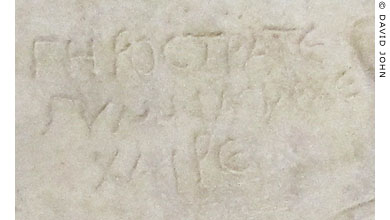
"Gerostratos, gymnasiarch, farewell" |
|
| |
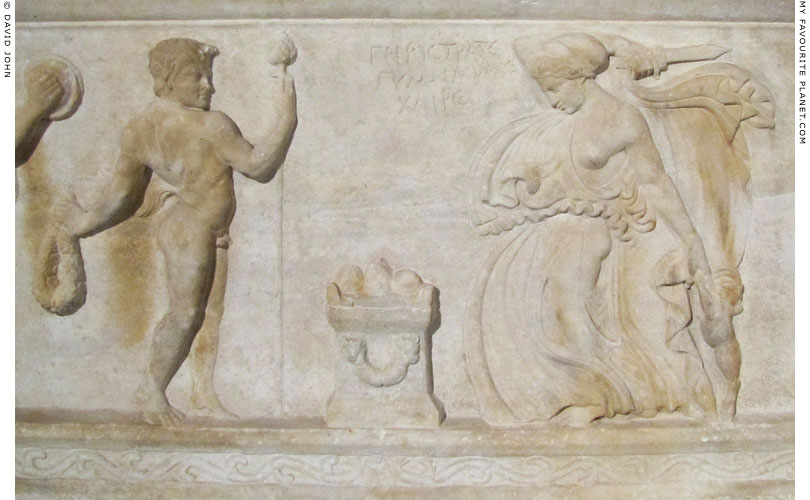
A sacrifice to Dionysus on the Gerostratos sarcophagus. |
| |
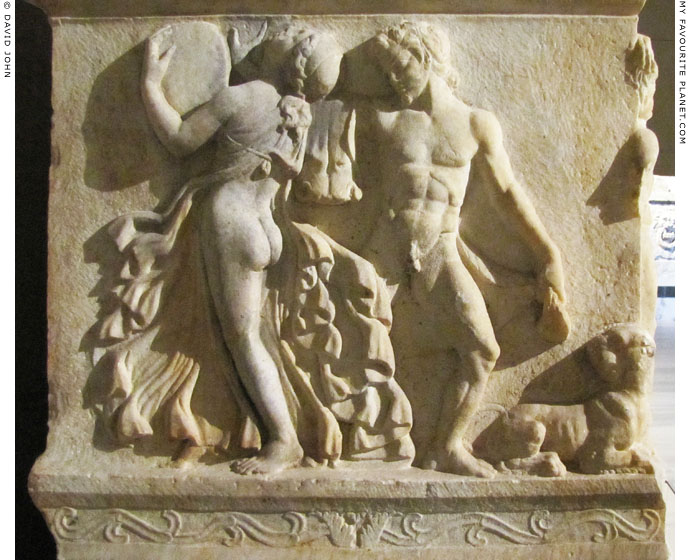
A Maenad with a tympanon (hand drum), a Satyr and a sitting panther on
the side of the sarcophagus of the Gymnasiarch Gerostratos (see above).
From Beirut, Lebanon. Roman period, 2nd century AD.
Istanbul Archaeological Museum. Inv. No. 1417 T. Cat. Mendel 33. |
| |
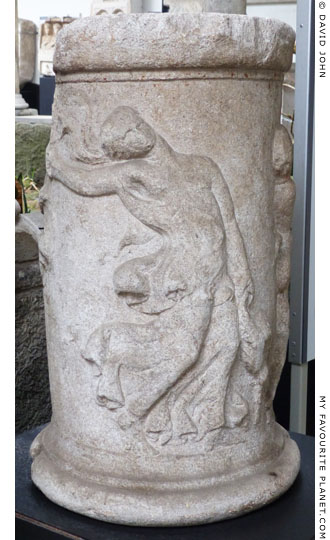 |
|
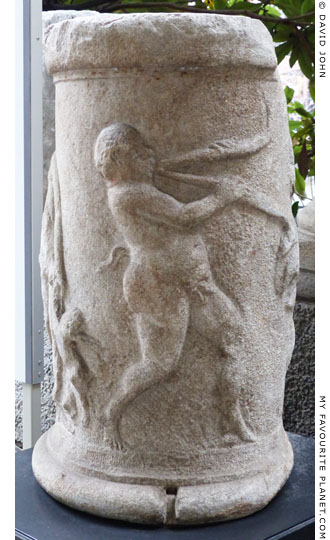 |
A marble cylindrical altar with reliefs of a dancing Maenad holding a hare, and a Satyr playing
double pipes. Another dancing Maenad with a hare is depicted on the other side of the altar.
1st half of the 1st century AD. From Cremona, Italy. Height 70 cm, diameter 38 cm.
Civic Archaeological Museum, Milan. Inv. No. A 0.9.1140. |
|
| |
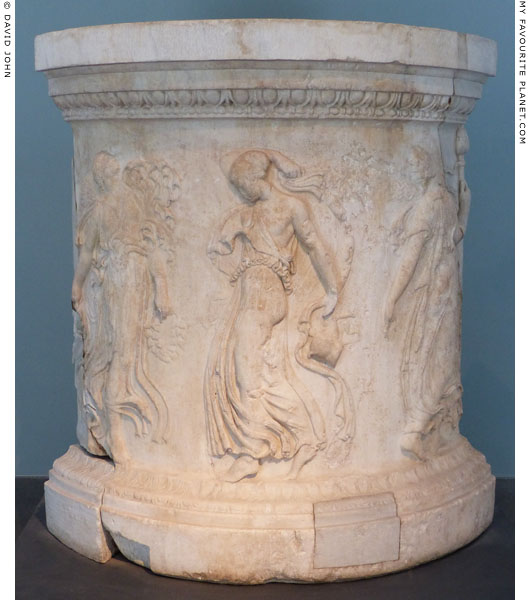
Semi-circular Neo-Attic marble base with reliefs of dancing Maenads.
Pentelic marble. Second half of the 1st century AD.
Palazzo Massimo alle Terme, National Museum of Rome.
Inv. No. 2001482. From the Sciarra Collection. |
| |

Relief of a dancing Maenad on the base of a marble candelabrum.
Pentelic marble. Neo-Attic style, early Imperial age. From the Horti Lamiani.
Found in 1874 near Piazza Vittorio Emanuele, Rome. Height 210 cm.
Palazzo dei Conservatori, Capitoline Museums, Rome. Inv. No. 1115. |
| |
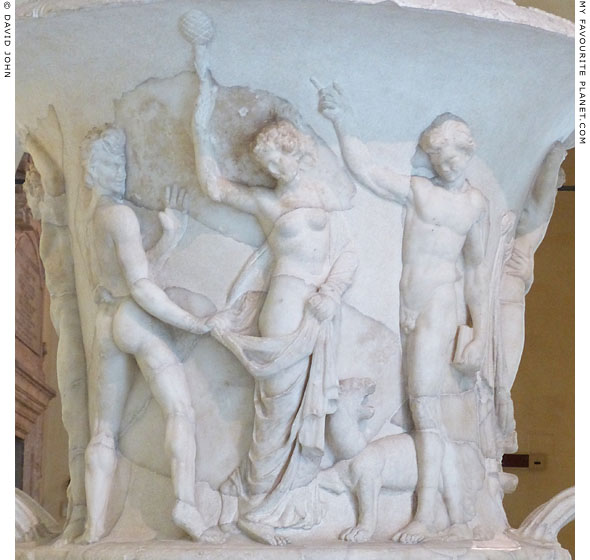
A Maenad and two Satyrs at erotic play and a panther.
Detail of a large marble krater with reliefs of Bacchic scenes.
Pentelic marble. Found in 1872 in the Horti Vettiani, Rome.
Palazzo dei Conservatori, Capitoline Museums, Rome. Inv. No. MC 1202. |
| |

A marble relief of a dancing Maenad from
the seventh pillar from the west on the
south stoa (portico) of the theatre at
Philippi (Φίλιπποι), Macedonia, Greece.
2nd century AD. Roman Imperial period.
Philippi Archaeological Museum, Macedonia, Greece. |
|
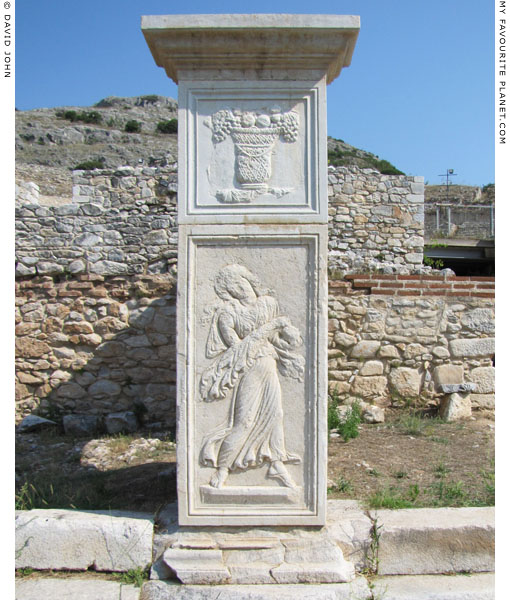
A modern copy of the Maenad relief, left, set up on a pillar in front
of the skene (stage house) of the theatre at Philippi. The figure
is shown dancing in a frenzy of ecstasy or rage. Her hair is loose,
she wears a peplos (dress), a himation (cloak) and sandals, and
carries the severed head of a sacrificial vicitm.
Philippi Archaeological Site. |
|
| |
The theatre of Philippi (Φίλιπποι) was built at the foot of the city's acropolis hill during the reign of Philip II of Macedonia, who conquered the Thasian colony of Krenides (Κρηνῖδες) in 356 BC and renamed it after himself. It was restyled as a Roman theatre in the 1st - 2nd centuries AD, and during the 2nd - 3rd centuries AD it was converted into an arena for gladiatorial games.
The theatre was oriented so that the centre someone standing in the centre of the semi-circular cavea (audience seating area) facing directly towards the orchestra (stage area) would be looking southwest, towards the city centre, across the wide plain on which its stands and Mount Pangaion (Παγγαίο όρος) on the opposite side. (For the names of parts of ancient Greek theatres, see The Theatre of Dionysos, Athens.) During the 2nd century AD, a skene (stage building) was built along the rear (south side) of the orchestra, and behind this was added a long stoa (a portico or roofed colonnade) consisting of a row of seven adjoining rooms.
The pillars supporting the stoa's roof were decorated with marble reliefs depicting humans, animals and symbolic objects connected with the worship of Dionysus. Also included were scenes from the local myth of Lycurgus (Λυκοῦργος, Lykourgos), grandson of the war god Ares and king of the Thracian Hedoni tribe in the area of the Strymon River (see photo below). He opposed the worship of Dionysus, threatened the god and attacked the Maenads. As a punishment Dionysus drove Lycurgus mad, and he killed his own child, imagining he was cutting a vine. The Hedoni tied him to Mount Pangaion, where he was devoured by wild horses. |
|
| |

The lower part of a marble relief from the south stoa of the theatre at Philippi, with
a scene from the myth of the Thracian king Lycurgus. Wearing a cloak, a short chiton
(tunic) and endromides (footwear similar to boots), Lycurgus moves to the right,
chasing Maenads. Originally, in his raised hands, now missing, he brandished an axe.
2nd century AD.
Philippi Archaeological Museum. |
| |
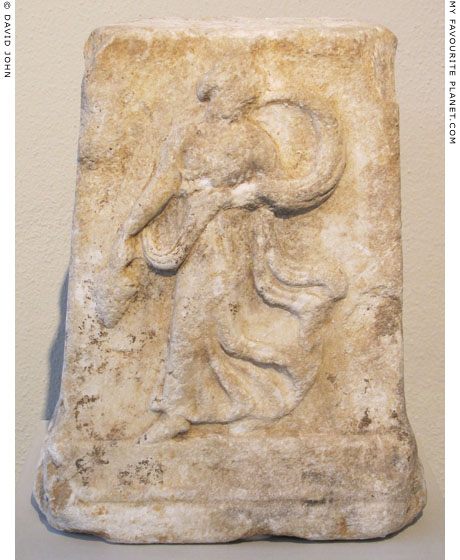
A small altar with a relief of a dancing Maenad carrying a bunch of grapes.
1st - 2nd century AD. Unknown provenance. Height 30.5 cm, width 24.5 cm.
Thasos Archaeological Museum, Macedonia, Greece. Inv. No. 109. |
| |
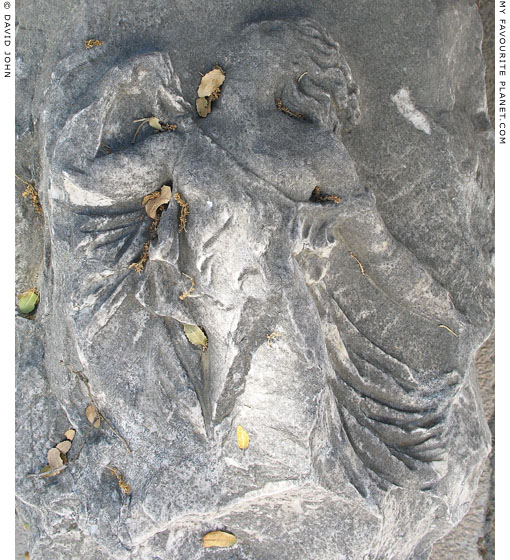
Fragment of a relief depicting a dancing Maenad, strangely left
lying on the ground at the Stoa of Attalus in the Athenian Agora.
Pentelic marble. Roman period.
Museum of the Ancient Agora, Athens. |
| |
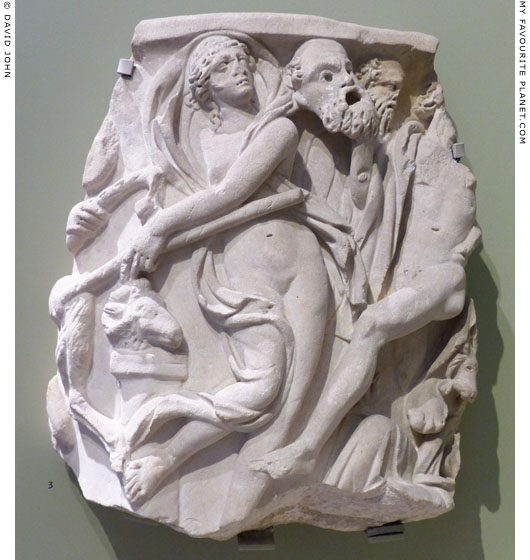
A marble relief on a fragment of an oval sarcophagus, showing a dancing Maenad
with a thyrsos and a Satyr holding a mask of Silenos. The severed head of a goat on
a pedestal and the hand (holding a lagogolon) and leg of Pan can be seen on the left.
Roman, 200-300 AD. Excavated in Rome by Lord Arundel, 1613-1614.
Ashmolean Museum, Oxford. Inv. No. Michaelis 109. |
| |
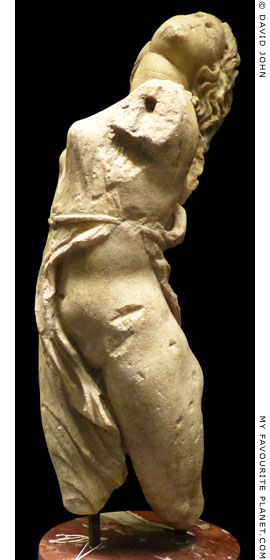
The "Dresden Maenad", a marble
statuette of a dancing Maenad.
2nd half of the 1st century BC. Possibly based
on a statue by Skopas of Paros, known as the
"Goat Slayer" (χιμαιροφόνος Chimairophonos).
White, fine-grained, translucent marble. The arms
and the legs beneath the knees are missing.
Height 45.5 cm, width 14.0 cm, depth 14.0 cm.
Original height approximately 60-75 cm. [20]
Skulpturensammlung, Albertinum, Dresden.
Inv. No. Hm 133.
Purchased in 1902 from Ludwig Pollak, a
collector in Prague, who had acquired it in Rome. |
|
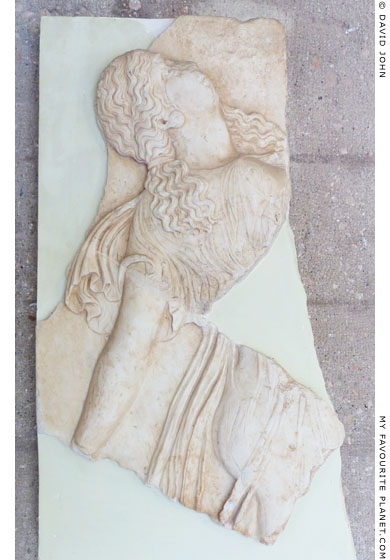
Fragments of a marble relief of a dancing Maenad.
1st century BC. Restored from two fragments excavated
in the Forum of ancient Corinth, one found in the South
Stoa and the other from the Northwest Shops.
Corinth Archaeological Museum. Inv. No. S 2597. |
|
| |
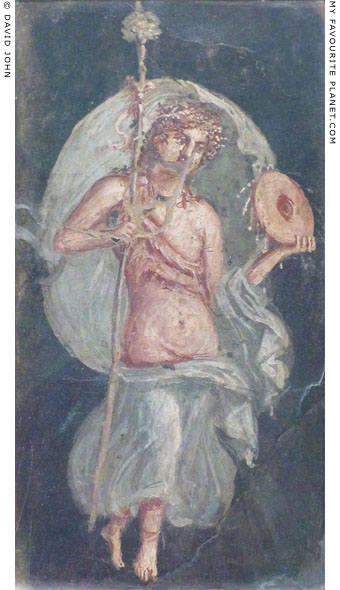
A fresco painting of a dancing Maenad from Herculaneum.
National Archaeological Museum, Naples. Inv. No. 9152.
The Maenad is naked apart from a wreath, a skimpy nebris (animal skin) tied at the right shoulder and covering part of her upper torso and left breast, as well as a diaphanous cloak which is wrapped around her left forearm and legs, with one end floating up behind her back and billowing abover head. In her left hand she carries a thyrsos, and in her left hand she holds what appears to be a cymbal. Although at first it seems that she is standing on tiptoe, her feet are simply hanging down and, as in a number of other paintings of Maenads and other mythological figures found in Herculaneum and Pompeii, she appears to be floating or flying in an undefined space. |
|
| |
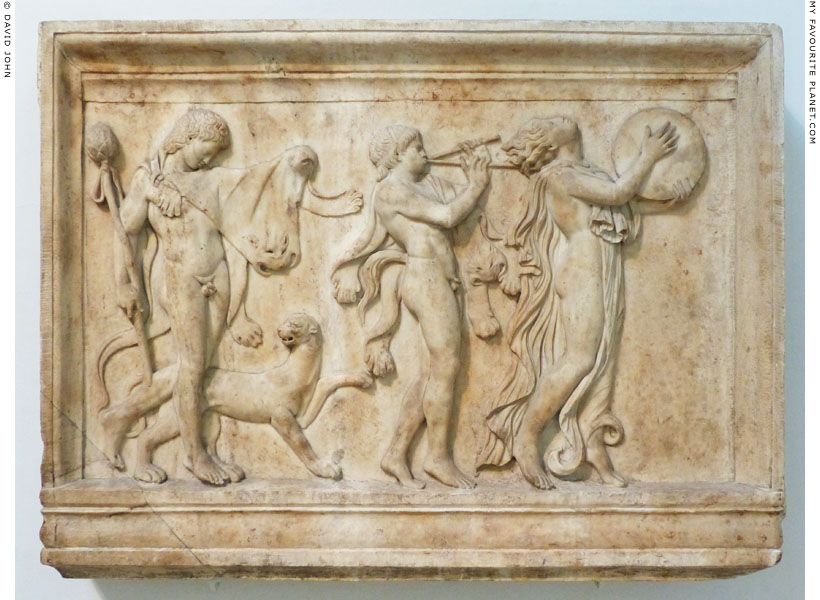
A marble relief depicting Dionysus with a panther, a Satyr and a Maenad in a Dionysiac procession.
Circa 100 AD, based on Greek prototypes of the 4th century BC. Found in 1776 by the Scottish painter, antiquarian
and antiquities dealer Gavin Hamilton (1723-1798) at the Villa Quintiliana on the Via Appia, south of Rome.
Dionysus (left), as a youth, wears a panther skin and carries his thyrsos staff. The Satyr (centre),
also wearing a panther skin, plays an aulos (double pipes), and the Maenad plays a drum (tympanon).
According to the museum labelling, the relief depicts two Satyrs and a Maenad. However, the Satyr
in the centre clearly has a tail, whereas the figure on the left, with the attributes of Dionysus and
slightly larger than the other two figures, does not.
British Museum. Inv. No. GR 1805.7-3.126 (Sculpture 2193). Townley Collection.
An almost identical relief, found in Herculaneum and also dated circa 100 AD,
is now in the National Archaeological Museum, Naples. Inv. No. 6726. |
| |

A Neo-Attic marble relief of a Dionysiac scene from Herculaneum.
Made in a Neo-Attic workshop, first half of the 1st century AD. Height 54 cm, width 108 cm.
Exhibited at the entrance to the Herculaneum archaeological site. Inv. No. SAP 88091.
|
Discovered on 18th February 2009 in the House of the Dionysiac Reliefs (Casa dei rilievi dionisiaci), a luxurious residence of the North-West Insula (Insula I ISAE) of Herculaneum. It is one of the latest discoveries made at the site of the ancient town which was destroyed by the eruption of Vesuvius in 79 AD. The relief had been set into a painted plaster wall of the large triclinium (dining room), as was another marble relief depicting Satyrs, found in the same room in 1997 (Inv. No. SAP 79613). It is thought that there may have been another relief on the the third wall of the room. The fourth wall was open and originally overlooked the sea.
On the left, two female figures stand before an Archaistic statue of Dionysus with a kantharos (drinking cup). One woman places her hand on the shoulder of the other in a protective gesture. The object held by the woman on the left has not been identified (perhaps a torch), but is thought to be connected with a ritual. On the right is a bearded male, probably Dionysus, with his extended right arm raised, facing a dancing Maenad.
Found in the context of the Herculanaeum Conservation Project, an initiative of the Packard Humanities Institute in collaboration with Soprintendenza Speciale per i Beni Archeologici di Napolie Pompei and the British School at Rome. |
|
| |
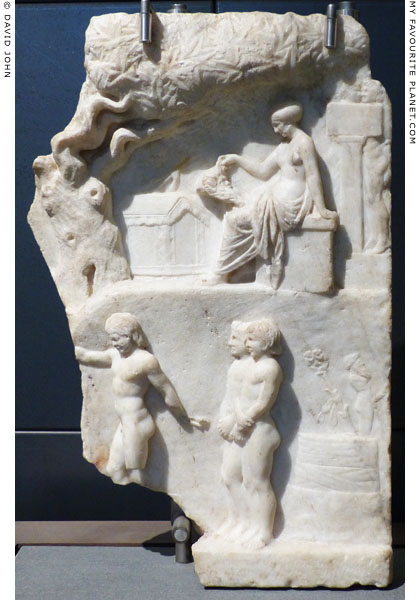
A fragmented marble relief representing a Dionysian initiation scene.
Pentelic marble. Augustan period, 1st century BC, believed to be a copy
of a Hellenistic work of the 2nd century BC. One of a number of fragments
of Dionysiac reliefs from the Horti Maecenatis (Gardens of Maecenas), Rome
(see the relief fragment below). Found in 1876 in the area of the Auditorium
on the Esquiline Hill. Height 66 cm, width 42 cm.
Palazzo dei Conservatori, Capitoline Museums, Rome. Inv. No. Scu 2011.
|
The relief, divided into two registers, has been interpreted as a depiction of the initiation of two children (boys?) into the Dionysian Mysteries at a rural sanctuary. The scene in the upper register takes place beneath the shade of a plane tree with large leaves (in low relief), the gnarled trunk and snake-like branches of which frame the left side of the scene. The tree trunk resembles, perhaps coincidentally, a naked female torso.
In the centre foreground a female figure, perhaps a Muse, is seated facing left on what appears to be an altar. She is naked to the hips, her lower torso and legs are covered by a himation (cloak). Her head is lowered to look at the mask of a bearded male, believed to be Silenos, which she holds in her right hand with the tip of the beard resting on her thighs. To the left is a small temple behind which is a boy holding an aulos (double pipes). To the right is a stele on a pillar (similar to those in the "Ikarios reliefs", see below), which stands on a platform. Behind it two naked young figures stand facing each other, so close together that their faces appear to be touching.
The scene in the lower register is believed to depict part of the initiation ritual itself. On the left, two naked children, standing side-by side and facing left, are led by a young Satyr. The children may themselves be Satyrs. On a very similar relief from the Farnese Collection, now in the National Archaeological Museum, Naples (see below) what appears to be a tail in shallow relief is visible behind the two figures. There does not seem to be a tail on this relief, although as it is currently displayed the area is in shadow and difficult to examine. With their right hands the children hold their left wrists, and their right hands cover their genitals. On the right are symbols of the Dionysian rites: the "cista mystica", the secret chest (kiste) that contained the sacred objects of the Mysteries (see also Demeter and Persephone), above which are a thyrsos and a statuette of Priapus. |
|
| |
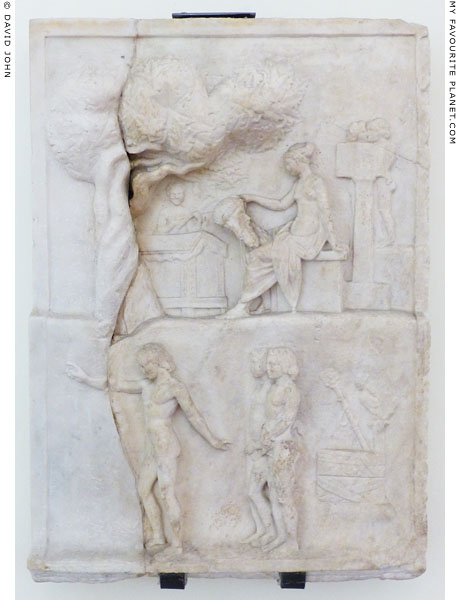
A restored fragment of a marble relief depicting a Dionysian initiation scene,
identical in composition to the relief in the Palazzo dei Conservatori (above).
Provenance unknown. From the Farnese Collection.
National Archaeological Museum, Naples. Inv. No. 27711.
|
The relief has been titled "Sacred love and profane love" (amor sacro e amor profano) or "Voluptus and Virtus" (Voluptas e Virtus). It was believed that the main female figure in the upper register represents Voluptas at a temple of Faun, and the two figures on the right Amor (Eros) and Psyche kissing. The young couple in the lower register were interpreted as Virtue (Virtus), turning their backs on Priapus and following a child in the opposite direction. It is described in Domeniconi Monaco's A complete handbook to the National Museum in Naples (1888 and 1905 editions) merely as "Comic marble bas-relief".
Doubt has been expressed about the authenticity of this relief and it may be a modern forgery. It was in the Farnese Collection, and like the mosaic depicting "Pan and Hamadryad" (see Pan) which may also be a forgery, it was until recently exhibited in the Gabinetto segreto (Secret Cabinet) of the Naples museum. Both works are now displayed in the rooms exhibiting ancient mosaics from Pompeii, Herculaneum and other sites in Campania. So far I have found no further literature on the subject. |
|
| |
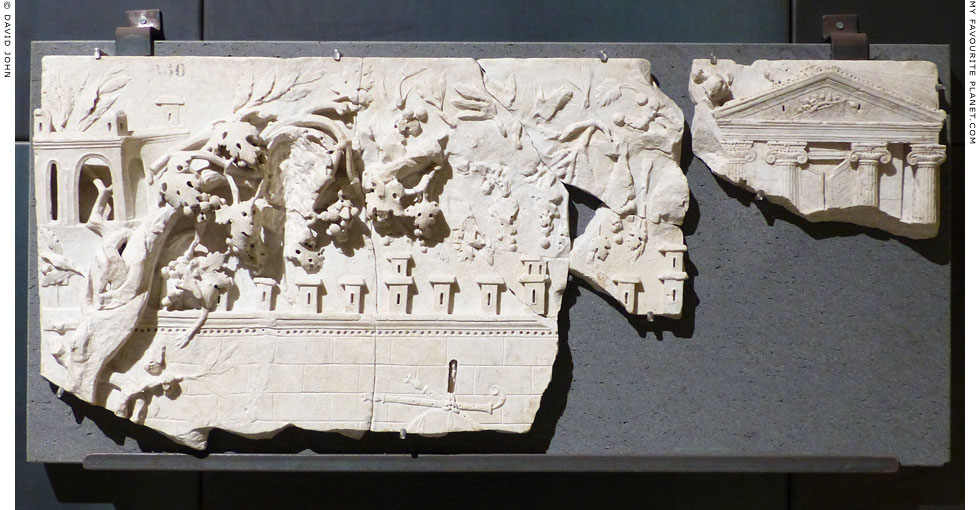
Fragments of a marble relief representing a rural Dionysian sanctuary.
On the left a plane tree covered with a vine stands in front of a wall. One of the tree's
branches grows through a window of a tower on the wall. A statuette stands in a niche
in the wall, from which two pipes and part of another object (a shield?) hang by a
knotted rope. On the right is part of a temple with four Ionic columns and double doors.
Luni marble. 1st century AD. Found in 1875 near the
church of S. Vito, in the area of the Horti Tauriani, Rome.
Palazzo dei Conservatori, Capitoline Museums, Rome. Inv. No. MC 960. |
| |
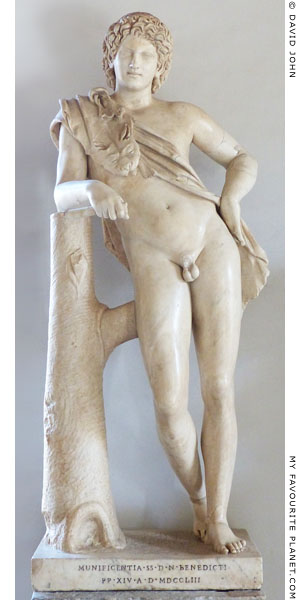
A marble statue of a Satyr in repose,
wearing a nebris and holding a flute,
leaning on a tree stump.
Roman Imperial period, perhaps after a
work by Praxiteles, around 340-330 BC.
Found in the Villa d'Este, Tivoli, near Rome.
Sala del Galata (Hall of the Gaul), Palazzo Nuovo,
Capitoline Museums, Rome. Inv. No. MC 739.
Donated by Pope Benedict XIV in 1753. |
|
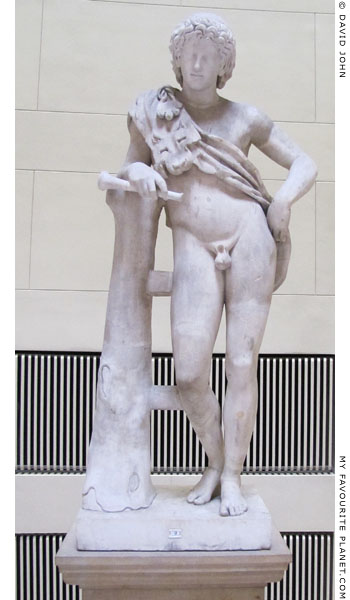
A marble statue of a resting Satyr,
wearing a nebris and holding a flute,
leaning on a tree stump.
Roman Imperial period, 2nd century AD,
perhaps after a work by Praxiteles,
around 340-330 BC. Height 183 cm,
width 78 cm, depth 47 cm.
Altes Museum, Berlin. Inv. No. Sk 258.
The ancient torso is said to have been found at the
Palazzo Sessoriano, Rome, probably in 1743 during
the rebuilding of the S. Croce in Gerusalemme church.
Purchased in 1766 by the art dealer Giovanni Ludovico
Bianconi, acting as an agent for King Friedrich II of
Prussia (Frederick the Great). It was restored soon
after by Bartolomeo Cavaceppi, who added an
unrelated head from a different statue type.
Transported to Berlin, it was set up before 1772 in
the Half Rondel, in the gardens of the Neues Palais,
Sanssouci, Potsdam, along with a number of other
statues. In 1825 it was further restored by Christian
Daniel Rauch (see Demeter part 2), who added the
head, lower left arm and right leg and other parts.
At first it was described simply as a "Bacchic Faun".
On 3 May 1828 it was set up among other restored
ancient statues of Greek and Roman deites and
mythological figures around the Rotunda, the grand
entrance hall of Berlin's Royal Museum (Königliche
Museum, later renamed the Altes Museum), where
it was given the title "Faun Praxiteles". A copy of the
statue by Eduard Stützel was set up at Sanssouci
in 1853 to replace the original. |
|
| |
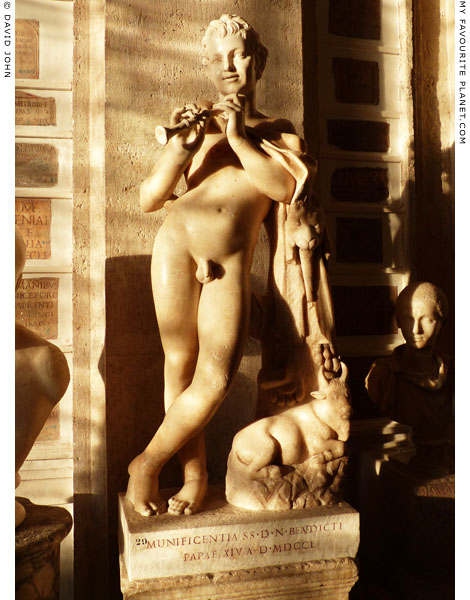
A marble statue of a Satyr wearing a nebris (panther
skin) and playing a flute. An ox sits at his feet.
Roman Imperial period variation of a Greek 4th century BC
original attributed to Praxiteles. Parian marble. Height 129 cm.
Found in 1749 in the Vigna of the Padri del SS. Cosma e Damiano,
on the Aventine, Rome. The restorations include the head, the
right forearm, both hands and the flute, parts of the nebris,
the horns and left ear of the ox, and the edges of the plinth.
Twenty statues of this type are known, and it appears on Roman
Imperial coins of Caesarea Paneas in Syria. In 1764 the German
art historian Johann Joachim Winckelmann wrote that there were
over thirty ancient statues of young Satyrs or Fauns of various
types in Rome, and remarked "The most beautiful Faun statues
are an image of mature beautiful youth in perfect proportion"
(Geschichte der Kunst des Alterthums, The history of art in antiquity,
1764, page 158).
Palazzo Nuovo, Capitoline Museums, Rome. Inv. No. MC 295.
The Latin inscription on the base states that the statue was
donated to the museum by Pope Benedict XIV in 1750. |
|

The "Faone di Campidoglio", a marmo rosso antico
(red marble) statue of a "Faun" (Satyr), wearing a
nebris, standing next to a goat. Also included are
several cult objects associated with Dionysus and
Pan: bunches of grapes, a lagobolon, syrinx (pan
pipes) and the cista mystica (sacred kiste).
Roman Imperial period, 2nd century AD, after
a late Hellenistic original. Found in 1736 in
Hadrian's Villa, Tivoli, near Rome, during
excavations by Giuseppe Alessandro Furietti
(1685-1764). Restored 1744-1746 by Bartolomeo
Cavaceppi and Clemente Bianchi. Height 167.5 cm.
Sala del Fauno (Hall of the Faun), Palazzo Nuovo,
Capitoline Museums, Rome. Inv. No. MC 657.
Donated by Pope Benedict XIV in 1746.
In terms of style and use of exotic, expensive
marble, the statue is similar to two Centaurs
in dark grey Bigio Morato marble, signed by
Aristeas and Papias of Aphrodisias, also found
in 1736 in Hadrian's Villa at Tivoli, and now
exhibited in the Salone (Great Hall), the next
room in the Palazzo Nuovo. See the photos
under Aristeas and Papias of Aphrodisias. |
|
| |
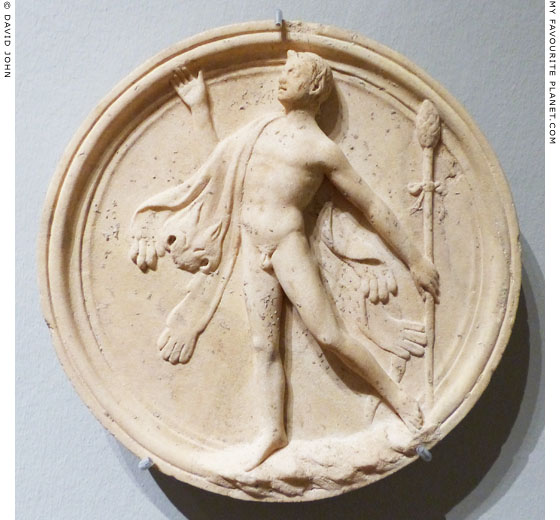
A marble oscillum with a relief of a naked dancing Satyr with a panther skin
draped over his right shoulder and holding a thyrsos in his left hand.
End of the 1st century AD.
Museum für Kunst und Gewerbe Hamburg. Inv. No. 2001.684.
Purchased with funds from the Campe'schen Historischen Kunststiftung. |
| |
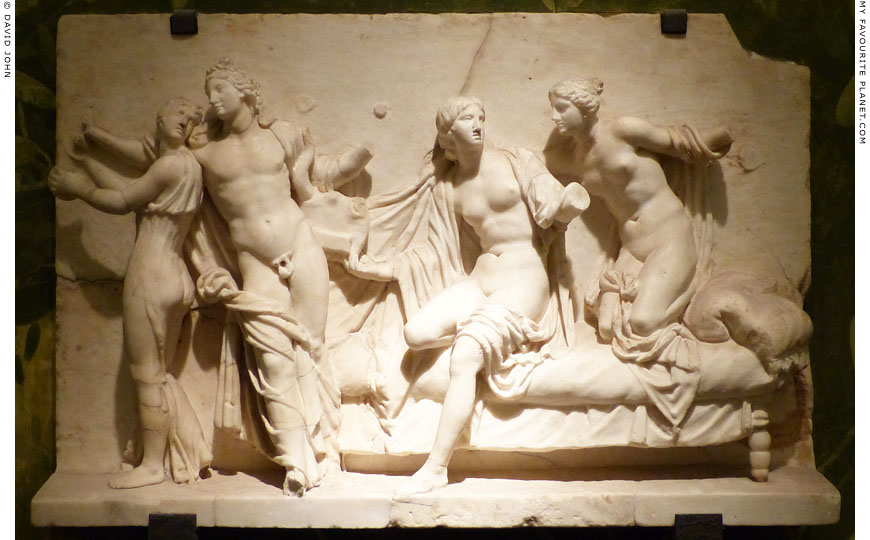
The so-called "Alcibiades among the hetairai", a marble relief which may depict either drunken
Dionysus with three women (Seasons, Maenads?), or Apollo with Muses. Two of the females
kneel on a couch or bed, and one holds onto the bottom of the lyre held by the male.
"Roman period copy of a Hellenistic original". Height 45 cm, width 53 cm.
National Archaeological Museum, Naples. Inv. No. 6688.
Gabinetto segreto (Secret Cabinet). From the Farnese Collection. |
| |
|
| |
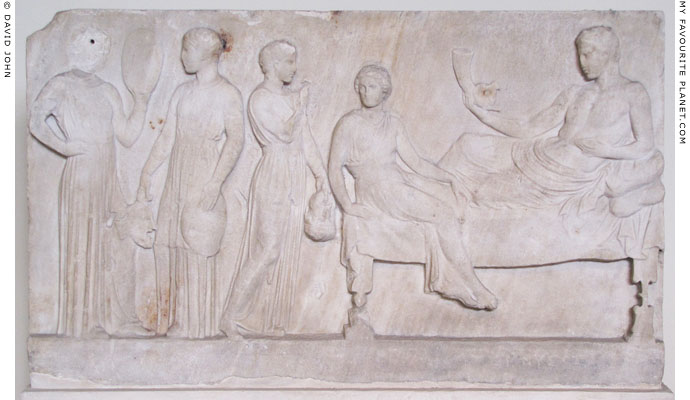
Dionysus (seated, right) on an inscribed marble votive relief found in Piraeus. Dedicated
to to the god by actors after a theatrical performance, possibly Euripides' Bacchae.
Circa 400 BC. Foumd in the sea in Piraeus harbour in 1881.
Height 55 cm, width 94 cm, thickness 9 cm. Dionysus sits on a kline (couch), holding a rhyton (drinking horn) and phiale (libation bowl).
A woman, Paideia (Παιδεία), sits at the foot of the kline with her face turned towards a man
holding a theatrical mask. On the left stand two actors, one holding a tympanon (hand drum),
the other a mask and a tympanon. Most of the dedicatory inscription written acrros the lower
ledge of the stele is very faint, and the names of Paideia and Dionysus are barely visible.
National Archaeological Museum, Athens. Inv. No. 1500. |
| |
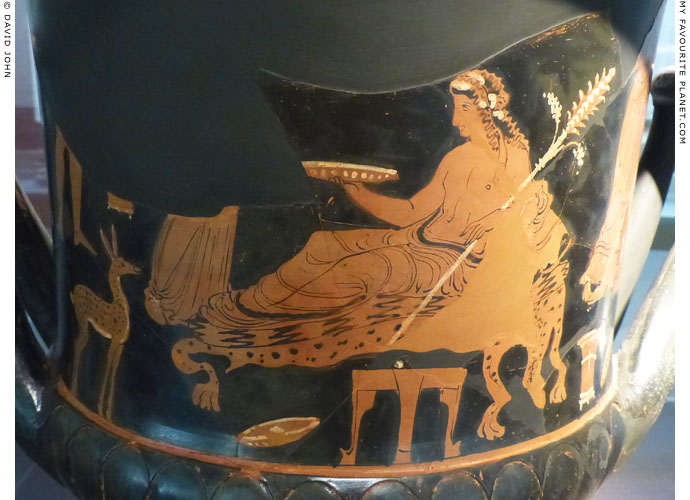
Detail of the B side of the "Parthenopaios krater" (see below), a fragmentary Apulian
red-figure calyx krater, showing Dionysus reclining on a kline (couch) covered with
a panther skin. He holds a thyrsos with his left arm, and a phiale (libation bowl) in
his raised right hand. A fawn stands at the foot of the kline, and parts of a Satyr
and two unidentified female figures can be seen standing around the god.
Attributed to the Lycurgus Painter, mid 4th century BC.
Provenance unknown. Height 61.5 cm, maximum diameter 56 cm.
Civic Archaeological Museum, Milan. Inv. No. A 0.9.1872 (St. 6873).
Purchased at an auction, 1963. |
| |
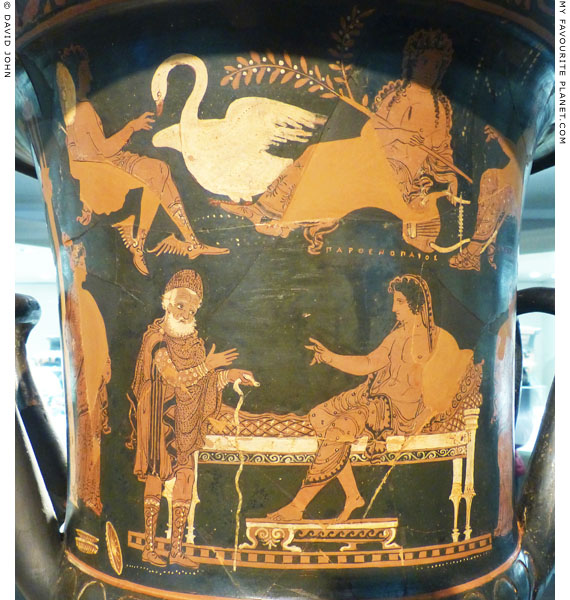
The main side of the "Parthenopaios krater" thought to depict a drama
based on the mythical Theban war known as the "Seven Against Thebes".
|
Some of the figures are identified by inscriptions. In the lower register Parthenopaios (named Παρθενοπαῖος), the handsome young hero from Argos or Arcadia who was one of the seven leaders of the ill-fated military expedition against Thebes, sits on a kline. He talks with an unnamed elderly man with a white beard and walking stick. Some scholars believe he may be Adrastos (Ἄδραστος), the king of Argos who organized the expedition, or perhaps Tiresias (Τειρεσίας), the prophet of Apollo who persuaded Parthenopaios to join it. On the right stands the heroine Atalanta (Ἀταλάντα), Parthenopaios' mother, and on the left an unnamed female figure.
Above them in the top register sit three gods (left to right): Hermes, holding a kerykeion (caduceus), wearing winged boots and with a petasos (sun hat) hanging behind his head; Apollo, holding an olive branch and a lyre, and with a swan at his feet; Ares, the god of war, bearded and holding a spear. The deities are not mere spectators but intervene in the unfolding story of the Theban war.
The tableau is thought to represent a dramatic performance based on comparison with other vase paintings of theatrical scenes, particularly the gestures and clothing of the figures. The dais on which the kline stands is thought to represent a theatre podium, and the columns at each end of the picture area parts of the stage scenery. It has been suggested that the three gods are sitting on a theatrical theologeion (raised platform) above the mortal characters.
This scene is not known from any known ancient literary source or other work of art. The story of the "Seven Against Thebes" is thought to have been first written in the Thebaid, one of the four lost epic poems known as the Theban Cycle, written around 750-500 BC. Parthenopaios' part in the Theban war is known from the plays Seven against Thebes by Aeschylus, produced in 467 BC, and The Phoenician women by Euripides, written around 408 BC.
Two 4th century BC Athenian tragic playwrights named Astydamas (Ἀστυδάμας), father and son, are said to have written plays titled Parthenopaios. The inscribed base of a seated bronze statue of the younger Astydamas (Astydamas II), erected after his tragedy Parthenopaios won first prize at the Dionysia festival in 340 BC, has been found at the western parados retaining wall Theatre of Dionysos in Athens (Inv. No. NK 302, inscription IG II (2) 3775). The victory is also known from an inscription with a list of winners, now in the Epigraphical Museum, Athens, Inv. No. 8226/7 (inscription IG II (2) 2320). |
|
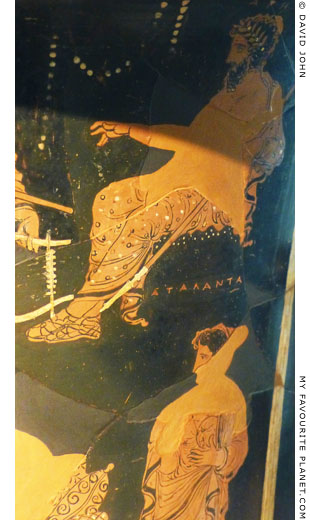
Ares above Atalanta on the right of the
main scene on the "Parthenopaios krater". |
|
| |
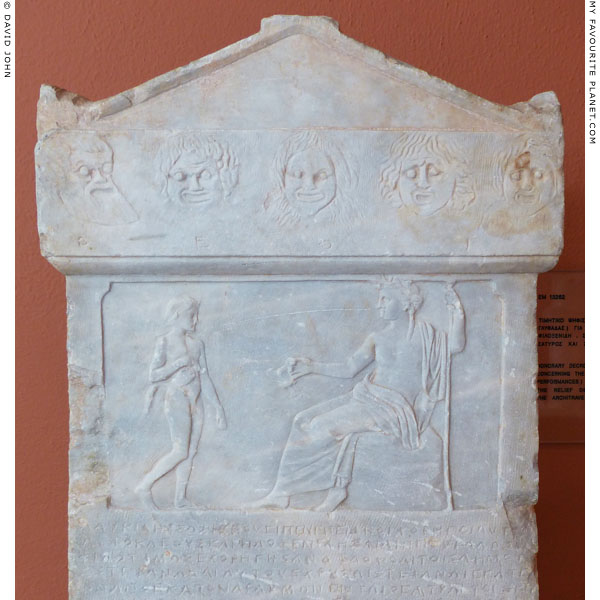
Detail of an inscribed marble stele with a relief depicting Dionysus and a Satyr.
313-312 BC. Found in 1941 in Glyphada (Γλυφάδα), on the coast southwest
of central Athens. Height 96 cm, width (top-bottom) 36-40 cm.
Epigraphical Museum, Athens. Inv. No. 13262.
Inscription AM 66 (1941), 218-219, No. 1 (= SEG 36.186).
|
The top of the tapering stele of grey marble is in the form of a naiskos (small temple), decorated with low reliefs. On the architrave is a row of five theatrical masks. The left-most head is shown in three-quarter view, and is quite different in style from the other four frontal comedy masks of a more conventional type, as seen on other representations of the Hellenistic and Roman periods. It depicts a mature male with short hair and a long beard (a god, silen, philosopher or playwright?).
Within the naiskos, framed by the profiles of two Doric columns, Dionysus sits on a rock to the right, facing left, wreathed and wearing a himation, holding in his left hand his thyrsos, which appears to bend under the weight of the god's arm. In his outstretched right hand he holds out a kantharos (wine cup) to an adolescent Satyr who approaches him from the left, carrying an oinochoe (wine jug) in his right hand.
The 13 line inscription below is a decree of the Attic deme of Aixone (Αἰξωνή, the area of modern Glyfada) concerning Auteas, son of Autokles (Αυτέας Αυτοκλέους) and Philoxenides, son of Philppos (Φιλοξενίδης Φιλίππου), two choregoi (sponsors of theatrical performances, see Athens Acropolis gallery page 35). They are honoured for having performed their choregic duties well (καλῶς, kalos) and with a sense of love for honour (φιλοτίμως, philotimos). The citizens of the deme decided to award them each a golden crown worth 100 drachmas, to be presented in the theatre at the comedy competition during the next year's Dionysia festival. At the bottom of the stele, below the inscription, are two reliefs of crowns (wreaths).
The mention of Theophrastos (Θεόφραστος) as Athenian archon has caused some debate about the dating of the decree. Archons served for one year, and there were two of this name during the 4th century BC, in 340/339 and 313/312. The latter date has become generally accepted.
The Greek text of the inscription:
epigraphy.packhum.org/text/294170 at the Packard Humanities Institute. |
|
| |
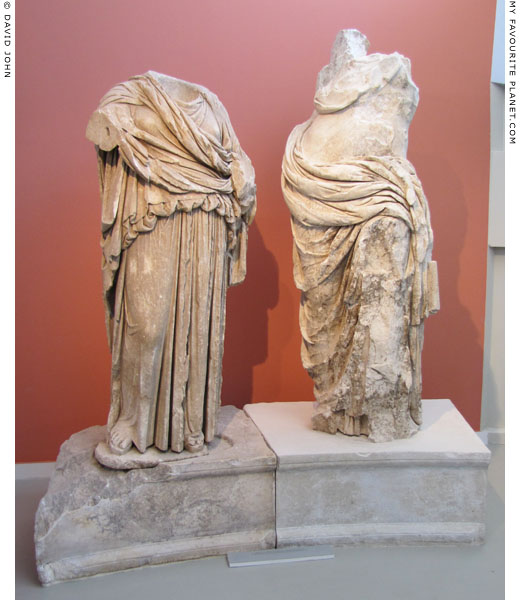
Fragmentary marble statues of Dionysus (right) and
a female figure, probably a Muse, wearing a peplos.
Early 3rd century BC. From a choragic monument which stood on
a semi-circular exedra in the West Monument of the sanctuary of
Dionysus, in the city of Thasos (Θασος), Greece. Dionysus,
Inv. No. 1473, height 220 cm excluding plinth. Muse, height 182 cm.
Thasos Archaeological Museum.
|
The Dionysion (το Διονύσιον), the sanctuary of Dionysus in Thasos, east of the city's agora, was a small area with a triangular enclosure wall (see photo below), containing two choregic monuments. The other choragic monument (the East Monument) was built in the form of a Doric temple, inside which was a statue group on a semi-circular exedra, depicting Dionysus (see the head above) flanked by eight smaller statues of allegorical figures representing personifications of theatre genres. The names of four of the figures are preserved on an inscription on the base of the exedra: Comedy, Tragedy, Dithyramb and Nykterinos. The inscription also names the actors and musicians of the performing group which was awarded the choragic prize.
The theatre of Thasos is on the acropolis, southeast of the harbour (see photo below).
See the Choragic Monument of Nikias and the Choragic Monument of Thrasyllos in Athens for information about choragic monuments. |
|
| |
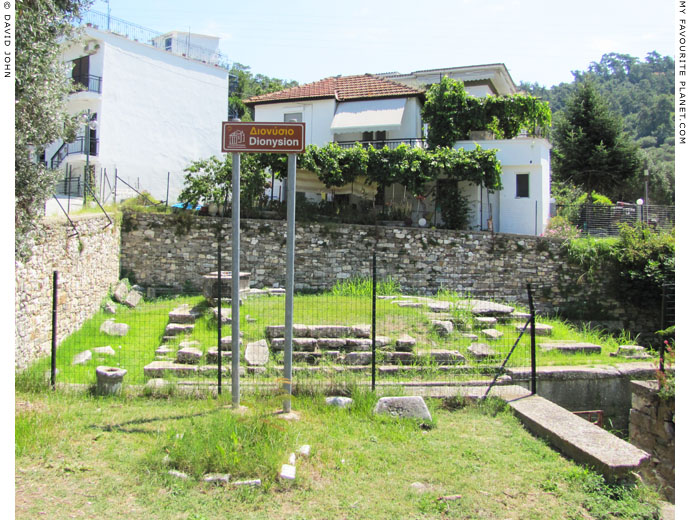
The archaeological site of the Dionysion in Thasos. |
| |
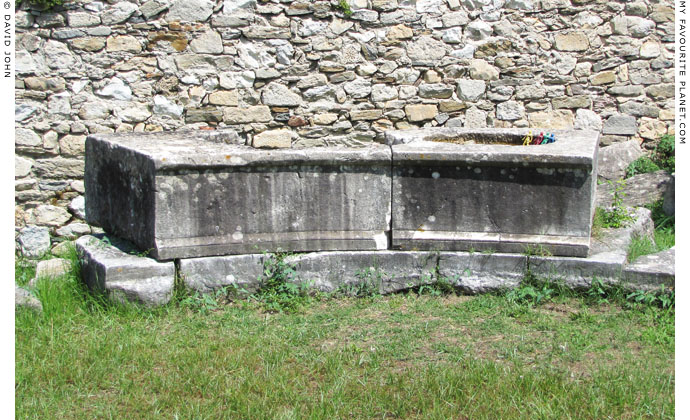
The remains of the exedra base of the West Monument,
in archaeological site of the Dionysion, Thasos. |
| |
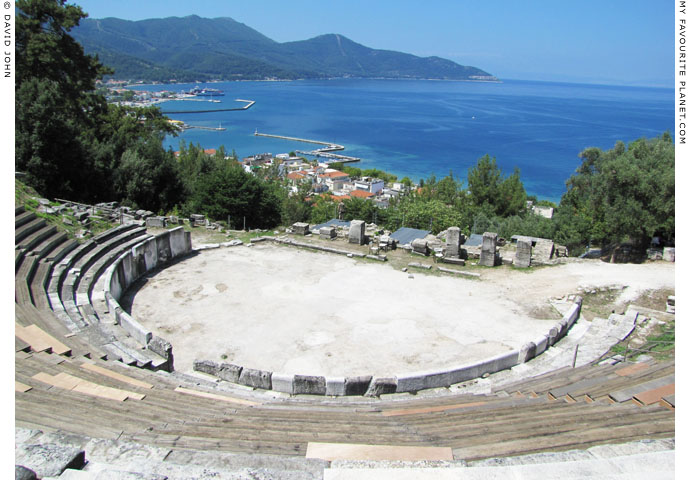
The restored ancient theatre on the acropolis of Thasos, overlooking Thasos town
(Θάσος), also known as Limenas (Λιμένας Θάσου, Limenas Thasou, Harbour of
Thasos), on the north coast of the Northern Aegean island.
|
The theatre's semi-circular cavea (audience seating area) was built in a natural depression, between 60-80 metres above sea level, on the steep slope of the hills to the south east of the harbour, within the ancient city walls. According to Hippokrates (Epidemiai, 1, 20) the theatre already existed in second half of the 5th century BC. However, no archaeological evidence from this time has yet been discovered, although remains from the Archaic period have apparently been found in the area of the much later skene (σκηνή, literally tent or hut) stage building.
The marble skene in the Doric style was erected in the early third century BC behind the semi-circular orchestra (ὀρχήστρα, dancing place, performing area). Although little now remains on the site of this Hellenistic building, fragments of the architrave of the proskenion (proscenium, front facade of the skene) have survived, with triglyphs and metopes with low reliefs of mythological scenes, and an inscribed dedication to Dionysus by the Thasian Lysistratos son of Kodis (inscription IG XII, Supplement 399). These are now in the Istanbul Archaeological Museums. Originally the facade consisted of a row of 12 Doric columns with a pilaster at each end.
In the first century AD, during the early Roman Imperial period, the orchestra was converted into an arena for shows featuring combat between humans and wild animals and gladiatorial contests.
See Guide to Kavala, page 5.
For further information about the parts of ancient
Greek theatres see Athens Acropolis page 36. |
|
| |
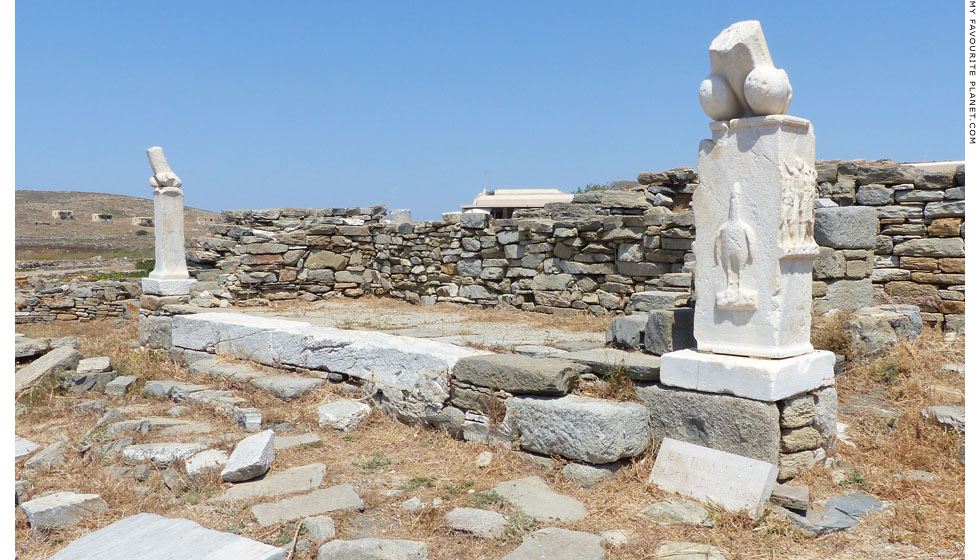
The remains of the temple of Dionysus, known as the Stoibadeion, Delos.
Delos Archaeological Site, Greece.
|
The small temple or shrine of Dionysus in Delos, also known as the Exedra of Dionysus, or Stoibadeion (Στοιβάδειον), is a rectangular platform which contained a statue group of enthroned Dionysus flanked by two actors dressed as Papposilenos (see photos below). The statues are now in the Delos Archaeological Museum. On either side of the exedra is a marble monument consisting of an enormous marble phallus on a rectangular base.
According to an inscription, the phallus on the right (south) was dedicated to Dionysus around 300 BC by a certain Karystios (Καρύστιος) who sponsored a prize-winning theatrical performance. Three sides of the base are decorated with Dionysian reliefs (see photo, right). The very worn relief on the left side shows Dionysus, probably drunk, supported by Pan or a Satyr carrying a lagobolon (hunting stick, see Pan). At the front of the base is a cockerel with a phallus in place of a head and neck. The exedra was built next to this monument during the 2nd century BC, and a second phallus monument was placed at its left side.
The phallus symbol is often seen in association with the cult of Dionysus, as a god of fertility and sexuality, despite the fact that he is depicted, as here, in such a state of inebriation that he is incapable of even standing without the assistance of members of his thiasos. |
|

Relief on the right side of the base of right-hand
phallus monument outside the temple of Dionysus,
Delos, depicting Dionysus naked (centre) with
a Maenad (right), and a small Silenos. |
|
| |
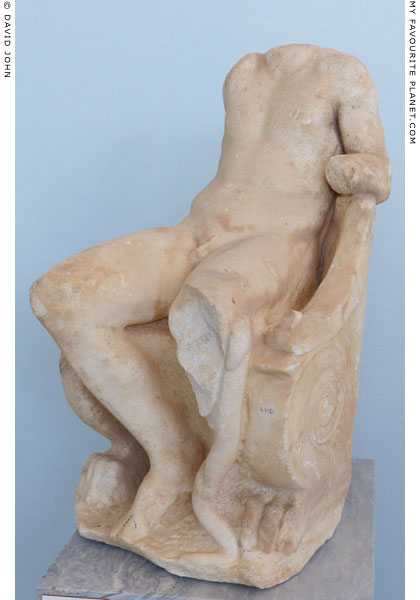
Marble statue of enthroned Dionysus, from
the Stoibadeion, Delos. 150-100 BC.
Delos Archaeological Museum. Inv. No. A 4121. |
| |
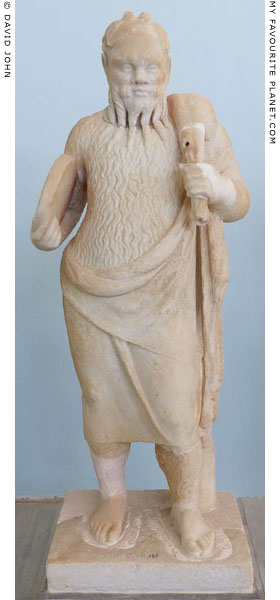 |
|
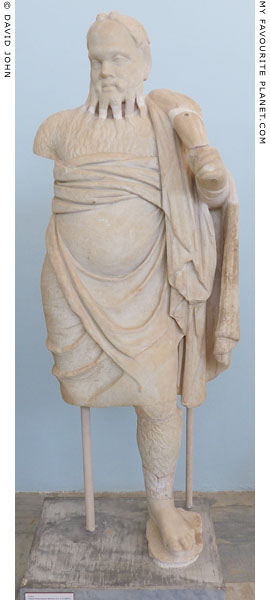 |
The two marble statues of Papposilenos actors, found
in 1904 in the Stoibadeion, Delos. 150-100 BC.
Delos Archaeological Museum. Inv. Nos. A 4122 and A 4123.
|
|
| |
Each of the statues depicts an actor dressed as Papposilenos, wearing a mask with a long braided beard, a "hairy" sheepskin costume covering the torso, arms and legs, over which is a himation (cloak), draped over the left shoulder and wrapped around the body. Each carries a wineskin over his left shoulder, and the figure on the left, 120 cm high, holds a tympanon (hand drum) in his right hand.
Silenos (Σειληνός, Seilenos; Latin, Silenus), was the oldest of the Silens, the tutor of Dionysus, in whose cult Greek theatre developed. He led the god's thiasos. He is also referred to as Papposilenos (Παπποσειληνός, Father Silenos), particularly in the context of the theatre.
Such statues of Papposilenos have been compared to portraits of the Athenian philosopher Socrates (Σωκρᾰ́της, circa 470-399 BC), particularly the high forehead, facial features, short, snubby nose and beard (see photo, right).
See also:
A statue of an actor as Papposilenos holding the infant Dionysus from Delos, above;
A mosaic depicting Dionysus riding a tiger from Delos, above. |
|
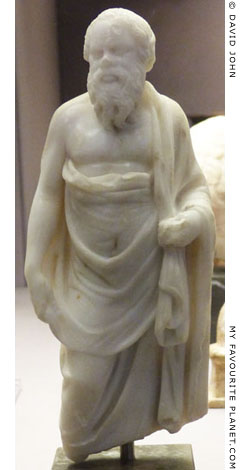
Marble statuette of Socrates
wearing a himation.
Either a Hellenistic original of the
2nd century BC or a Roman copy.
Said to be from Alexandria.
Height 27.5 cm, width 11.5 cm,
depth 8 cm.
The "Type B" statuette follows the
later idealized model of the two
types of portraits of Socrates.
British Museum.
Inv. No. GR 1925.11-18.1.
Purchased 1925 from the German
collector and dealer Jacob Hirsch. |
|
| |

One of several surviving marble statues
of Papposilenos, from the Roman period
skene (stage building) of the
Theatre of Dionysos, Athens.
1st or 2nd century AD.
Height 150 cm, width 63 cm.
Theatre of Dionysos, Athens.
Inv. No. NK 2295. |
|
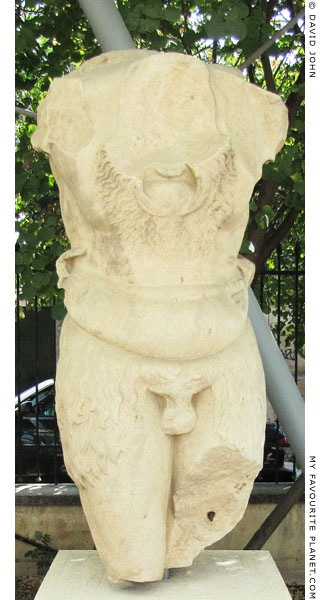
Colossal marble statue of a naked
Papposilenos, probably in the pose of Atlas.
From the Roman period skene of
the Theatre of Dionysos, Athens.
1st or 2nd century AD.
Theatre of Dionysos, Athens.
Inv. No. NK 2302. |
|
| |
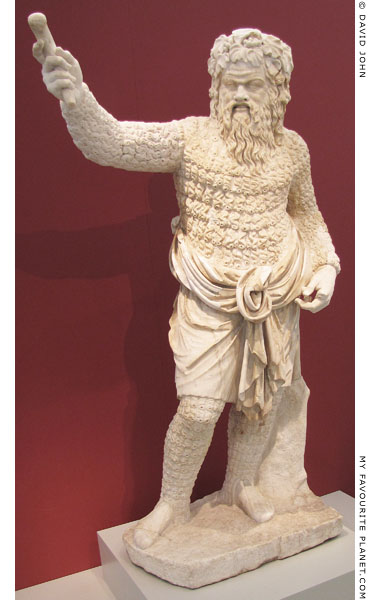 |
|
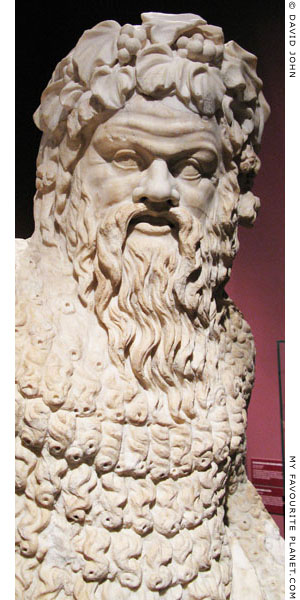 |
Marble statue of an actor dressed as Papposilenos.
Around 100 AD. Thought to be a copy of a 4th century BC original. From the
Quirinal Hill, Rome. Pentelic marble. Height 168 cm, width 98 cm, depth 55 cm.
Altes Museum, Berlin. Inv. No. Sk 278. Purchased in 1866 from the Gentili Collection.
|
|
The figure wears a mask, a "hairy" sheepskin costume and a himation tied around his waist. In his raised right hand he holds part of a lagobolon, a short hunting stick, curved like a walking stick at one end, used for throwing at hares (also an attribute of Pan).
It was found in 1739 together with two statues of boxers (one described as being in the Palazzo Albani, Rome and the other in the Louvre) behind the Palazzo Gentili, on the northwest slope of the Quirinal Hill, Rome. In 1866 Wolfgang Helbig (1839-1915) purchased the restored statue for the Berlin museum from the Gentili Collection for 250 scudi. It was further restored 2005-2006 prior to the special exhibitions "Deuses Gregos: Coleção do Museu Pergamon de Berlin", Sao Paulo und Rio de Janeiro, Brazil, 2006, and "Die Rückkehr der Götter - Berlins verborgener Olymp", Pergamon Museum, Berlin, 2008-2011. Since 2011 it has been on permanent display in the Altes Museum. |
|
| |
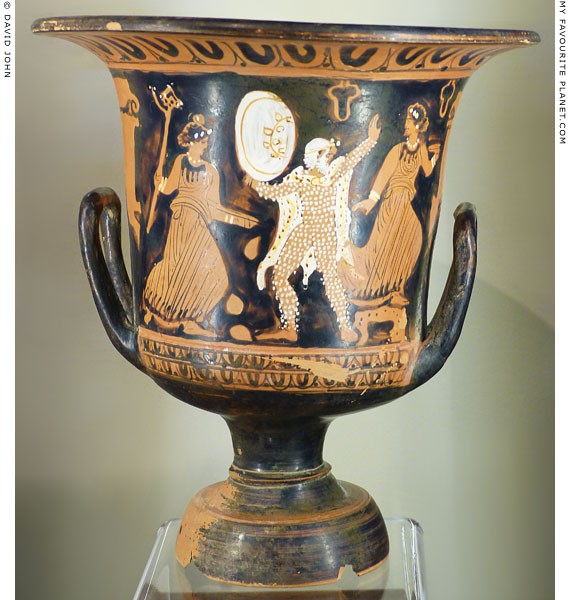
Actors playing Papposilenos with two Maenads on a red-figure krater.
4th century BC. From Thebes, Boeotia, central Greece.
Thebes Archaeological Museum. |
| |
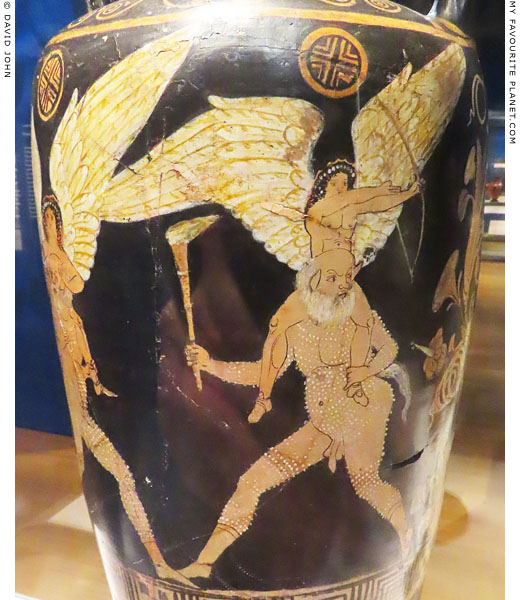
A comic scene from a Satyr play on the body of a Campanian red-figure amphora.
One side of the vase shows two costumed Silens running towards each other,
each carrying a winged Eros figure on his shoulders. This silen carries a torch
while the Eros pulls at the string of a bow. The other other Eros holds a torch.
The other side of the vase has a painting of a scene from a tragedy.
From Campania, southwestern Italy, 330-320 BC.
Rijksmuseum van Oudheden, Leiden. From the collection of Stadholder William V. |
|

A terracotta figurine of an actor
wearing a mask and the costume
of Papposilenos.
From Patras, northwestern
Peloponnese, Greece.
2nd century AD.
Patras Archaeological Museum. |
|
| |

Small gold sheets with hammered theatrical masks.
Around 50 AD. From Kerameikos (T y1), Athens.
Kerameikos Archaeological Museum. |
| |
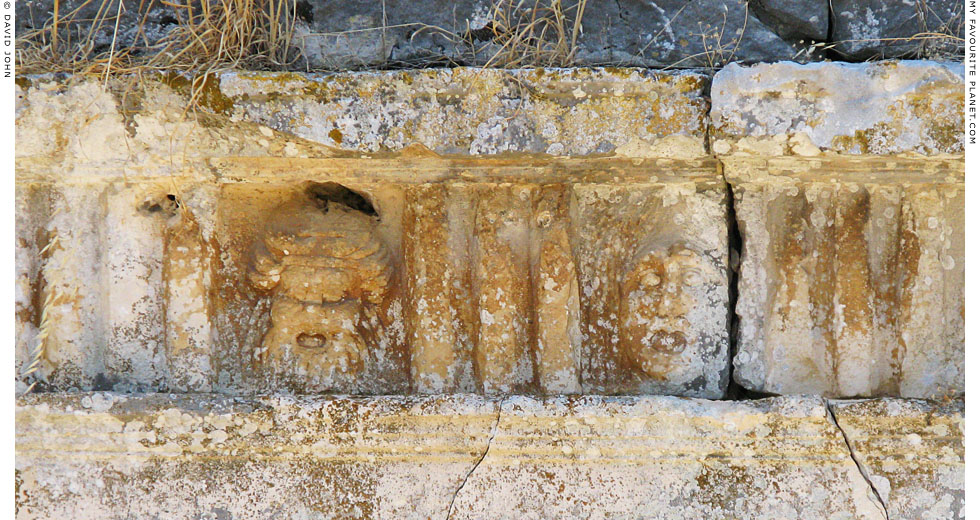
Reliefs of theatrical masks on metopes of a marble Doric frieze above the
outside of the vaulted tunnel entrance (parados), at the north side of the
Hellenistic theatre in the Sanctuary of Leto, Letoon, Lycia. Around 100 BC.
On the left is a mask of Dionysus, on the right a tragic mask.
|
Letoon (Λητῶον) is the site of an ancient Lycian sanctuary, at the village of Kumluova, in the Fethiye district of Antalya Province, southwestern Turkey. It is about 3 kilometres east the present coastline, and 1 km west of the Xanthos River (Eşen Çayı). The archaeological site is just off the national highway D400, 46 km (as the crow flies; 63 km by road) south of Fethiye, around 4 km (6 km by road) south of ancient Xanthos (Ξάνθος), the capital of the Lycian League, and 14 km (18.6 km by road) northwest of ancient Patara (Πάταρα).
The broad, fertile plain around Kumluova is prone to waterlogging due to the nearby river, and in winter and early spring parts of the Letoon are submerged. Despite its proximity to Fethiye, the growing tourist resort of Kaş (see Kastellorizo), and the increasingly popular Xanthos archaeological site, Kumluova and Letoon still feel quite isolated, and visited by far fewer tourists than Xanthos or other Lycian sites. There is no public transport from Kaş or Xanthos, although infrequent dolmuş minibuses run to and from Patara, where there are connections to Kaş.
Lycia is a mountainous area dotted with plains at the southwest corner of Anatolia (Asia Minor), where the Aegean Sea meets the Mediterranean. The Lycians were a fiercely independent people, with their own distinct culture, language and alphabet, who had resisted the aggressive expansion of other cultures such as the Hittites, Greeks, Lydians and Persians.
It was ruled by the Persians following the conquest of the Lydian empire in 547-546 BC, and the Lycian cities surrendered to Alexander the Great in 333 BC. After Alexander's death in 323 BC, the control of Lycia was contested by his successors (the Diadochi), finally coming under the rule of the Ptolemies of Egypt, then the Seleucids. In 177 BC it was occupied by Rhodes, but given its freedom by the Romans in 167 BC.
The sanctuary later known as the Letoon was the religious centre of the Lycians, and during the Archaic and Classical periods, 7th - 5th century BC, it was probably dedicated to the cult of the ancient Lycian mother goddess Eni Mahanahi. During the Hellenistic period, due to the increasing Greek influence on Lycian culture, the sanctuary was dedicated to Leto, the mother of Apollo and Artemis by Zeus. In Greek mythology, the pregnant Leto rested here while fleeing from the vengeance of Hera, the jealous wife of Zeus. According to one interpretation of the mythical tales, Apollo and Artemis were born here, although Delos and Ephesus also claimed to be their birthplace.
Letoon was destroyed by the Romans in 42 BC, but rebuilt during the Roman Imperial period, and further buildings were added during the reign of Emperor Hadrian (117-138 AD), who made it a centre of the cult of emperor worship.
The Hellenistic theatre, which was used for religious performances, is at the north of the sanctuary, at the end of the road from Xanthos, and near an ancient cemetery. Temples of Leto, Artemis and Apollo stood close together, side by side at the sanctuary's centre, and to the south was a sacred spring, pool or lake, where a Hellenistic nymphaeum was extended with the addition of a semicircular pool during the Roman period. There was also a sacred grove, and the constellation of temples, grove and lake are comparable with those at the sanctuary at Delos.
A Byzantine church was built in the 5th or 6th century AD to the east of the nymphaeum, using stones from the temples. Letoon appears to have been abandoned in the 7th century, probably due to the Arab raids in the area, and gradually became a swamp, covered by mud and silt from the Xanthos River.
In the early 19th century the British traveller, antiquarian and topographer Colonel William Martin Leake (1777-1860) estimated the location of Letoon, and the archaeologist Charles Fellows (see above), who had discovered Xanthos in 1838, attempted to visit it on 17th April 1840, but was thwarted by the high water levels of the swamp. However, in March 1841 Richard Hoskyn (1811-1873), the master of the British navy ship HMS Beacon, on a cartographic mission along the Lycian coast, was able to reach the site on his way to Xanthos. He reported seeing the theatre, foundations of a temple and some sarcophagi at the silted-up sanctuary.
"I found a large theatre in very good preservation, built in the side of a low detached hill. Near it on the plain are the foundations of a temple, probably the temple of Latona [Leto]. A few sarcophagi are scattered about. The theatre is of rather unusual construction, the sides being parallel, as in the theatres of European Greece; the proscenium has quite disappeared; over the north vomitorium are some bas-reliefs of faces, representing laughter and grief in various stages."
Richard Hoskyn, Narrative of a survey of part of the south coast of Asia Minor; and of a tour into the interior of Lycia in 1840-1; accompanied by a map. Journal of the Royal Geographical Society, Volume 12, pages 143-161. John Murray, London, 1843. At the Internet Archive.
The theatre, built around the late 2nd to early 1st century BC, was carved out of the natural rock of a low hill, but the two ends of the retaining walls which support the 36-row cavea (audience seating area), built of ashlar masonry, are free-standing (see middle photo, right). It was restored and perhaps enlarged during the Roman Imperial period, possibly during the reign of Hadrian. During the 1990s French archaeologists uncovered the foundations of the skene (stage building). Curiously, the theatre is oriented with the cavea facing northwest and away from the centre of the sanctuary.
The frieze above the northern vomitorium (the Latin name for the entrance/exit of a theatre; Greek, parados, πάροδος), runs along the top of a lintel above the outside of the vaulted tunnel through the retaining wall on the north side (see top photo, right). The 17 triglyphs have no architectural function and are purely decorative, imitating the entablature of a Classical Doric temple. Between the triglyphs are 16 metopes with reliefs of heads and masks, with 7 motifs. The two metopes in the photo above are numbers 1 and 2, on the left (east) end of the frieze.
• 3 masks of bearded Dionysus (metopes 1, 10, 16)
• 3 tragic masks (2, 6, 11)
• 3 bearded male faces (3, 7, 13)
• 1 comic mask of an old woman (4)
• 2 faces of beardless youths (5, 12)
• 2 Satyrs heads (8, 14)
• 2 bald, bearded Silens (9, 15)
The Doric facade of the vaulted tunnel entrance to the south side of the theatre (see bottom photo, right), facing the temples in the centre of the sanctuary, is larger, better built and better preserved. It has a similar frieze but the metopes are undecorated.
Fellows was finally able to make a short visit Letoon in December 1841, on his way up to Xanthos by river. Over the next century the sanctuary was seldom visited or mentioned, although the first photographs and lengthy description of the site, particularly the theatre, were published by Otto Benndorf and George Niemann in 1884.
See: Otto Benndorf and George Niemann, Reisen im südwestlichen Kleinasien, Band I: Reisen in Lykien und Karien, pages 118-124. C. Gerold's Sohn, Vienna, 1884. At the Internet Archive.
In 1962 the French Archaeological Mission, which had begun excavations at Xanthos in 1951, extended their work to Letoon, where they continued excavating and restoring the site over the next five decades, with a number of areas, particularly to the south of the sanctuary, still to be excavated. In 1988 Xanthos and Letoon were selected jointly as a UNESCO World Heritage site. However, in 2011 a controversial government decree revoked the permission for the French archaeologists to work at Xanthos and Letoon. This is part of the much-criticized political trend by President Erdoğan's government to restrict the work of foreign archaeologists in Turkey.
Since 2011 the archaeological work at Letoon has been carried out by Başkent University. As at other sites, a condition for acceptance to the UNESCO World Heritage list was the preparation of a conservation plan, which in the case of Letoon was approved in 2006. Following closure for essential conservation work, reportedly costing 2.8 million Turkish Lira, the Turkish Culture and Tourism Ministry announced in November 2017 that the Letoon site was about to be reopened, and that the Xanthos site would be reopened by 2018.
See: Xanthos and Letoon ready for visitors, Hurriyet Daily News, 17 November 2017. |
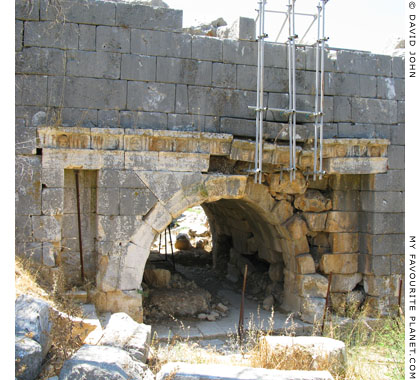
The entrance to the vaulted tunnel through the retaining
wall on the north side of the theatre at Letoon. The right
side of the entablature, which was in danger of collapsing,
was held up by metal supports prior to restoration. |
| |
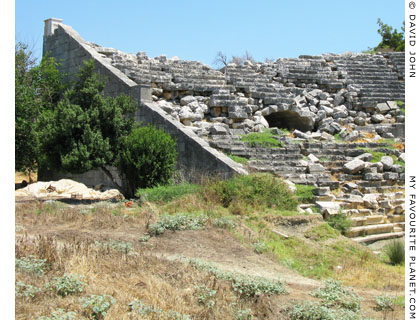
The north end of the cavea and the retaining wall
of the theatre at Letoon. The tunnel ends at the
level of the diazoma, the walkway separating the
upper and lower levels of seating rows. |
| |
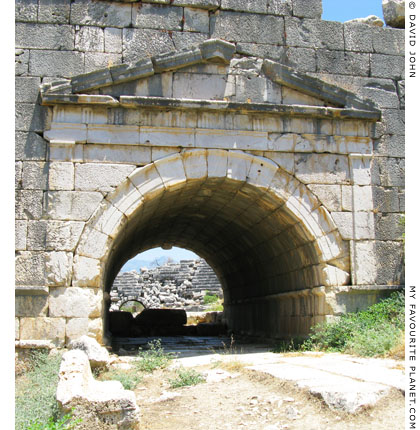
The facade of the vaulted tunnel entrance
to the south side of the Letoon theatre.
For information about the terms used to
describe parts of Greek theatres, see
the Theatre of Dionysos, Athens. |
| |
| |
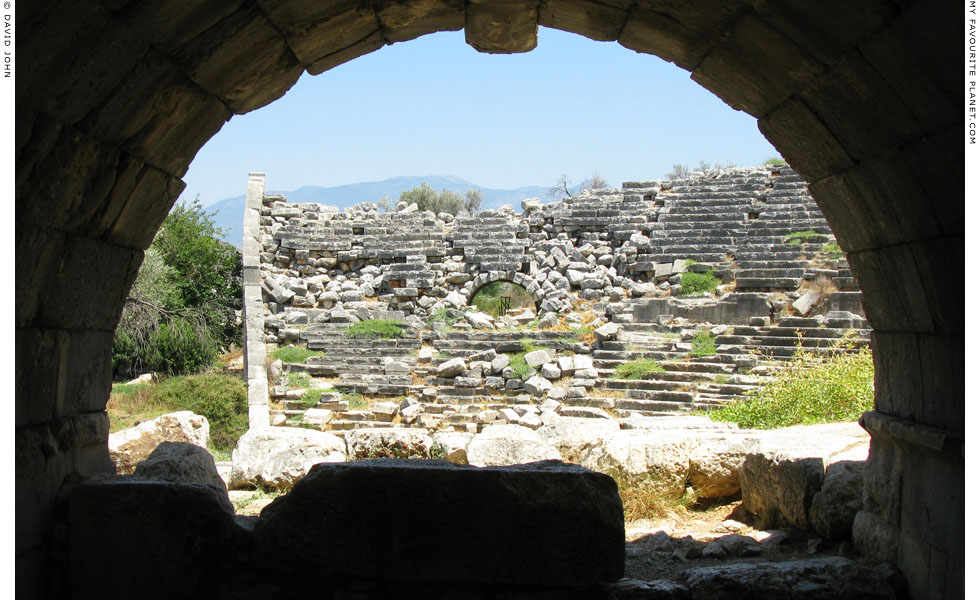
The north side of the theatre in the Sanctuary of Leto, Letoon, from inside
the vaulted tunnel entrance (parados) at the south side. The inner end of
the north tunnel can be seen half way up the cavea (audience seating area). |
| |
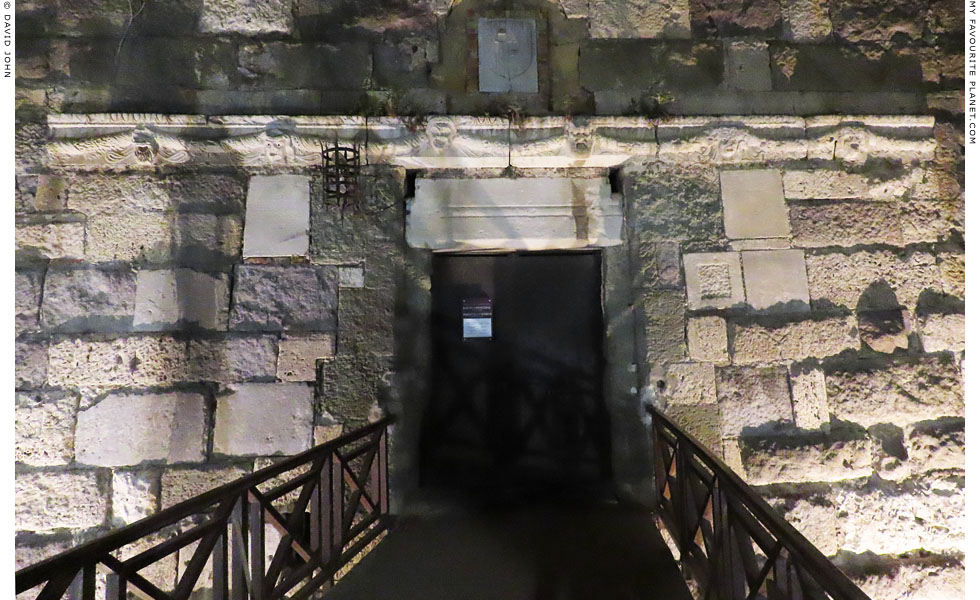
Ancient reliefs of theatrical masks on a marble frieze reused as a lintel above the
visitors' entrance to the Medieval Castle of Nerantzia (Κάςτρο της Νεραντζιάς), Kos. |
| |
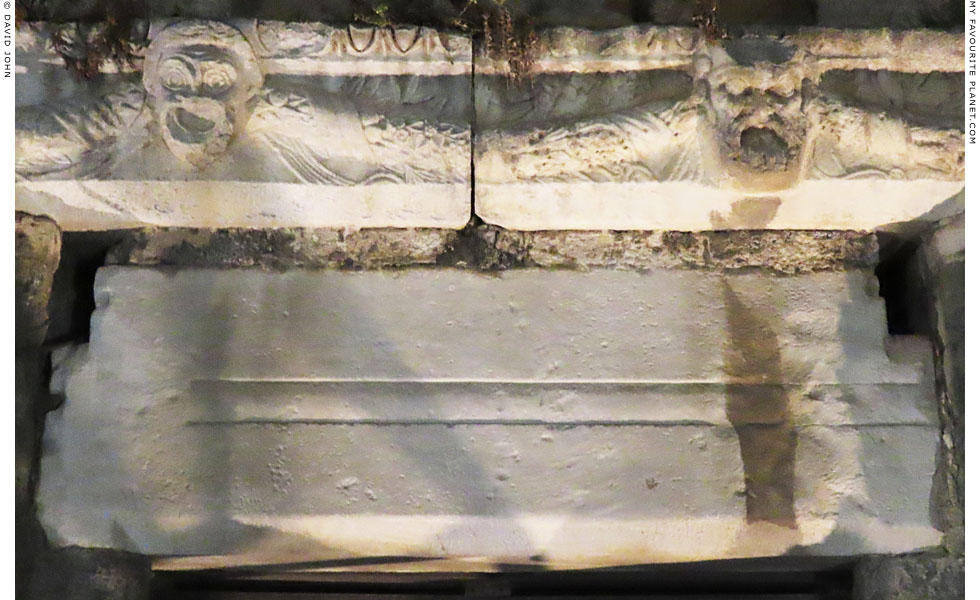 |
| |
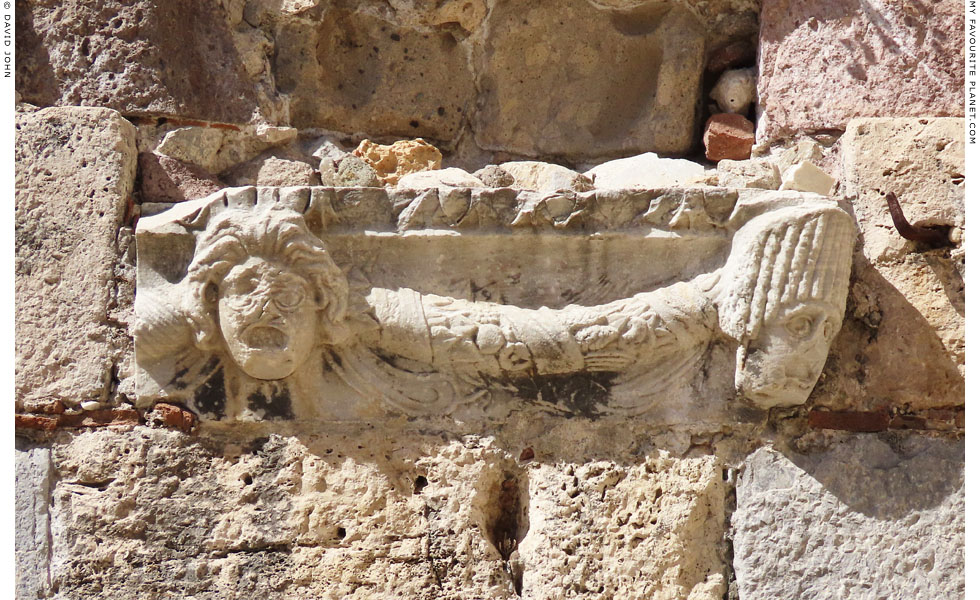 |
| |
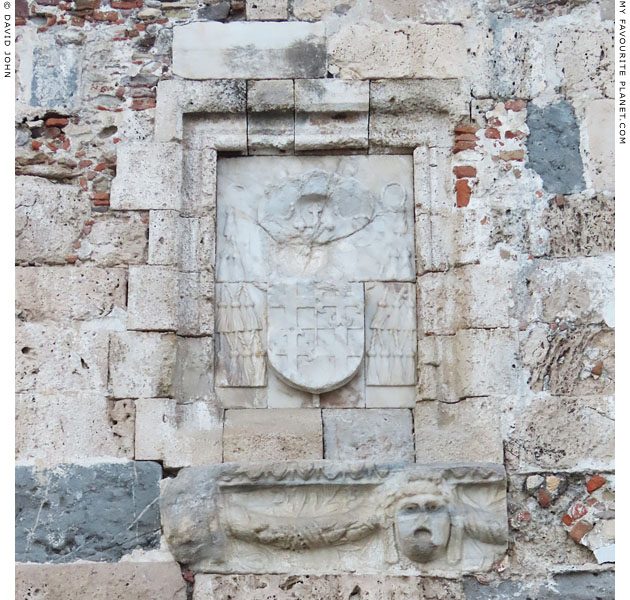 |
| |
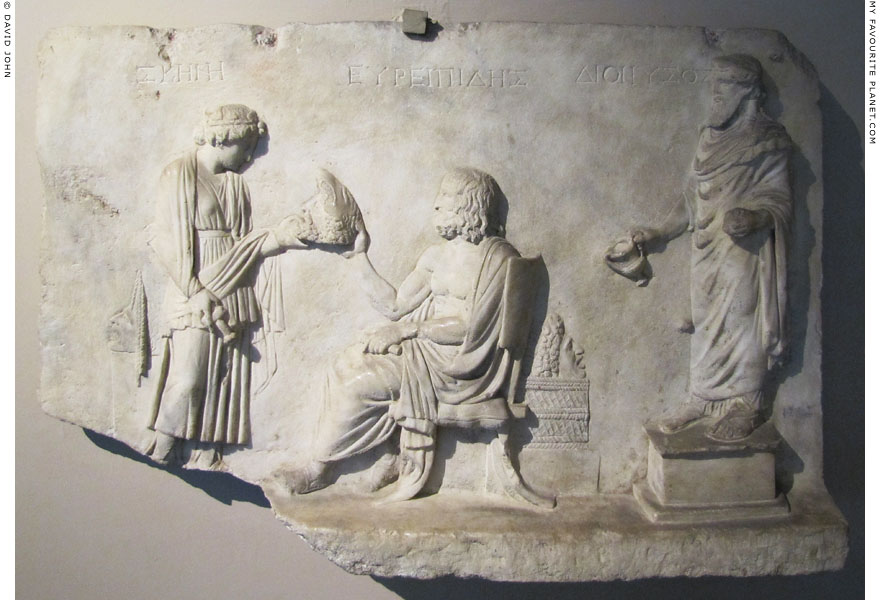
Inscribed marble relief in honour of the Athenian playwright Euripides.
From the vicinity of Smyrna (Izmir, Turkey). Late Hellenistic era.
1st century BC - 1st century AD. Height 60 cm, width 68.5 cm.
The tragedian (centre), seated and holding a scroll in his left hand, hands an actor's
mask of Herakles to Skene, the young female personification of the theatre (left),
while a statue of Dionysus (right) looks on, holding a kantharos in his right hand.
The names of the three figures are inscibed in Greek at the top of the stele. Behind
Euripides's seat another tragic mask sits on a basket or box which stands on a dais.
Gustave Mendel suggested that the relief should be called "the Apotheosis of Euripides"
because of the similarity of subject and treatment to the "Apotheosis of Homer" relief.
Istanbul Archaeological Museum. Inv. No. 1242 T. Cat. Mendel 574.
Purchased from the Misthos antiquities collection in Smyrna; taken to Istanbul in 1900. |
| |

A terracotta theatre mask from Cyprus.
300-100 BC. Findspot unknown.
Cyprus Archaeological Museum, Nicosia. |
| |
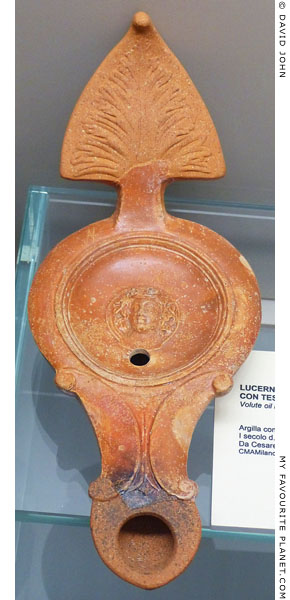 |
|
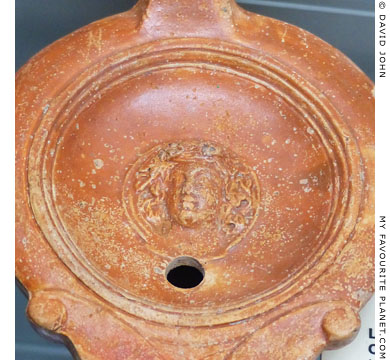 |
The head of Dionysus on a terracotta volute lamp.
1st century AD. Found in the hyposkenion of the theatre in Caearea Maritima,
Judaea (near Haifa, northern Israel), during excavations directed by Antonio Frova
(1914-2007) of the Italian Archaeological Mission of Caesarea, 1959-1964.
Civic Archaeological Museum, Milan. Inv. No. A 0.9.7189.
|
|
| The port city Caearea Maritima (also referred to as Caesarea Stratonis, Caesarea Palaestinae or Παράλιος Καισάρεια, Paralios Kaisareia) was built around 22–10 BC by Herod the Great (ruled 37 BC - circa 4 BC / 1 AD), on the site of a Phoenician naval base known to the Greeks as Stratonos Pyrgos (Στράτωνος Πύργος, Strato's Tower), founded by Abdashtart I (Straton I of Sidon), ruler of the Phoenician city state of Sidon 365-352 BC. Herod renamed it Caesarea in honour of Emperor Caesar Augustus. The city's theatre was built at the same time. |
|
| |
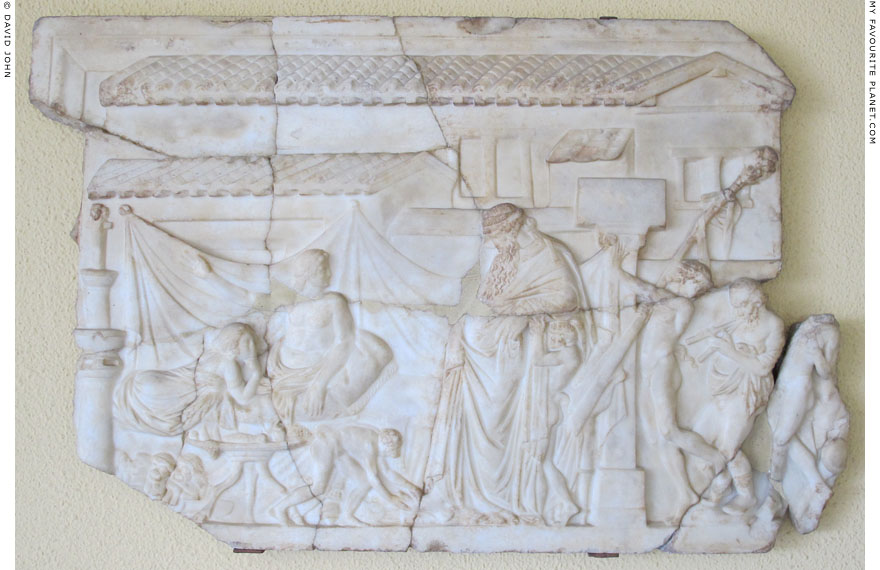
A fragmentary marble relief of the "Ikarios relief" type (also known as "Ikarios' Feast"), depicting
Dionysus and members of his thiasos (retinue) visiting the "Athenian actor Ikarios" (museum labelling).
Roman period. Found during excavations at the Vedius Gymnasium, Ephesus.
Izmir Archaeological Museum, Turkey.
|
There are as many as seventeen extant examples of "Ikarios reliefs" (also referred to as "Ikarios' Feast" reliefs), with several variations but essentially similar in content and composition. They are thought to be copies of a Hellenistic relief or painting of the 2nd century BC. Apart from the relief above from Ephesus, the other best-known examples are:
Marble Neo-Attic (?) relief, 1st - 2nd century AD.
Height 80 cm, width 136 cm, depth 10 cm.
Louvre, Paris. Inv. No. Ma 1606 (MR 719).
The relief is complete and the image is identical to the relief in Izmir.
From the Albani Collection, Rome. Revolutionary confiscation, 1798, following the Tolentino Treaty. Purchased by Louis XVIII in 1815.
Marble Neo-Attic relief, "the visit of Dionysus to Ikarios" ("Relievo con la raffigurazione della visita di Dioniso ad Icario"), late 1st century BC - early 1st century AD.
Height 76 cm.
National Archaeological Museum, Naples. Inv. No. 6713.
Farnese Collection, from the Museo Borgia.
Marble relief from Rome, possibly 1st century AD, with a chequered history, several previous ownwers and "many alterations and restorations".
Height 91 cm, length 152 cm.
British Museum, London. Inv. No. 1805,0703.123 (Sculpture 2190).
Not on display.
See photo below.
Recorded as being in the Casa Maffei around 1535, Later in the Villa Montalto, Villa Negroni, Massimo collections. Purchased in 1805 from the Townley Collection.
A fragment with the left side of an Ikarios relief. 1st century AD. Height 86 cm, preserved length 81 cm. National Archaeological Museum, Athens. Inv. No. G 5147. Donated by Louisa Streit. See photo below.
A number of relief fragments, including those in Pergamon Museum, Berlin (see below). One of these is almost identical to a Hellenistic fragment in the Museo Civico, Castello Ursino, Catania, Sicily. Inv. No. 960. Height 45 cm.
A fragmentary relief, around 125-150 AD (Hadrianic), Gaeta Cathedral, Italy.
Another relief fragment in the Capitoline Museums, Rome (see below) is perhaps also part of an "Ikarios relief".
A terracotta Campana plaque, 0-25 AD (Late Augustan), almost square, with a reduced version of an "Ikarios relief" scene (see photo below).
Height 46.5 cm, width 43 cm, depth 6 cm.
British Museum, London. Inv. No. 1805,0703.324 (Terracotta D 531).
Not on display.
Purchased by Charles Townley in Rome. Purchased by the museum from the Townley Collection in 1805.
A decorative marble vase ("Dionysus and his companions"), 2nd century AD.
State Hermitage Museum, Saint Petersburg. Inv. No. A 111.
A mature Dionysus with a long beard and wrapped in a heavy himation (similar to the "Dionysos-Sardanapalos" type statues), accompanied by his thiasos of reveling Satyrs and a Maenad, visits a mortal or hero. The god, entering from the right, appears to be drunk and unsteady on his feet. His left forearm is supported by a Satyr, while another removes his sandal and a third carries his thyrsos staff. On the left, the host, sitting on a kline (dining couch) with a female companion, bids the god welcome with a gesture of his raised right arm. The base of the kline is decorated with actors' masks. To the left of the figures a small herm (of Dionysus?) stands on an elaborate base resembling a fountain.
The scene appears to be taking place outside, perhaps in the host's garden or courtyard, with a long cloth draped in an apparently improvised way over the wall which provides the backdrop. The buildings behind the figures have been interpreted as either his home, a temple or part of a theatre. The youthful host himself is named Ikarios (or Icarius) on the labelling and in the literature of various museums which describe him as an "Athenian actor" or "dramatic poet".
There is no textual evidence concerning the subject of the image, and it is not mentioned in ancient literature. The identification of the figures has been discussed since the 16th century, when there were already two copies known in Rome (those now in the British Museum and Naples). It has been suggested, for example, that the host is the mythical Attic farmer Ikarios (Ἰκάριος), the eponymous hero of the deme Ikaria, who was taught the art of winemaking by Dionysus in return for his hospitality. According to other theories, the original image may have been a votive relief dedicated by the winner of a theatrical competition, or even an illustration of a scene from a theatrical performance or the enactment of a Satyr play.
The "Ikarios reliefs" combine the iconography of other Greek votive images, particularly "funeral banquet" reliefs and "Theoxenia reliefs". The subject of a funeral banquet relief is one or more deceased mortals or heroes on a kline, attended by family members and servants. "Theoxenia reliefs" (θεοξένια, literally, god hospitality; sacred feasts) depict gods and heroes attending feasts, which were often laid out on special tables by mortals. The most common divine subjects of such reliefs are the Dioskouri (Castor and Pollux) and Dionysus. More generally, the scene has been described as an epiphany (ἐπιφάνεια), a term used to describe gods revealing or manifesting themselves to mortals (see, for example, the Archaic "snake goddess plaque" from the Athens Agora). |
|
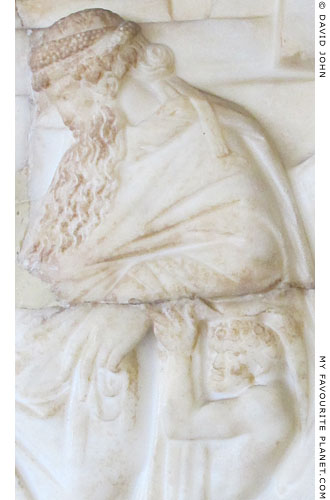
Dionysus arriving at the house of Ikarios. |
|
| |
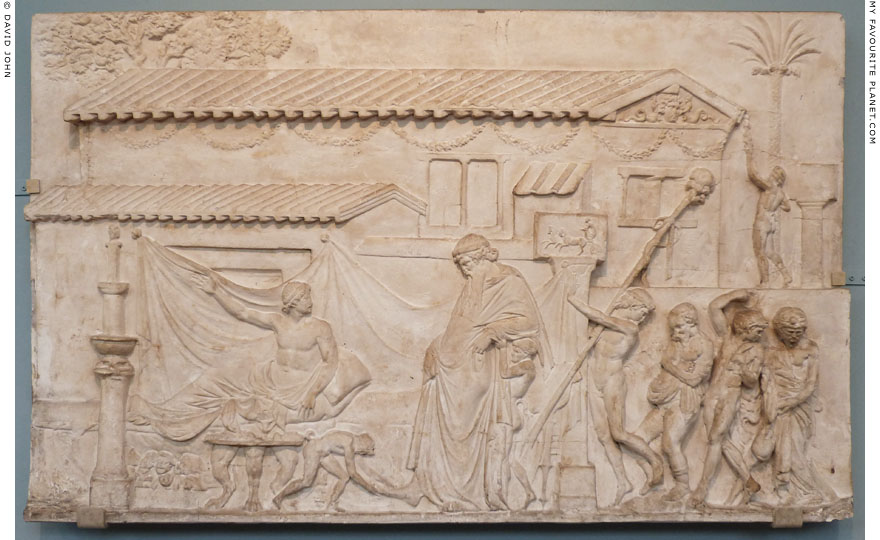
Plaster cast of the marble "Ikarios relief" now in the British Museum,
depicting Dionysus and his retinue visiting the house of "a dramatic poet".
Ashmolean Museum, Oxford. Inv. No. E 11.
Original in the British Museum. Inv. No. 1805,0703.123 (Sculpture 2190).
Height 91 cm, length 152 cm. Not on display.
|
The original relief in the British Museum is from Rome, tentatively dated to the 1st century AD, "with many alterations and restorations". The scene is almost identical to the relief in Izmir (above), with the notable exception that the woman on the host's couch is now missing. She was removed by restorers, allegedly because the figure was too badly damaged to repair (see below). A couple, perhaps a Maenad and a Satyr, walking to the left, arm in arm, was shown at the right end of the scene on printed drawings of the relief made in the 15th and 16th and centuries (see below), but was evidently also removed by restorers.
This is the only relief of the type in which so many details have survived, including the votive relief on top of the pillar to the right of the head of Dionysus depicting a winged Victoria (Nike) driving a speeding two-horse chariot (see also the illustration below). Also, the long building (a temple?) in the background is garlanded and has a relief of a Gorgoneion on the pediment. Furthermore, there is a nude male figure in the background, right, standing on what may be a raised area (terrace) or a wall in front of the building. His left arm raised as he holds one end of the long garland. Behind him is a palm tree and to his right stands another votive plaque on top of a pillar. Below the kline, what appear to be four heads are actors' masks, which partly accounts for the theory that the young man on the couch is an actor. The masks also appear on the "Ikarios reliefs" in Izmir (see above), the Louvre (Inv. No. Ma 1606) and the fragment in Athens (Inv. No. G5147), but not on the example in Naples (Inv. No. 6713).
Thought to have been discovered in Rome in the early 16th Century, the work was recorded as being in the Casa Maffei around 1535, and appeared in an engraving published by Antoine Lafréry in 1549 (see below). Later it was taken to the Villa Montalto, the palace of Pope Sixtus V (1521-1590, pope 1585-1590). By the late 18th Century it was in the Villa Negroni, from where it was purchased in 1785/1786 for the English collector Charles Townley (1737-1805). It was shipped back to England along with other ancient artworks acquired by Townley, later to be known as the Townley Collection, also dubbed the "Townley Marbles". The relief was named "The Supper of Trimalchio" and hung it above the mantlepiece of the library of his townhouse in Westminster, London.
Following Townley's death, the British Museum purchased the relief in 1805, along with much of his collection, from his cousin and heir Peregrine Edward Towneley, who sold several other "Townley Marbles" to the museum in 1814. |
|
| |

An engraving in the British Museum of the "Ikarios relief" from the Townley Collection,
which is also in the British Museum. The earliest known print of this relief, dated Rome,
1549, published in folio by Antoine Lafréry (circa 1512-1577). Although it is unsigned,
it is thought to have been engraved by Baptisita Franco.
British Museum, London. Inv. No. 2010,5006.1877.12. Not on display.
Image © The Trustees of the British Museum.
|
This engraving is from an album of 40 prints and drawings of bas-reliefs, the leather cover of which has the title "Drawings III Bas Reliefs etc in Marble" tooled in gold on spine. On this page, the caption below the image reads:
"TRICLINARIVM LECTORVM TRIPEDIS MENSAE ET ACCVMBENTIVM EX MARMOREIS TABVLIS GRAPHICA DEFORMATIO
ROMAE M D XLVIIII"
To the right of the date, the Italian version of Antoine Lafréry's name: ANT LAFRER[I]
The print appears to show the relief before restoration and the removal of the female figure on the kline. This is the only relief in which so many details have survived, including the small relief of Nike in a chariot behind the head of Dionysus, and the figure in the background, standing before a palm tree on the raised area in front of the building with the Gorgon pediment. The male and female couple on the extreme right in the print are missing from the British Museum relief.
Image source: Pietro Santi Bartoli, Admiranda Romanarum antiquitatum ac veteris sculpturae vestigia: anaglyphico opere elaborata ex marmoreis exemplaribus quae Romae adhuc extant in Capitolio, aedibus hortisque virorum principum ad antiquam elegantiam, plate 43. Rome, 1693. At the Internet Archive. |
|
| |
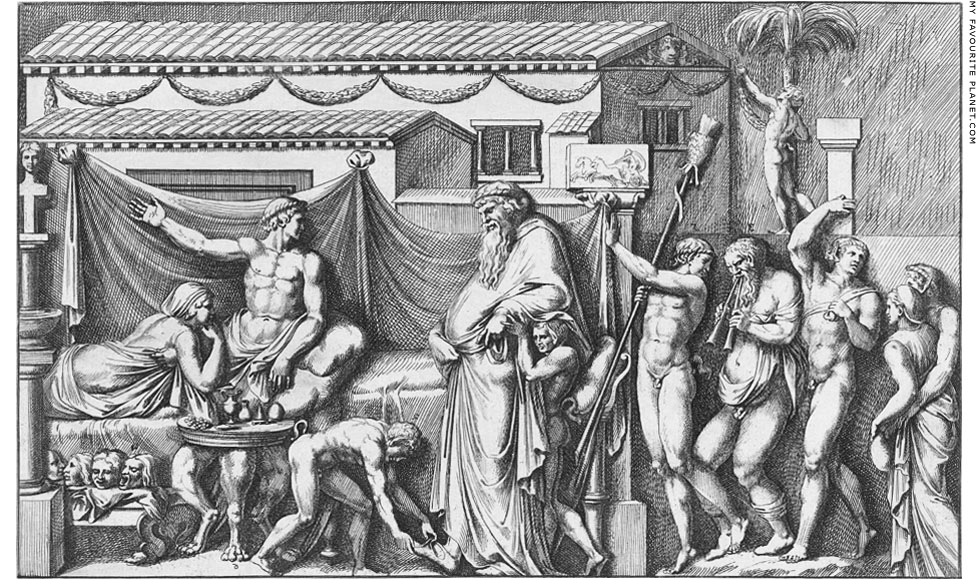
Etching of the "Ikarios relief" now in the Britsh Museum, from a book published in Rome
in 1693 by Pietro Santi Bartoli (1635-1700), containing prints by Bartoli and other artists
of ancient artworks at that time in the city. Some of the illustrations had appeared in
other books published as early as 1645. Like other illustrations in the book, the etching
is a mirror-image of the relief, which herehas been corrected.
|
The print appears to show the relief before restoration and the removal of the female figure on the kline. This is the only relief in which so many details have survived, including the small relief of Nike in a chariot behind the head of Dionysus, and the figure in the background, standing before a palm tree on the raised area in front of the building with the Gorgon pediment. The male and female couple on the extreme right in the print are missing from the British Museum relief.
Image source: Pietro Santi Bartoli, Admiranda Romanarum antiquitatum ac veteris sculpturae vestigia: anaglyphico opere elaborata ex marmoreis exemplaribus quae Romae adhuc extant in Capitolio, aedibus hortisque virorum principum ad antiquam elegantiam, plate 43. Rome, 1693. At the Internet Archive. |
|
| |
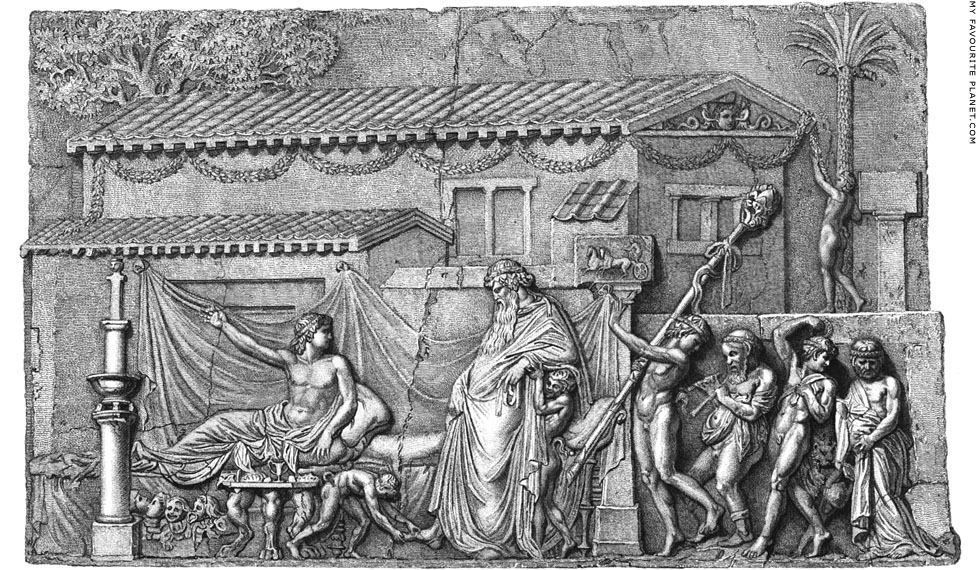
An engraving of the "Ikarios relief" in the British Museum
in the 1815 catalogue of ancient marble sculptures.
Taylor Combe (editor), A description of the collection of ancient marbles in the British Museum,
Part 2, Plate IV. Longman, Hurst, Rees, Orme and Co., London, 1815.
|
| According to the catalogue text, the female figure on the couch is missing because it was damaged, and rather than replace it, the restorer appears to have simply filled in the drapery of the male figure. In the group of four followers of Dionysus on the right, the bearded figure playing the double pipes was identified as Silenos. The heads of the two figures to his right are modern, as well as the raised arm of one. |
|
| |
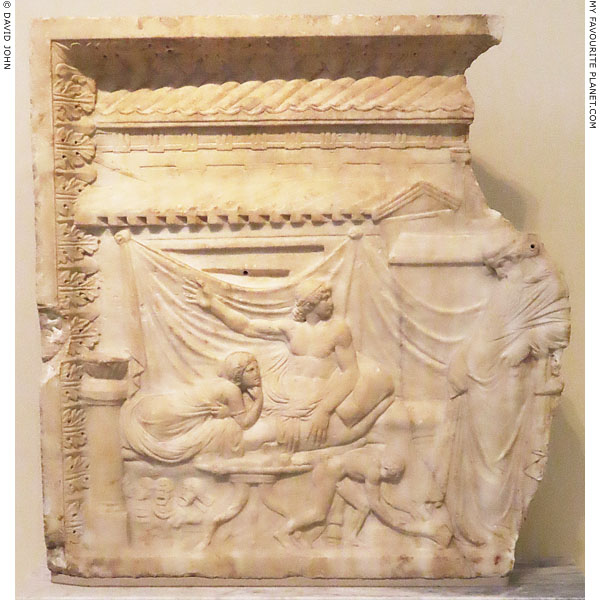
A fragment of a marble slab with the left side of an Ikarios relief, now in Athens.
Early 1st century AD. Height 86 cm, preserved length 81 cm.
National Archaeological Museum, Athens. Inv. No. 5147.
Formerly in the Louisa Streit Collection. |
| |
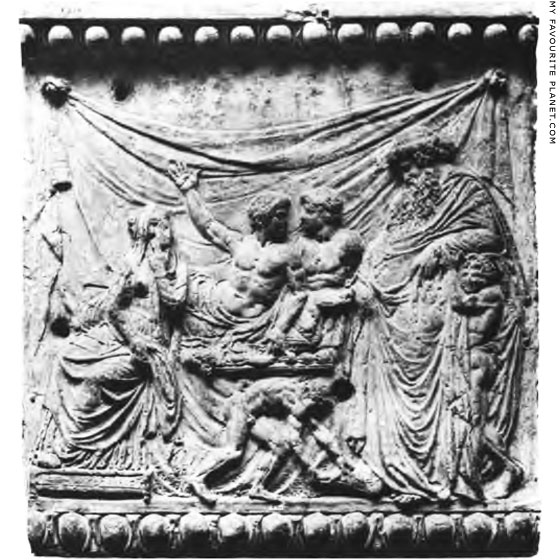
A terracotta plaque with an "Ikarios relief". This compact version of the "Ikarios"
scene shows two young men sitting close together on the kline. A female sits to
the left, her feet resting on a footstool and her head is turned back to the right
to face Dionysus, who is depicted at a larger scale than the mortals and the two
Satyrs. Traces of paint have survived: a greyish-yellow layer over the undecorated
surfaces, and red on the hair and beard of Dionysus. The scene is framed above
and below by egg-and dart mouldings. The plaque has four holes for suspension.
One of a number of Campana plaques purchased by the 19th century collector
Charles Townley in Rome, now in the British Museum. Roman, made in Italy
around 0-25 AD (Late Augustan). Height 46.5 cm, width 43 cm, depth 6 cm.
British Museum. Inv. No. 1805,0703.324 (Terracotta D 531). Not on display.
From the Townley Collection; purchased by Charles Townley in Rome.
Purchased by the museum in 1805 from Peregrine Edward Towneley.
Image source: Henry Beauchamp Walters, Catalogue of the Terracottas in the
Department of Greek and Roman Antiquities, British Museum, Plate XLI,
Cat. No. D 531, page 386. British Museum, London, 1903. At the Internet Archive.
See other Campana plaques in the British Museum with Dionysian themes above:
Maenad and Satyr with the infant Dionysus Dionysus and a Satyr |
| |
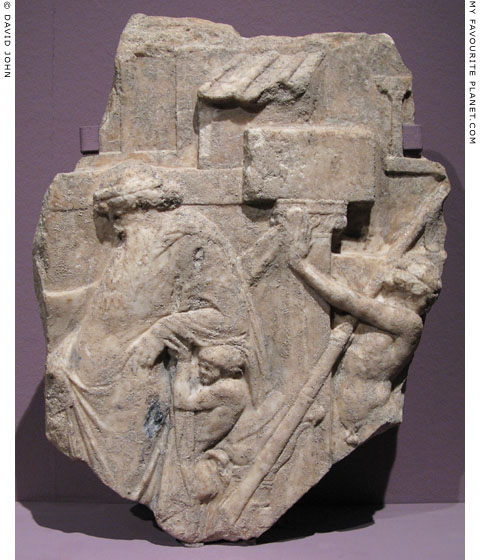
Fragment of a marble "Ikarios relief" showing Dionysus
with two Satyrs. Early 1st century AD. Height 56.5 cm,
width 43.7 cm, depth 5 - 5.9 cm.
Pergamon Museum, Berlin. Inv. No. Sk 919.
Purchased for the Berlin museums by Eduard Gerhard in Rome, 1841. |
|
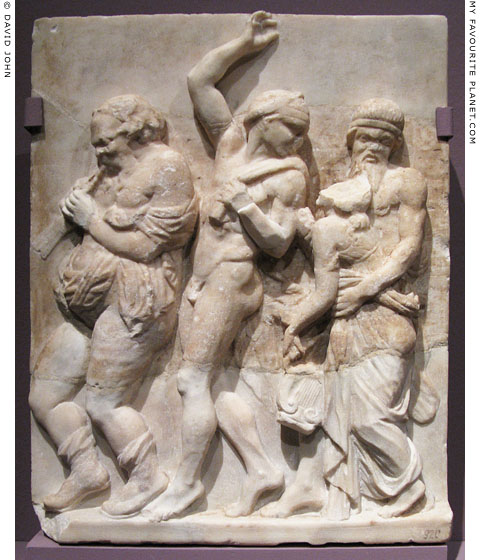
Fragment of a marble "Ikarios relief" showing
members of Dionysus' thiasos.
1st century AD. Provenance unknown. Recorded as being in the
Prussian Royal Collection in 1891 (Inventar der Skulpturen I,
page 265; Conze, 1891). Height 45.1 cm, width 36 cm, depth 4.6 cm.
The restored fragment shows the group of four figures known from
the lower right side of other "Ikarios reliefs": a Silen playing an aulos
(double pipes), followed by a Satyr raised right arm turning back to
a Maenad holding a lyre, who is supported by a bearded Satyr.
Pergamon Museum, Berlin. Inv. No. Sk 920.
It is almost identical in size and composition to the
fragment in the Museo Civico, Castello Ursino, Catania,
Sicily. Inv. No. 960. Height 45 cm. |
|
| |
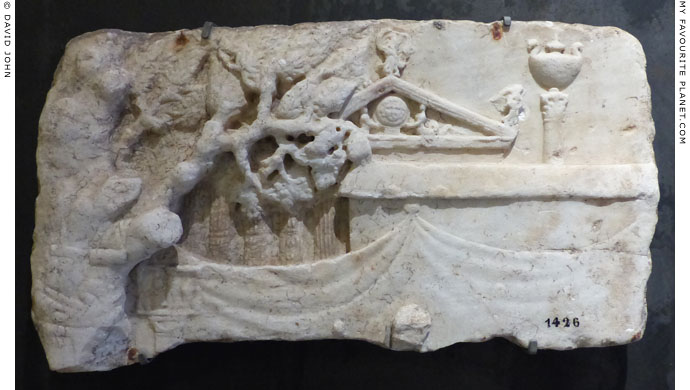
The top left corner of a marble relief, described as "relief representing a sacred landscape".
It shows the top of a temple with a Gorgoneion on the pediment (as in the relief above),
part of a wall from which a cloth sheet is hung, a column topped by a relief and a tree (left).
It could well be a fragment of an "Ikarios relief", with the head of "Ikarios", bottom, centre.
Pentelic marble. 1st century BC - 1st century AD. One of a number of Dionysiac relief
fragments from the Horti Maecenatiani, Rome (see also the relief fragment above).
Found in 1876 in the area of the Auditorium.
Palazzo dei Conservatori, Capitoline Museums, Rome. Inv. No. MC 1426.
|
| This kind of "sacred landscape" appears on other Roman period artworks, including the relief depicting a rural Dionysian sanctuary above, as well as "Kitharoidos Reliefs" depicting Laton (Leto), Diana (Artemis), Apollo and Victoria (Nike), in which a temple with a Gorgon pediment is shown behind a wall in the background. One of the best preserved examples is now in the Altes Museum, Berlin. Inv. No. Sk 921. However, these do not include a hanging sheet. |
|
| |
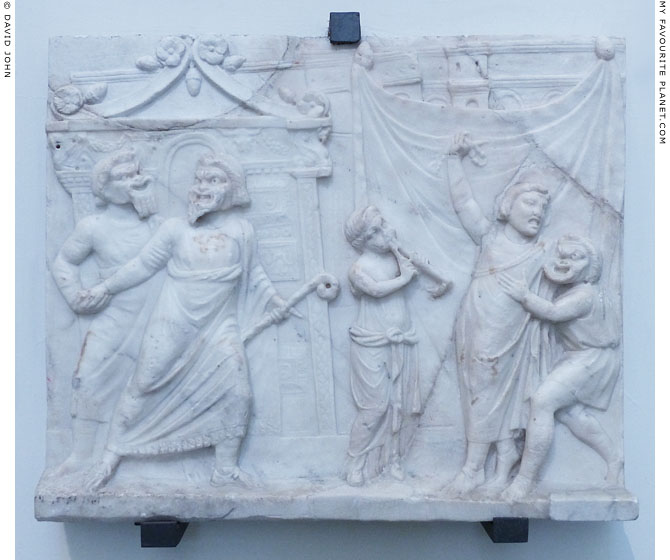
Neo-Attic marble relief depicting a theatrical scene.
1st century AD. Luni marble.
National Archaeological Museum, Naples. Inv. No. 6687. |
| |
| Dionysus |
The Triumph of Dionysus
During the Roman period Dionysus was often depicted with his
thiasos in a procession, known as a "triumph" or "Indian triumph". |
|
 |
|
| |
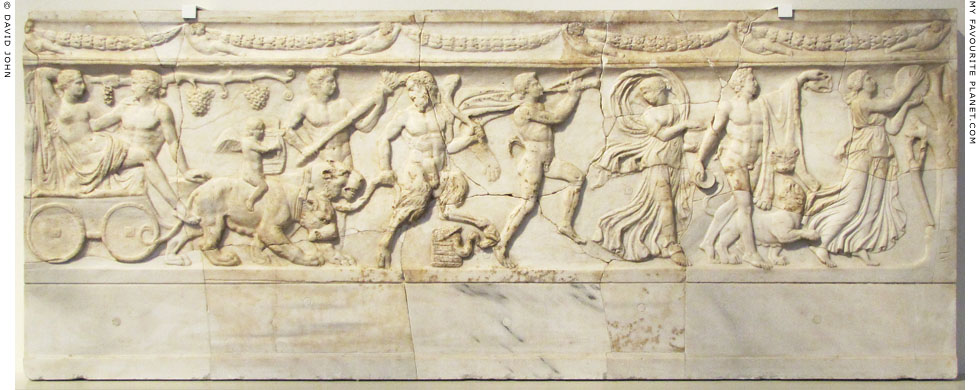
A procession with Dionysus and Ariadne (left) on a wagon pulled by two panthers
("a panther chariot"), led by Pan, Satyrs and Maenads playing music and dancing.
Eros, riding one of the panthers, plays a lyre.
Relief on a marble closure slab of a sarcophagus-like wall grave. 110-130 AD.
Found near the Tomb of Caecilia Metella, Via Appia, Rome.
Height: 74.5 cm, width 205 cm, depth 9.5 cm.
Altes Museum, Berlin. Inv. No. Sk 850.
|
Myths concerning Dionysus as the victor over Asian regions and barbarians were already current by the Classical period, and mentioned for example in The Bacchae by Euripides (lines 13-22). The notion of the wine god as an ancient conqueror of India became popular following expedition of Alexander the Great to the Indus in 327-326 BC. In the Hellenistic mind analogies were drawn between Indian religious practices and those of the Dionysian cult, and Dionysus was seen as the saviour god who, with his mad or merry followers (his thiasos), had brought peace, the vine and other blessings to the Indians.
The subject of his triumphant return to the west became even more pertinent in the Roman Empire, when victorious generals and emperors paraded amid great pomp through Rome and other cities. A Roman triumph was often an extravagant show with casts of thousands, including hostages, prisoners of war, captured slaves, exotic beasts and other booty, and the grand event was often followed by elaborate performances and shows for the masses.
For a short introduction to the strange tales of the military expedition by Dionysus and his thiasos army to India, read Dionysus, an introduction by Lucian of Samosata (circa 120-200 AD). Thought to have been written as an introduction to his True story Book 2 (Ἀληθῶν Διηγημάτων Β; Latin, Verae historiae II). Lucian is wonderfully entertaining author, always worth reading.
Lucian of Samosata, Dionysus, an introduction (Διόνυσος; Latin, Bacchus). In: Lucian (complete works), Volume 1 (of 8), pages 48-59. Loeb Classical Library edition in Greek and English, translated by A. M. Harmon. Harvard University Press, Cambridge, Massachusetts, and William Heinemann, London, 1913.
In the 4th or 5th century AD the Greek-Egyptian poet Nonnus of Panopolis (Νόννος ὁ Πανοπολίτης) wrote the epic poem Dionysiaca (Διονυσιακά), narrating the life of Dionysus, his expedition to India and his return to the west in triumph. Consisting of 20,426 lines of dactylic hexameters in Homeric dialect, the 48 books of the Dionysiaca represent the longest poem to have survived from antiquity.
Nonnos, Dionysiaca, in three volumes. Loeb Classical Library edition in Greek and English, translated by W. H. D. Rouse. Harvard University Press, Cambridge, Massachusetts, and William Heinemann, London, 1947. |
|
| |
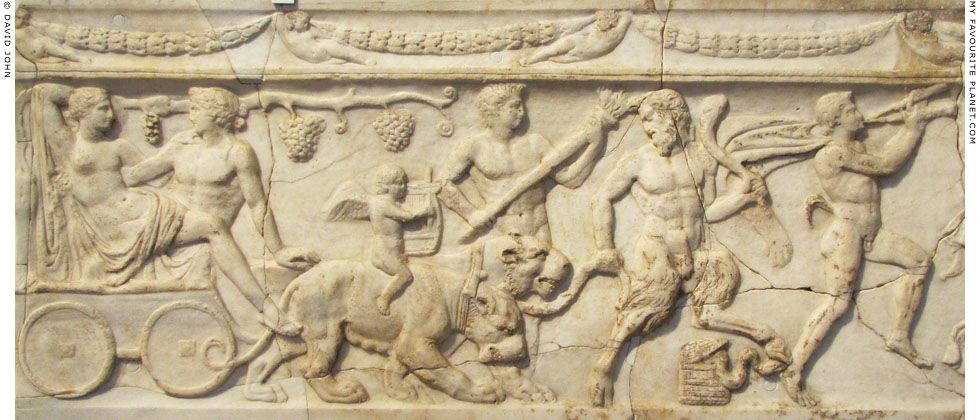
Detail of the Dionysus procession relief above.
Such reliefs with Dionysian motifs were common on
sarchophagi from the city of Rome until around 300 AD. |
| |
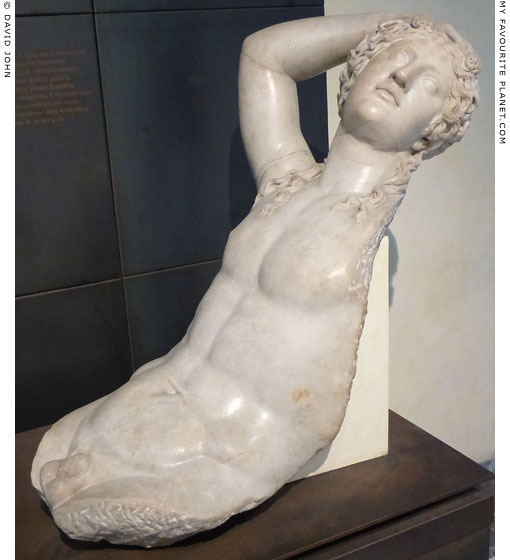
A fragment of a marble statue of Dionysus reclining. Thought to be from
a sculpture group, perhaps of the god in a chariot as part of a triumph.
Luni marble. Antonine period (160-200 AD). Height 121 cm.
Found December 1874 in an underground chamber beneath the Piazza Vittorio Emanuele,
the ancient Horti Lamiani, Rome, among several other well-preserved ancient sculptures,
thought to have been made in the same workshop. Also found there were the statue of
Emperor Commodus as Hercules Romanus (MC 1120) and the Esquiline Venus (MC 1140).
Palazzo dei Conservatori, Capitoline Museums, Rome. Inv. No. MC 1113. |
| |

Relief of a Dionysian procession on the front of a marble sarcophagus.
Around 180 AD. Anatolian marble. Height 56 cm,
width 212.5 cm, depth 62 cm [see note 15].
Skulpturensammlung, Albertinum, Dresden. Inv. No. Hm 293. |
| |

Relief of an Indian Triumph of Dionysus on the front of a marble sarcophagus.
Around 190-220 AD. The sarcophagus was later reused as a basin for
a fountain and the surface of the marble has been extremely eroded.
On the left, Dionysus rides on a chariot drawn by two elephants, exotic animals
which are rare in Triumph depictions. One of the elephants treads on a panther.
Immediately behind the chariot Victoria (Nike) holds a victor's palm branch. Satyrs
and Maenads play music and dance around a flaming altar in the centre. At the far
right stands a hip herm, with a sculpted figure shown down to the hips. On the left
side of the sarcophagus is a relief of an ecstatically dancing Satyr. On the right side,
a Satyr with an aulos (double pipes) and Dionysus with a thyrsos and kantharos.
Sarcophagus height 62 cm, length 211 cm, depth 69 cm.
Palazzo Altemps, National Museum of Rome. Inv. No. 8566.
Ludovisi Collection, from the Carpi Collection.
The Renaissance painter Il Garofalo featured elephants
in his 1540 painting The Triumph of Bacchus, see below. |
| |
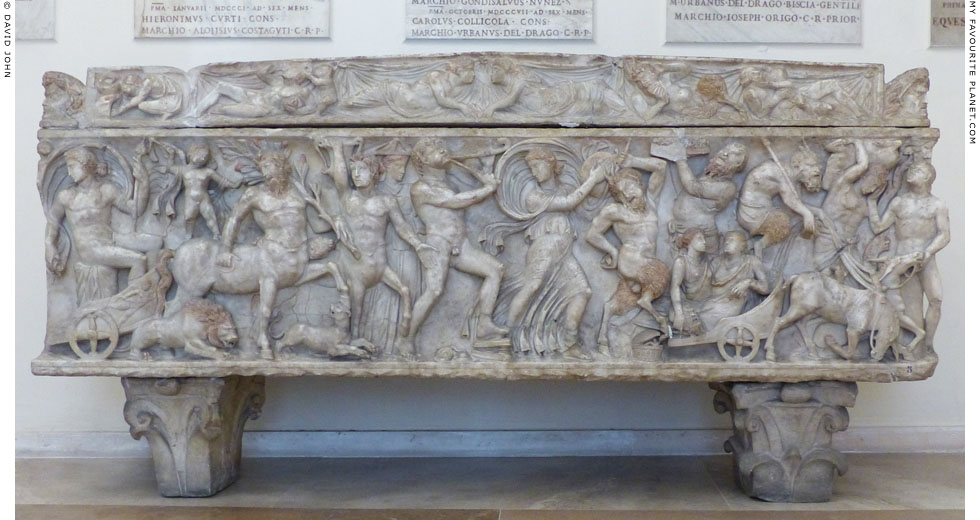
Relief of a triumph of Dionysus on the front of a marble sarcophagus. Roman Imperial period.
On the left, Dionysus, holding his thyrsos staff, sits in a chariot drawn by two Centaurs.
Winged Eros stands on the back of one of the Centaurs, and a lion and a panther run
alongside them. In the centre Pan dances in front of a Satyr playing pipes and a Maenad
playing a tympanon. Right, a couple (the deceased?) sit in a chariot driven by a figure
who looks like Pan, pulled by an exhausted donkey and surrounded by Satyrs.
Palazzo dei Conservatori, Capitoline Museums, Rome (not labelled). |
| |

Relief of a triumph of Dionysus on the front of a marble sarcophagus. Circa 160-170 AD.
On the left, a drunken Dionysus, holding a kantharos (wine cup), stands in a chariot drawn
by two Centaurs, one of which plays a lyre. Winged Eros stands on the back of one of the
Centaurs. In the centre Pan dances on the cista mystica between two Maenads, one playing
a pipe and the other a tympanon. To the right Silenos lies drunk on a four-wheeled wagon
pulled by an exhausted donkey and surrounded by Satyrs, one of whom carries a calf on his
shoulder. Another, smaller figure who also looks like Pan can be seen stepping from Silenos'
wagon onto the back of the donkey. Sarcophagus height 58 cm, length 228 cm, depth 71 cm.
National Archaeological Museum, Naples. Inv. No. 6693. |
| |
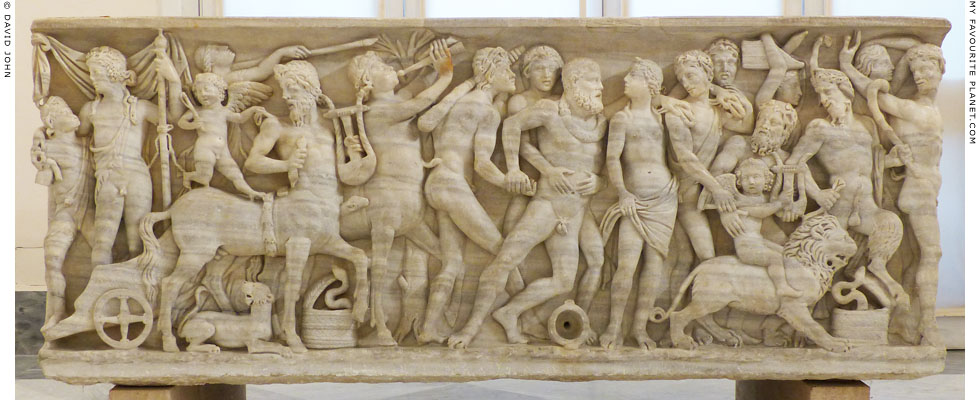
Relief of drunken Hercules in a triumph of Dionysus on the front of a marble sarcophagus.
Circa 200 AD, early Severan period.
The relief was made around the same time as the one above and depicts a similar scene,
with the notable exception of the appearance of the large figure of a drunken Hercules,
supported by two Satyrs, in the centre. On the left, Dionysus supported by a Satyr. On the
right, in the place of Silenos' wagon, a winged Eros sits on a lion led on a leash by Pan.
Each end of the sarcophagus has a relief of a griffin with a paw resting on a ram’s head.
A snake emerging from a round, lidded basket, interpreted as the cista mystica (sacred
kiste), appears twice in the relief. Sarcophagus height 87 cm, length 218 cm, depth 97 cm.
National Archaeological Museum, Naples. Inv. No. 6776. |
| |
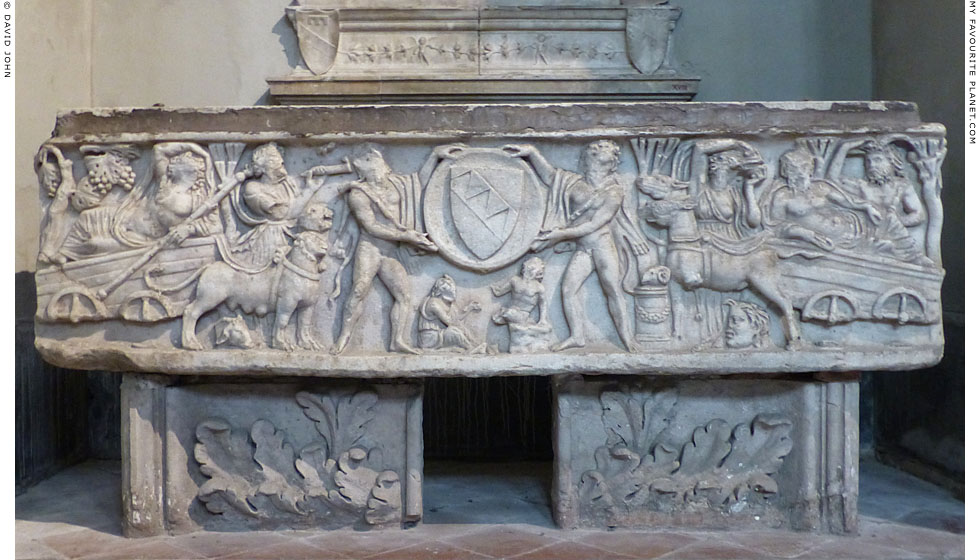
Relief of a triumph of Dionysus on the front of a Roman marble sarcophagus,
3rd century AD, reused as a tomb for a member of the noble Piscicelli family.
Basilica di Santa Restituta, Naples Cathedral.
|
On the left, Dionysus lounges in a familiar pose, with his right forearm over his head, and in his left hand is a thyrsos which looks more like a military sceptre. His four-wheeled wagon is pulled by two panthers; the cat in front is clearly female. Below the panthers is the head of an ox in profile. To the left of the god is a vine, and to the right a Maenad, probably playing a flute.
On the right of the relief, Silenos lies in a similar wagon pulled by two donkeys, below which is the head of a male in profile. To his right is Pan, who appears to have extra-long horns and to be holding a lagobolon. To the left stands a Maenad playing cymbals, and a garlanded circular altar on which there is a ram's head.
In the centre two Satyrs, with shouldered lagobolons and wearing animal skins, hold a clipeus (round shield device) bearing the coat of arms of the Piscicelli family. Below it are two small seated figures, one clothed and the other naked (a Maenad and Satyr?).
An old description of the sarcophagus (A. Sorrentino, La Basilica costantiniana a Napoli e notizia di due suoi sarcofagi. Napoli, 1908) mentions "A row of comic and tragic masks shaped like a pedestal to the Bacchic scene". However, these masks are now not to be seen. They may be covered by the cement used to seal the lid.
Each of the short sides has a relief of a mask between festoons of foliage and fruit. The sarcophagus rests on two marble blocks decorated with reliefs of oak leaves. According to one source, it was the tomb of Alfonso Piscicelli (14th century), although so far I have found no confirmation of this.
Height 54 cm, length 2 metres, depth 60 cm. |
|
| |
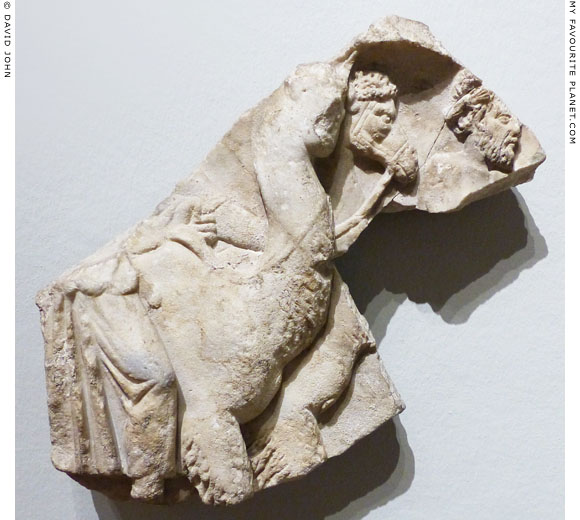
A fragment from a marble sarcophagus with part of a relief thought to have depicted
the triumph of Dionysus. The lower part of a figure can be seen riding one of two
camels, walking side by side to the right. To the right of the surviving head of
one of the camels are the head and shoulder of a bearded male facing right.
2nd half of the 2nd century AD.
Museum für Kunst und Gewerbe Hamburg. Inv. No. 1962.34. |
| |
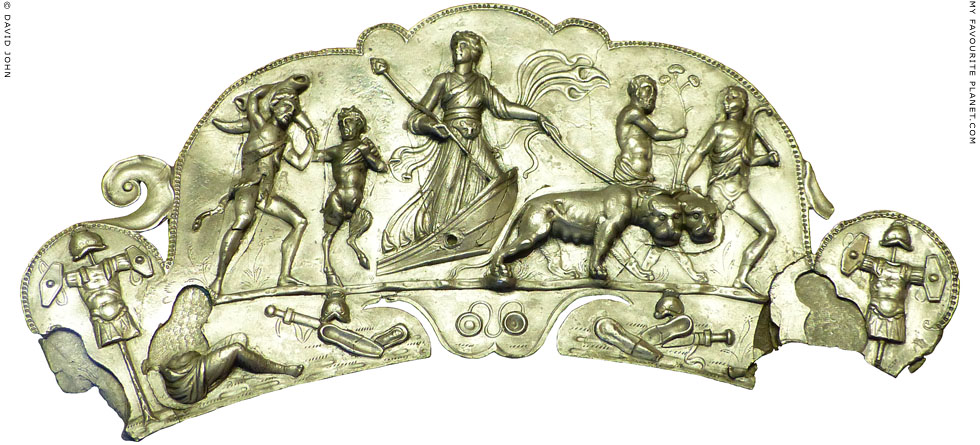
Silver and gilt handle for a ceramic tray, showing the Indian Triumph of Dionysus.
Severan period, early 3rd century AD. Found between Hamadan and Kirmanshah,
Iran. Length 22.7 cm, thickness 0.47 cm, weight 672.7 grams.
Metropolitan Museum of Art, New York. Inv. No. 54.11.8.
Purchased through the Rogers Fund, 1954. |
| |
Dionysus, standing in a triumphal pose and holding his thyrsos staff like a weapon in the manner of a triumphal Roman emperor or general (a pose which can be seen on several imperial statues), rides in a chariot/ship pulled by two large cats (lionesses, female panthers or tigers?). From his waist hangs a metal insignia with the head of a large cat, and the folds of his cloak, billowing in the wind, appear to take on the form of lotus flowers.
Pan and three Satyrs accompany him, and one Satyr (left) carries two elephant tusks as booty. Another Satyr (second from right) holds a long-stemmed plant with three large flowers. At the centre of the work, below the triumphal group, is a pair of cymbals, symbolic of Dionysian rites.
The martial significance of the work is underlined by the weapons and armour - trophies captured from defeated enemies - at the bottom (lower register) and sides of the object. The seated figure on the left has been interpreted as a prisoner of war with his hands tied behind his back. Another figure on the right, presumably another prisoner, is now missing.
The missing parts of the prisoners and the visible outlines around the other figures reveal how the pictorial elements on the handle were cast separately as plaques in a different alloy and inlaid in the silver plate.
See: Christine Alexander, A Roman Silver Relief: The Indian Triumph of Dionysos. Metropolitan Museum of Art Bulletin, 14(3), 1955, pages 64-7.
See also a mosaic showing Pan carrying Dionysus above, thought to be part of an Indian Triumph of Dionysus. |
|

Dionysus returns from India on a panther-powered ship. |
|
| |
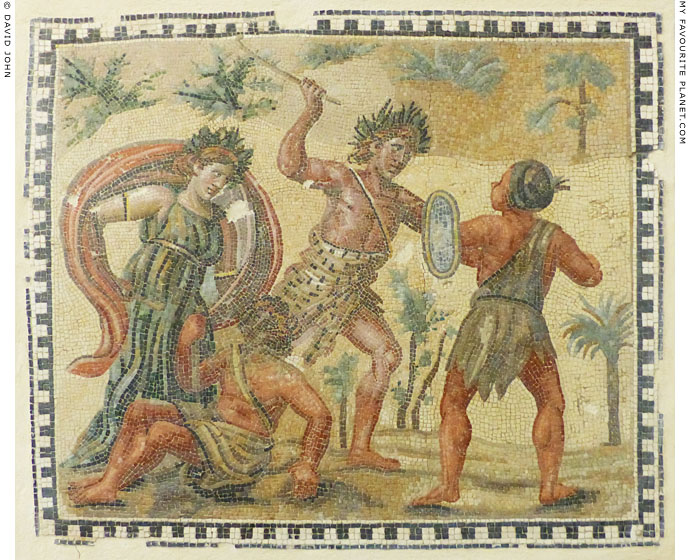
Mosaic emblema depicting Dionysus fighting the Indians.
First half of the 4th century AD. Probably found in the area of the Villa Ruffinella, Tuscolo.
Palazzo Massimo alle Terme, National Museum of Rome. From the Kircherian Museum. |
| |
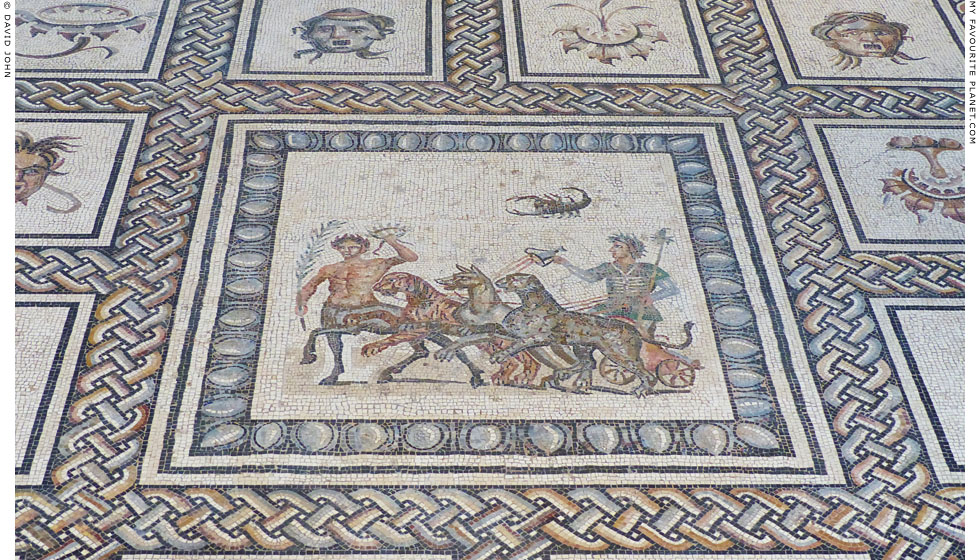
Detail of a large Roman mosaic floor with 33 emblemata (panels) depicting
Dionysian motifs. The largest emblema in the centre shows Dionysus driving
a chariot drawn by a tiger, a dog (or wolf) and a panther, and accompanied
by a Centaur. A scorpion appears above the head of Dionysus.
3rd century AD,. Found in 1843 near Santa Marinella, Lazio, Italy. Extensively
restored and reworked. Purchased for the Dresden royal collection in 1877
by Giovanni Valeriani. Height 567 cm, width 550 cm.
Mosaiksaal, Albertinum, Dresden. Inv. No. Zv 26.
Purchased in 1877 by Giovanni Valeriani. |
| |
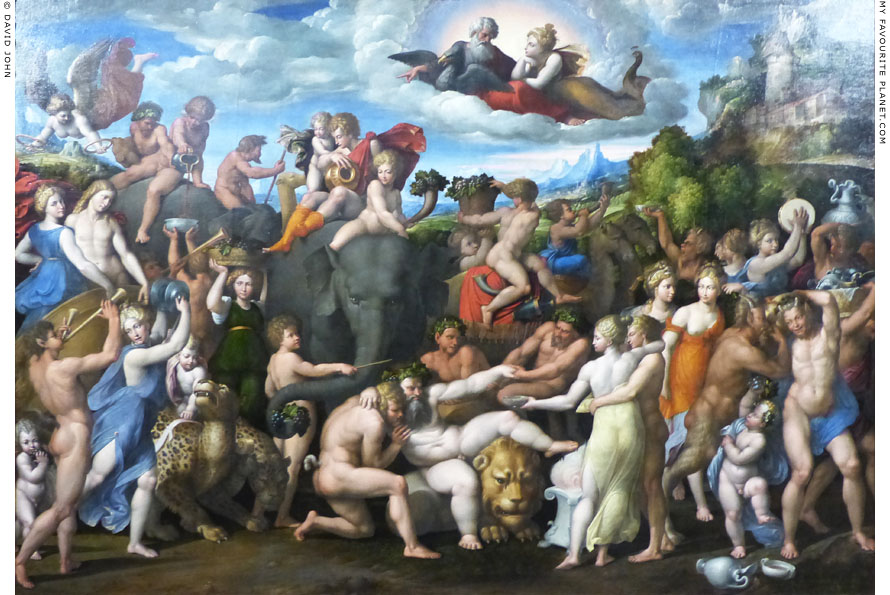
The Triumph of Bacchus by the Mannerist painter Benvenuto Tisi, named Il Garofalo (1476/1481 - 1559).
Painted in Ferrara in 1540, "after a drawing by Raphael". Oil on canvas. Height 218 cm, width 313 cm.
Old Masters Gallery (Gemäldegalerie Alte Meister), Semperbau, Dresden. Inv. No. 138.
|
Ariadne and the naked Dionysus enter the theatrical scene from the left in a golden chariot drawn by two leopards and surrounded by the god's thiasos, some riding elephants and camels, symbols of the god's victory in Asia, others dancing and playing pipes, cymbals and a tambourine (figure, far right). A winged Victoria (Nike) flies down to bring the couple a pair of victory wreaths. A young female in a dark green robe carries a basket of grapes on her head, and other figures, including one of the elephants, also hold grapes and drinking vessels. At the centre Satyrs or Silens try to help the drunken, obese Silenos mount a patiently crouching lion. To the right Pan cavorts with his companions. The goat-footed god drinks from a wineskin carried on the shoulders of a horned youth. Zeus, with his eagle, and Hera, with her peacock, recline in a cloud above to watch the progress of the procession. In the background, to the far left and right, rises an idealized mountainous landscape with groups of buildings and a round tower, perhaps meant to represent an imaginary Greece, or as an allusion to the history of the Este family or Ferrara.
The composition is punctuated by areas of rich colour - blues, greens, reds and orange - mainly on garments, but dominated by expanses of naked flesh (that of most of the males is darker than the porcelain-like skin of the females), and the surface is generally lively. However, all textures have been smoothed out, and the movements of the figures are decidely restrained, rather than orgiastically abandoned. All but Silenos are solemnly sober; only Pan and the horned youth to his right are smiling, while another horned figure, behind and to the left of them, appears to be shouting or singing.
Painted for Ercole II d'Este, Duke of Ferrara, Modena and Reggio, the work was exhibited in the Camerino gallery of the ducal palace in Ferrara. By the time Garofalo completed the work he was almost blind, having lost the sight of his right eye when he was about 49 (Giorgio Vasari, Lives of the Artists Part III [21]).
Ercole's father Alfonso I d'Este (his mother was Lucrezia Borgia) had originally commissioned a painting of the subject from Raphael, who sent Alfonso a sketch in 1517 but never began the work. The drawing is thought to be lost, although the Der Triumphzug des Bacchus in Indien, in the Albertina, Vienna (Inv. No. 444), traditionally attributed to a number of other artists (Perino del Vaga, Giovanni Francesco Penni), may be the original or a copy of Raphael's sketch [22]. If this is true it bears little resemblance to Garofalo's finished work, as is the case of the relationship between Sodoma's The Wedding of Alexander the Great and Roxana and the earlier sketch of the subject by Raphael.
Following the death of the last Este duke in 1597, the family lost control of Ferrara and the works from the palace were dispersed. The painting was taken to the gallery of the ducal palace in Modena. It was purchased, along with other works from Modena, by Elector Friedrich August II of Saxony (King August III of Poland), and entered the Royal Collection in Dresden in 1746. |
|
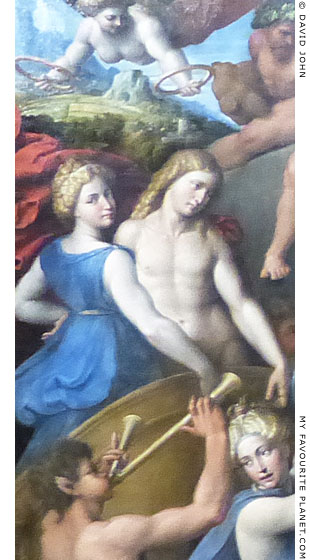
Bacchus and Ariadne by Garofalo |
|
| |
| Dionysus |
Notes, references and links |
 |
|
1. The Twelve Olympian Gods
Both parents of all other Twelve Great Gods (δυώδεκα θεῶν) of Olympus, known as the Dodekatheon (Δωδεκάθεον), were gods or other divine beings.
Zeus, Hera, Poseidon, Demeter, Hestia, Aphrodite, Ares, Hephaistos, Athena, Apollo, Artemis and Hermes were considered the original twelve. Hestia, goddess of the hearth, domestic order and the family, was among the first generation of Olympians, the sister of the first four in the list, as well as of Hades, and the niece of Aphrodite. However, her place appears to have been taken later by Dionysus.
The earliest known dedication to the twelve was the Altar (βωμὸς) of the Twelve Gods (or the Sanctuary of the Twelve Gods) at the northwest of the Athenian Agora, established around 522/521 BC by the archon Peisistratos (the Younger), grandson of the tyrant Peisistratos (Thucydides, History of the Peloponnesian War, Book 6, chapter 54, sections 6-7; the altar was also mentioned by Herodotus, The Histories, Book 2, chapter 7, section 1, and Book 6, chapter 108, section 4). A small number of depictions of the twelve as a group are known from ancient literature and inscriptions, and a few have survived, including the relief on the Ostia Dodekatheon.
See also the altar dedicated to Apollo Pythios by Peisistratos the Younger.
2. Hyginus on Liber, son of Jove and Proserpine
Fabulae, a collection of brief summaries of Greek and Roman myths and mythological genealogies, has been attributed to Gaius Julius Hyginus (circa 64 BC - 17 AD), but may be the work of a later author, perhaps also named Hyginus, sometimes referred to as Pseudo-Hyginus or Hyginus Mythographus. For further details, see the note in Homer part 2. Liber (Dionysus) is mentioned three times as the son of Jove (Zeus) and Proserpine (Persephone).
155. Sons of Jove
"Liber by Proserpine, whom the Titans dismembered. Hercules, by Alcumena. Liber by Semele, daughter of Cadmus and Harmonia."
167. Liber
"Liber, son of Jove and Proserpine, was dismembered by the Titans, and Jove gave his heart, torn to bits, to Semele in a drink. When she was made pregnant by this, Juno [Hera], changing herself to look like Semele’s nurse, Beroe, said to her: 'Daughter, ask Jove to come to you as he comes to Juno, so you may know what pleasure it is to sleep with a god.' At her suggestion Semele made this request of Jove, and was smitten by a thunderbolt. He took Liber from her womb, and gave him to Nysus to be cared for. For this reason he is called Dionysus, and also 'the one with two mothers'."
179. Semele
"Jove desired to lie with Semele, and when Juno found out, she changed her form to that of the nurse Beroe, came to Semele, and suggested that she ask Jove to come to her as he came to Juno, 'that you may know', she said, 'what pleasure it is to lie with a god'. And so Semele asked Jove to come to her in this way. Her request was granted, and Jove, coming with lightning and thunder, burned Semele to death. From her womb Liber was born. Mercury snatched him from the fire and gave him to Nysus to be reared. In Greek he is called Dionysus."
The Myths of Hyginus, translated and edited by Mary Amelia Grant. University of Kansas Publications in Humanistic Studies, No. 34. University of Kansas Press, Lawrence, 1960.
Fabulae, sections 150-199 at the Theoi Project.
The Nysus (Νυσος) mentioned as Dionysus' nurse may have been a Silen of that name, perhaps the god's tutor usually referred to as Silenos (see above). Hyginus mentioned Nysus as Liber's nurse again in section 131. Nysus, where he said Nysus ruled Liber's Theban kingdom while the god led his army to India. He also wrote that Nysus was the father of Eurynome, the mother of Bellerophon by Jupiter (Zeus), in section 157. Sons of Neptune.
See also: Nysos at the Theoi Project.
Cicero (106 - 43 BC), in De Natura Deorum (Nature of the Gods, written 45 BC), discussed various myths concerning the gods, including five stories, each providing Dionysus with different parents. In the fifth he was the son of Niso (or Nyso) and Thyone (Θυώνη), who according to other ancient authors (e.g. Pseudo-Apollodorus, The Library, Book 3, chapter 38) was the name given to Semele after Dionysus had rescued his mother from Hades. Unfortunately, as with Hyginus, Cicero provided no further information about the identity or nature of Nyso/Nysus.
"We have a number of Dionysi. The first is the son of Jupiter and Proserpine; the second of Nile - he is the fabled slayer of Nysa. The father of the third is Cabirus; it is stated that he was king over Asia, and the Sabazia were instituted in his honour. The fourth is the son of Jupiter and Luna; the Orphic rites are believed to be celebrated in his honour. The fifth is the son of Nisus and Thyone, and is believed to have established the Trieterid festival."
Cicero, De Natura Deorum, Book 3, chapter 23, section 58. At Bill Thayer's website LacusCurtius: Into the Roman World, University of Chicago.
3. Dionysus raised in Nysa
"... the Greek story has it that no sooner was Dionysus born than Zeus sewed him up in his thigh and carried him away to Nysa in Ethiopia beyond Egypt."
Herodotus, The Histories, Book 2, chapter 146, section 2. At Perseus Digital Library.
"I begin to sing of ivy-crowned Dionysus, the loud-crying god, splendid son of Zeus and glorious Semele. The rich-haired Nymphs received him in their bosoms from the lord his father and fostered and nurtured him carefully in the dells of Nysa, where by the will of his father he grew up in a sweet-smelling cave, being reckoned among the immortals. But when the goddesses had brought him up, a god oft hymned, then began he to wander continually through the woody coombes, thickly wreathed with ivy and laurel. And the Nymphs followed in his train with him for their leader; and the boundless forest was filled with their outcry.
So I salute you, Dionysus, god of the abundant grape clusters. Grant that we may come again rejoicing to this season, and from that season onwards for many a year."
Homeric Hymn 26, to Dionysus
Hugh G. Evelyn-White (translator), The Homeric Hymns and Homerica. Harvard University Press, Cambridge, MA. and William Heinemann Ltd., London, 1914. At Perseus Digital Library. |
|
|
4. The thiasos
In ancient depictions of Dionysus with his retinue, he is shown with male figures, mostly young, with tails and other attributes, often referred to as Satyrs, Silens and fauns. In some works a figure may be identified as a specific character, such as the Satyr Ampelos (Ἀμπελος, Vine). Although there are differences between the types of mythical beings known from Greek and Roman literature, they are not always easy to distinguish in artworks, and many modern descriptions refer to the figures generically as Satyrs. Where a mature, bearded figure appears, he is decribed as an elderly Silen or as Silenos, the oldest of the Silens and the mentor and teacher of Dionysus (see above).
„Faune Satyrn Silene Pane – wie kreuzen und vermischen sich die Vorstellungen von dieser lustigen Schaar, nicht nur bei uns, sondern theilweise schon bei den Alten!“
"Fawns, Satyrs, Silens, Pans – how the perceptions of this merry throng have become mixed up, not only by us but even sometimes by the ancients!"
Adolf Furtwängler, Der Satyr aus Pergamon, page 3. Programm zum Winckelmannsfeste der Archäologischen Gesellschaft zu Berlin, Band 40. Georg Reimer, Berlin, 1880. At the University of Heidelberg Digital Library.
See the report by Pausanias on his enquiries into the origins of Satyrs on Athens Acropolis page 36.
Likewise, Dionysus is often shown with one or more female figures, including Semele, Ariadne, Maenads, Thyiads, Nymphs, Muses and the Seasons (Horai). In several cases the identification of the figures remains a subject of scholarly debate (see for example, discussion of the Thyiads in the note below).
For the moment, when describing such images, I have mostly followed the labelling and literature of the respective museums, particularly since this page is primarily concerned with Dionysus himself. Where possible I will attempt to add more details concerning secondary figures.
5. The statue of Dionysus from Ikaria
The Attic deme Ikaria (Ικαρία, also referred to as Ikarion), today the municipality Dionysos (Διόνυσος), on the north slope of Mount Penteli, northeast of Athens (between Kifissia and Marathon). The fragments were found during the only excavations so far undertaken there, directed by Carl Darling Buck (1866-1955) of the American School of Classical Studies at Athens in 1888-1889. The site consists of the remains of a theatre and a number of buildings, all of which have been connected by inscriptions and other finds (including choragic monuments) with the worship of Dionysus and Apollo, including a temple of Pythian Apollo.
Some of the fragments were discovered below the walls of a Byzantine church and others at "Building D", which may have been the "Dionysion", an Archaic temple of Dionysus. If this was the cult statue of the temple, it may have been one of the earliest stone cult statues in Attica.
See:
Carl D. Buck, Discoveries in the Attic Deme of Ikaria, 1888. Sculptures (Plates VII, VIII). Papers of the American School of Classical Studies at Athens, Volume V, 1886-1890, pages 109-125 and figs. 1-4. Archaeological Institute of America. Damrell and Upham, Boston MA, 1892. At Heidelberg University Library.
The volume includes all Buck's papers on his Discoveries in the Attic Deme of Ikaria, 1888, including a chronological record of the excavations (with topographical description and map), inscriptions and sculptures, as well as The Choregia in Athens and Ikaria. They have been collected as a separate PDF (except the plates): ascsapapers1886_1890__p0056-0149.pdf. Also at Heidelberg University Library.
Irene Bald Romana, The Archaic statue of Dionysos from Ikarion. Hesperia, Vol. 51, No. 4 (Oct. - Dec., 1982), pages 398-409, plates 93-95. The American School of Classical Studies at Athens. PDF at www.ascsa.edu.gr.
William R. Biers and Thomas D. Boyd, Ikarion in Attica: 1888-1981. Hesperia, Vol. 51, No. 1 (Jan. - Mar., 1982), pages 1-18. The American School of Classical Studies at Athens. PDF at www.ascsa.edu.gr.
Elizabeth King Filioti, Dionysos / Ikarion. At filiotis.net.
Robert Horne, The Ikarion Sanctuary of Dionysos. At athens123.com.
John M. Camp, The archaeology of Athens, pages 289-291. Yale University Press, 2004.
6. The Plateia Eleutherias Dionysos
Many places in Greece - streets, squares, villages, towns and islands - have two or more names (e.g. Vathy/Samos town and Kastellorizo/Megisti island, etc). Just to confuse things even further, there is no standard method for transliterating Greek names into the Latin alphabet, so that spellings vary. The large square in central Athens, Plateia Eleutherias (Πλατεία Ελευθερίας, Freedom Square), is also known as Plateia Koumoundourou (Πλατεία Κουμουνδούρου) after the 19th century Greek prime minister Alexandros Koumoundouros (Αλέξανδρος Κουμουνδούρος, 1817-1883). The north side of the square faces Odos Pireos (Οδός Πειραιώς, Piraeus Street) which is also known as Odos Panagi Tsaldari (Οδός Παναγή Τσαλδάρη).
The square is on the site of an Archaic cemetery, just northwest of the Kerameikos archaeological site. This has led to debate over whether the headless statue is from a funerary monument for a mortal or a votive offering representing a god. As well as Dionysus, Zeus has also been suggested as the subject.
For the essential arguments of the debate, see:
Catherine M. Keesling, Endoios's painting from the Themistoklean Wall: A reconstruction. In: Hesperia, Volume 68, No. 4 (Oct. - Dec., 1999), pages 509-548 (particularly pages 524-536). The American School of Classical Studies at Athens. At Georgetown University Library, Washington DC.
7. Angelos Choremis on the Dionysus pediment in Corfu
The Athenian archaeologist Angelos Choremis first published details of the discovery and excavation of the pediment in:
Άγγελος Κ. Χωρέμης, Αρχαϊκόν αέτωμα εκ Κέρκυρας (Archaic pediment from Kerkyra), Αρχαιολογικά ανάλεκτα εξ Αθηνών (Athens Annals of Archeology), Volume VII, No. 2, 1974, pages 183-186.
Choremis also wrote an official guide book to Corfu and the archaeological museum there. The illustrated book is now out of date in many respects, particularly as the museum has recently been renovated, and its collection and that at the nearby Mon Repos museum have been reorganized. However, much of the information about the history of the island and its archaeology remain unchanged as well as details of many of the museum's exhibits.
Angelos Choremis, Kerkyra and its Archaeological Museum. C. Voutsas, Athens, 1979.
8. Ivory plaque of Dionysus from Sepino
The plaque was exhibited as part of the temporary exhibition The gift of Dionysos in the Thessaloniki Archaeological Museum, 13 July 2011 - 30 September 2012. So far I have been unable to discover further details of the exhibits on loan from the Molise region of south-central Italy.
The exhibition was the result of cooperation between the Archaeological Museum of Thessaloniki, the Italian Cultural Institute of Thessaloniki and the Soprintendenza Archeologia del Molise.
The exhibition catalogue, in Greek, Italian and English: Polyxeni Adam-Veleni, Eurydice Kefalidou, Evangelia Stefani (editors), Το δώρο του Διονύσου. Μυθολογία του κρασιού στην κεντρική Ιταλία (Molise) και τη βόρεια Ελλάδα (Μακεδονία), The gift of Dionysos: Mythology of wine in central Italy (Molise) and northern Greece (Macedonia). Archaeological Museum of Thessaloniki. ΖΗΤΗ publications, Thessaloniki, 2011. |
|
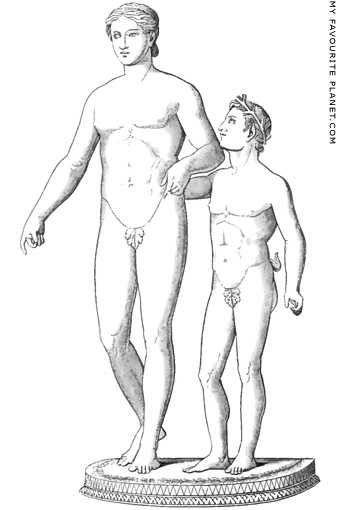
"Bacchus and Ampelus", bronze statuettes
of Dionysus and a Satyr wearing a laurel
wreath, probably the wine god's young
lover Ampelos (Ἀμπελος, Vine). Modern fig
leaves were added to both nude figures.
Greek, 1st century BC - 1st century AD.
Bronze, silver and copper. Dionysus, height
82 cm; Satyr, 63 cm. Found in the House of
Pansa (Casa di Pansa, mid 2nd century BC),
Regio VI, Insula 6, Pompeii.
National Archaeological Museum,
Naples. Inv. no. 4995.
Source: Domenico Monaco and Eustace Neville
Rolfe, Specimens from the Naples Museum,
page 13 and plate 90. William Clowes & Sons,
London, 1884. At the Internet Archive. |
|
9. Dionysus Sardanapalos
Ctesias (Κτησίας, Ktesias; also known as Ctesias of Cnidus), a Greek physician and historian from Knidos in Caria, who lived in the 5th century BC. He was a physician to Artaxerxes Mnemon, and accompanied him on his expedition against his brother Cyrus the Younger in 401 BC. Artaxerxes' army included Greek mercenaries led by Xenophon of Athens (see History of Pergamon). He wrote treatises on rivers and on the Persian revenues, Indica (Ἰνδικά), an account of India, and Persica (Περσικά), a history of Assyria and Persia in 23 books in the Ionic dialect, written in opposition to Herodotus, and allegedly based on the Persian Royal Archives.
Diodorus Siculus (Διόδωρος Σικελιώτης, Diodoros Sikeliotes; also known as Diodorus of Sicily), a Greek historian from Agyrion (today Agira) in Sicily, who lived during the 1st century BC. Diodorus on Sardanapalos (Sardanapallus):
Diodorus Siculus, Library, Book II, chapters 23-28. At Bill Thayer's website LacusCurtius: Into the Roman World, University of Chicago.
Ennio Quirino Visconti (1751-1818), an Italian antiquarian, art historian, who was appointed papal Prefect of Antiquities. Visconti identified the Sardanapolos type statues as depictions of Dionysus:
Ennio Quirino Visconti, Giambattista Antonio Visconti, Giovanni Labus, Il Museo Pio Clementino Volume II, pages 257-269 (in Italian) and Tavolo XLI. Presso gli editori (N. Bettoni), Milan, 1819. At the Internet Archive.
Tavolo XLI (Plate 41), a drawing by Visconti of the statue in the Museo Pio Clementino, shows the inscription on the statue's chest along the lower edge of the cloak.
10. Winckelmann on Sardanapalos
Johann Joachim Winckelmann, Monumenti antichi inediti spiegati ed illustrati da Giovanni Winckelmann. Rome, 1767.
Text in Volume II, Parte Terza, capitolo primo, "Sardanapolo", pages 219-221.
Engraving: Volume I, plate 163.
Both volumes online at Heidelberg University Digital Library.
11. Dionysus and the Thyiads on the Temple of Apollo, Delphi
It has been suggested that Pausanias was mistaken in believing that the women around Dionysus on the east pediment were Thyiads, since their poses suggest more the calm of Muses in a dithyrambic dance rather than wild, orgiastic movement.
See: Jenny Strauss-Clay, Fusing the Boundaries: Apollo and Dionysos at Delphi, Mètis. Anthropologie des mondes grecs anciens, Volume 11, 1996, pages 83-100. At persee.fr.
Jenny Strauss-Clay examines the relationship between Apollo and Dionysus at Delphi, particularly during the Late Classical period in the context of the Paean to Dionysos by Philodamos, found on an inscription with an honorary decree for its author and his brothers, dated to 340-339 BC, under the Sacred Way in Delphi. |
|
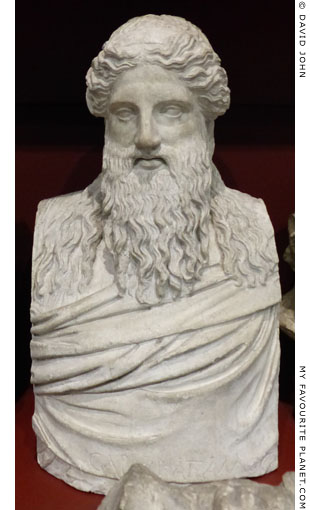
Plaster cast of the bust of Dionysos
Sardanapollos from the Vatican statue.
Abguss-Sammlung, Semperbau, Dresden.
Inv. No. ASN 2640. From the Cast
Collection of Anton Raphael Mengs
(see the Niobe page for further details).
The cast was made intentionally as a long
bust in order to include the important
ϹΑΡΔΑΝΑΠΑΛΛΟϹ inscription. However,
it is currently displayed on a shelf behind
a larger cast of a staute of Marsyas, so
that neither the inscription nor the musem
label can be seen. Bad design. Visitors who
try to get closer to read the inscription
and label set off an annoying proximity
alarm and long-suffering guards.
The original, 1st century AD, is made
of Pentelic marble. Height 202 cm.
Sala della Biga, Museo Pio-Clementino,
Vatican Museums, Rom. Inv. No. 2363. |
|
| |
12. Dionysus with a kithara
The reconstruction of the relief of Dionysus holding a kithara (as "Dionysos Kitharoidos") is conjectural. According to the Delphi museum labelling: "In the centre stands Dionysos, in the rare iconographic type of the cithara (type of lyre) player... The cithara he holds in his left hand places him on equal terms with the god of music, Apollo, and reconciles the different realms of the two deities who are both depicted on the same temple."
The other well-known example of a depiction of Dionysus supposedly holding a kithara is a fragment of a statue from the Choragic Monument of Thrasyllos, above the Theatre of Dionysos, Athens, dated 3rd - 2nd century BC. The headless and armless seated figure, removed by Lord Elgin and now in the British Museum (see photo, right), is thought to have originally held a kithara in its left hand.
See: the Choragic Monument of Thrasyllos
13. Nebris
The nebris (Greek νεβρίς; earlier, νεβρός, nebros, fawn; plural nebrises) was originally the skin of a fawn, as can be seen on several depictions of Dionysus, Satyrs, Maenads, etc. In Roman art Bacchus and members of his retinue are often shown wearing deerskins.
14. Maron
Maron is mentioned by several ancient authors and later Christian writers, but as usual the genealogies and stories concerning him differ. He is variously referred to as a son of Dionysus and Ariadne, or of Euanthes or Oinopion, elsewhere named as sons or grandsons of Dionysus. He was also said to be the founder of the Maroneian tribe of Dionysus, the god's chariot driver or a son of Silenos who accompanied Dionysus on his campaign in India.
The brief references are probably dim echoes of ancient tales, now lost along with the original nature and identity of the character. Whether he was a mythical, legendary or historical figure, a local Thracian or Greek hero or deity, a son or descendant of Dionysus or Silenos, a member of the Dionysian thiasos, a pioneer of viniculture or founder of Maroneia, it is clear that he became strongly connected with aspects of the wine god's cult and some of the myths surrounding him.
He was mentioned as the son of Dionysus in Euripides' satyr play Cyclops (Κύκλωψ, Kyklops), written around 408 BC. In a dialogue with Silenos, Odysseus brings wine he has been given by Maron, as in Homer's Odyssey (Book 9, lines 196-212, see Homer part 3), in which the character named Maron is referred to as the son of Euanthes (Μάρων, Εὐάνθεος υἱός).
Odysseus: It is not gold I carry but rather Dionysus' drink.
Silenus: What happy words you speak! The very thing we have lacked so long!
Odysseus: What is more, Maron, the god's own son, gave me the drink.
Silenus: The lad I once raised in these very arms?
Odysseus: Dionysus' son, to make my meaning clear.
Euripides, Cyclops, lines 139-143. In: Euripides, with an English translation by David Kovacs. Harvard University Press. At Perseus Digital Library.
Herodotus, when describing the route of the army of the Persian king Xerxes along this part of the Thracian coast, wrote that it belonged to Thracian tribes, including the Cicones (Κίκονες, Kíkones), but described Maroneia, Dikaea, and Abdera as Greek cities.
"All this region was once called Gallaic, but it is now called Briantic; however, by rights it also belongs to the Ciconians.
After he [Xerxes] had crossed the dried-up bed of the river Lisus, he passed by the Greek cities of Maronea, Dicaea, and Abdera. He passed by these, and along certain well-known lakes near them: the Ismarid lake that lies between Maronea and Stryme, and near Dicaea the Bistonian lake, into which the rivers Travus and Compsantus discharge. "
Herodotus, Histories, Book 7, chapters 108-109. English translation by A. D. Godley. Harvard University Press, Cambridge, Mass., 1920. At Perseus Digital Library.
Strabo related that there was a temple dedicated to the hero Maron at Maroneia, and also wrote that this part of the Thracian coast belonged to the Cicones.
"After the lake [Bistonis], which is midway between, come Xantheia, Maroneia, and Ismarus, the cities of the Cicones. Ismarus, however, is now called Ismara; it is near Maroneia. And near here, also, Lake Ismaris sends forth its stream; this stream is called Odysseium. And here, too, are what are called the Thasion Cephalae. But the people situated in the interior are Sapaei.
Topeira is near Abdera and Maroneia.
The aforesaid Ismarus, in later times called Ismara, is, they say, a city of the Cicones; it is near Maroneia, where is also a lake, the stream of which is called Odysseium; here too is a hero-temple of Maron, as the Geographer records."
Strabo, Geography, Book 7, Fragments, sections 43-44. Edited by H. L. Jones. Harvard University Press, Cambridge, Mass., and William Heinemann Ltd, London, 1924. At Perseus Digital Library.
According to Diodorus Siculus (Library of history, Book 1, chapters 18 and 20, at LacusCurtius), the Egyptian god Osiris (identified by the Greeks with Dionysus) took his two sons Anubis and Macedon, as well as Maron ("experienced... in the cultivation of the vine") and Triptolemos (see Demeter and Persephone) on his long campaign in Asia and Europe. He left Maron in Thrace to found Maroneia, Macedon as king and name-giver of Macedonia and Triptolemos to take care of agriculture in Attica. For further mentions of Maron by ancient authors, see: Maron at the Theoi Project.
15. Dimensions of the triumph sarcophagus relief in Dresden
Dimensions from the website of the Dresden State Art Collections:
skd-online-collection.skd.museum/Details/Index/166376
According to Arachne, the website of the University of Köln Archaeological Institute, the dimensions are:
Height 58.5 cm, width 171 cm, depth 61.5 cm.
See: arachne.uni-koeln.de/item/objekt/5418
The website gives the dimensions of the other Dionysus sarcophagus relief in Dresden (Inv. No. Hm 293, see above) as:
Height 55 cm, width 219 cm, depth 59 cm.
See: arachne.uni-koeln.de/item/objekt/5417
Details of ancient artefacts, such as provenance, dates, artists, materials and dimensions, on some museum labels and in some publications are often based on the reports and opinions of one or two scholars published in academic books, articles and catalogues, many now more than a century old.
While the dates, authorship and provenance of a large number of museum objects continue to be debated, and even more await careful analysis using modern techniques (e.g. for marble types of sculptures, see Niobe), many of these questions may never be answered beyond dispute. On the other hand, the dimensions of extant objects are not insoluble riddles, all that is needed is the will, time and a tape measure. Yet researchers are often left wondering whose statistics to believe. A prime example is the "Alexander Mosaic" from Pompeii.
16. The mosaic from Halicarnassus
Charles Thomas Newton excavated the remains of the large villa in the field of Hadji Captan, known after the Turkish owner, to the west of the Mausoleum, in December 1856. The mosaic of Dionysus dancing with a panther was found in Room D. In Room B he discovered a mosaic panel depicting Meleager and Atalanta hunting a leopard and a lion, and parts of another with Dido and Aeneas hunting.
See: Sir Charles Thomas Newton and Richard Popplewell Pullan, A History of Discoveries at Halicarnassus, Cnidus and Branchidae, Volume II, Part 1, Chapter X: Field of Hadji Captain (Dionysus mosaic on page 292). Day and Son, London, 1862. At archive.org
17. Dionysus/Fufluns and Lekanomanteia
See: Nancy Thomson de Grummond, Etruscan myth, sacred history, and legend, page 121, fig. VI.9. University of Pennsylvania Museum of Archaeology and Anthropology, 2006.
Lekanomanteia (lecanomancy; Greek, λεκανομαντεία, from λεκάνη, lekane, dish, pan; Latin, lecanomantia), divination by interpreting the sound or effect of an object or substance falling into a liquid.
18. Derveni, Lete
Derveni (Δερβένι), about 10 km northeast of Thessaloniki, between Efkarpia and Lagyna, on the road to Kavala, is the site of the necropolis of the ancient Mygdonian city of Lete (Λητή, Liti). The finds from the archeological site include the Derveni Krater, the Derveni Papyrus and a large funerary monument of the 1st century BC with a relief signed by the sculptor Evandros of Veroea.
19. Emil Wolff
From 1815 Wolff studied at the Kunstakademie Berlin, and from 1818 with his uncle Johann Gottfried Schadow. He won an academic prize in 1821 which enabled him to travel in 1822 to Rome, where remained for the rest of his life. There he acquired several ancient artworks on behalf the Prussian Royal Collection (preußisch königliche Sammlung), many of which are today in the museums of Berlin.
20. The Dresden Maenad
See: Beryl Barr-Sharrar, The Dresden Maenad and Skopas of Paros, pages 321-337, in: Dora Katsonopoulou and Andrew Stewart (editors), Paros III: Skopas of Paros and his world. Proceedings of the Third International Conference on the Archaeology of Paros and the Cyclades, Paroikia, Paros 11-14 June 2010. Athens 2013. At academia.edu.
21. Vasari on Garofalo's Triumph of Bacchus
See: Giorgio Vasari's Lives of the Artists, Part III, 1. The lives of Benvenuto Garofalo and Girolamo da Carpi, painters of Ferrara, and of other Lombards. At the website of Adrienne DeAngelis.
Also at: ebooks.adelaide.edu.au/v/vasari/giorgio/lives/part3.62.html. At the University of Adelaide.
22. The "Raphael" Triumph sketch in Vienna
A photo of the drawing, with a description in English, claiming that it is by Raphael, followed by terse, academic references:
sammlungenonline.albertina.at/... |
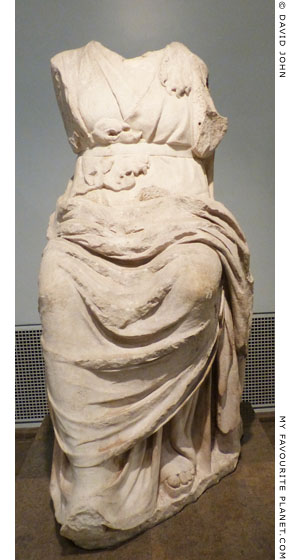
Marble statue of Dionysos from the
Choragic Monument of Thrasyllos,
Athens. 3rd - 2nd century BC.
British Museum, London.
Inv. No. 1816,0610.111 (Sculpture 432). |
| |
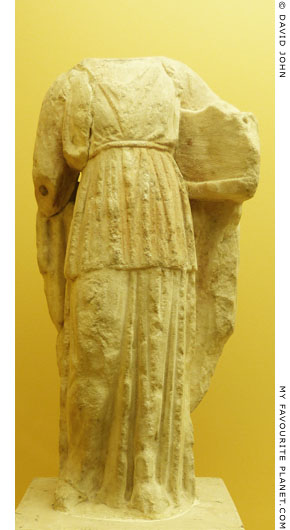
Marble statuette of a standing figure,
now headless, wearing a long chiton,
belted at the waist, and a himation,
and holding a kithara or lyre in the left
hand. Identified as depicting
Apollo Patroos, and thought to be
a miniature copy of a statue
by Euphranor (4th century BC).
Found in a well in the Athenian Agora,
1937. Described as either island or
Pentelic marble. Height 29 cm,
maximum width 13.6 cm, depth 8 cm.
Agora Museum, Athens. Inv. No. S 877. |
| |
| |
Photos on this page were taken during
visits to the following museums:
Bulgaria
Varna Archaeological Museum
Germany
Berlin, Altes Museum
Berlin, Bode Museum
Berlin, Neues Museum
Berlin, Pergamon Museum
Berlin, Schinkel Museum, Friedrichswerdersche Kirche
Dresden, Albertinum, Skulpturensammlung
Dresden, Residenzschloss, Münzkabinett
Dresden, Semperbau, Gemäldegalerie Alte Meister
Greece
Amphipolis Archaeological Museum
Athens, Acropolis Museum
Athens, Agora Museum
Athens, Epigraphical Museum
Athens, Kerameikos Archaeological Museum
Athens, Museum of Cycladic Art
Athens, National Archaeological Museum
Chalkis, New Archaeological Museum "Arethousa"
Chalkis "Old" Archaeological Museum
Corfu Archaeological Museum
Corinth Archaeological Museum
Delos Archaeological Museum and site
Delphi Archaeological Museum
Dion Archaeological Museum, Macedonia
Drama Archaeological Museum, Macedonia
Eleusis Archaeological Museum, Attica
Kavala Archaeological Museum, Macedonia
Komotini Archaeological Museum
Kos Archaeological Museum, Dodecanese
Kos, Castle of Nerantzia
Patras Archaeological Museum, Peloponnese
Pella Archaeological Museum, Macedonia
Philippi Archaeological Site and Museum, Macedonia
Piraeus Archaeological Museum, Attica
Polygyros Archaeological Museum
Rhodes Archaeological Museum, Dodecanese
Rhodes, Palace of the Grand Master
Thasos Archaeological Museum, Macedonia
Thasos, acropolis, ancient theatre and Dionysion
Thebes Archaeological Museum
Thessaloniki, Agora Museum, Macedonia
Thessaloniki Archaeological Museum, Macedonia
Italy
Herculaneum, archaeological site
Milan, Civic Archaeological Museum
Naples Cathedral
Naples, National Archaeological Museum
Ostia Archaeological Museum
Paestum, National Archaeological Museum
Rome, Barracco Museum
Rome, Capitoline Museums, Palazzo dei Conservatori
Rome, Capitoline Museums, Palazzo Nuovo
Rome, National Etruscan Museum, Villa Giulia
Rome, National Museum, Baths of Diocletian
Rome, National Museum of Rome, Palazzo Altemps
Rome, National Museum, Palazzo Massimo alle Terme
Italy - Sicily
Agrigento Regional Archaeological Museum
Catania, Museo Civico, Castello Ursino
Palermo, Antonino Salinas Regional Archaeological Museum
Syracuse, Paolo Orsi Regional Archaeological Museum
Netherlands
Amsterdam, Allard Pierson Museum
Leiden, Rijksmuseum van Oudheden
Turkey
Istanbul Archaeological Museums
Izmir Archaeological Museum
Letoon archaeological site, Kumluova
United Kingdom
London, British Museum
Oxford, Ashmolean Museum
Many thanks to the staff of these museums. |
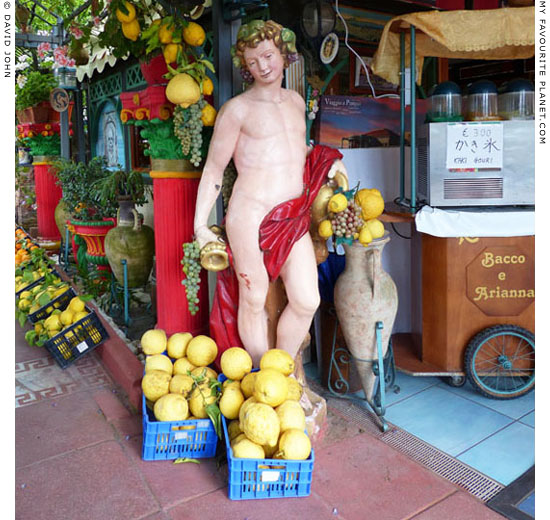
Modern plaster statue of Bacchus (with large lemons) in the garden of
the Bacco e Arriane restaurant outside the Pompeii archaeological site. |
|
| Photos and articles © David John, except where otherwise specified. |
 |
Visit the My Favourite Planet Group on Facebook.
Join the group, write a message or comment,
post photos and videos, start a discussion... |
|
|
| |
| Copyright © 2003-2025 My Favourite Planet | contributors | impressum | contents | sitemap |
| |








